- South Africa
- Afghanistan
- North Korea
- Adventure + Outdoors
- Amusement Parks
- Backpacking Trips
- Boating + Cruises
- Budget Travel
- Bus + Train Travel
- Coasts + Islands
- Country Trips
- Fall Vacations
- Family Vacations
- Green Travel
- Heritage + History
- Honeymoons + Romance
- Inspiration + Guide
- Landmarks + Attractions
- LGBT Travel
- Markets + Bazaars
- National Parks + Reserves
- Nature + Wildlife
- Parks + Gardens
- Pets + Animals
- Photography
- Airlines + Airports
- Budgeting + Currency
- Business Travel
- Celebrity Travel
- Customs + Immigration
- Deals + Rewards
- Family Travel
- Hotels + Resorts
- Luggage + Packing Tips
- Offbeat News
- Photography Tips
- Responsible Travel
- Solo Travel
- Tech + Gear
- Travel Etiquette
- Travel Warnings
- Bars + Clubs
- Celebrity Chefs
- Restaurants + Cafés
- Wine + Vineyards
- Beach Hotels
- Boutique Hotels
- Hotel Openings
- Hotel Reviews
- Luxury Hotels
- Mountain + Ski Resorts
- Spa Resorts
- Vacation Rentals
- Asia Cruises
- European Cruises
- Festivals + Events
- Museums + Galleries
- Style + Design
- Travel’s Best
- Hotel with Agoda.com
- Hotel with Booking.com


What to eat in Singapore? — 10+ must-eat & best street…

Must eat in Nha Trang — 45+ best street food in…

How to prepare for trekking in Nepal? — 10+ Nepal trekking…
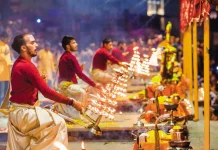
Where to go & what to do in Varanasi? — 15+…

What to buy in Indonesia? — Top +9 famous gifts, souvenirs…

What to buy in Kyoto? — 31+ must-buy Kyoto souvenirs, gifts…
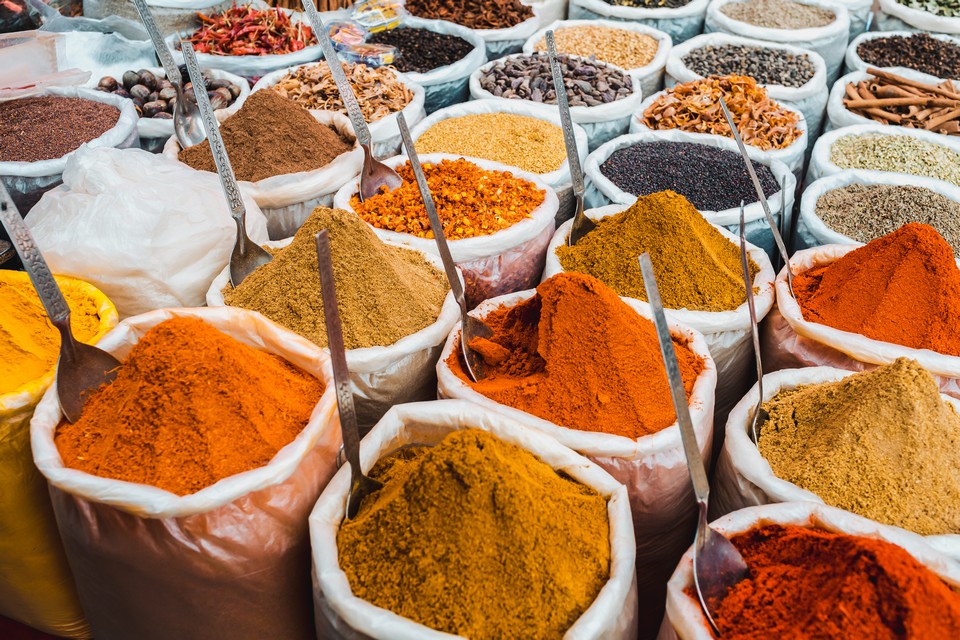
What to buy in India? — 29+ best gifts from India…

India trip tips — 9+ things to know before going to…

All about tips in Nepal — How much to tip in…

Cambodia travel tips — 15+ what to know & things to…

Must eat in Hong Kong — 7+ must eat & must…

Must eat in Georgetown — 10+ famous, must-eat & best street…

Top hotels in Siem Reap — 8+ best places to stay…

Top hotels in shanghai — 15+ best hotels in Shanghai

Top hotels in Malacca — 10+ good & best hotels in…

Top places to stay in Bali — Top 10 best areas…

10 must-know things for your best first time European river cruise

Top 3 best luxury cruises in Halong Bay, Vietnam

Cherry blossom festival Korea 2024 — Top 5 cherry blossom festivals…

Ghibli museum blog — The fullest Ghibli museum guide for first-timers

Kyoto festival — Top 10 best events & most famous festivals…

National Palace Museum Taipei blog — What to see in National…

Japanese waterfall — Top 10 most beautiful waterfalls in Japan in…

19+ most beautiful towns in Europe every tourist need to visit…

Georgia travel photos — 20+ captivating photos show Georgia is heaven…

Explore Damnoen Floating Market — The oldest floating market of Thailand

Visiting Fenghuang Ancient Town — One of the most charming ancient…

Mekong Delta travel blog — Beyond rivers of Southwestern Vietnam

14 reasons why you should travel when you are young

Shigaraki Tanuki – An animal symbol of good luck in Japan

Living in the charms of cave houses in Andalucia, Southern Spain

20+ jaw-dropping tiny homes around the world
Agra travel blog — the fullest agra guide, itinerary & what to do in agra for 3 days.
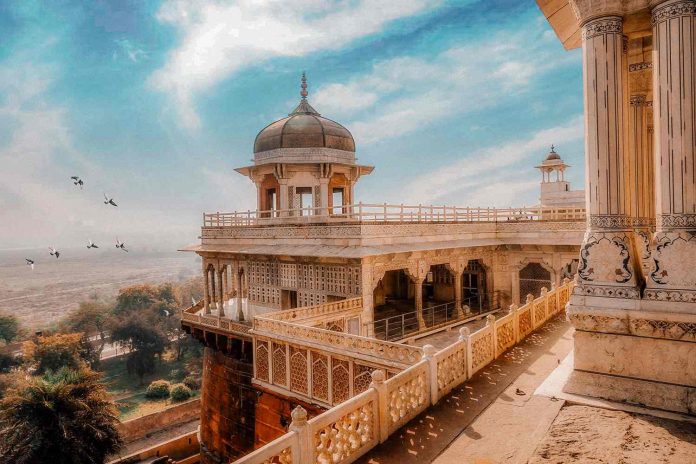
The city of Agra is located on the banks of the Yamuna river, in the state of Uttar Pradesh, India. It is the fourth most populous city in the state and twenty-fourth in the whole of India. Agra is a popular tourist destination for its Mughal period architecture, among them, the most well-known ones are Taj Mahal, Agra Fort and Fatehpur Sikri, all three of which are UNESCO World Heritage Sites. So, what to do in Agra? — the city is famous for its magnificent Taj Mahal and how to plan a perfect budget trip to Agra for the first-time? Let’s check out our Agra travel blog (Agra blog) with the fullest Agra travel guide (Agra guide, Agra tourist guide, Agra city guide) from how to get there, where to stay, best places to visit, what to eat and things to do in Agra during my Agra itinerary 3 days to find out the answer!
- Taj Mahal blog — 10 Taj Mahal photography tips & tips for visiting Taj Mahal
Where to go & what to do in Varanasi? — 15+ places to visit & best things to do in Varanasi
What to buy in india — 29+ best gifts from india & best things to buy in india.
- Leh Ladakh bike trip itinerary — How to spend 6 days in Ladakh by motorbike?
- Leh Ladakh bike trip blog — Ladakh bike trip guide & tips for first-timers
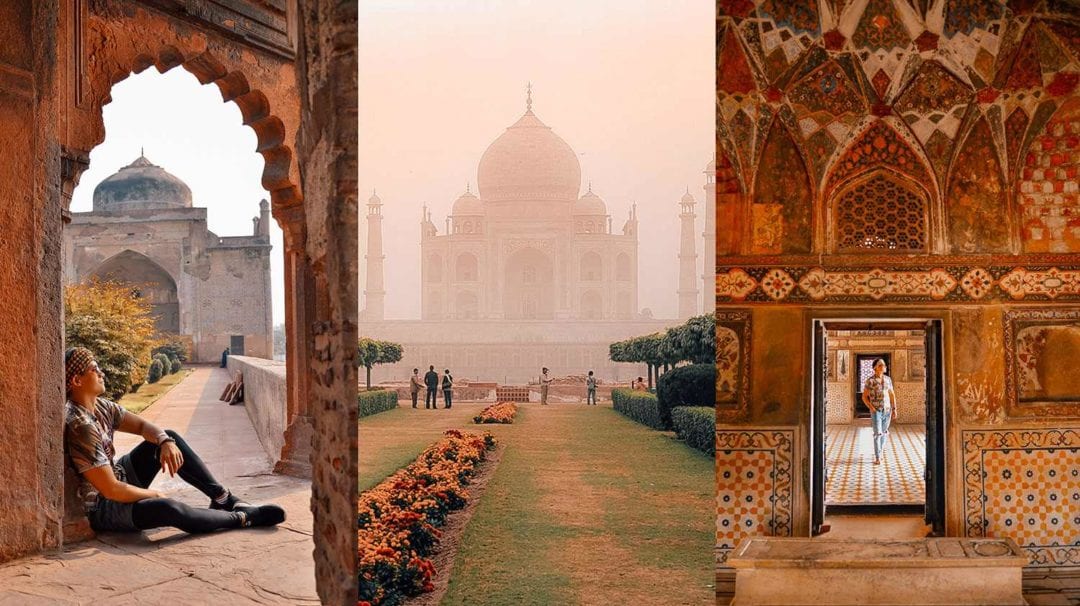
Agra travel blog: Overview of the City of Agra
Geographically, the city of Agra is located about 204km south of the Indian capital New Delhi. Agra is a metropolis of the state of Uttar Pradesh in India. Here you can explore the ancient culture and history of the city through its fortresses, palaces, mausoleums and royal gardens.
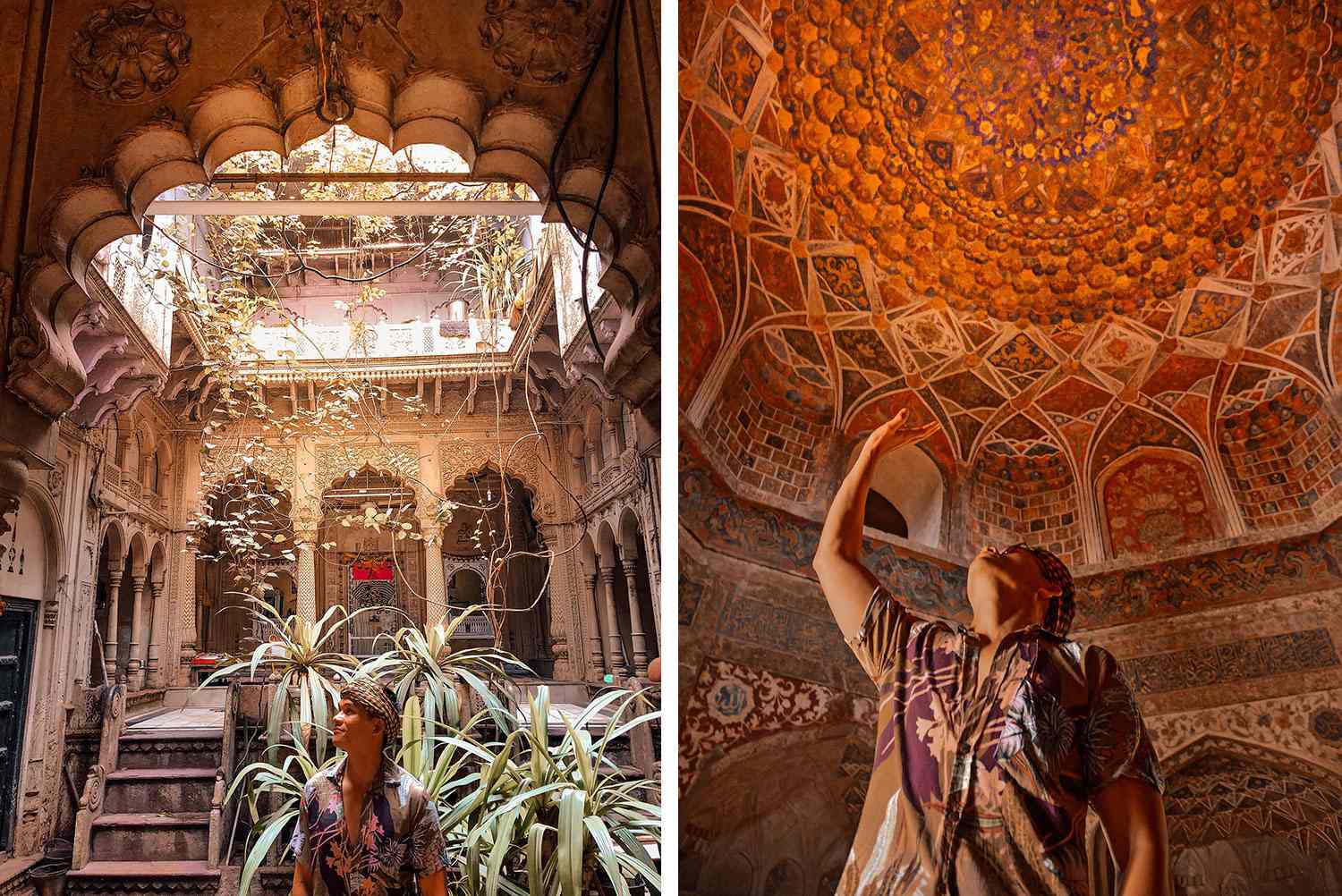
And, for many travelers, the purpose of visiting Agra is simply because it owns an extremely worldwide famous place on the list of wonders of the world, which is the Taj Mahal. However, you will also explore many other attractions that are equally unique.
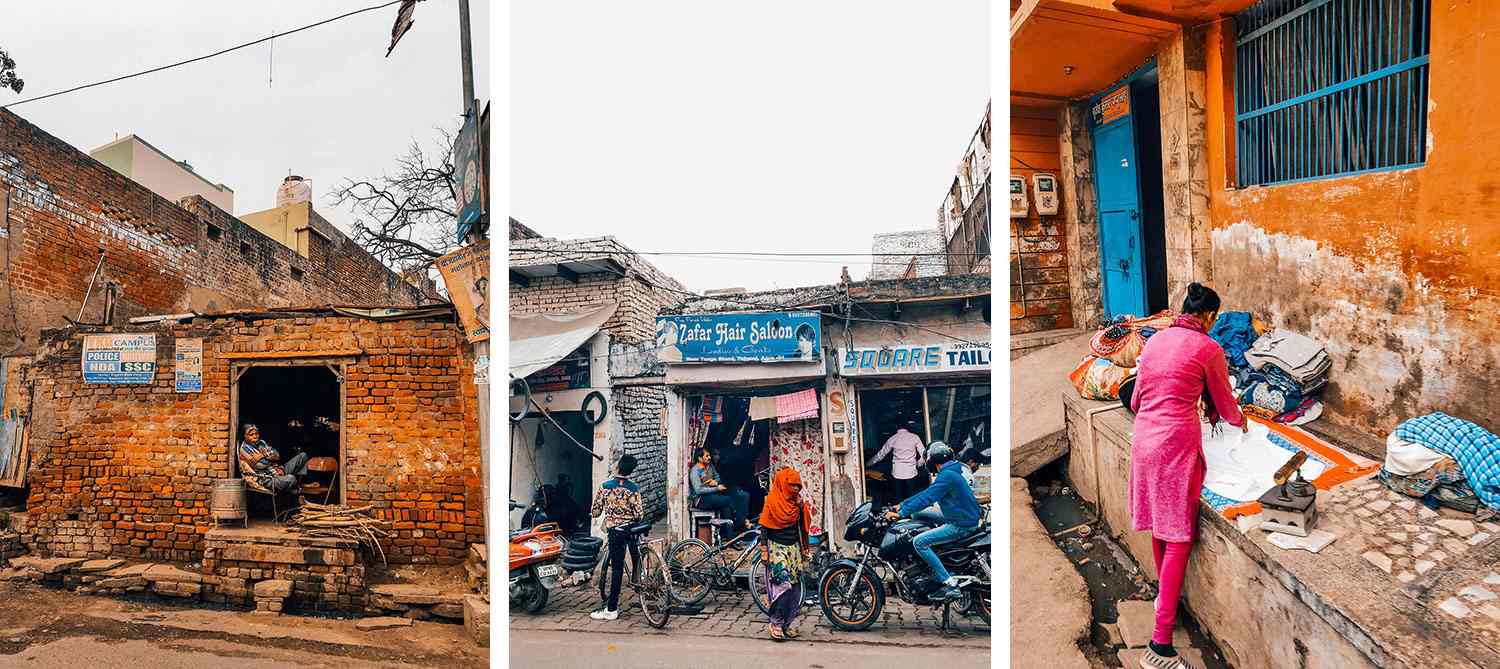
I will write about the Taj Mahal to guide you in detail in a separate article, and within the scope of this article, I will generalize important destinations to help you have an overview and the most basic to know what to expect, things to do in Agra, what to do in Agra India when coming to this city.
Agra blog: When is the good time to visit Agra?
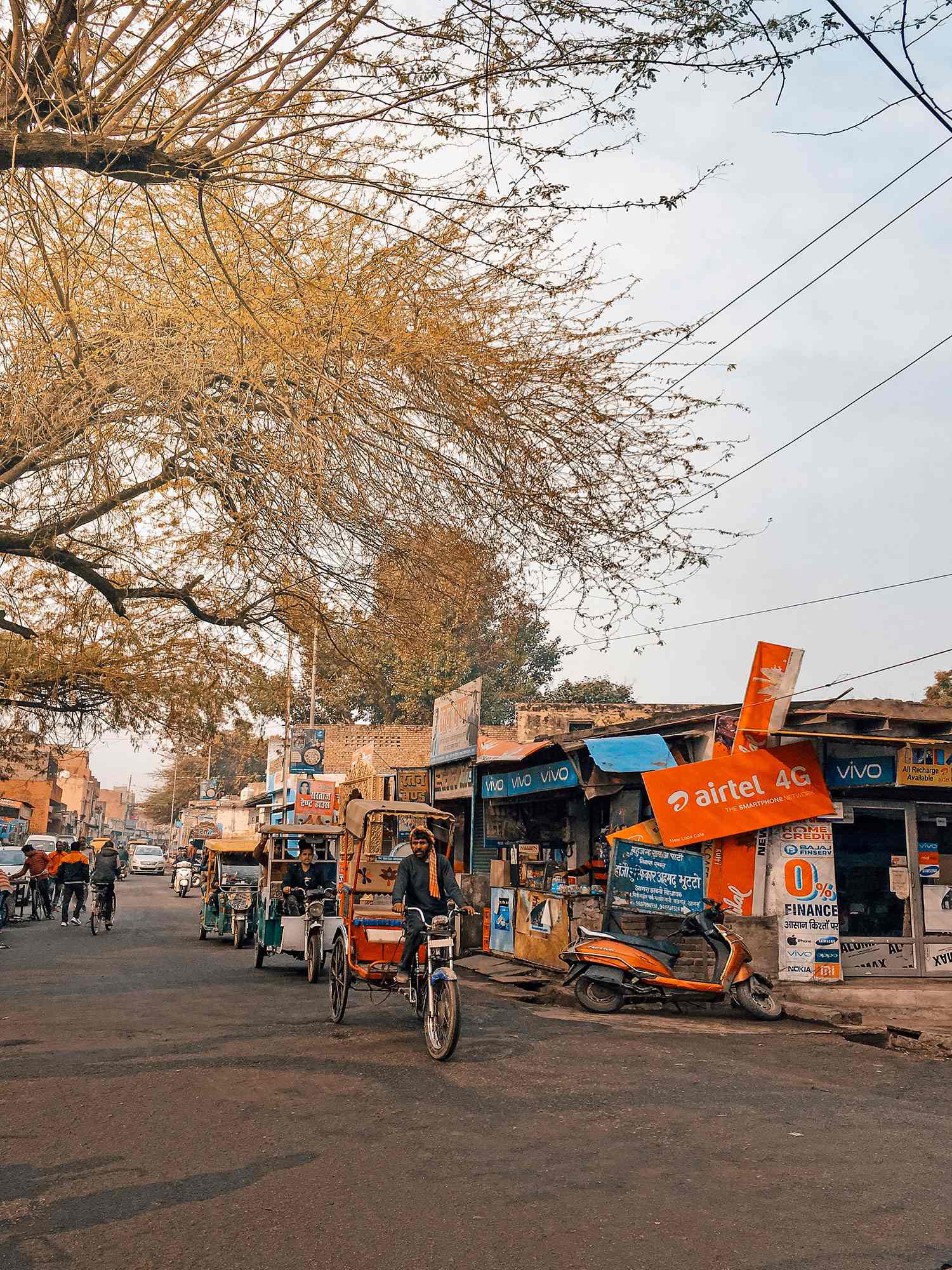
Agra’s climate does not have 4 seasons, but only 3 main seasons: winter, summer and the other season is the rainy season. Summer in India lasts 3 months from March to June, followed by a rainy season from June to September and the following winter from October to February of the following year.
September to March is the best time to explore Agra. During this time, Agra does not have rain and is not too hot, so visitors can comfortably check in without getting tired of the weather.
Agra travel guide: How to get to Agra?
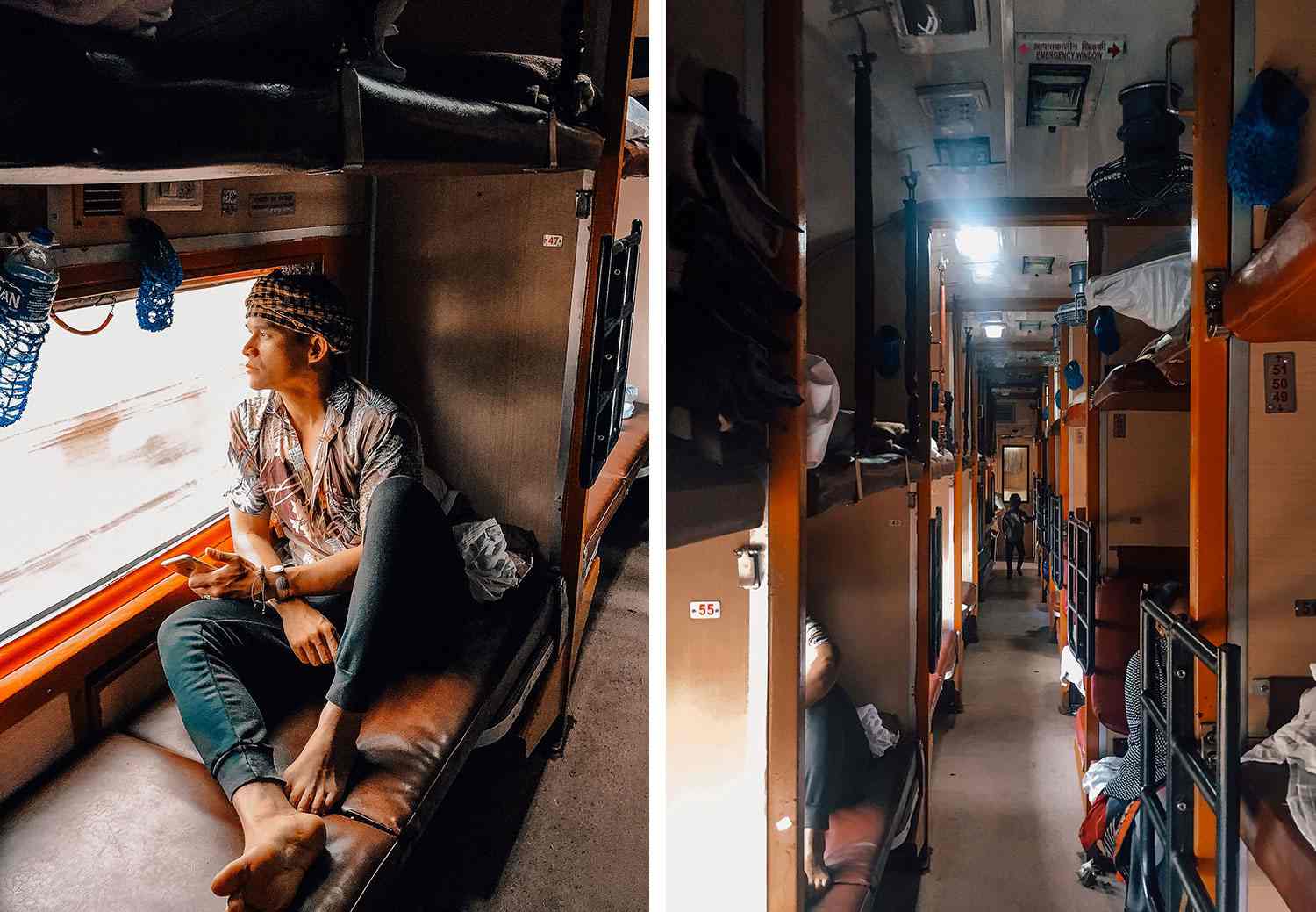
Usually, you will go to Agra from New Delhi by express train, stay for a few days and then take the train back to New Delhi or continue to other cities.
Because it is about 204km from the capital, you can also choose to go to Agra early in the morning to visit the Taj Mahal and return in the evening. However, this way is very rushed and it is not possible to visit the Taj Mahal at the most beautiful time of the day, which is early morning.

To traveling between attractions, tuktuk is still the most economical and reasonable option even though the roads are quite dusty.
From Agra train station, exit the station gate and then take a tuktuk back to the hotel.
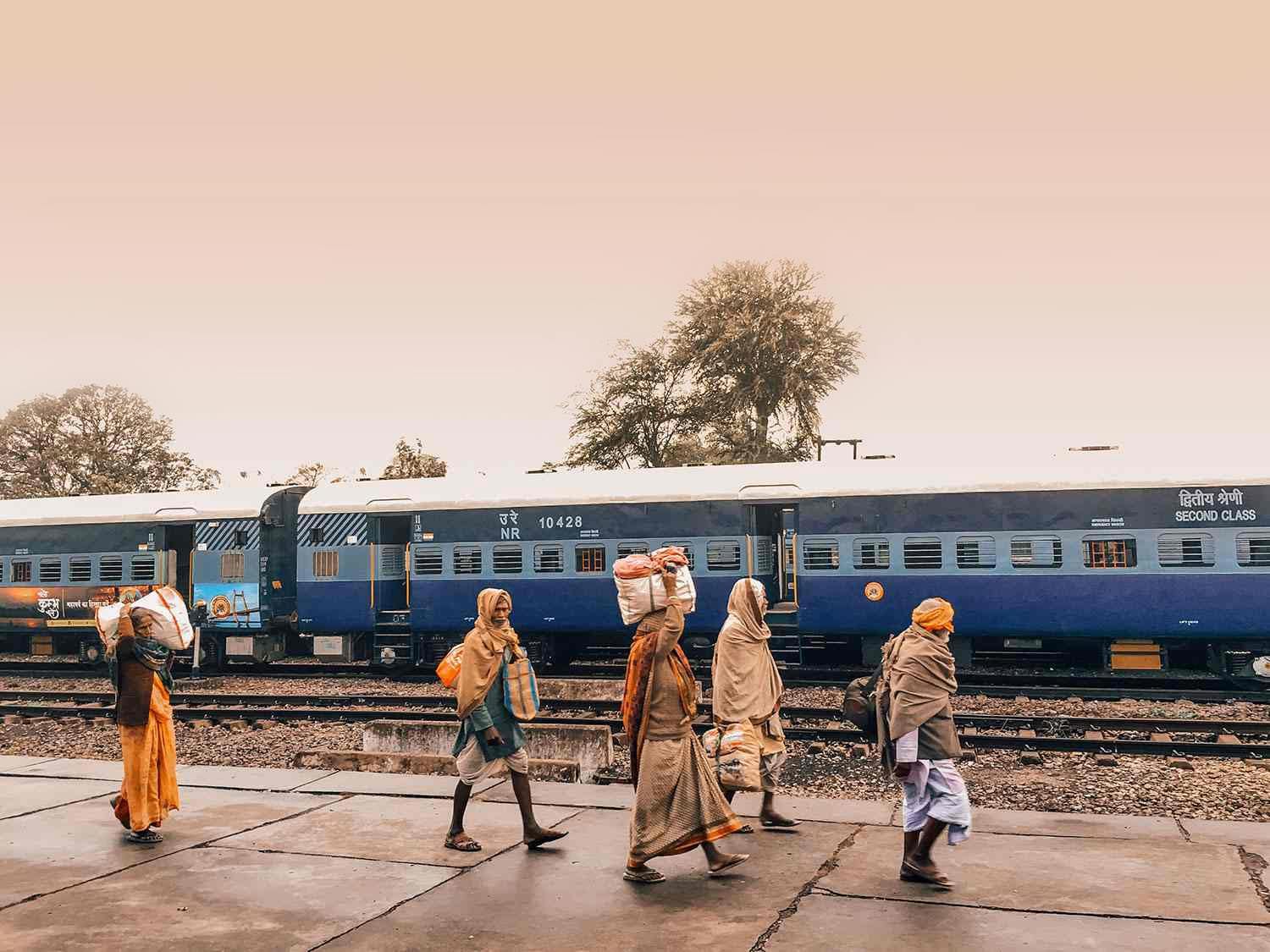
Agra city guide: How to get around Agra?
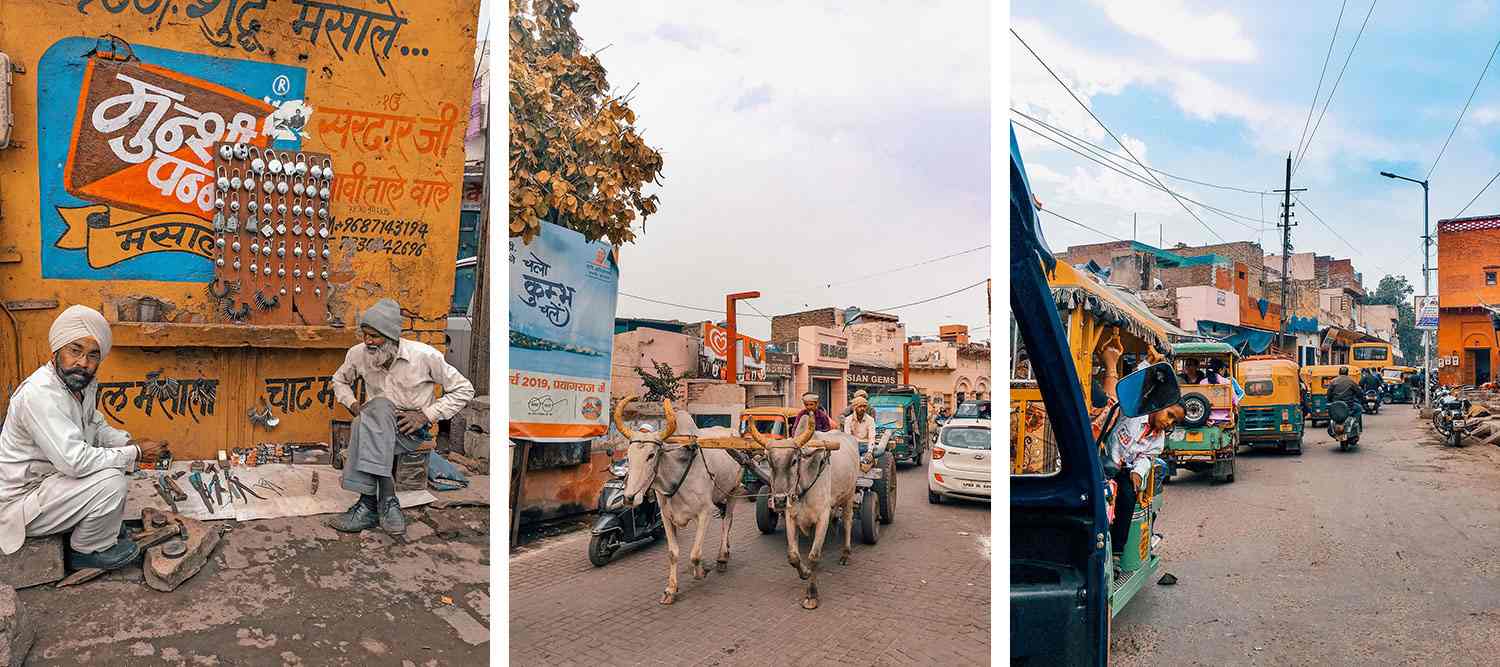
If you go with a large group, you should take Uber (in big cities like New Delhi or Jaipur, there is Uber service) or Tuktuk. The advantage of these two means over bus/metro is drop on/drop off at the place, no need to walk to the bus stop or station, don’t have to share with anyone. The price is also known in advance, going in a group so when share the cost, it’s not much.
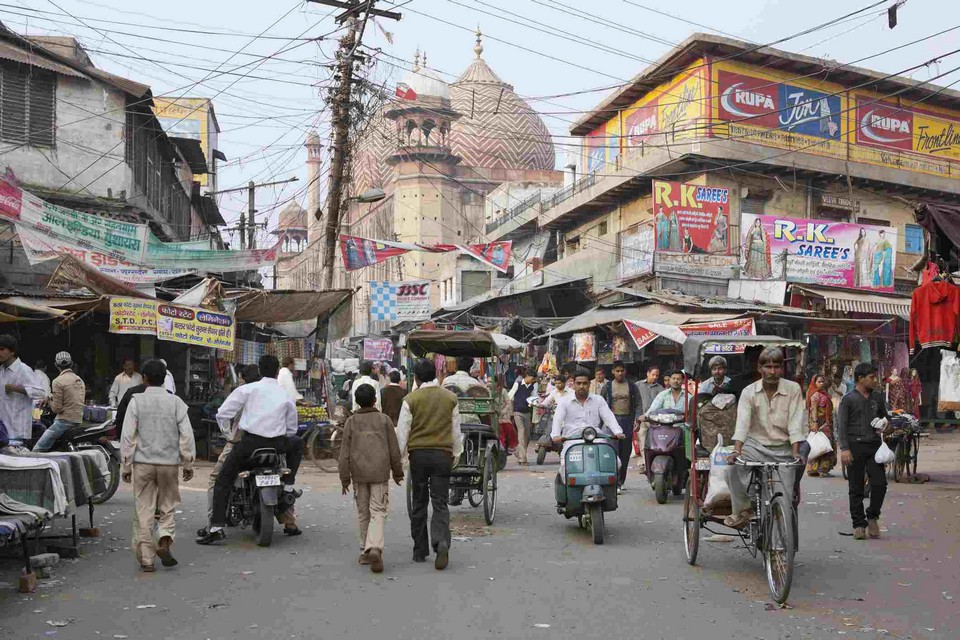
There is no Uber in Agra, so we travel entirely by Tuk-tuk, walking for short distances. Taking Tuk-tuk, you should remember always have to bargain. Tips are:
- Preview the distance in advance from the place of departure to the destination to estimate the appropriate price. I feel that tuktuk in Agra or Varanasi is more expensive than in a big city like New Delhi.
- Remember to bargain hardly because the drivers are very challenging, if you can’t pay the price, just turn around. Tuk-tuk is a lot, do not afraid to find another driver, if you refuse this driver, another driver will rush over.
- If you travel a lot in a day, you can negotiate the combo price for that whole day, attractions to go, time,… Only pay after the end of the day.
Agra travel blog: Where to stay?
Agra is the 4th city in my journey, so when I come here, I give a lot of priority to the most attractive place to visit of this city, the Taj Mahal. Therefore, I chose the hotel closest to its entrance gate for convenience.
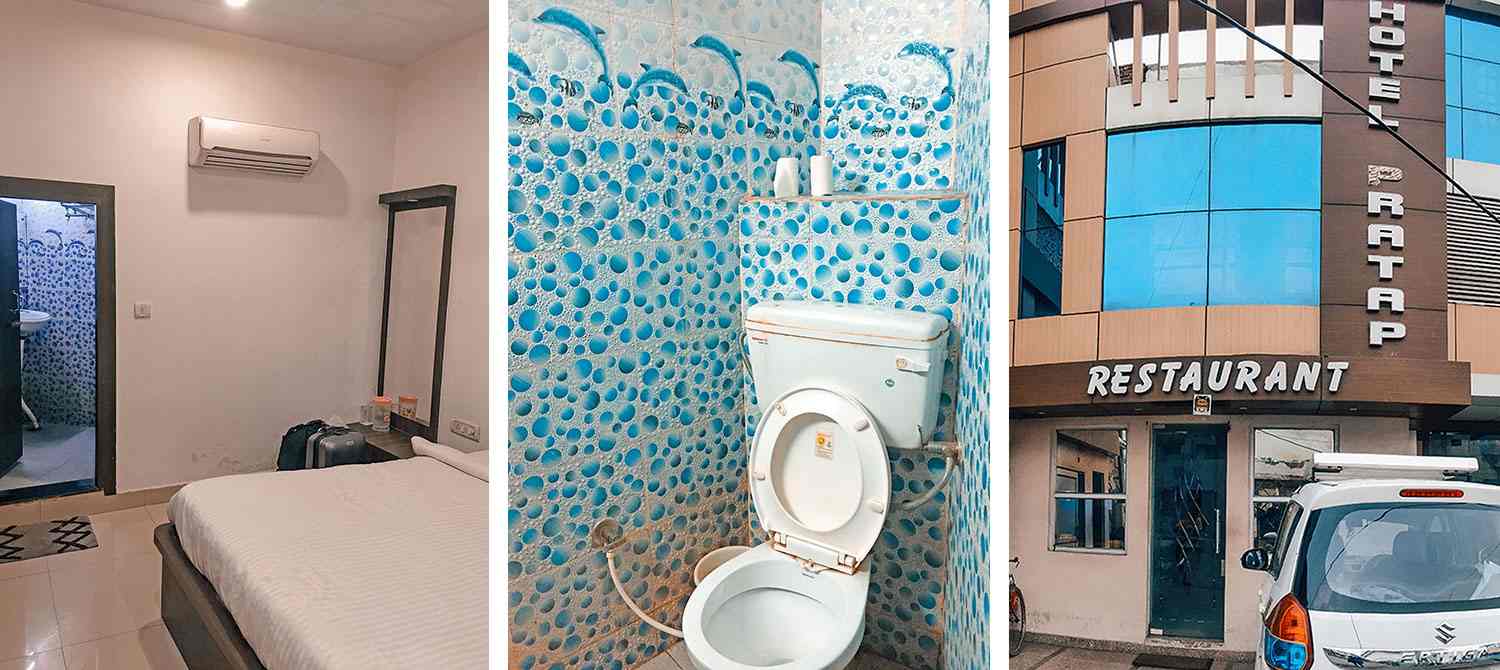
It can be said that the hotel in Agra is the worst hotel in almost 10 hotels I stayed in during my India trip. Terrible dirty room, without change bed sheet, no cleaning, no hot water… but always asking for a 5 star for rating after stay. And to avoid this issue, I recommend this tip: Just enter the name of the hotel you want to book into the Tripadvisor app to see reviews from previous guests. Pay attention to the good reviews from Indians, those reviews are not trustworthy because they are fake reviews to deceive you.
Below we recommend more best budget, mid-range and upscale hotels with good ratings and reviews you can refer to.
- DoubleTree by Hilton Hotel Agra ( Agoda.com or Booking.com )
- Holiday Inn Agra MG Road, an IHG hotel ( Agoda.com or Booking.com )
- Crystal Sarovar Premiere ( Agoda.com or Booking.com )
- ITC Mughal, a Luxury Collection Resort & Spa, Agra ( Agoda.com or Booking.com )
- Trident, Agra ( Agoda.com or Booking.com )
- Courtyard Agra ( Agoda.com or Booking.com )
- Jaypee Palace Hotel & Convention Centre ( Agoda.com or Booking.com )
- The Oberoi Amarvilas ( Agoda.com or Booking.com )
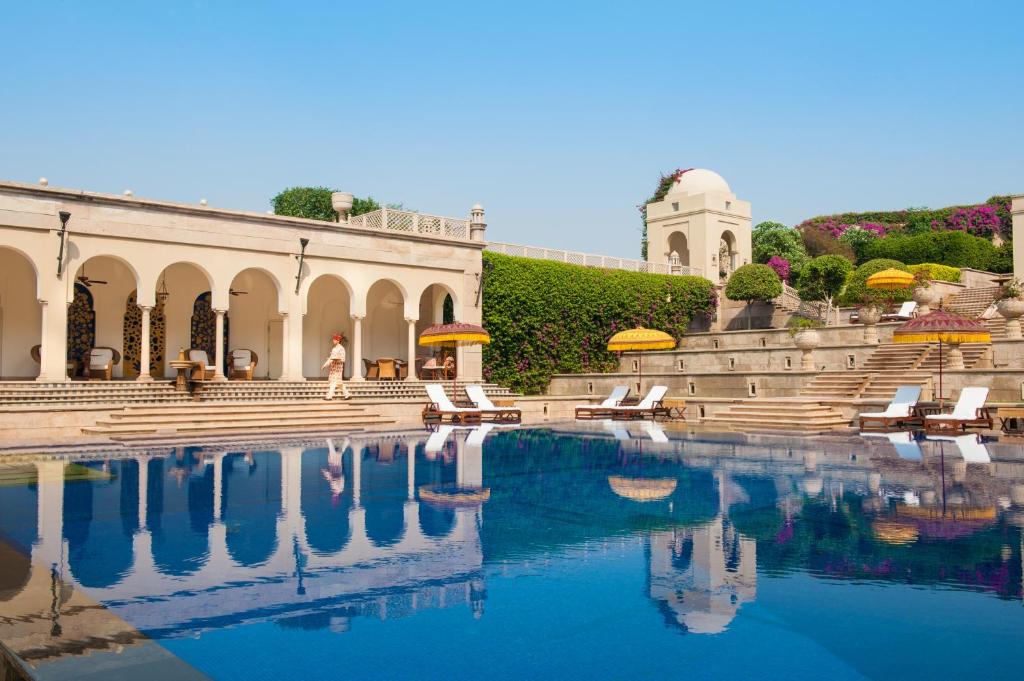
Check out more top and best hotels in Agra on Agoda.com or Booking.com .
Agra travel blog: Where to go and what to do in Agra?
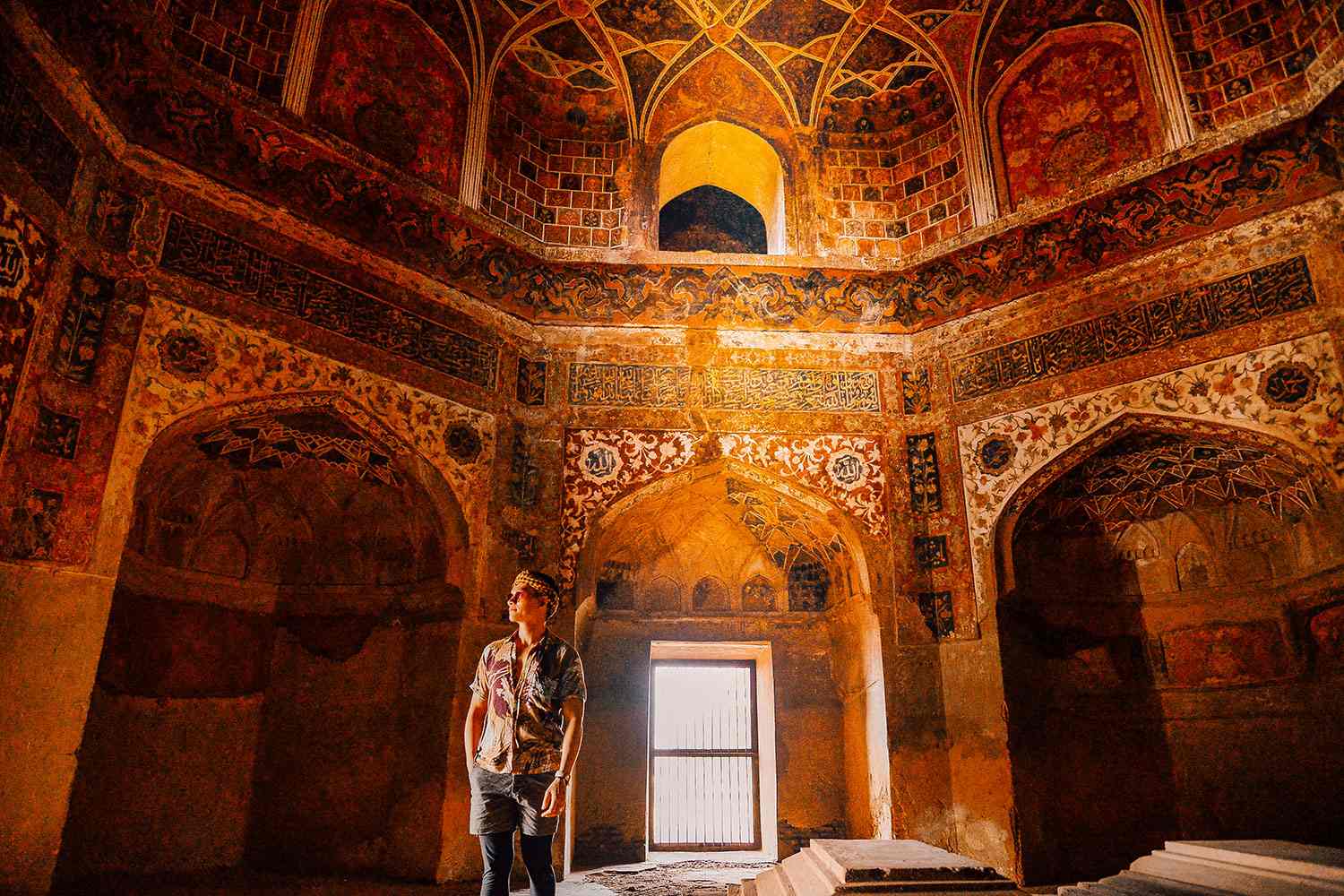
With an Agra itinerary 3 days 2 nights, I will share with you the places that I think are really beautiful and worth going.
1. Taj Mahal 2. Agra Fort 3. Fatehpur Sikri 4. Itimad-ud-daulah’s Tomb 5. Jama Masjid 6. Mehtab Bagh 7. Local market 8. Rooftop coffee 9. Chini Ka Rauza
A few notes:
- If you have been to, or plan to go to Jama Masjid in New Delhi, you should skip Jama Masjid in Agra because it is nothing special.
- Fatehpur Sikri is very far from the center, it takes a whole day to go here and return, so I also skipped it because I didn’t have too much time for Agra.
- I also skipped Agra Fort because I have visited too many forts in Jaisalmer, Jaipur, Jodhpur… so this place is not very attractive to me. Instead I spent quite a lot of time for the Taj Mahal.
Address: Dharmapuri, Forest Colony, Tajganj, Agra, Uttar Pradesh 282001, India Construction started: 1631 Height: 73 m
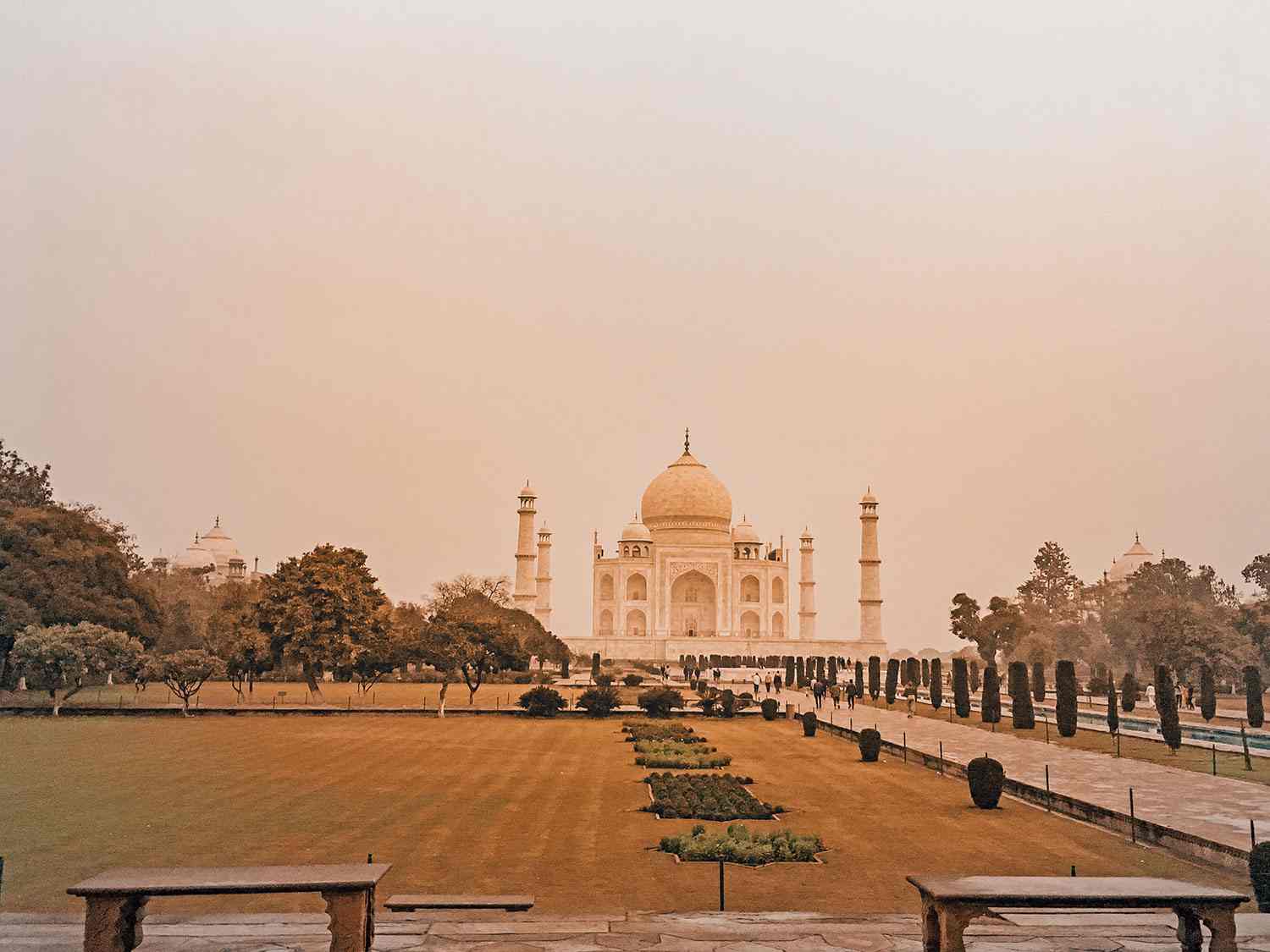
Details on how to go, how to take beautiful photos and important information when visiting, I will dedicate another article to have more information for you refer to.
If you don’t have much time for the Taj Mahal, you can buy a day tour from your hotel in New Delhi. There will be a shuttle service to pick up and drop you off at the place. If you are familiar with train travel in India, you can also buy a express train ticket to go back and forth in the same day, although it is a bit difficult.
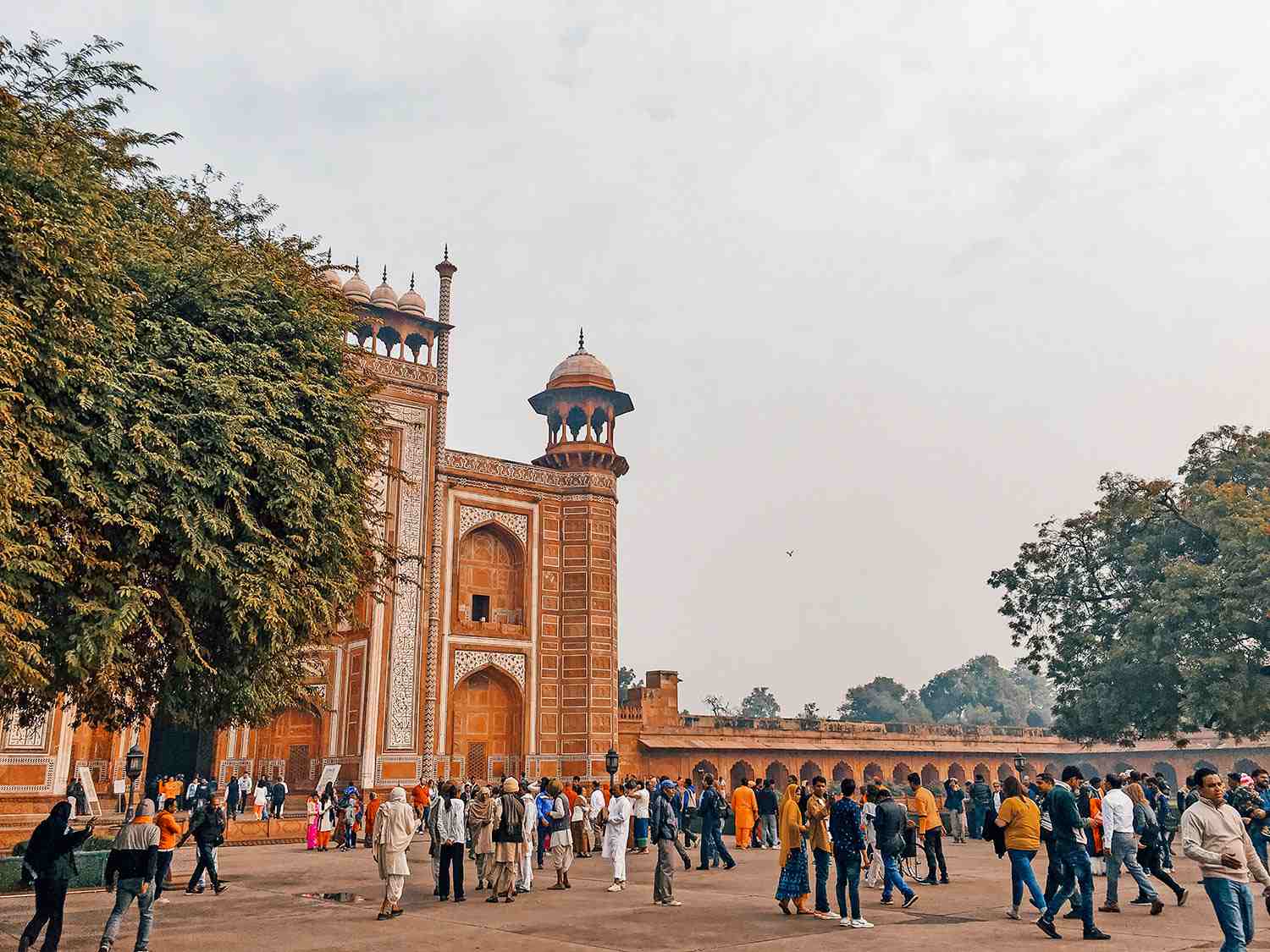
The Taj Mahal is very crowded, or in other words, extremely crowded from the very early morning, most of which, I think 80-90%, are Indian tourists. So queuing to buy tickets is also very difficult. So, you can also purchase tickets in advance through travel apps or through the official Taj Mahal website here: https://www.tajmahal.gov.in/
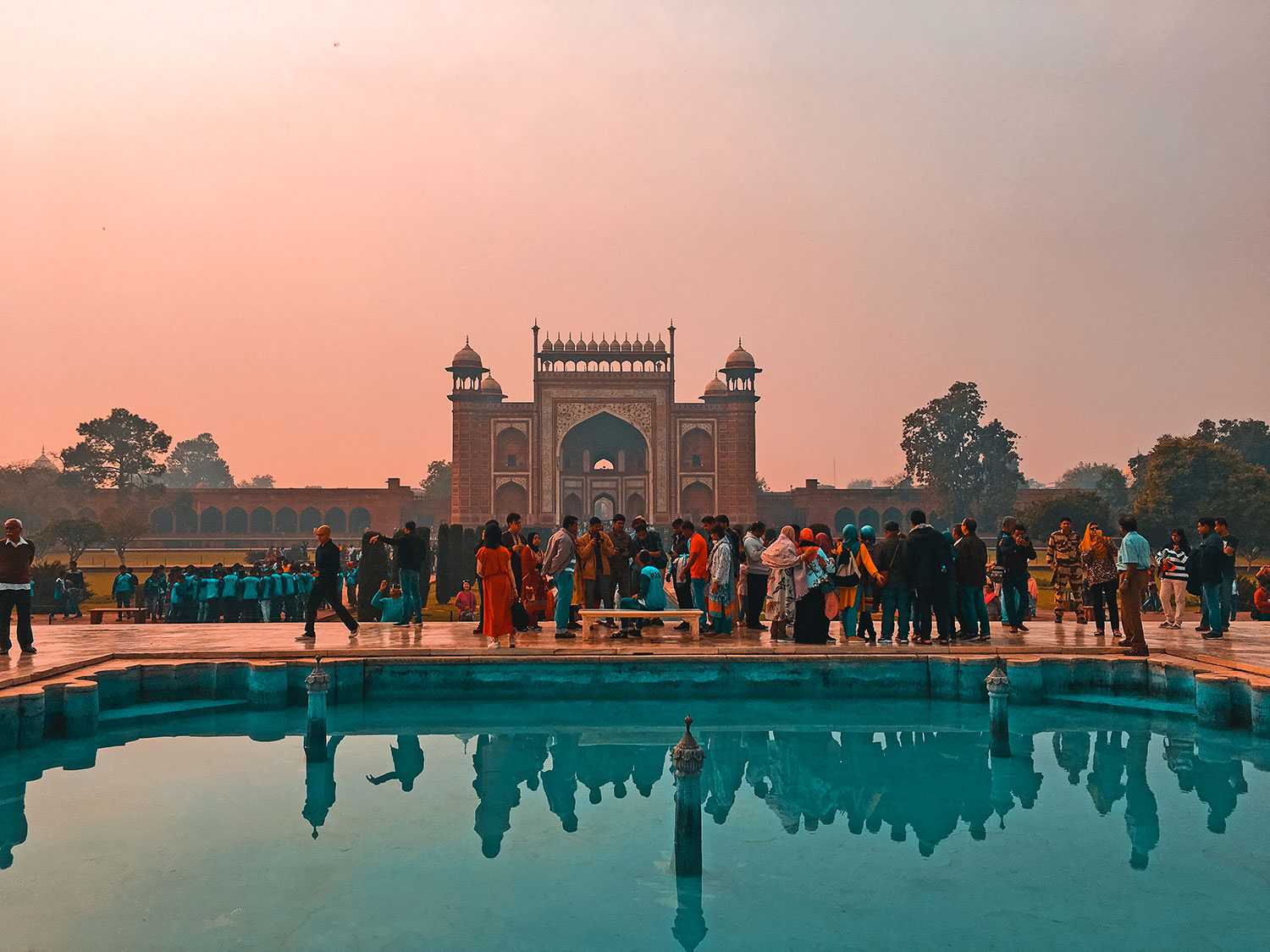
Each ticket is only allowed to visit in the Taj Mahal for exactly 3 hours, if you return late, you have to pay an extra fee. Day tickets are not allow to access at night. On the ticket, there are very specific requirements, please remember to read carefully.
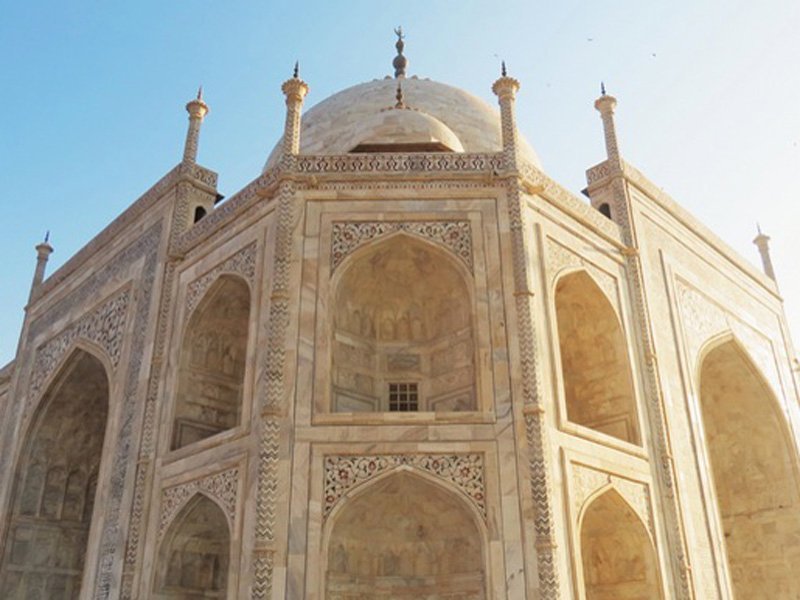
Important note: Taj Mahal is closed on Fridays for general viewing.
Address: Agra Fort, Rakabganj, Agra, Uttar Pradesh 282003, India
Agra Fort is also known as Lal Qila, Fort Rouge or Red Fort. Agra Fort is the second most important destination after the Taj Mahal. Agra Fort is located in the northwest of Agra city, 2.5 km northwest of Taj Mahah. So, standing here you can see the Taj Mahal in the distance.
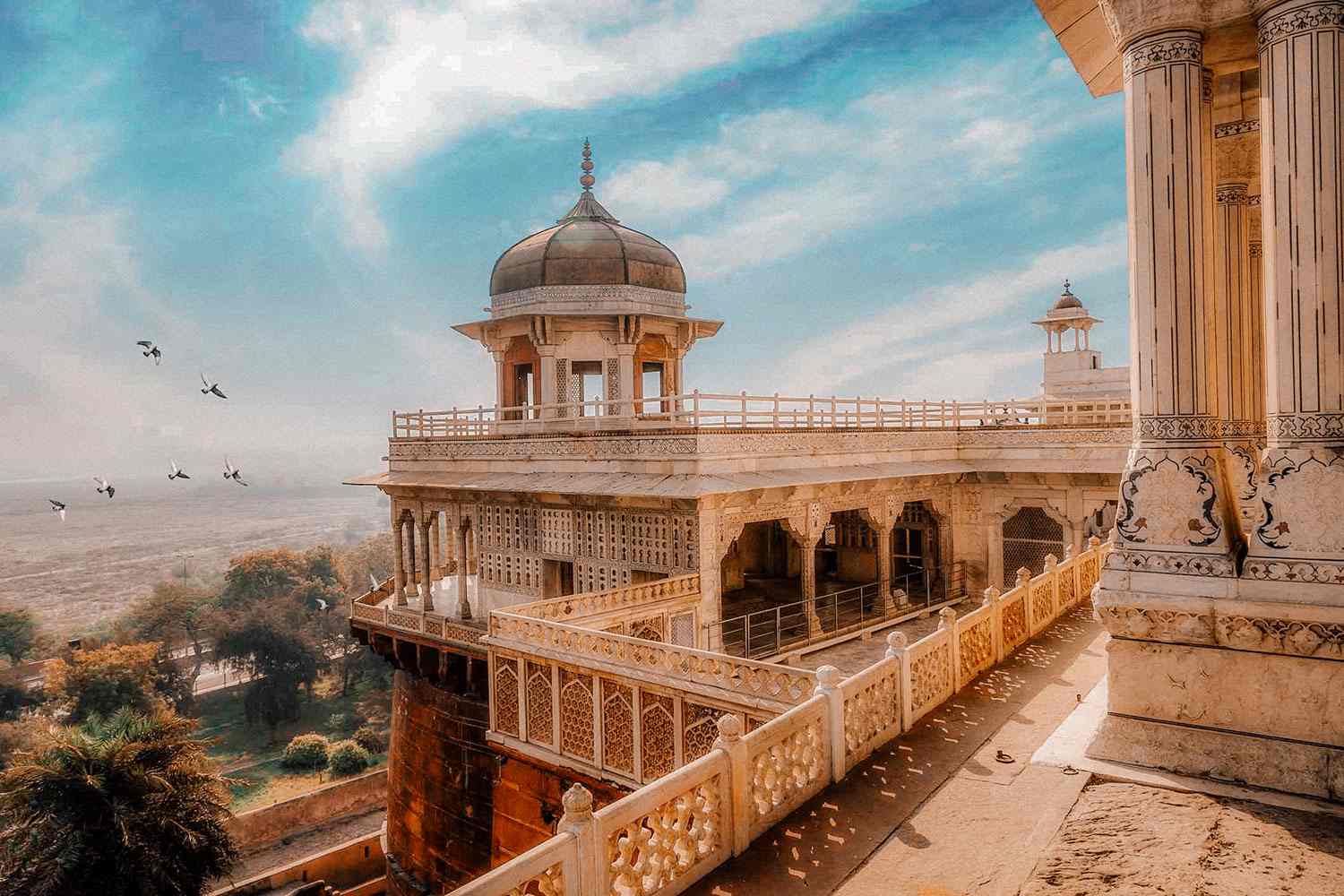
Originally Agra Fort was a brick fortress built by a family of Rajputs. However, the fort was later occupied by the Mughal dynasties and later rebuilt by the emperor Akbar. The inside of the fortress also includes mosques, halls, palaces, towers, and beautiful courtyards.
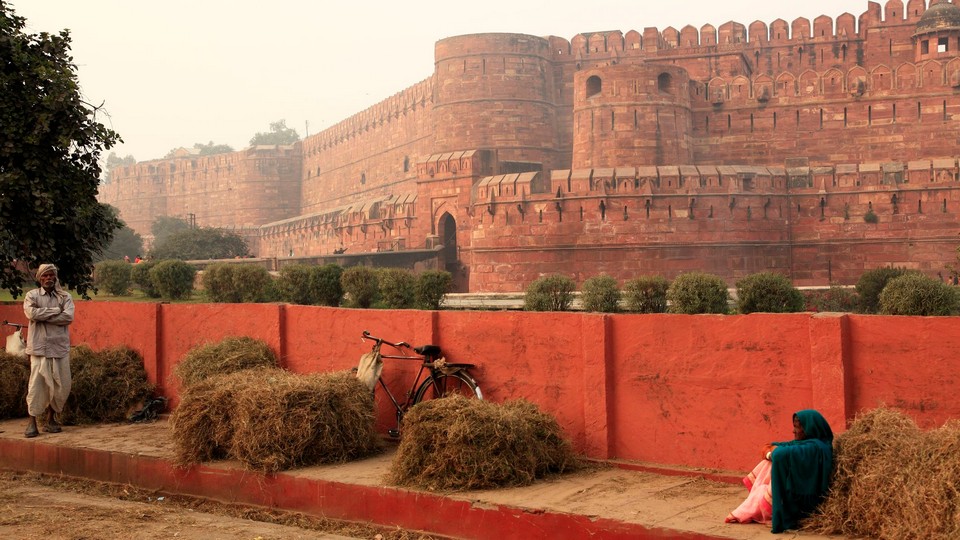
Itimad-Ud-Daulah
Address: Moti Bagh, Agra, Uttar Pradesh 282006, India Hours: 8AM–12AM
This mausoleum is located across the Yamuna River, also known as Baby Taj for short. The main structure of the mausoleum is built of white marble and is famous for its elaborate and sophisticated carvings. Many people consider it to be a small version of the Taj Mahal because of its very similar architecture.
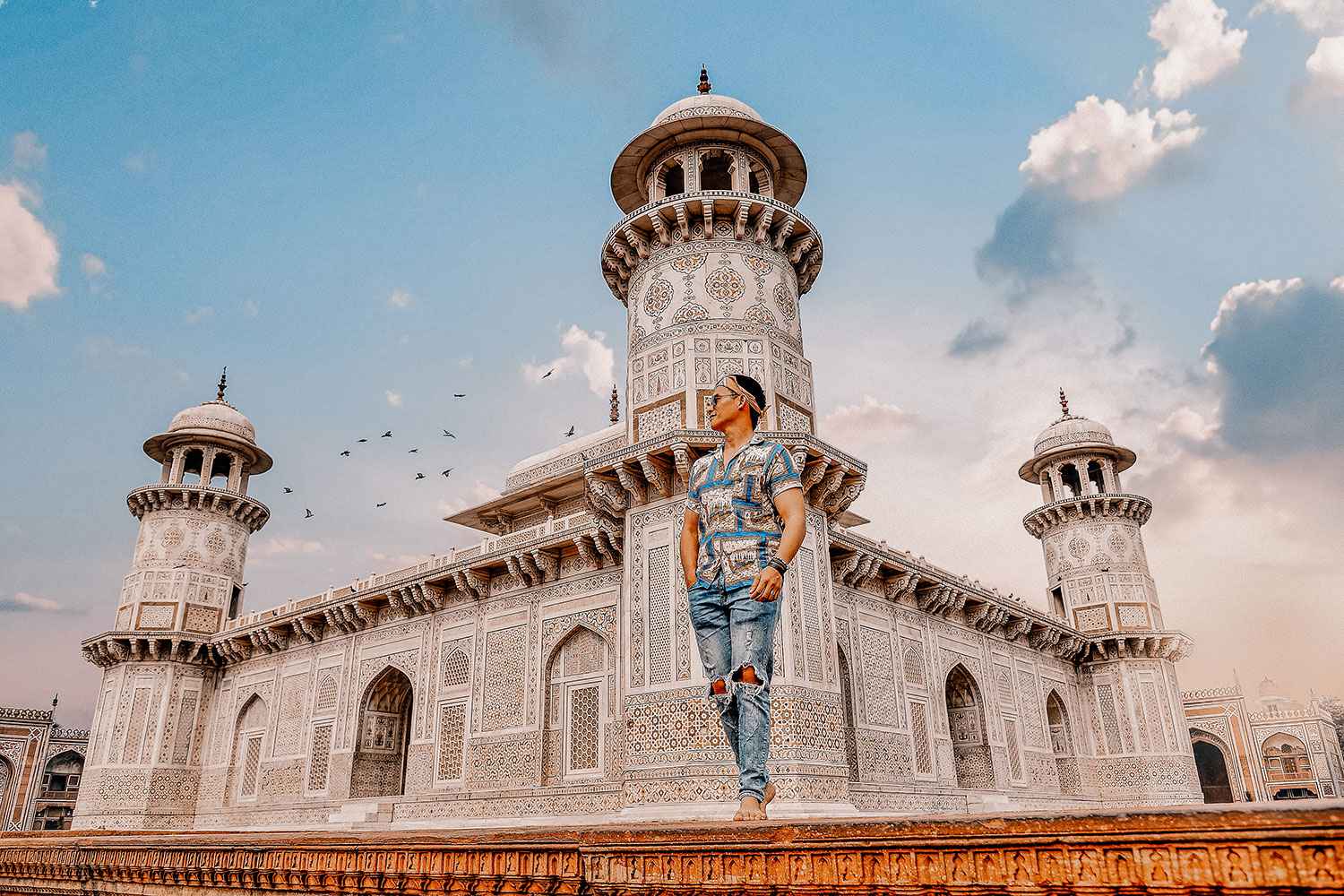
This mausoleum was built in honor of Mirza Ghiyas Beg, a bankrupt merchant who got lucky after his wife gave birth to their daughter Nur Jahan.
Thereafter, Ghiyas Beg became the great treasurer under the Mughal Emperor Jahangir and was conferred the title Itmad-ud-Daulah (The “pillar of the State”) while his daughter was married to the emperor.
His daughter, Nur Jahan, built this mausoleum for her father in the 1620s and his granddaughter, Mumtaz Mahal, was also built the Taj Mahal by her husband, the emperor Shah Jahan.
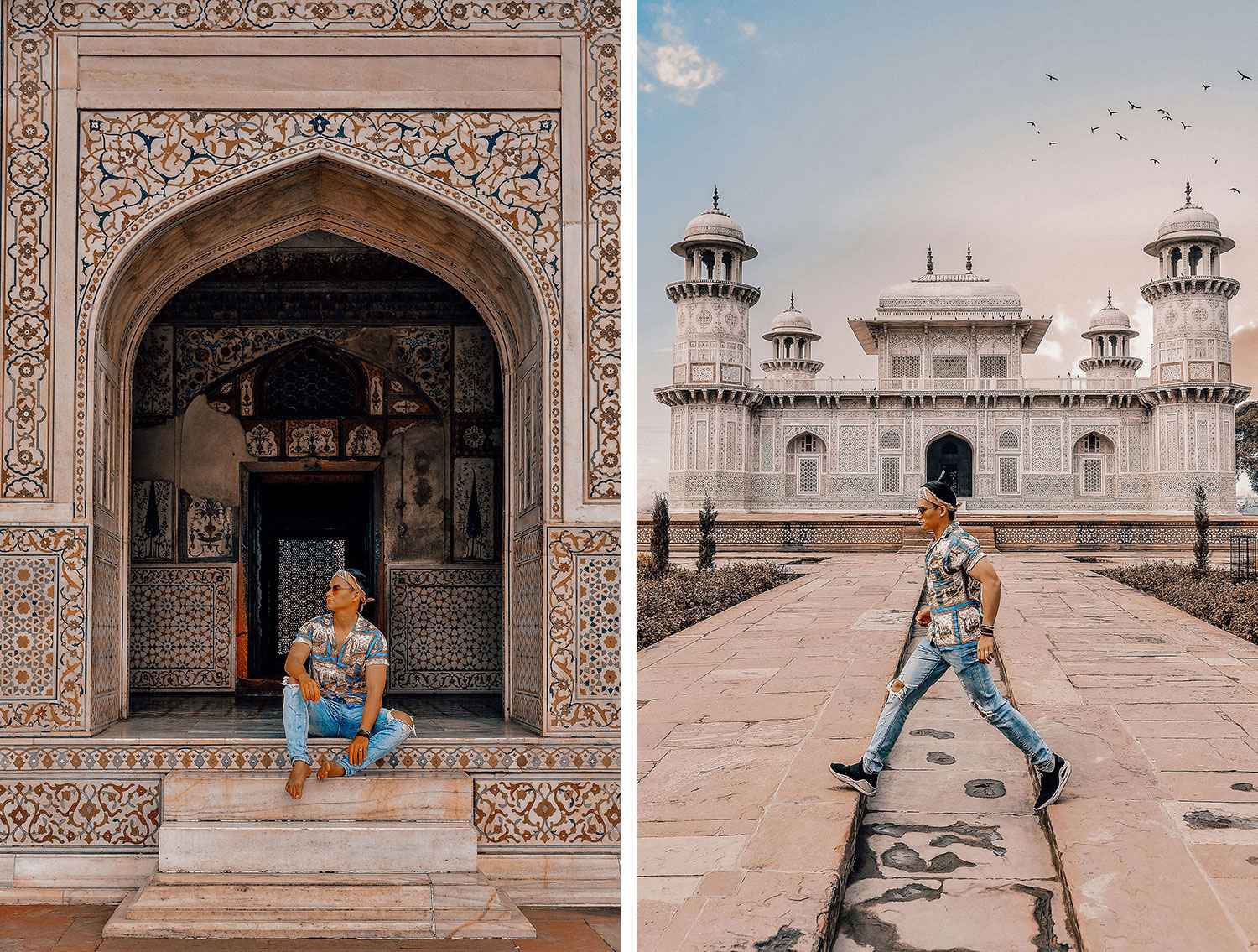
After visiting the Taj Mahal, you can catch a tuktuk to continue going to Itimad-ud-daulah which is reasonable because they are quite close to each other.
Jama Masjid
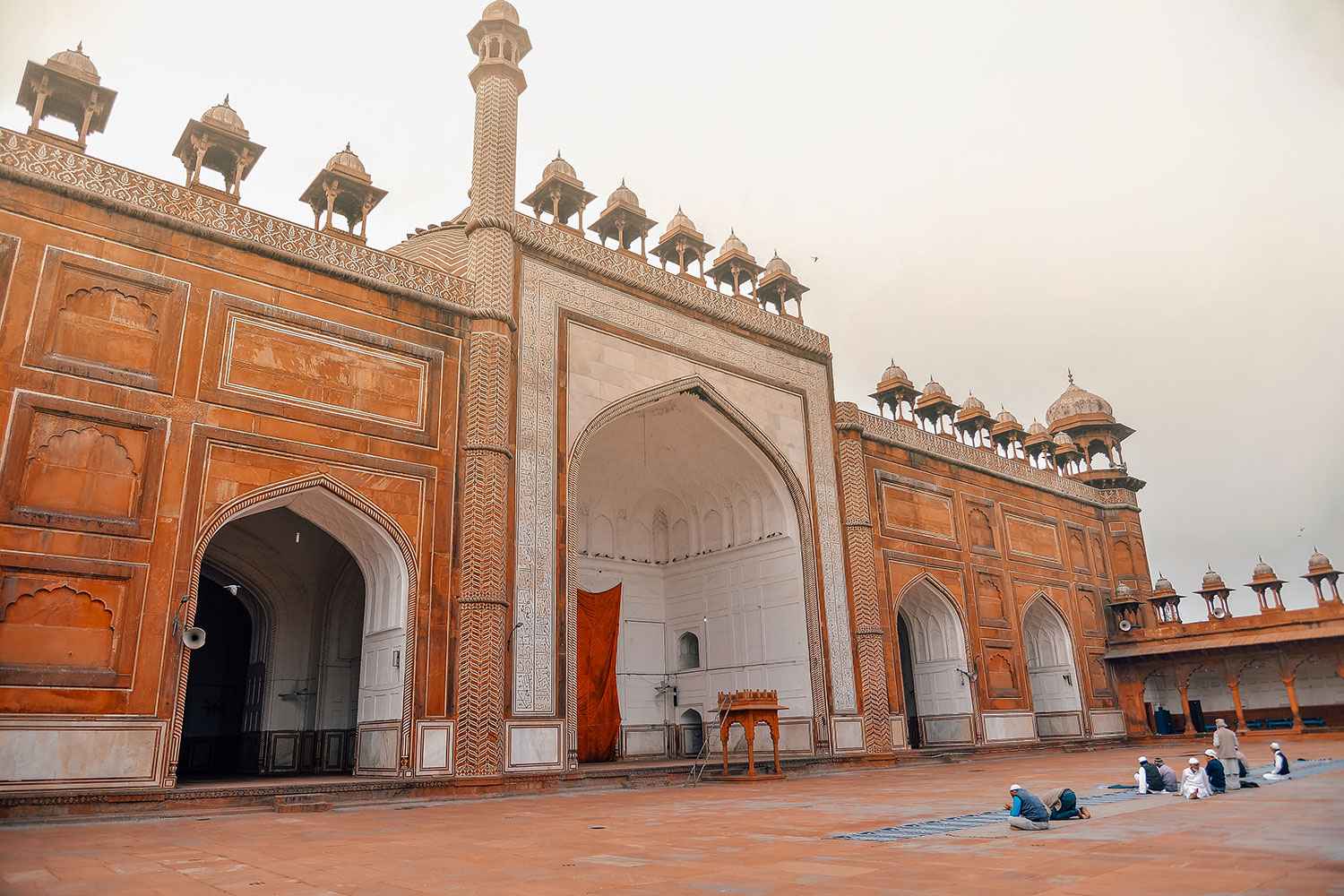
This mosque is a magnificent 17th-century Mughal masterpiece set amidst the bustling traditional markets of Agra. Jama Masjid with its impressive architecture stands prominently on a high platform in the center of a vibrant traditional market.
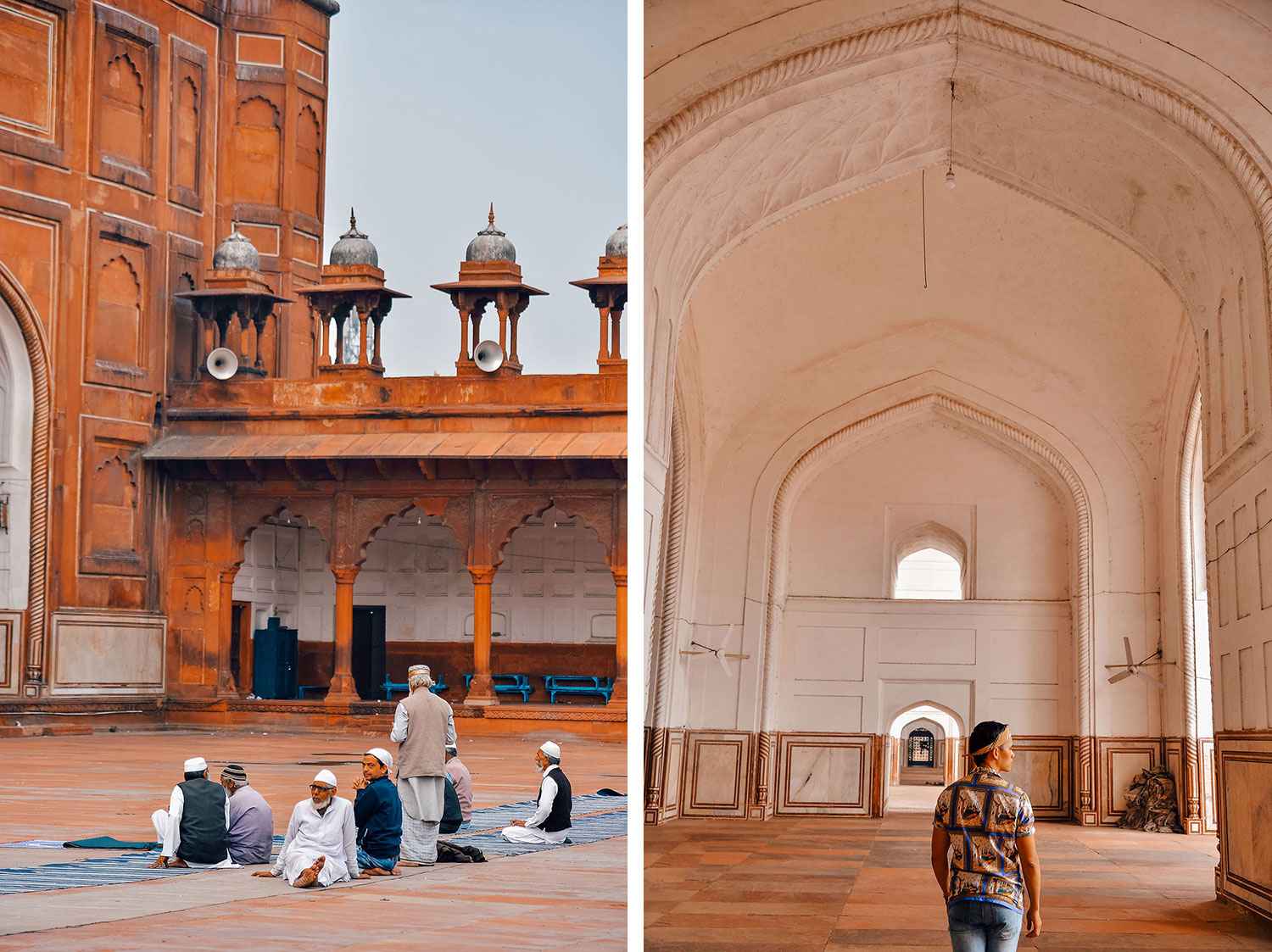
The Mosque is located in the middle of the lively Kinari market in Agra, near Agra Fort Station and about a 15-minute drive from Agra Cantonment Station.
While here, make sure to walk along the maze-like walkways of Kinari Market to discover shops selling a variety of colorful fabrics, jewelry, sari, spices and more.
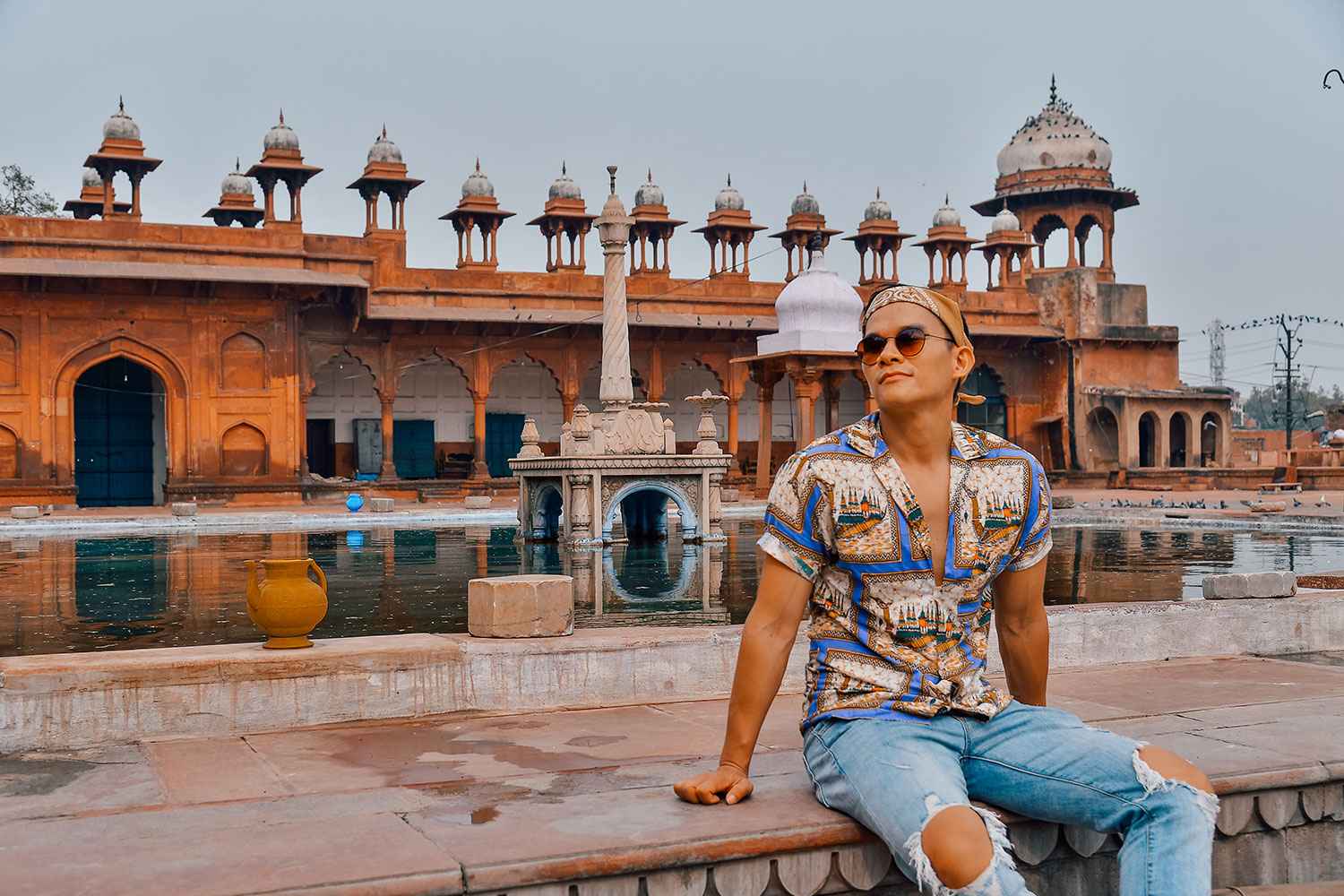
Mehtab Bagh
Address: near Taj Mahal, Dharmapuri, Forest Colony, Nagla Devjit, Agra, Uttar Pradesh 282001, India Hours: 6AM–9PM/Thursday: 6AM–5PM

Also known as Moonlight Garden, it is located on the north bank of the Yamuna River, opposite the Taj Mahal overlooking a river, and is a great place to see the Taj Mahal from afar.
The park Mehtab Bagh is not very special, apart from seeing the Taj Mahal from afar, especially in the afternoon is a very beautiful time. Admission is INR 100 but Indians will be free.
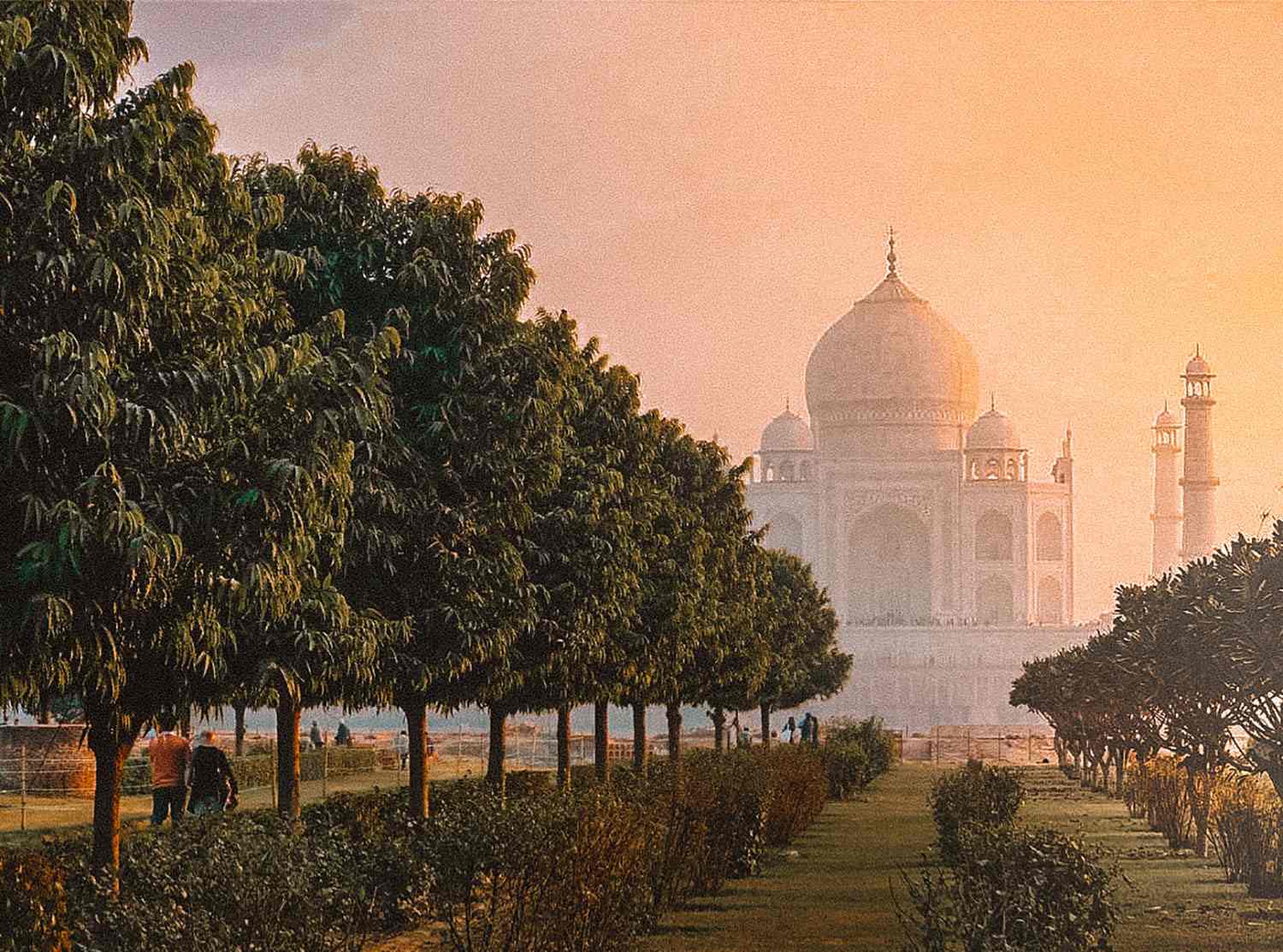
Craft workshops
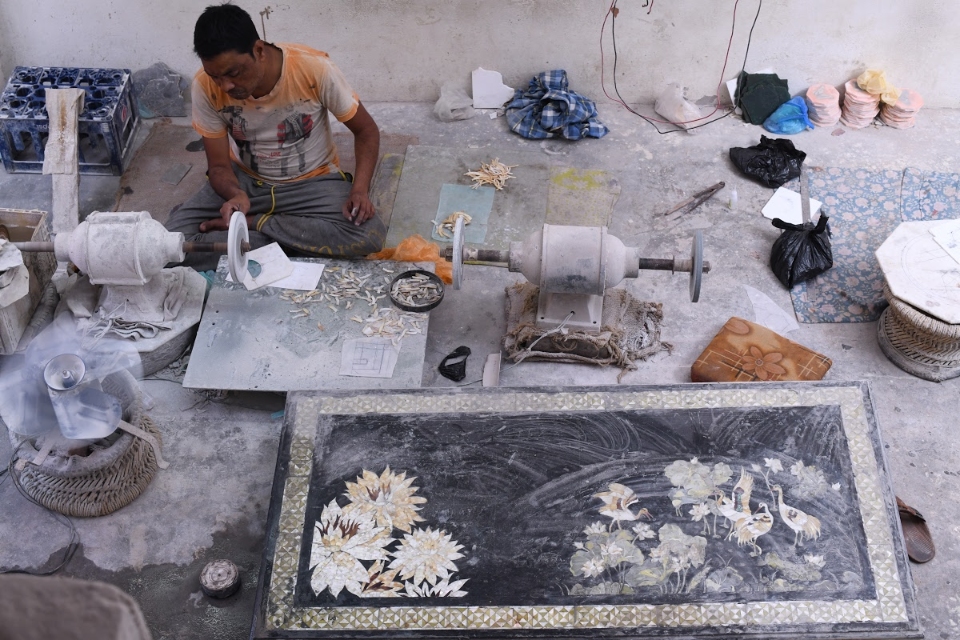
These are also well-known places to visit of Agra that is loved by many tourists. Here you can choose great souvenirs for relatives and friends. Agra’s famous products are stone sculptures. In which, the statue of the Mughal Emperor is considered the pinnacle of sculpture.
Mughal Heritage Walk in Kachhpura Village
The Mughal Heritage Walk was initiated by Centre for Urban and Regional Excellence (CURE India). This is a community-based tourism initiative in India to help local people get more income from tourism, thereby improving people’s lives.

Taj Mahal and Agra Private Tour with Kachhpura Village Walk from Delhi
People trained to be guides for tourists participate in a 1km walk, on the riverbank on the opposite side of the Taj Mahal, through the village of Kachhpura and the last stop is Mehtab Bagh. Along the way you’ll get to visit lesser-known ruins of the Mughal Age, admire the views of rural India, interact with locals, and of course admire the stunning beauty of the Taj Mahal.
What to do in Agra India: Local markets
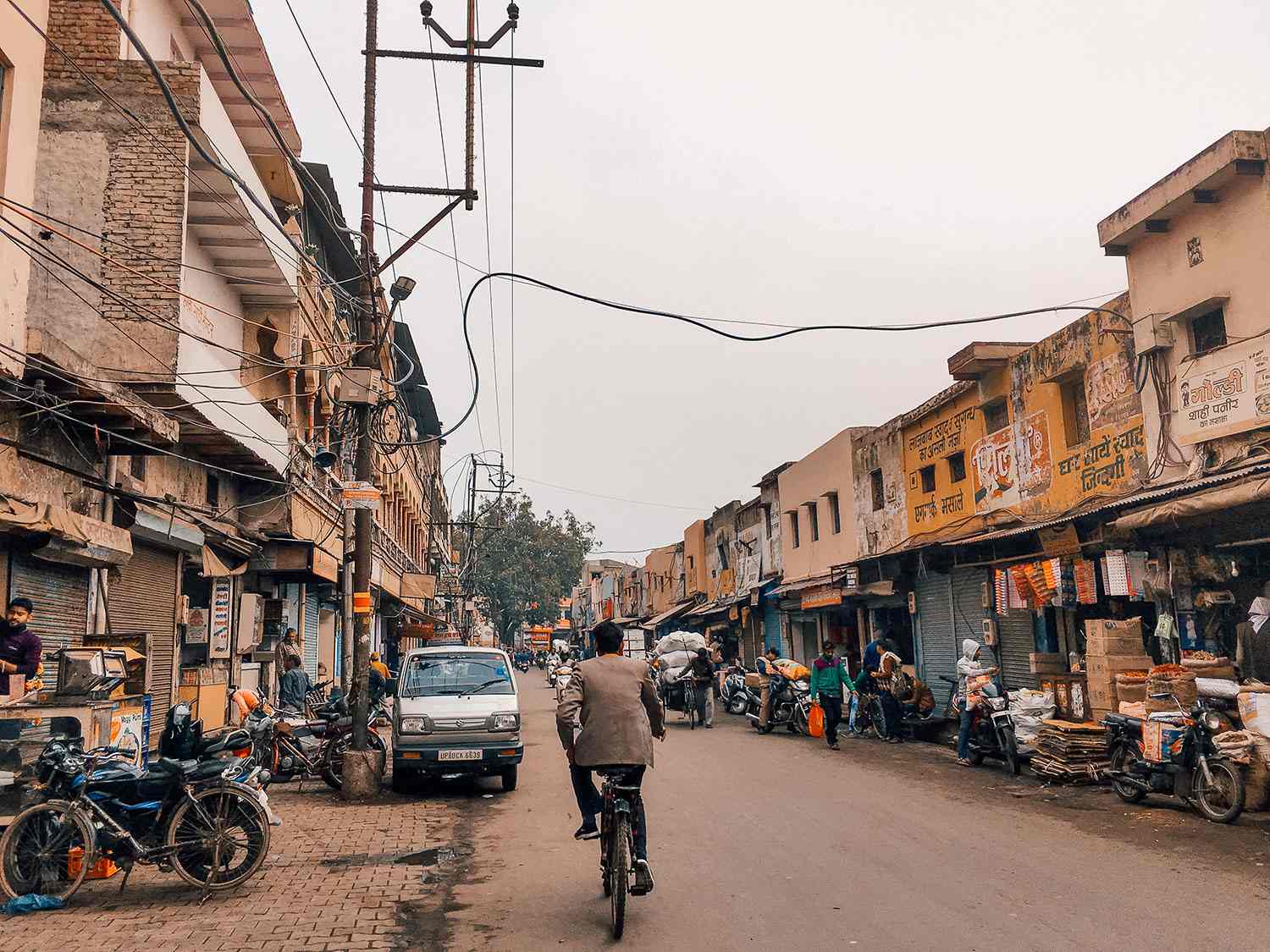
A market in Agra that is mentioned by many people is Sadar Bazaar. This can be considered as the central local market because it is quite large, trading is very busy.
If you don’t have time, you can also visit the Kinari market located right next to the Jama Masjid.

Rooftop cafe
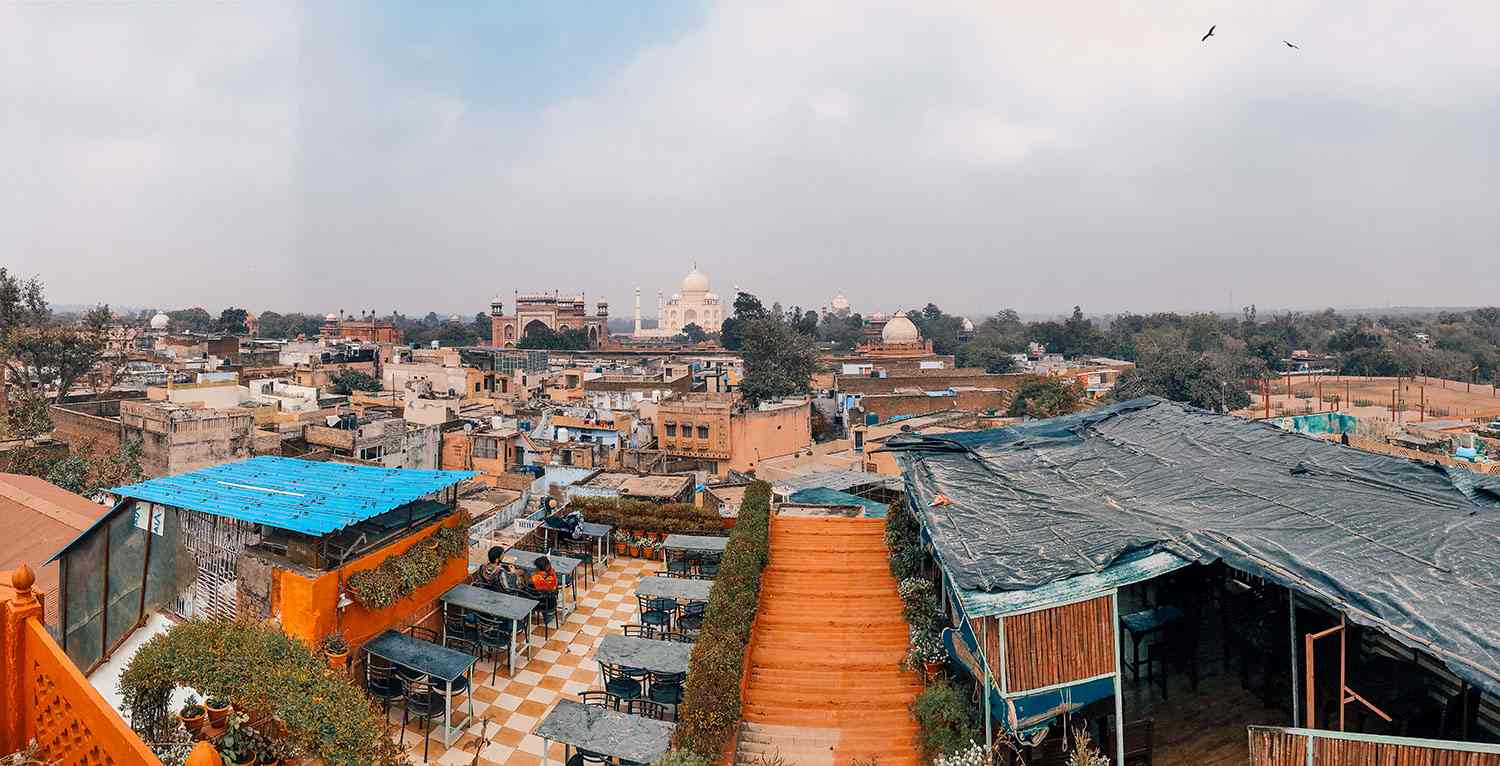
Many people whisper to each other to visit the rooftop coffee Hotel Saniya, because here, you can see the Taj Mahal from afar. Sipping a cup of coffee, sitting on the windy roof watching 1 of the 7 wonders of the world is a very wonderful feeling that you should experience.
Hotel Saniya serves drinks and meat dishes, mainly chicken. But looking at the piece of chicken dyed red with curry is not very attractive.

Address: 34/277 Chowk Kajziyan South gate of Taj Mahal, Tajganj, Agra, Uttar Pradesh 282001, India Hours: Open 24 hours
Chini Ka Rauza
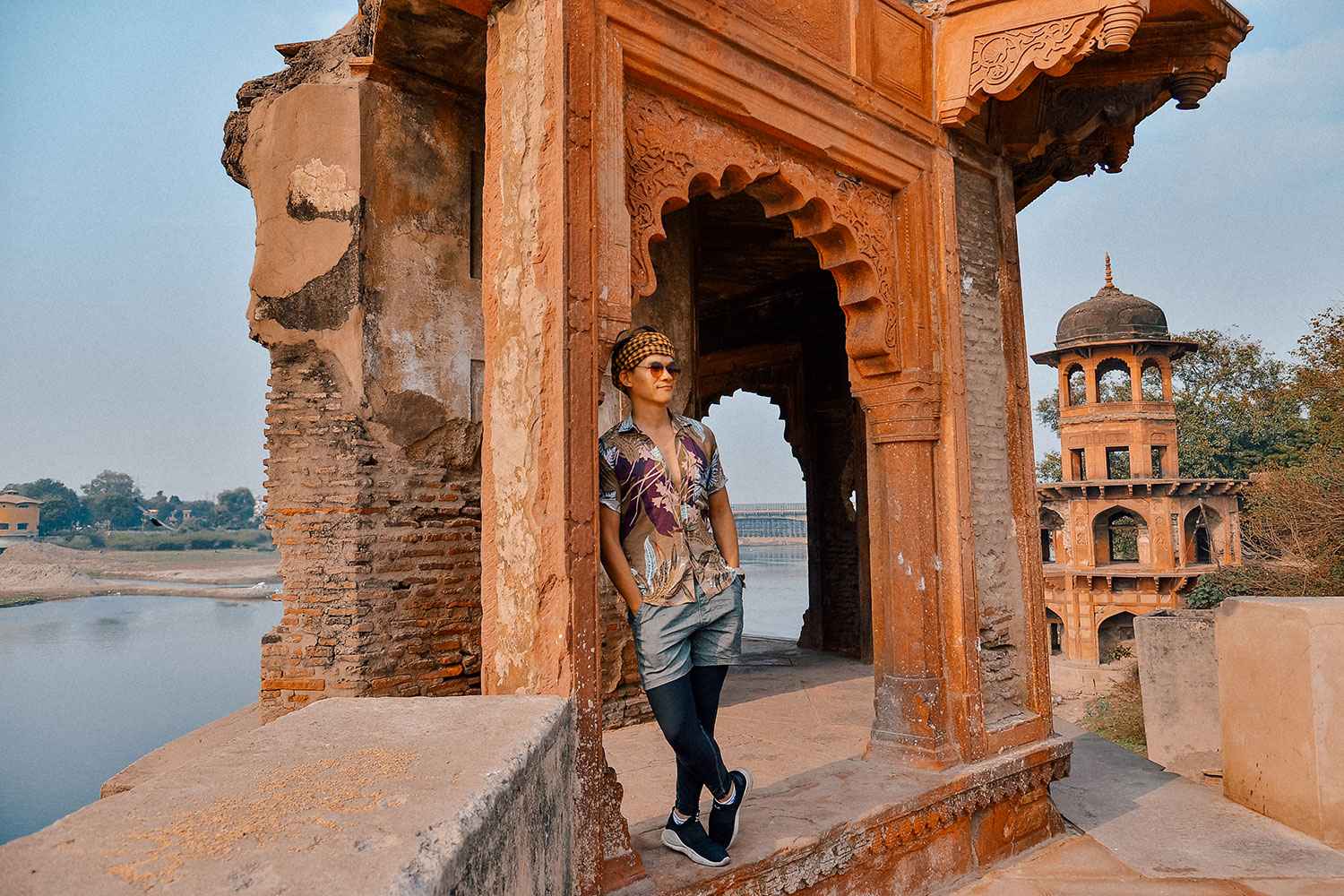
This is the tomb of Allama Afzal Khan Mullah, a scholar, poet and close-in-chief of the Mughal Emperor Shah Jahan. The tomb was built in 1635. Chini ka Rauza is located just 1 km north of the Tomb of Itmad-Ud-Daulah, on the east bank of the Yamuna River.
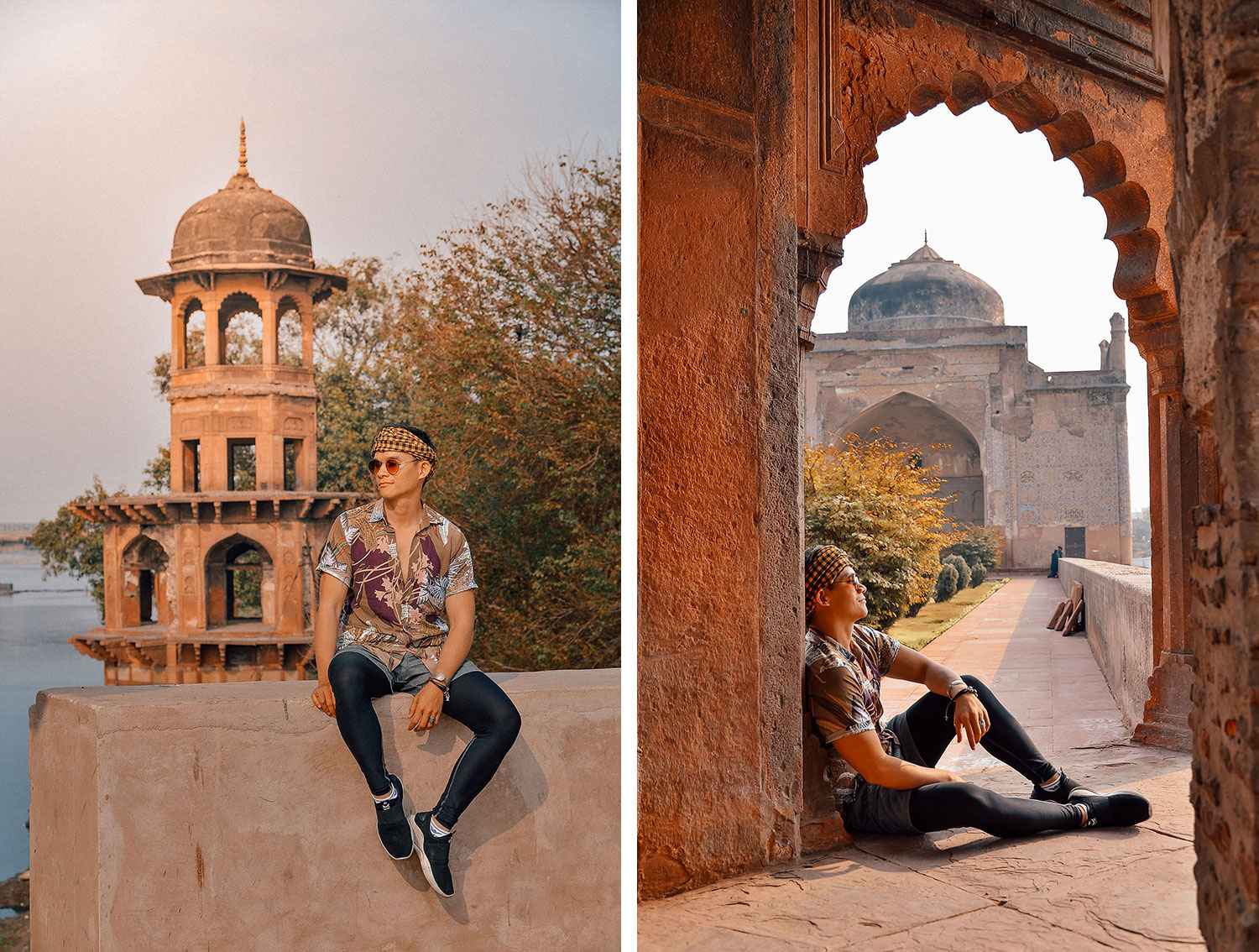
Therefore, after visiting Itmad-Ud-Daulah (Baby Taj) you can visit here very conveniently. The tomb is located in a spacious and airy ground, next to the windy, quiet Yamuna River, there were almost no tourists, so many locals come here to walk and read books.
Agra travel tips
- For me, Agra is not very special except the attraction of the Taj Mahal. Therefore, I just spent 3 days in Agra and then took the train down to Varanasi to continue my journey in India.
- You can visit Agra for 1-2 days then return to New Delhi or continue heading to Varanasi is the most convenient route.
- You should choose a hotel near the Taj Mahal so that you can get up early to take beautiful pictures.
- Agra is quite dusty, so always have a mask and outerwear ready.
- You should visit the Taj Mahal in the morning to avoid crowds. The afternoon is spent visiting one of the sites: Agra Fort, Akbar Tomb and the last stop is Mehtab Bagh to watch the sunset.
- You should check and bargain the tuk tuk driver. Tuk tuks and taxis here always say overcharge, always 2-3 times higher.
- Go to places of interest, just go to the ticket booth to buy tickets, don’t listen to fake tour guides.
- Some spots need to book tickets in advance to avoid crowds: Taj Mahal, Agra Fort.
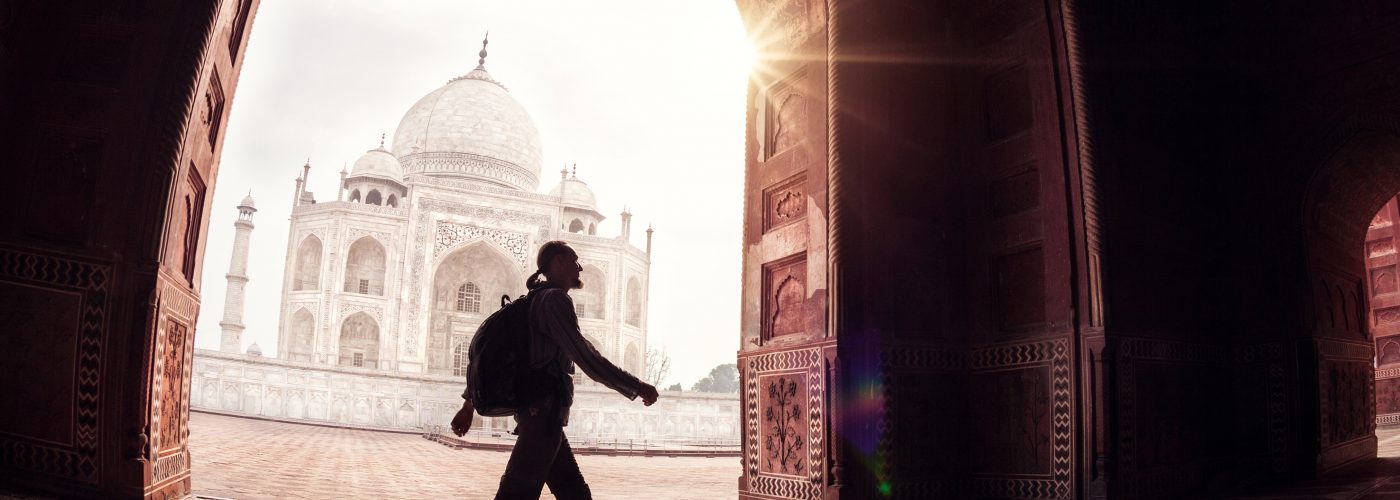
Some best day tours, trips, activities and transfer services, tickets in, from and to Agra you can refer to
- Taj Mahal Fast Track Entry Ticket
- Itmad-ud-Daulah Ticket in Agra
- Taj Mahal and Agra Private Day Tour by Express Train from Delhi
- Taj Mahal and Agra Fort Day Tour from Delhi
- Taj Mahal and Agra Fort Private Half Day Tour
- Walking Tour Of Agra City
- Sunrise Tour Of Taj Mahal and Agra Fort from Delhi
- Taj Mahal and Agra Fort Day Tour from Jaipur
- Private Sunrise Tour Of Taj Mahal and Agra Fort from Delhi
- Private Tour Of Taj Mahal + Agra Fort From Agra
- Agra Street Food Crawl
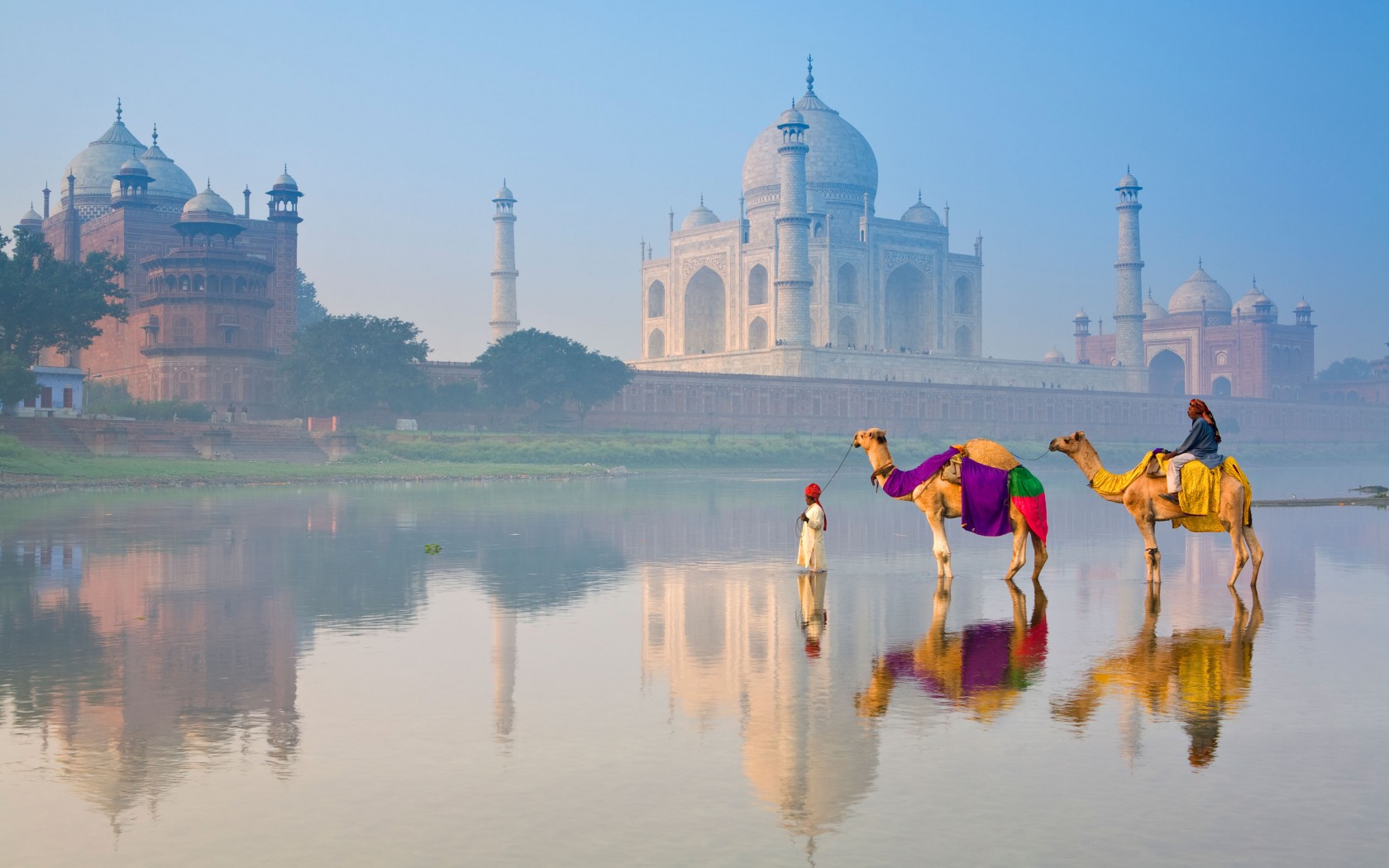
Read more: Taj Mahal blog — 10 Taj Mahal photography tips & tips for visiting Taj Mahal and more India guide here .
Related articles
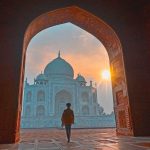
RELATED ARTICLES MORE FROM AUTHOR
What to buy in indonesia — top +9 famous gifts, souvenirs & best things to buy in indonesia, what to buy in kyoto — 31+ must-buy kyoto souvenirs, gifts & best things to buy in kyoto.

What to buy in Korea? — Top +23 cheap, famous & best things to buy in Korea

What to buy in USA? — 17+ must buy in USA & best things to buy in USA

What to buy in Italy? — 19+ top souvenirs & best things to buy in Italy

What to buy in Guangzhou? — 11+ best things to buy in Guangzhou & best shopping places in Guangzhou

What to buy in Tibet? — Top 9+ tibet souvenirs, gifts & best things to buy in Tibet
Editor picks.

What to eat in Singapore? — 10+ must-eat & best street...

Must eat in Nha Trang — 45+ best street food in...

How to prepare for trekking in Nepal? — 10+ Nepal trekking...
Popular posts.

What to buy in USA? — 17+ must buy in USA...

What to buy in Korea? — Top +23 cheap, famous &...

Must buy souvenir in Taiwan — Top 17+ most famous, cheap...
Popular category.
- Inspiration + Guide 1462
- Trip Inspiration 468
- Food + Drink 210
- Thailand 209
- Coasts + Islands 193
- South Korea 168
- Vietnam 167
- Travel Photos 144
- Work for Us
- Terms & Conditions
- Privacy Policy
Our head office
0800 088 6002, [email protected], client log in, reset password, agent log in.

A guide to the Red Fort of Agra: A journey inside the Agra Fort
Nestled within the culturally rich city of Agra, the Agra Fort, also renowned as the Red Fort, stands as a testament to India's majestic history. Constructed by the visionary Mughal Emperor Akbar, this imposing historical fort, crafted from striking red sandstone, holds a significant place in the hearts of those embarking on India tours .
Join us on a captivating journey inside its storied walls as we explore the profound heritage and architectural wonders it has to offer, all in close proximity to the world-famous Taj Mahal .
What is the history of Agra Fort, and how did it come to be known as the Red Fort?
The history of Agra Fort is both intricate and fascinating, and it is closely tied to its association with the Red Fort:
Agra Fort, also known as the Red Fort of Agra, is a UNESCO World Heritage Site located in the city of Agra, in the northern Indian state of Uttar Pradesh. Its history dates back to the 11th century when it was initially a brick fort. However, the fort we see today, constructed from striking red sandstone, owes much of its grandeur and significance to the Mughal Empire, particularly Emperor Akbar.
Early History : The earliest reference to the fort comes from the 11th century when it was a simple brick structure. It wasn't until the reign of Akbar the Great (1556-1605) that significant construction began. He transformed the fort into a majestic palace-fortress and made it the main residence of the Mughal emperors.
Architectural Marvel : Akbar's grandson, Shah Jahan (1628-1658), who is famous for building the Taj Mahal, further embellished the Agra Fort. He added many exquisite structures, including the iconic Diwan-i-Am (Hall of Public Audience) and Diwan-i-Khas (Hall of Private Audience), which are stunning examples of Mughal architecture.
The Red Fort Connection : Agra Fort came to be known as the Red Fort due to its construction using red sandstone, which gives it its distinctive crimson hue. The extensive use of this material not only contributed to its nickname but also made it a symbol of power and grandeur during the Mughal era.
Historical Significance : Over the centuries, Agra Fort witnessed significant historical events, including the struggle for power among Mughal emperors, battles, and the house arrest of Emperor Shah Jahan by his son Aurangzeb. It played a pivotal role in the administration of the empire.
British Era : Agra Fort continued to be significant during the British colonial period. It was briefly captured by the British during the Indian Rebellion of 1857, which added another layer to its historical importance.
Independence : After India gained independence in 1947, the fort was handed over to the Indian government, and it was subsequently declared a UNESCO World Heritage Site in 1983 due to its architectural and historical significance.
Today, Agra Fort stands as a remarkable testament to the architectural brilliance and historical importance of the Mughal Empire. It is not only a tourist attraction but also a place where the layers of history come alive, making it an essential stop for anyone embarking on India tours.
What makes Agra Fort a UNESCO World Heritage Site?
Agra Fort's designation as a UNESCO World Heritage Site is primarily attributed to its exceptional cultural and historical significance, as well as its remarkable architectural features. UNESCO designated Agra Fort as a World Heritage Site in 1983 for the following reasons:
Architectural Grandeur : Agra Fort is a superb example of Mughal architecture, characterized by its extensive use of red sandstone, intricate carvings, and elegant design. The fort showcases the architectural brilliance of the Mughal Empire during the reign of Emperor Akbar and his successors.
Historical Significance : The fort played a pivotal role in the history of India, serving as the main residence of the Mughal emperors for several generations. It witnessed key historical events, including the rise and fall of Mughal rulers, battles, and significant political decisions. The fort's history is deeply intertwined with the history of India.
Cultural Heritage : Agra Fort is home to several exquisite structures and buildings, such as the Diwan-i-Am (Hall of Public Audience), Diwan-i-Khas (Hall of Private Audience), Khas Mahal, and the Sheesh Mahal (Mirror Palace). These structures exemplify the fusion of Persian, Islamic, and Indian architectural styles, showcasing the cultural diversity of the Mughal era.
Symbol of Power : The extensive use of red sandstone in the construction of Agra Fort symbolized the might and grandeur of the Mughal Empire. The fort served not only as a royal residence but also as a symbol of imperial power and authority.
Association with Prominent Historical Figures : Agra Fort is closely associated with legendary Mughal emperors such as Akbar, Jahangir, Shah Jahan, and Aurangzeb, each of whom made significant contributions to its architecture and history. The fort served as the seat of government during their reigns.
Tourist Attraction : Agra Fort is a major tourist attraction in India, drawing visitors from around the world who come to marvel at its beauty, learn about its history, and appreciate its cultural significance.
Close Proximity to the Taj Mahal : Agra Fort's proximity to the iconic Taj Mahal, another UNESCO World Heritage Site, adds to its appeal as a cultural destination. Together, these two historic sites create a rich cultural and historical experience for visitors.
What are the notable structures inside Agra Fort, such as Khas Mahal, and what is their historical significance?
Agra Fort is renowned for its splendid architecture and houses several notable structures, each with its own historical significance. Some of the most prominent structures inside Agra Fort include:
Khas Mahal :
- Historical Significance : Khas Mahal, which translates to "Private Palace," served as a royal residence within the fort. It was primarily used by the Mughal emperors for personal purposes, away from the affairs of the court. The palace exemplifies the refined taste of Mughal architecture.
- Architectural Features : Khas Mahal features elegant white marble facades and intricately carved columns and arches. Its design reflects a blend of Persian and Indian architectural styles, showcasing the synthesis of cultures during the Mughal era. The palace overlooks the picturesque Anguri Bagh (Grape Garden).
Diwan-i-Am (Hall of Public Audience) :
- Historical Significance : Diwan-i-Am was the hall where the Mughal emperor held public audiences to address the grievances of the common people and meet with officials. It symbolized the emperor's accessibility and justice.
- Architectural Features : The hall is known for its impressive colonnades, with numerous pillars supporting a grand throne platform. The central aisle is flanked by red sandstone columns, creating a sense of grandeur.
Diwan-i-Khas (Hall of Private Audience) :
- Historical Significance : Diwan-i-Khas was a private audience hall where the emperor met with select dignitaries, including nobles and foreign envoys. It was reserved for more confidential and important discussions.
- Architectural Features : The hall is famous for its central pillar, which once housed the famous Peacock Throne, a jewel-encrusted throne that symbolized the wealth and opulence of the Mughal Empire. The pillar is adorned with intricate floral motifs and inscriptions.
Sheesh Mahal (Mirror Palace) :
- Historical Significance : Sheesh Mahal is known for its exquisite mirror work, where the walls and ceilings are adorned with tiny pieces of mirror and glass, creating a glittering effect. It was used for private gatherings and entertainment.
- Architectural Features : The palace's interior is a masterpiece of craftsmanship, reflecting light in a dazzling display. The mirror work was not only ornamental but also served practical purposes, helping to keep the room cool during hot weather.
Machchhi Bhawan (Fish Enclosure) :
- Historical Significance : Machchhi Bhawan was built by Jahangir for his harem. It's known for its unique feature--an underground system for cooling the rooms, including running water channels and fountains.
- Architectural Features : The building's design incorporates the use of natural ventilation and water to maintain a comfortable temperature inside. It's an example of Mughal ingenuity in architectural engineering.
These structures within Agra Fort collectively provide insights into the opulence, architectural prowess, and lifestyle of the Mughal emperors and their courts. They stand as enduring symbols of the rich cultural heritage and historical significance of Agra Fort, attracting visitors from around the world who come to marvel at their beauty and historical relevance.
What was the purpose of building Agra Fort?
The Agra Fort, also known as the Red Fort of Agra, was constructed with multiple purposes in mind during the Mughal era:
Military Defense : Initially, Agra Fort was built as a military fortification during the 11th century. Its strategic location along the banks of the Yamuna River made it an ideal defensive stronghold. It protected the city of Agra and the surrounding region from external threats, including invasions and attacks by rival kingdoms.
Royal Residence : During the reign of Emperor Akbar (1556-1605), the fort underwent significant expansion and transformation into a grand royal residence. It served as the primary residence of the Mughal emperors for several generations. The fort's palatial structures, lavish apartments, and ornate gardens were designed to provide luxurious living quarters for the royal family.
Administrative Center : Agra Fort served as the administrative center of the Mughal Empire, particularly during the reigns of Akbar, Jahangir, and Shah Jahan. The emperor's court, government offices, and administrative functions were housed within the fort's precincts. Diwan-i-Am (Hall of Public Audience) and Diwan-i-Khas (Hall of Private Audience) were crucial spaces for conducting official state affairs and addressing the needs of the public.
Symbol of Power and Prestige : The extensive use of red sandstone in the construction of Agra Fort symbolized the might and grandeur of the Mughal Empire. The fort was not only a functional structure but also a symbol of imperial power and prestige. Its imposing walls and impressive architecture conveyed the authority of the Mughal emperors.
Cultural and Architectural Legacy : Agra Fort became a hub of cultural and artistic activities during the Mughal era. It witnessed the patronage of arts and architecture, resulting in the creation of exquisite structures such as Khas Mahal, Sheesh Mahal, and intricate gardens. These structures are a testament to the fusion of Persian, Islamic, and Indian architectural styles.
Strategic Location : Agra Fort's proximity to the Yamuna River and its location near the Taj Mahal (also known as the Tomb of Mumtaz Mahal) added to its significance. The Taj Mahal, built by Emperor Shah Jahan, is a renowned Mughal monument and a UNESCO World Heritage Site. Agra Fort played a role in the administration and oversight of the Taj Mahal.
How old is the Red Fort of Agra?
The Red Fort of Agra, also known as Agra Fort, has a history dating back to the 11th century, making it over a thousand years old. However, the fort, as it stands today and is widely recognized for its architectural grandeur and historical significance, was primarily constructed during the Mughal period.
The fort's transformation into a magnificent palace-fortress began during the reign of the Mughal Emperor Akbar the Great in the mid-16th century. Subsequent Mughal emperors, including Shah Jahan and Aurangzeb, made significant additions and modifications to the fort's structures. It was during Shah Jahan's reign that many of the iconic buildings and palaces within the fort, such as the Diwan-i-Am (Hall of Public Audience), Diwan-i-Khas (Hall of Private Audience), and Khas Mahal, were constructed.
So, while the fort's origins can be traced back over a thousand years, its most notable and recognizable features are from the Mughal era, making it a significant historical and architectural monument from that period.
What does Agra Fort symbolize?
Agra Fort, also known as the Red Fort of Agra, symbolizes several important aspects of India's history and culture:
Imperial Power : Agra Fort stands as a symbol of imperial power and grandeur. The extensive use of red sandstone in its construction reflects the might and opulence of the Mughal Empire during its zenith. The fort's imposing walls and majestic architecture were meant to convey the authority and dominance of the Mughal emperors.
Mughal Legacy : The fort represents the enduring legacy of the Mughal dynasty in India. It was a center of Mughal governance and culture for generations of emperors. Agra Fort, along with other Mughal architectural marvels like the Taj Mahal, serves as a reminder of the Mughal period's contributions to art, architecture, and administration.
Cultural Fusion : Agra Fort's architecture embodies a fusion of Persian, Islamic, and Indian architectural styles. This synthesis reflects the multicultural nature of the Mughal Empire and its willingness to incorporate diverse artistic influences into its structures. It symbolizes the rich cultural tapestry of India.
Historical Significance : The fort is steeped in historical significance, having witnessed pivotal events in Indian history, including the rise and fall of Mughal emperors, political decisions, and battles. It serves as a tangible link to India's past and a repository of historical narratives.
Architectural Excellence : Agra Fort is a testament to the architectural excellence of the Mughal era. Its beautifully crafted palaces, halls, and gardens showcase the Mughals' mastery of design, construction, and aesthetics. The fort remains an inspiration for architects and historians alike.
Tourist Attraction : Agra Fort has become a major tourist attraction in India, drawing visitors from around the world. It symbolizes India's rich heritage and cultural heritage and plays a crucial role in the country's tourism industry.
Connection with the Taj Mahal : Agra Fort's close proximity to the Taj Mahal, another UNESCO World Heritage Site, creates a symbolic link between these two iconic monuments. Together, they represent the epitome of Mughal architecture and the enduring love story of Emperor Shah Jahan and Mumtaz Mahal.
Can tourists go inside the Agra Fort?
Yes, tourists can visit and explore inside the Fort of Agra. Agra Fort is a popular tourist destination in India, and it is open to the public for visits. Visitors have the opportunity to enter the fort, explore its various structures, courtyards, and gardens, and learn about its rich history and architectural significance.
When visiting Agra Fort, tourists can expect to see iconic structures such as the Diwan-i-Am (Hall of Public Audience), Diwan-i-Khas (Hall of Private Audience), Khas Mahal, Sheesh Mahal (Mirror Palace), and Moti Masjid (Pearl Mosque), among others. These structures offer a glimpse into the opulent lifestyle of the Mughal emperors and the grandeur of the Mughal era.
It's important to note that Agra Fort is a historical site, and like many such sites in India, it may have specific visiting hours, entry fees, and rules in place to ensure the preservation of its heritage. Visitors are encouraged to check the official website of Agra Fort or contact local authorities for the most up-to-date information on visiting hours, ticket prices, and any specific guidelines for tourists.
Overall, Agra Fort is a must-visit destination for travelers exploring the city of Agra and its rich historical and architectural heritage.
Where is Agra Fort located within the city of Agra, and how does its location relate to the Taj Mahal?
Agra Fort is located in the city of Agra, in the northern Indian state of Uttar Pradesh. It is situated approximately 2.5 kilometers (about 1.5 miles) northwest of the Taj Mahal, another iconic monument in Agra. The proximity of Agra Fort to the Taj Mahal is significant and contributes to the historical and cultural context of both landmarks.
The Taj Mahal, a UNESCO World Heritage Site and one of the most famous monuments in the world, is located on the eastern bank of the Yamuna River. Agra Fort, on the other hand, is situated on the western bank of the Yamuna River. The river flows between these two historic sites.
The relationship between Agra Fort and the Taj Mahal is historically significant:
View of the Taj Mahal : Agra Fort offers a strategic view of the Taj Mahal from certain vantage points within the fort. Emperor Shah Jahan, who commissioned the construction of the Taj Mahal in memory of his beloved wife Mumtaz Mahal, was later imprisoned in Agra Fort by his son Aurangzeb. It is said that Shah Jahan spent his final years in a room with a balcony that provided a direct view of the Taj Mahal. This poignant connection between the two monuments adds to their historical and emotional significance.
Administrative Center : Agra Fort served as an important administrative center during the Mughal era, and it played a role in overseeing the construction and maintenance of the Taj Mahal. The proximity of the two monuments facilitated coordination and governance.
Cultural Heritage : The close proximity of Agra Fort and the Taj Mahal makes Agra a prime destination for tourists interested in exploring Mughal history and architecture. Visitors to Agra often include both landmarks in their itineraries, creating a rich cultural and historical experience.
Overall, Agra Fort's location on the western bank of the Yamuna River and its proximity to the Taj Mahal on the eastern bank underscores the historical and cultural interplay between these two iconic monuments, making Agra a focal point for tourists seeking to immerse themselves in India's rich heritage.
How can one reach Agra Fort, and what are the transportation options available for travelers to visit the fort?
Agra Fort is a well-connected historical site in the city of Agra, making it accessible to travelers through various transportation options. Here's how one can reach Agra Fort:
- Nearest Airport : The nearest airport to Agra is the Indira Gandhi International Airport in New Delhi , which is approximately 220 kilometers (about 137 miles) away from Agra. Travelers can arrive at this international airport and then continue their journey to Agra by road or train.
- Kheria Airport : Agra also has a domestic airport, Kheria Airport , which is located about 8 kilometers (approximately 5 miles) from Agra Fort. While this airport primarily operates domestic flights, it offers some convenience for travelers arriving directly in Agra.
- Agra Railway Station : Agra Fort is easily accessible by train. Agra has two major railway stations, with the Agra Cantt Railway Station being the most prominent. It is well-connected to major Indian cities and serves as a key railway junction. The Agra Fort Railway Station is another option for reaching the fort.
- Roadways : Agra is well-connected by road to various cities and towns in North India. Travelers can reach Agra by private car, taxi, or bus. The city is connected to the national highway network, making it accessible from places like Delhi, Jaipur, and Lucknow.
- Interstate Buses : Several state-run and private bus services operate intercity and interstate routes to Agra. Travelers can opt for deluxe buses, semi-sleeper coaches, or other bus services depending on their preferences.
Local Transportation :
- Auto-rickshaws and Taxis : Within Agra, auto-rickshaws and taxis are readily available for local transportation. Tourists can hire these for short distances, including travel to Agra Fort.
- Cycle-Rickshaws : For a more leisurely and eco-friendly mode of transport within the city, cycle-rickshaws are a common sight and are suitable for short journeys.
Once in Agra, reaching Agra Fort is relatively straightforward. The fort is located near the city center, and its proximity to major transportation hubs makes it easily accessible to tourists. Visitors can use local maps, GPS navigation, or seek guidance from locals to reach the fort, which is a prominent landmark in Agra and can be reached conveniently from various parts of the city.
When is the best time to visit Agra Fort, considering weather and tourist seasons?
The best time to visit Agra Fort, taking into account both weather and tourist seasons, is typically during the winter months, specifically from October to March. Here's why:
Pleasant Weather : The winter season in Agra, spanning from October to March, offers the most comfortable and pleasant weather for sightseeing. The temperatures are cooler, with daytime highs ranging from 15°C to 25°C (59°F to 77°F) and cooler nights. This makes exploring Agra Fort and other outdoor attractions more enjoyable, as you won't have to contend with extreme heat or humidity.
Avoiding Extreme Heat : Agra experiences extremely hot and dry weather during the summer months (April to June), with temperatures often soaring well above 40°C (104°F). Visiting Agra Fort during this period can be challenging and uncomfortable due to the scorching heat.
Tourist Season : The winter months coincide with the peak tourist season in Agra and the Taj Mahal region. Tourists from around the world flock to Agra during this time to explore its historical and architectural wonders. While this means larger crowds, it also means a more vibrant atmosphere and an opportunity to interact with fellow travelers.
Clear Skies : Winter generally brings clear skies to Agra, enhancing the visibility of the fort's architecture and the surrounding landscapes. This is especially important for those who want to capture stunning photographs of Agra Fort and the Taj Mahal.
Festivals and Events : Agra Fort and the city of Agra come alive with various cultural and festive events during the winter season. Events like the Taj Mahotsav, which showcases Indian art, culture, and cuisine, often take place during this time, adding to the cultural experience.
It's important to note that the period around December and January can get quite chilly, especially in the evenings and early mornings, so visitors should dress accordingly with layers and warm clothing.
Overall, the winter season offers the most favorable conditions for visiting Agra Fort, ensuring a comfortable and enjoyable experience while exploring this historic and architectural gem.
Who should visit the Red Fort of Agra, and what aspects of its history and architecture make it a must-see destination?
The Red Fort of Agra, also known as Agra Fort, is a must-see destination that appeals to a wide range of visitors due to its rich history, stunning architecture, and cultural significance. Here's why different groups of people should consider visiting Agra Fort:
History Enthusiasts :
- Agra Fort is a treasure trove of historical significance. It played a pivotal role in the Mughal Empire and witnessed the reigns of several notable emperors, including Akbar, Jahangir, Shah Jahan, and Aurangzeb.
- Visitors interested in Indian history will appreciate the fort's connection to key historical events, rulers, and political decisions. The fort is a living testament to India's past.
Architectural Aficionados :
- Agra Fort is renowned for its exquisite Mughal architecture. It boasts a harmonious blend of Persian, Islamic, and Indian architectural elements, resulting in visually captivating structures.
- The fort's intricate carvings, red sandstone facades, elegant columns, and ornate interiors are a feast for the eyes, making it an architectural masterpiece worth exploring.
Cultural and Art Enthusiasts :
- The fort reflects the rich cultural heritage of India during the Mughal era. Visitors can admire the fusion of artistic influences in its design, including Persian calligraphy, Islamic motifs, and Indian aesthetics.
- The Mirror Palace (Sheesh Mahal) with its stunning mirror work is a prime example of the artistic prowess of the Mughals.
Tourists on India Tours :
- Agra Fort is a must-visit destination for travelers exploring India's Golden Triangle, which includes Delhi, Agra, and Jaipur. It is an integral part of India tours, offering a comprehensive cultural experience.
- Visitors often combine their Agra Fort visit with a trip to the nearby Taj Mahal, creating a memorable cultural and historical tour.
Families and Educational Tours :
- Agra Fort's historical and educational value makes it suitable for family trips and educational tours. It provides an opportunity for parents and teachers to educate children about India's history and architectural heritage.
- Learning about the fort's role in the Mughal Empire can be an enriching experience for students.
Photography Enthusiasts :
- Agra Fort provides a picturesque backdrop for photographers. Its stunning architecture, gardens, and riverfront location offer numerous photo opportunities.
- The play of light on the red sandstone structures and the reflection of the Taj Mahal in the Yamuna River create captivating visuals.
Everyone Seeking Cultural Immersion :
- Agra Fort offers a unique cultural experience. Visitors can immerse themselves in the ambiance of the Mughal era, explore the various structures, and envision the grandeur of royal life.
- The fort's proximity to the Taj Mahal and other historical sites in Agra makes it a central hub for cultural exploration.
Why should one visit the Agra Fort, and what cultural and historical significance does it hold?
Visiting Agra Fort is a compelling and enriching experience for several reasons, and it holds immense cultural and historical significance:
Architectural Marvel : Agra Fort is an architectural masterpiece that showcases the grandeur and sophistication of Mughal architecture. Its extensive use of red sandstone, intricate carvings, and elegant design make it a visual delight. Visitors can appreciate the architectural finesse of the Mughal era.
Historical Significance : The fort played a pivotal role in Indian history. It served as the main residence of the Mughal emperors for generations and witnessed key historical events, political decisions, and the rise and fall of Mughal rulers. The fort's history is closely intertwined with the history of India.
Mughal Empire : Agra Fort stands as a symbol of the Mughal Empire's power, prestige, and cultural contributions. It was built by Akbar and further embellished by subsequent emperors like Shah Jahan. Exploring the fort provides insights into the opulent lifestyle and governance of the Mughal emperors.
Cultural Fusion : The fort's architecture reflects a fusion of Persian, Islamic, and Indian influences. It exemplifies the multicultural and artistic diversity of the Mughal era. Visitors can observe intricate calligraphy, decorative motifs, and artistic details throughout the fort.
UNESCO World Heritage Site : Agra Fort has been designated as a UNESCO World Heritage Site, recognizing its outstanding cultural and historical value. Its inclusion on this prestigious list emphasizes its global importance.
View of the Taj Mahal : Agra Fort offers strategic viewpoints from which visitors can enjoy breathtaking views of the nearby Taj Mahal. This connection between the two iconic monuments adds depth to the historical narrative and provides excellent photo opportunities.
Educational and Inspirational : A visit to Agra Fort is not only informative but also inspiring. It provides an educational experience for students, history enthusiasts, and anyone interested in India's rich cultural heritage.
Tourist Attraction : Agra Fort is a major tourist attraction in India, drawing visitors from around the world. Its proximity to the Taj Mahal and other historical sites in Agra makes it an integral part of the city's tourism circuit.
Cultural Immersion : Exploring the fort allows visitors to immerse themselves in the ambiance of the Mughal era. They can walk through the palaces, halls, and gardens and gain a sense of what life was like for the Mughal royalty.
Photography Opportunities : Agra Fort's stunning architecture and picturesque surroundings offer excellent opportunities for photography. The play of light on the red sandstone structures and the Yamuna River in the backdrop create captivating visuals.
How much does it cost to visit Agra Fort, and are there any entry fees or additional expenses?
Here are the entry fees for visiting Agra Fort. Please note that these fees may change over time, and it's advisable to check the official website or contact local authorities for the most up-to-date information on entry fees and any additional expenses:
Entry Fees for Agra Fort (for Foreign Tourists) :
- Adults : INR 600 per person (approximately $8-9 USD)
- Children (Ages 3-15) : INR 100 per child (approximately $1-2 USD)
- Children Below 3 : Free
Entry Fees for Agra Fort (for Indian Tourists) :
- Adults : INR 40 per person
- Children (Ages 3-15) : INR 25 per child
Additional Expenses :
Camera Fees : If you plan to use a camera for photography inside Agra Fort, there may be additional fees for still cameras, video cameras, or professional equipment. These fees are typically nominal.
Tour Guide : Many visitors opt to hire a local tour guide to enhance their experience and gain deeper insights into the history and architecture of Agra Fort. The cost of hiring a guide may vary, so it's advisable to negotiate the fee in advance.
Transportation : Depending on your mode of transportation to reach Agra Fort, there may be expenses associated with hiring a taxi, auto-rickshaw, or other local transport to and from the site. If you are part of a guided tour, transportation may be included in the tour package.
Souvenirs and Refreshments : Inside Agra Fort, there are often stalls selling souvenirs, handicrafts, and refreshments. These items come at an additional cost if you choose to purchase them.
Please keep in mind that entry fees and additional expenses can change, so it's essential to verify the current rates and any specific guidelines before planning your visit to Agra Fort. Additionally, some discounts may be available for students, senior citizens, or organized tour groups, so inquire about these options if applicable.
What is the dress code for visiting Agra Fort, and are there any specific clothing requirements?
When visiting Agra Fort, there is no specific dress code that tourists are required to adhere to. However, it is advisable to dress modestly and respectfully, taking into account the historical and cultural significance of the site. Here are some clothing guidelines to consider:
Modesty : It is recommended to wear clothing that covers the shoulders, upper arms, and knees. Avoid wearing clothing that is too revealing or overly casual.
Comfortable Footwear : Agra Fort involves walking, so wear comfortable and sturdy footwear, as you will be exploring the fort's various structures and courtyards.
Sun Protection : Depending on the season, Agra can be quite hot and sunny. Consider wearing a hat, sunglasses, and sunscreen to protect yourself from the sun.
Respect for Local Customs : While there is no strict dress code, it is a sign of respect for local customs and cultural heritage to dress conservatively when visiting historical and religious sites in India.
Footwear Removal : In some areas of Agra Fort, you may be required to remove your shoes before entering. It's a good idea to wear slip-on shoes or sandals for ease of removal and to carry socks if you prefer to wear them when walking on marble floors.
Carry a Scarf or Shawl : Bringing a lightweight scarf or shawl can be useful, especially for women, as it can serve as a cover-up for shoulders or a head covering if needed.
While these guidelines are recommended for visiting Agra Fort, it's essential to use common sense and comfort as your primary considerations when choosing your clothing. The primary goal is to ensure that you are comfortable during your visit while showing respect for the cultural and historical significance of the site.
What are the opening hours of Agra Fort, and how can visitors plan their visit within these hours?
Agra Fort typically follows regular opening hours. However, it's essential to verify the current opening hours before planning your visit, as they may be subject to change. Here are the general opening hours for Agra Fort:
Opening Hours for Agra Fort :
- Agra Fort is usually open to visitors every day of the week, including weekends and public holidays.
- The fort typically opens in the morning and closes in the evening.
- The exact opening and closing times may vary slightly depending on the season, so it's advisable to check the official website or contact local authorities for the most up-to-date information.
Planning Your Visit : To plan your visit to Agra Fort effectively, consider the following tips:
Check Current Hours : Before your trip, confirm the current opening hours of Agra Fort to ensure you arrive during the operational times.
Arrive Early : It's often a good idea to arrive at Agra Fort early in the morning when it opens. This can help you beat the crowds and enjoy a more peaceful visit.
Guided Tours : Consider joining a guided tour. Knowledgeable guides can provide historical context and interesting insights into the fort's architecture and history.
Photography : If you are interested in photography, arriving early or in the late afternoon can offer the best lighting conditions for capturing the beauty of Agra Fort.
Plan for Several Hours : Agra Fort is a sizable historical site with many structures to explore. Plan to spend several hours at the fort to fully appreciate its beauty and historical significance.
Combine with Other Attractions : Since Agra Fort is located in close proximity to the Taj Mahal and other historical sites in Agra, you can plan a comprehensive itinerary that includes multiple attractions in a single day.
Respect Closing Times : Be mindful of the closing time and aim to complete your visit within the operational hours to avoid any inconvenience.
Buy Tickets in Advance : If available, consider purchasing tickets in advance to save time and avoid waiting in long lines at the ticket counter.
To ensure a smooth and enjoyable visit to Agra Fort, check the most recent opening hours and any specific guidelines or restrictions that may be in place during your visit.
Can you do Agra Fort and Taj Mahal as a day trip from Delhi?
Yes, it is possible to visit Agra Fort and the Taj Mahal as a day trip from Delhi. Agra is located at a distance of approximately 200 kilometers (124 miles) from Delhi, and there are efficient transportation options that allow for a day visit. Here's how you can plan a day trip to Agra from Delhi:
Early Departure : To make the most of your day trip, plan to depart from Delhi early in the morning. This allows you to maximize your time at the historical sites in Agra.
Train : One of the most convenient ways to reach Agra from Delhi is by taking a train. The Gatimaan Express is a high-speed train that operates between Delhi and Agra and is specifically designed for tourists. It offers a comfortable and time-efficient journey, with a travel time of around 1.5 to 2 hours. The train typically departs from Delhi's Hazrat Nizamuddin Railway Station.
Private Car or Tour : Alternatively, you can hire a private car or join a guided day tour from Delhi to Agra. This option offers flexibility in terms of your itinerary and can include stops at Agra Fort, the Taj Mahal, and other attractions.
Agra Fort Visit : Upon arriving in Agra, you can start your day trip by visiting Agra Fort. Spend a few hours exploring the fort's various structures and learning about its history and architecture.
Lunch : Enjoy a delicious lunch at a local restaurant in Agra. The city offers a variety of dining options, including traditional Indian cuisine.
Taj Mahal Visit : After lunch, head to the Taj Mahal, which is a short drive from Agra Fort. Spend your afternoon admiring the Taj Mahal's stunning beauty and exploring its grounds.
Return to Delhi : After your visit to the Taj Mahal, you can either catch an evening train back to Delhi or return by private car. Plan your return journey to allow for ample time to reach Delhi comfortably.
Arrival in Delhi : You'll likely return to Delhi in the evening, completing your day trip from Delhi to Agra.
While it is possible to visit Agra Fort and the Taj Mahal in a day trip from Delhi, it's important to keep in mind that both sites are significant and rich in history and architecture. If you have more time available, consider staying overnight in Agra to explore these attractions at a more leisurely pace and to experience other cultural and historical sites in the city.
What other tourist attractions are located near Agra Fort?
Agra is a city steeped in history and culture, and there are several tourist attractions located near Agra Fort that visitors can explore. Here are some of the notable attractions near Agra Fort, along with details about each:
Taj Mahal :
- Distance from Agra Fort : Approximately 2.5 kilometers (about 1.5 miles)
- Description : The Taj Mahal is one of the most iconic and recognizable landmarks in the world. It is a white marble mausoleum built by Shah Jahan in memory of his beloved wife Mumtaz Mahal. The Taj Mahal's stunning architecture, intricate marble inlays, and symmetrical gardens make it a UNESCO World Heritage Site and a must-visit attraction.
Mehtab Bagh (Moonlight Garden):
- Distance from Agra Fort : Approximately 3 kilometers (about 1.9 miles)
- Description : Mehtab Bagh is a garden complex located on the opposite bank of the Yamuna River from the Taj Mahal. It offers magnificent views of the Taj Mahal, especially during sunset. Visitors can stroll through the gardens and enjoy the serene atmosphere while taking in the breathtaking sight of the Taj Mahal across the river.
Itimad-ud-Daulah's Tomb (Baby Taj):
- Distance from Agra Fort : Approximately 5 kilometers (about 3.1 miles)
- Description : Often referred to as the "Baby Taj," this tomb is a precursor to the Taj Mahal and is considered a masterpiece of Mughal architecture. It was built for Mirza Ghiyas Beg, a nobleman and the grandfather of Mumtaz Mahal. The tomb is known for its intricate marble work and picturesque location along the Yamuna River.
Fatehpur Sikri :
- Distance from Agra Fort : Approximately 40 kilometers (about 25 miles)
- Description : Fatehpur Sikri is a historical city and UNESCO World Heritage Site located near Agra. It was built by Emperor Akbar in the 16th century and served as the Mughal capital for a short period. The city is known for its well-preserved architecture, including the Buland Darwaza (Gate of Victory), Jama Masjid, and Diwan-i-Khas.
Akbar's Tomb :
- Distance from Agra Fort : Approximately 15 kilometers (about 9.3 miles)
- Description : The tomb of Emperor Akbar, located in Sikandra, is an architectural marvel surrounded by lush gardens. The tomb's design combines elements of Hindu, Islamic, and Persian architecture. It is a peaceful and historically significant site.
Mariam's Tomb :
- Description : Mariam's Tomb is the final resting place of Mariam-uz-Zamani, also known as Harka Bai, who was the wife of Emperor Akbar and the mother of Emperor Jahangir. The tomb is an elegant structure with a beautiful garden and is located in the heart of Agra.
These attractions near Agra Fort offer a diverse range of historical, architectural, and cultural experiences, allowing visitors to delve deeper into the rich heritage of Agra and the Mughal Empire. Whether exploring the Taj Mahal's grandeur, enjoying a sunset at Mehtab Bagh, or admiring the intricate craftsmanship at Itimad-ud-Daulah's Tomb, Agra has much to offer to history enthusiasts and travelers alike.
What is Agra best known for?
Agra is best known for several iconic and historically significant attractions, making it a renowned destination in India. Here are the key aspects for which Agra is most famous:
Taj Mahal : Agra is most famous for the Taj Mahal, one of the Seven Wonders of the World. This magnificent white marble mausoleum, built by Emperor Shah Jahan in memory of his wife Mumtaz Mahal, is celebrated for its breathtaking beauty, intricate marble inlays, and serene gardens.
Agra Fort (Red Fort of Agra) : Agra Fort, also known as the Red Fort of Agra, is another UNESCO World Heritage Site. It is famous for its historical significance, stunning architecture, and its association with the Mughal emperors, including Akbar, Shah Jahan, and Aurangzeb.
Historical Heritage : Agra is renowned for its rich historical heritage, which includes various Mughal-era monuments, tombs, and forts. The city's historical significance is deeply connected to the Mughal Empire, which ruled India for several centuries.
Mughal Architecture : Agra is a hub of Mughal architecture and is celebrated for its exquisite architectural marvels, such as the Taj Mahal, Agra Fort, Itimad-ud-Daulah's Tomb, and Fatehpur Sikri. These structures reflect the grandeur and artistic excellence of the Mughal era.
Cultural Significance : The city of Agra is culturally vibrant, with a mix of traditions, art, and cuisine. Visitors can explore the rich cultural heritage of the region through its cuisine, music, and festivals.
Tourism Hub : Agra is a major tourist hub in India, attracting millions of visitors from around the world who come to witness its historical and architectural wonders. It is a popular destination for both domestic and international tourists.
UNESCO World Heritage Sites : Agra boasts three UNESCO World Heritage Sites: the Taj Mahal, Agra Fort, and Fatehpur Sikri. These sites contribute to Agra's global recognition and significance.
Symbol of Love : The Taj Mahal is often described as the ultimate symbol of love, making Agra a romantic destination and a popular choice for honeymooners and couples.
Craftsmanship : Agra is known for its skilled craftsmen who specialize in marble inlay work, carpet weaving, and other traditional arts and crafts. The city is a great place to shop for souvenirs and handicrafts.
Culinary Delights : Agra is famous for its Mughlai cuisine, known for its rich and flavorful dishes. Visitors can savor delicious kebabs, biryanis, and sweets such as petha, a local specialty.
Search our Blog
Related tours.
Travel overland from India to Nepal, taking in Delhi, Jaipur and Agra plus less visited sites and villages, holy Varanasi, Buddhist Sarnath and Lumbini and wildlife safaris in Bardia National Park before finishing in Kathmandu.
Small Group
This budget India tour takes in Delhi, Jaipur and Agra as well as the Rajasthani town of Bundi. Travel is mainly by train, with some included tours mixed with free time for independent exploration or to take an optional local tour
This tour extends our Incredible India route from Delhi and the Taj Mahal in Agra, remove Hinduan and the Pink City of Jaipur, to the holy city of Varanasi on the banks of the Ganges.
RECENT POSTS FROM OUR BLOG
Need some travel inspiration or looking for some handy travel tips? Our blog provides excellent insight into our travel destinations - from tour updates to country guides, packing lists to little known things to do, you'll find it all in our travel blog.
Sacred Darshan and Spiritual Serenity: Exploring Swaminarayan Akshardham Temple in New Delhi
Swaminarayan Akshardham Temple in New Delhi: The Largest Hindu Temple was officially opened on 6 November 2005, a blend of traditional and modern Hindu culture in the Capital of India.
A travel guide to the Holy City of Varanasi: Places to visit, best things to do in Varanasi & the holiest attractions
Explore Varanasi, the Holy City by the Ganges River. Discover the holiest attractions, places to visit, immerse in Hindu culture, and the best things to do in Varanasi.
The Ganges River Basin: Unraveling the Lifeline of India as the River of Life Flows On
Journey along the Ganges River Basin (Ganga): The surrounding river basin is home to more than four hundred million people. A sacred body of water in Hinduism, discharging into the Bay of Bengal. Find out more!
A guide to the best places to visit in Rajasthan for a perfect getaway: Discover all the unique things to do in Rajasthan, including dune bashing
Explore the best places to visit in Rajasthan, palaces, Mehrangarh Fort, Ranthambore National Park, desert city of Jaisalmer. Things to do in Rajasthan include dune bashing, and more.
Welcome to Taj Mahal: A Historical and Architectural Marvel
Explore the Taj Mahal, a mausoleum complex on the bank of the Yamuna River in Agra, built by Mughal Emperor Shah Jahan in 1632 – a marvel of architecture.
A UNESCO World Heritage Site, Fatehpur Sikri Fort: A Mughal marvel amidst Agra's historic monuments, Agra Fort, Taj Mahal, and Buland Darwaza
Explore Fatehpur Sikri Fort, a UNESCO World Heritage Site, showcasing Mughal architecture by Emperor Akbar in red sandstone near Agra, with Taj Mahal, Agra Fort, and Buland Darwaza.
Exploring Fatehpur Sikri: A UNESCO World Heritage Site and Mughal Marvel in Uttar Pradesh
Discover Fatehpur Sikri situated 37 km from Agra: Mughal Palace, Mosque, and Buland Darwaza, built by Mughal Emperor Akbar in 1571, a UNESCO site in Uttar Pradesh, Northern India.
Keoladeo National Park: Bharatpur Bird Sanctuary, a UNESCO World Heritage Site in Rajasthan
Discover Keoladeo National Park: Bharatpur Bird Sanctuary, Rajasthan – Home to Rare Siberian Cranes, Majestic Maharajas, and many more species of birds.
Agra Travel Guide | The Best of Agra Beyond the Taj
Agra needs no introduction to most visitors to India, but there is plenty to see beyond the Taj – read my Agra travel guide for all my top Agra travel tips for getting the most out of your time here, enjoying your stay, and discovering the best of Agra beyond the Taj (and crowds!)
This post contains compensated affiliate links. For more info and my full disclosure, please read here .
Agra Travel Guide – An Introduction
If there’s one place in India that every traveller eventually makes it to, it has to be Agra.
For some – it’s the highlight of a long awaited India trip. For others, it’s with more reluctance or version of I can’t really leave India without seeing the Taj kind of sentiment.
My own story with Agra was fairly simple. Having seen the major tourist sights in Agra on my early trips to India – and witnessed a fair amount of the over-tourism and hassle, I wasn’t really in any hurry to return. It’s not for nothing that Agra has something of a bad reputation among tourists to India for the number of touts and scams that prevail(ed) here.
That was until I came across Ekaa Villa in Agra and their work to show visitors a different side of Agra – one with fewer crowds, less focus on the Taj Mahal, and more focus on culture, community-centric tourism. Reason enough to tempt me back to see how Agra had changed over the years, as a result of the Pandemic, and to find out if my opinion of Agra would fare better a few years on (spoiler – it did)!
In this Agra travel blog I’ll cover where to visit, my top travel tips for visiting Agra, advice for female travellers and much more – read on for what you need to know while planning your trip to Agra!
The Best Time to Visit Agra
Set in the heart of northern-central India, Agra sees similar weather to Delhi, but with more variation in heat and cold. At time of writing this blog in May, temperatures in Agra are up to almost 50 degrees celsius at the height of summer, as India is experiencing a heat wave. Suffice to say, I do not recommend visiting Agra in April, May or June as these are when temperatures soar.
The most popular (and best weather-wise) time to visit Agra is between late October and early March. In December & January, Agra gets cold (as in you’ll need a coat cold) and this is when Agra also sees a lot of morning fog. For ideal misty morning Taj viewing conditions, you want both sun and morning mist (seeing the mist rising and evaporating over the Taj is something quite special), which can be more likely to happen with warmer weather in February than in January, when the mist can hang about.
Visiting Agra in monsoon (July – late September) is another option, but weather can still be very hot and sticky (high humidity), when it’s not raining.
Whichever time of year you choose to come to Agra, I recommend avoiding weekends , as this is when the majority of Indian domestic tourists travel, and the city and major sights get very crowded. Note that the Taj Mahal is closed every Friday, and special fees and conditions apply if you want to see the Taj during the full moon.
Where to Stay in Agra
For me, this time one of the highlights of my Agra trip was where I chose to stay.
When it comes to choosing between Agra hotels, unfortunately the options are not always inspiring. There’s a dearth of large (and mostly bland) chain hotels that cater to the wedding and conference market in Agra, and there’s the backpacker hostels of Taj Ganj (some with some great rooftop views it has to be said).
But there’s not much in-between, that has character, represents Agra’s culture, or has the real warmth of hospitality that makes travel in India so special. So I was so happy to stumble upon Ekaa Villa Boutique Hotel & Kitchen which is Agra’s first boutique hotel.
Located in the Taj Nagri phase 2 area just 10 drive minutes from the Taj itself, Ekaa Villa is a peaceful retreat away from the tourist throngs and busy streets of Agra. With just 13 beautifully designed rooms, this boutique hotel reflects the city around it in its design and decor, with a contemporary twist. Rooms feature huge comfy beds, Taj frames on the walls and rain showers. There’s a library on the top flor with some great books and photography of Agra (perfect for unwinding on a hot afternoon or after a busy day), and the restaurant area includes a courtyard area for al fresco dining.
The hospitality here is second to none, with the staff seeming to know exactly when you really need one of their thirst quenching iced-teas, a winning formula when combined with the knowledge and passion for Agra that is infectious from its owners.
I highly recommend staying here if you can – and try out one of their Experience packages (see more below in getting off the beaten path in Agra).
Click here to check rates & availability for Ekaa Villa Boutique Hotel
Top Tips for Visiting Agra
As a popular tourist destination in India, Agra needs some pre-planning, especially if its one of your first stops in India. Unfortunately as a place that sees a lot of visitors on whistlestop tours who haven’t done their research, over-charging is common practice, and scams are not uncommon.
Here are some of my tips for seeing the better side of Agra. You can find additional considerations for (solo) female travellers below, too.
- Stay longer than a day . There’s so much more to see in Agra than just the Taj Mahal and the fort, I really recommend staying 2-3 days here if you possibly can to get a real sense of Agra.
- Pre-book your Agra accommodation . The usual rackets operated by rickshaw drivers who will try to take you to hotels that pay them commission is a problem here, which can be avoided if you pre-book and insist on being taken there.
- Negotiate with rickshaw drivers – the prices quoted at popular tourist sights and at railway stations on arrival will be high, so barter them down ( by at least 50% ). I recommend organising a pickup through your hotel from the train station or airport to cut down on hassle.
- Check the weather and dress accordingly – Agra has very seasonal weather, so you’ll need a decent coat/jacket in winter, and light cotton in hot months. If in doubt, pack layers you can peel off as the weather warms up during the day.
- Ignore people who approach you offering to be your guide / show you around / show you a better view, take your photos, claim to know you (eg from your hotel), or just start following you and telling you about things – in all of these cases people are trying to either hire themselves as your guide (will expect payment) or are unfolding some kind of scam.
- Agra is not the best place for souvenir shopping. Because of the high tourist footfall, souvenirs are overpriced here – try to buy in other parts of India from local crafts (wo)men directly if you can.
- Do enjoy the amazing local food . Agra is famous for its mithai (sweets) and milk produce – Lassi, rabri & hot milk as well as for its non-veg (meat) based food. Pick restaurants and stalls that are busy and have a high turnover of customers, or book a food tour with a local guide who can take you the the best spots. If you stay at Ekaa (above) they can take you for delicious local treats.
- Factor in some down time . As with so many of India’s top destinations, there’s so much to see and do here it can be tempting to pack your days solid with sightseeing – but for best results I find some downtime is helpful to reflect on all you’ve experienced and seen, or just catch an afternoon nap – especially important if you’re travelling to Agra during hotter months!
- Buy your monument tickets in advance, online – see more on how to do it below.
Places to Visit in Agra
Agra is dotted with beautiful monuments, the old city, gardens, sunset spots – far more than you might think on an initial glance! As the former capital of Mughal India (from 1501 until 1638 when Shah Jahan built a new capital in Delhi) , there is arguably nowhere better in India to see stunning Mughal architecture.
One thing to note when planning your visits to the various monuments in Agra and around (including Fatehpur Sikri), is that tickets now have to be bought online and are not available at the monuments themselves (you’ll find signs with a QR code that you can scan). Head to this website to buy your tickets – they can be booked up to a week in advance. If you have trouble with your card being accepted, you could ask your hotel to try and book tickets for you on an Indian card and add them to your bill (foreign cards seem to be hit and miss if they are accepted or not).
Y ou can also buy skip the line tickets here which include an English-speaking guide
The Taj Mahal
There may be far more to see in Agra beyond the Taj, but you still won’t want to miss it. No matter how many photos you’ve seen (and even if you’ve visited before), there’s nothing that quite prepares you for the first shining white glimpse of the Taj Mahal through the entrance gate, glinting in the misty morning light.
The best time to visit the Taj Mahal, without question, is for sunrise. The monument is open sunrise to sunset, Saturday to Thursday ( the Taj is closed every Friday ). Sunrise is a little loose as a time… so it’s worth getting there a bit before. In late march, we arrived at the Taj at 06.30 and were a little late, 6am would have been the perfect time to arrive. The reason why sunrise is the best time is a) for the beautiful morning light and b) it’s the only time of day you’ll see the Taj with fewer crowds.
There are three entrances to the Taj Mahal – South (closest to the budget hotels at Taj Ganj), West, and East (closer to the higher end hotels located in the south east of the city). Note that regular auto-rickshaws are not allowed within 500m of the Taj due to pollution, so you’ll have to walk the last stretch or take an e-rickshaw. At Shilpgram (east entrance) the e-rickshaw cost is included in foreigner ticket prices.
The Red Fort
Second only to the Taj Mahal when it comes to top places to visit in Agra, the Agra Fort is one of the finest Mughal forts in India, and a step up on Delhi’s very similar version. Construction of the fort was begun in 1565 by Emperor Akbar, and then finished by his grandson, Shah Jahan, who transformed the military fort into a palace, adding his signature touch of plenty of white marble.
Rising above the Yamuna river, you can easily spend hours wandering around the massive fort. The best time to come is very early morning to avoid the tour groups, preferably while they’re still at the Taj. The fort opens at sunrise. Another bonus for sunrise visitors are the photo ops back over towards the Taj Mahal (you’ll need a decent zoom lens), where if you’re lucky, you’ll catch the sun rising behind the Taj.
Click here for Red Fort skip the line tickets & guided tour options
Itimad-ud-Daulah (Baby Taj)
Probably my favourite monument in Agra, the tomb of Persian nobleman, Mumtaz Mahal’s grandfather, the “Baby Taj” is a treat for the eyes as well as the crowd-weary. The intricate designs and carved marble lattice screens are impressive examples of Persian architecture, and the river-side location makes for a peaceful spot to take in the Yamuna views of Agra.
Best of all, the traditional Persian style gardens are being restored to their former glory – traditionally these contained cypress trees, roses and flowers according to the Persian traditions around gardens. Cypress trees were used to represent life and death, a figure pointing towards the heavens bridging the life and the afterlife. The gardens follow the traditional ‘char Bagh’ style, divided by four water streams.
There’s an interesting display on the restoration of these gardens to the traditional Persian style with trees and flowers, from the British style grass ‘lawns’ that were imposed during colonial times which destroyed the rich diversity of these and other Mughal gardens in Agra.
Sikandra / Akbar’s Tomb
The resting place of Emperor Akbar, Sikandra lies 10km to the west of Agra, and is another incredible example of the beautiful Mughal architecture in Agra. Most impressive are the entrance gateway to Sikandra with its four towers, along with the beautifully painted ceilings and walls of the main cenotaph.
The gateway opens out onto expansive lawned gardens (presumably the traditional Persian style was present here before the British lawn-ified them). Deer can be seen wandering around, and the gardens are peaceful spot to relax in.
Unfortunately the tomb itself and several of the outbuildings are a shadow of their former glory, having experienced multiple raids by the local Jat warrior rulers that preceded the Mughal kingdom (the bones of Akbar were removed during one of the Jat raids) – and despite restoration work undertaken by the British during the early twentieth century. But, raids aside, this is still one of the most impressive Agra attractions, which receives a fraction of the visitors compared to other Agra must see sights.
Mehtab Bagh & Taj Viewing Point
The park across the river from the park (Mehtab Bagh) has long been a favourite sunset viewing point for the Taj, and the gardens provide for a pleasant stroll however a new sunset viewing point has now been put in which runs in front of the park directly next to the river – so your view from the park may be obscured by people in front of you.
The viewing point is paid access (with heavy surcharges for visiting at the full moon), and additional camera charges apply.
In my view, there are much better viewing points for the Taj – as these days the Yamuna river flow is far reduced, with the effect being you are rather looking across damp grass up at the Taj, rather than the sunset river reflection you have in your mind. It’s also worth noting that boat trips to view the Taj are now banned.
Agra off the Beaten Path & Responsible Tourism in Agra
As home to the Taj Mahal, Agra, unsurprisingly sees a huge influx of tourists (especially in winter, and on weekends) and the volume of footfall has an impact including over-crowding and over-commercialisation. One of the simplest ways to create a better impact on your trip to Agra, is to stay longer and support local businesses.
A surprisingly high percentage of visitors just come for the day, meaning that they don’t spend at hotels, or much at restaurants, or have time to absorb much of the culture, creating a kind of flood-in-flood-out tourism challenge. By doing the opposite and supporting smaller hotels, restaurants and hiring local guides, the positive effects of tourism are magnified. So, come for at least a couple of days if you can, preferably not at the weekend.
Along with Agra’s “big hitters” (above), there are several lesser known monuments around the city to fill your days with and take in on heritage walks – but, beyond a doubt, my favourite way to experience Agra beyond the crowds was on the experiences (short tours) that Ekaa Villa arranged for us.
A highlight was walking through rural villages on the outskirts of Agra, complete with chai-stops at villagers’ homes, and wandering to the edge of wheat fields for what turned out to be some of the most stunning views of the Taj I’ve seen – with no-one else around.
You also do not want to miss out on Agra’s food scene, and by that I don’t mean sticking to tourist-focused restaurants at hotels. Take a trip to the halwaais and sweet makers in old Agra on a food tour, and make sure there’s room in your stomach for plenty of lassi .
Here are a few responsible tourism related organisations to support on your trip to Agra:
- Sheroes Hangout – This cafe is run by local women survivors of acid attacks and domestic violence. Located behind Go Stops Hostel in Taj Nagari Phase 1.
- Agra Heritage Walks – Specialise in walks run by local artists and off the beaten path in Agra
- Ekaa Experiences – Secret Taj walks and excursions for those staying with Ekaa Villa
- Wildlife SOS – The award-winning Indian wildlife conservation group has a nearby sloth bear rescue centre outside of Agra as well as its Elephant rescue centre at nearby Mathura (2 hours drive from Agra). Both are open to visitors on prior arrangement.
Agra for Solo Female Travellers
Located in western Uttar Pradesh, Agra is one of India’s more conservative parts of the country, and although many solo female travellers (including me) visit Agra with absolutely no problem, it’s advisable to think and plan ahead to get the best experience out of your trip.
Here are a few tips:
- You probably know this already, but Agra is not Goa. Leave the shorts firmly in your bag, and see my what to wear in India post here. The advice for ‘conservative India’ applies here
- You don’t need to cover your hair to enter most monuments here, but dressing respectfully is appreciated (no bare limbs)
- Book hotels / homestays with reviews from other solo female travellers ahead of time (Ekaa is a great choice which gets lots of solo female travellers)
- For some of the larger Agra sights such as Sikandra, I recommend hiring a guide – as grounds can be big and there can be groups of men loitering. Book a guide through your hotel or through a pre-booked tour, not someone who claims to be a guide outside sight entrances. (You don’t need a guide for the Taj Mahal which is always busy)
- If you’re going to Fatehpur Sikri, you definitely do need a guide, as sadly the place is full of scammers and touts (and for this reason has been removed from many tour itineraries). I recommend pre-booking a trip and transfer online such as this one or via your accommodation in Delhi or Agra.
- Avoid heading out at night on your own in Agra as a solo woman. If you do want to go out at night, use Uber, or better book a trusted driver through your hotel who will wait for you and get dropped door-to-door. If you’re in a mixed group, going out is no problem, but don’t wander late at night un-necessarily.
- It’s not recommended to go down to the river or remote sunset spots on your own for safety reasons (think groups of men loitering).
Getting to and from Agra
Agra is well connected to Delhi, Jaipur, Lucknow, Varanasi and many other Indian cities.
Train : Agra is very easy to reach by train – but be aware that Agra has several train stations so do check which yours comes into and leaves from. Agra Cantt (Cantonment) is the largest with the majority of trains arriving into and out of. To or from Delhi, the best train to get is the 12050 / 12049 Gatimaan Express – currently one of India’s fastest trains – which runs between Hazrat Nizamuddin in South Delhi to Agra Cantonment.
Book your Delhi-Agra train tickets here
Or – if you like the sound of going to Agra by train from Delhi but would rather someone else did the planning, you can book this Agra day trip by train tour .
Air : Flights from major Indian cities connect to Agra’s airport, which is located 13kms from Agra city.
Road: Agra is a quick 2-3 hour drive of around 185kms from Delhi along the Delhi-Agra Yamuna expressway. You can book a taxi, inter-city Uber, or take one of the many buses serving the Delhi-Agra route.
Agra Travel Guide FAQ’s
When is the best time to visit agra.
October – March is the best time weather-wise. December and January are the coolest months, but also attract the most crowds, so times like late October and late February are a great idea. Whenever you visit, try to avoid weekends if you can.
What should I wear as a Female Traveller to Agra?
Agra is located in one of the more conservative areas of India, so I recommend covering your legs down to at least your knees, shoulders and avoid any strappy, low cut revealing clothes. Leave the shorts in your bag for Goa. Maxi dresses (no big slits) are a good option, as are maxi skirts with a t-shirt or top (plus they’ll look good in your photos). Scarves are super-useful for covering up when need be.
What do I need to know about visiting the Taj Mahal?
The Taj Mahal is open daily except Fridays, and tickets need to be bought in advance, online, using the Architectural Survey of India payment portal (link above). At time of writing (April 2022), the rate for foreign visitors is 2500 rupees. There are 3 entrances (west, south and east), with the most useful depending on where you are coming from (see above). The best time to visit the Taj is at sunrise, for beautiful light and fewer crowds. Separate pricing applies for visiting the Taj during the Full Moon and days surrounding it.
Editorial note: Thank you to Ekaa Villa for hosting my stay with them – as usual this doesn’t affect my thoughts, ideas and recommendations!
Plan your Dream Trip to India with Soul Travel India
The Call of Varanasi: Essential Tips for your First Visit
101 Essential India Travel Tips
21 of the Best Street Foods in India – My Top Picks
Soul Travel India
Passionate about all things India travel - journeys of transformation and discovery, local experiences, and getting under the skin of India.
Copyright Soul Travel India 2022, All rights reserved. This website uses compensated affiliate links.

How to spend 3 days in Agra and see the Taj from every angle!
We came to Agra for the same reason everyone else does: to see the Taj Mahal – the one attraction that sits at the top of every visitor’s Agra travel itinerary. This symbol of undying love is one of the seven Wonders of the Modern World and one of the most beautiful buildings in India , so like countless travellers before us, we too made the long journey to see it with our own eyes. (Spoiler alert: it lived up to every single expectation and then some!)
Since our month in India was all about travelling at a slow and leisurely pace, we gave ourselves three full days in Agra (we later learned that most people only stay a night or two!), and fortunately for us, that meant we got to see and do quite a bit around the city. Now here’s a look at how we spent our 3 days in Agra:
Agra Travel Itinerary

Tour Agra Fort on foot
Agra Fort was the main residence of the Mughal emperors before they moved their capital to the Red Fort in Delhi , so if you’ve already been there on your travels through India, it’s kind of cool to see some of the similarities between the two structures.
Like the Red Fort in Delhi, Agra Fort is also a walled city and inside the enclosure you’ll find gardens, palaces, mosques, audience halls, and basically a maze of marble and red sandstone. If you’re interested in the history of the fort, you can easily hire a guide at the gates, however, it’s also the kind of place that you can enjoy on your own.
The cherry on top is that because Agra Fort is located just 2.5 kilometres from the Taj, you get some pretty cool views of it as well!

Admire the Baby Taj up close
Alright, so you’re not going to get any views of the Taj Mahal from the baby Taj, but if you’re already heading to Mehtab Bagh, this stop is right along the way.
The Baby Taj, whose real name is the Tomb of I’timād-ud-Daulah, is a mausoleum that was commissioned for Mirzā Ghiyās Beg; he was the grandfather of Mumtaz Mahal, the woman the Taj was built for.
The Baby Taj has been regarded as an early draft for the Taj, but I personally don’t see the resemblance – I think Humayun’s Tomb in Delhi offers a better representation of that! But what I can agree with is that the Baby Taj looks a bit like a jewelry box. From a distance the building may appear to be solid white marble, however, when you get up close you can see that it is covered in arabesques, geometric patterns, and colourful semi-precious stones!

Catch sunset at Mehtab Bagh
Another place you should make time for in Agra is Mehtab Bagh, which also goes by the ever romantic name: Moonlight Garden.
Aside from offering a quiet respite from Agra’s busy streets, these gardens sit directly behind the Taj Mahal and right across the Yamuna River, which means that once again you get some postcard perfect views.
This location is really popular at sunset , and couples, families, and tour groups were already starting to gather across the lawn long before the sun went down.
Legend has it that Emperor Shah Jahan, who commissioned the Taj Mahal, had wanted to build a mausoleum of black marble for himself in these very gardens to mirror the Taj Mahal. As history would have it, Shah Jahan’s own son ended up throwing him in prison, which meant this plan never came to pass, but can you imagine what that would look like today?
Tip: Because Mehtab Bagh is located so close to the Yamuna River, it can partially flood during the rainy season. Something to keep in mind if you visit during that time of year.

Get close to nature on the Taj Walk
One of the biggest surprises in Agra was the Taj Walk, also known as the Taj Protected Forest, which is located just before reaching the East Gate.
The Taj Walk is a mix of paved paths and dirt trails, where you can spot peacocks roaming wild, however, the crowning jewel of the park are the free views of the Taj Mahal! They have a few benches scattered across the grounds and every once in a while you’ll come across an unexpected hill that offers views of the Taj dazzling in the sunlight.
Because the park is located east of the Taj, you get the best views in the morning when the sunlight hits the building. You can still visit in the afternoon, but the Taj will be backlit – something to keep in mind for all you photogs out there.

Enjoy a meal with a view of the Taj
Saniya Palace Rooftop Restaurant calls itself “the restaurant with the best views of the Taj Mahal”, and while I didn’t try every restaurant in town, I can’t really argue with that statement either because the views were pretty spectacular.
This restaurant is located on top of a guesthouse by the South Gate and you have to huff and puff your way up several flights of stairs, but once you reach the top, you can see the Taj Mahal framed by pastel buildings.
The food did take a long time to arrive (we waited 45 minutes) and it’s not going to win any awards (expect standard Indian fare), but if you’re in no rush, the rooftop is a nice place to linger while you enjoy views of the Taj just a little bit longer.

Visit the Taj Mahal itself
And now I’ve saved the best for last: seeing the Taj Mahal up close!
What can I say about the Taj Mahal that hasn’t already been said before? The structure is striking from the minute you first set eyes on it.
We decided to skip the early morning wake-up call for sunrise, and made our way there at 9:00 a.m. without any rush. We were visiting on a weekend, but there were no lines at the East Gate, so we went through security and were standing in front of the Taj within minutes.
We spent the entire morning walking along the complex, gawking at the building’s beauty from every angle, and taking a gazillion pictures because you never know when you’re going to be back! If you’re planning on visiting, I would suggest you give yourself at least 2-3 hours to explore every nook and cranny .
Tip: Once a month on the full moon, the Taj Mahal is open for nighttime viewing , so if your trip happens to coincide with that, it’s a pretty rare opportunity to enjoy! Sadly, we missed the full moon by just a few days.
Stay within walking distance of the Taj
Our hotel in Agra was my favourite property of our whole month in India , so I just have to write about it! We stayed at a place called The Coral Court Homestay , which is a boutique hotel with a familiar touch.
The property was run by a travel-loving couple who had a colourful home filled with trinkets from around the world . I loved that wherever I looked there was an unusual artifact with a story, be it embroidered silk pillows with elephants, tinted glass lamps dangling from the ceilings, or shelves and coffee tables piled with books in foreign languages . It was like setting foot in the home I’d like to have one day.
Aside from being a beautiful property, it was also within walking distance of the Taj Mahal while simultaneously being in a quiet area just off of Taj East Gate Road. If you’re looking for a place to stay in Agra, I would highly recommend this hotel!
Lastly, they served breakfast, lunch and dinner in a communal dining area where guests could mix and mingle, while swapping tales from their travels across India .

To wrap things up, I’m really glad I had three full days in Agra to sightsee without rush and tack on some lesser visited attractions . That being said, if you are on a tighter schedule, you can still pack quite a bit into a day or two, especially if you hire a rickshaw driver to take you around, so either way, you’ll enjoy your visit.
Would you add anything else to this Agra travel itinerary?
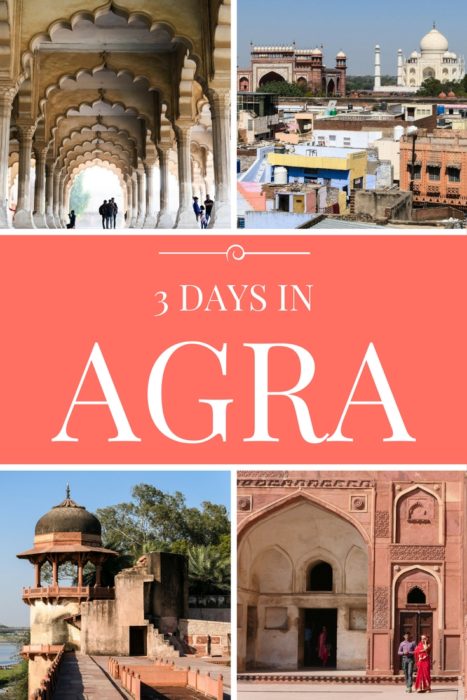
13 Comments
Wow! amazingly described. Taj Mahal is really really beautiful. I visited the monument 2 years ago. Lovely pictures!
This is so stunning….I have been to India once but unfortunately couldn’t visit the Taj Mahal……lovely read.
The Taj Mahal for me is one of the most stunning buildings we have! It is so much better in person. When we visited the place in 2013, I just couldn’t believe it! The experience is surreal!
Hello! I recently had found your videos on YouTube and have since started following your blog. I was wondering if you had a post that kind of explains more about your back-story and how you came to be able to travel as much as you do? Thanks!!
Hi Tabitha, I guess you could say I got started with teaching English overseas. I’ve always enjoyed travelling and I took the opportunity to do so during every winter holiday and summer break when I was in university. Once I graduated, I took a job teaching English in Korea, met my husband, and ended up travelling around Southeast Asia with him. Along the way I started this blog and a YouTube channel, both of which I monetized, and I also got work writing pieces for travel websites. I should probably write a more in depth blog post about it at some point, but that’s the short version!
Fab photos! I thought the Baby Taj was beautiful. Were you disappointed by the scaffolding on the Taj Mahal? Apparently the whole dome will be covered this year which is a shame, but it’ll look stunning when back to it’s original glory.
Ahh, someone had warned me about the scaffolding, so I can’t say I was disappointed since I knew to expect it. It’s not great for photographers looking to get that iconic Taj shot, but the building is beautiful regardless! Apparently they’re also going to be applying mud packs to clean the yellow marble, so at least I missed that.
Beautiful post! Nice to read about places other than Taj in Agra, that provide beautiful views of it. Love reading your blog posts 🙂
I absolutely adored Agra. It’s such a beautiful enchanting place! I could have stayed there all day.
Well, without all the crowds of course, but still!
Beautiful post! Agra really is an oasis of charm and splendor. But the Taj is not a stand-alone attraction. The legacy of the Mughal empire has left a magnificent fort and a liberal sprinkling of fascinating tombs and mausoleums. Wonderfull place to visit!
Hi Audrey, Thank you for sharing your experience in Agra with us in such a wonderful post. I really enjoyed reading it with your tips and recommendations on where to have a good view and stay while travelling in Agra. The monuments that you mentioned are really the most important monuments in Agra but i would like to add to the list, the tomb of Akbar or Sikandra, which is located 15 kms from Taj Mahal. The tomb is built on an area covering 119 acres during early 17th century. This is the mausoleum that Akbar chose for himself but could not finish it during his time. The monument has Mughal elements like red sandstone and marble with inlay works and geometric patterns. The tomb is not a UNESCO’s heritage site but still worth visiting.
Agra is just an amazing travel destination, I have been there twice. I would love to go back again and again. I love the Taj a lot.
Thanks for your amazing travel guide and your photos are mind-blowing.
Agra is an amazing place to visit and The Taj Mahal is the most beautiful building i have ever seen. The beauty of The Taj Mahal is just amazing and can’t be explain in words.
Your email address will not be published. Required fields are marked *
Exploring the world, one place at a time.
A complete agra travel guide: all you need to know before visiting in 2023.
- Post published: January 15, 2022
- Post category: India
- Post author: Charu Goyal
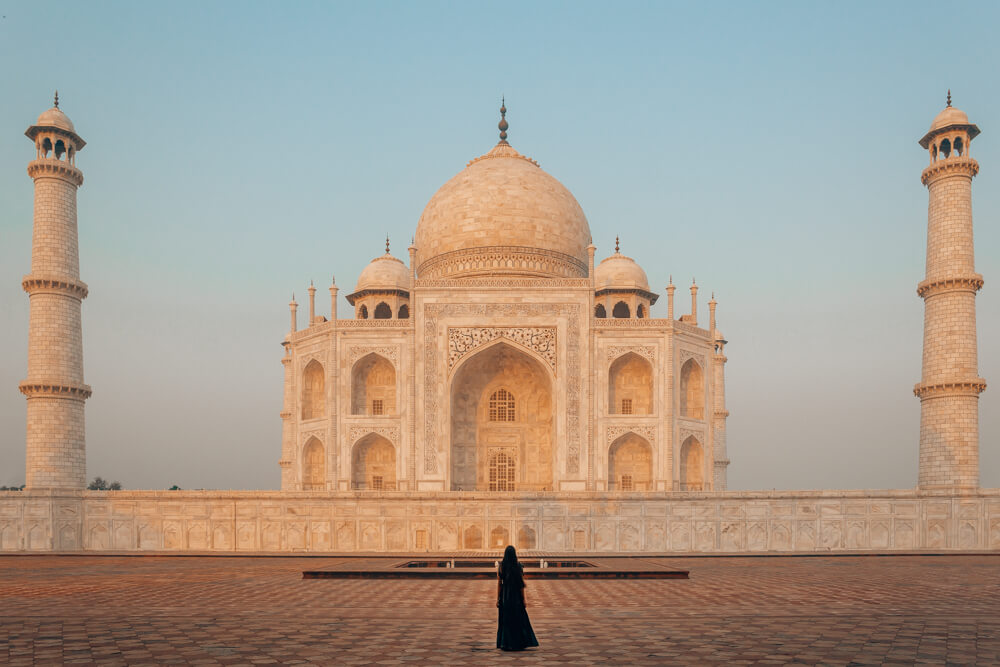
Agra is one of the most visited cities in India for a reason. Home to the iconic Taj Mahal , a magnificent wonder of the world, it is a former capital of India that welcomes millions of tourists every year, eager to visit the country’s most famous monument. Though there is plenty more to experience for those willing to stick around for more than a day.
Boasting a plethora of Mughal tombs and gardens, the historically rich city of Agra is an integral part of India’s Golden Triangle. With three UNESCO World Heritage Sites and dozens of lesser known landmarks under its belt, there is plenty to captivate visiting photographers, travellers and historians to this part of Uttar Pradesh.
So, if you are planning to visit Agra and are wondering what else is there to see beyond the Taj Mahal, then worry not. I spent four days there in October 2021, and am happy to share up-to-date information to help you plan your dream Agra trip. In this guide, you’ll find everything from where to stay to what to see in Agra and much more.
Disclaimer: This post contains affiliate links. If you make a purchase using any of those links, I may get a small commission. Thank you for your continued support!
Table of Contents
Where is Agra?
Located on the banks of Yamuna river, Agra is a city in the Indian state of Uttar Pradesh. It is approximately 210 km south of India’s capital city, New Delhi, and 240 km east of Jaipur in Rajasthan. If grouped together, these three cities make North India’s Golden triangle, the most popular tourist route in the country.
If you only have a limited number of days to explore this region, then doing the Golden triangle circuit is a great way to get an insight into the world of maharajas and Mughal emperors. Travelling through these three neighbouring states, you will see some of India’s most beautiful architecture, and taste delectable cuisines.
But should you have more time on hand, the heritage arc of Uttar Pradesh, including Agra, Lucknow, and Varanasi is also worth checking out. Lucknow is situated at a distance of around 335 km from Agra and has been on my bucket list since so long!
How to get to Agra?
Being one of the top bucket list destinations in India, Agra is well-connected to other Indian cities by an extensive rail and road network. There is also a domestic airport in Agra, but it is usually more convenient to fly to New Delhi or Jaipur due to more frequent flight options.
From those cities, you can take a taxi to Agra or hop on a train. Agra has several train stations, out of which Agra Cantonment (Agra Cantt) and Agra Fort are closer to the city centre. The Gatimaan Express from Hazrat Nizamuddin railway station in New Delhi only takes 1 hour and 40 minutes to reach Agra Cantonment. You can find more information about trains to Agra here .

Alternatively, you can also take your own car or book a private taxi and reach Agra at your convenience. The roads connecting Agra with both New Delhi and Jaipur are in good condition and the drive is pretty smooth and easy. Depending on how early you leave and the route taken, you can get from Jaipur to Agra in approximately four to six hours.
My friend and I booked a taxi from Savaari car rentals for this trip. They are an online cab aggregator in India that provides affordable chauffeur driven taxis in various cities across the country. Their expertise regarding road trips in India is really valuable, especially when going to off-beat places. I used their service to go from Kolkata to Odisha as well and loved that their quoted price includes tolls, state tax and GST so there are no surprises in the end. Check prices for their Jaipur to Agra cab here.
Although trains to Agra take less time to reach, it may make sense for you economically to book a taxi when travelling in a group. But if on a tighter budget, there are also frequent buses that go to Agra daily. You can check the timing and prices for buses to Agra on redBus .
CG’s tip: Almost all train and bus stations have taxi stands nearby. You can hail a ride to your accommodation from there or book a taxi online.
Best time to go?
Although the Taj Mahal looks marvelous throughout the year, the best time to visit Agra is during the winter months from October to February . Summer in North India is uncomfortably hot, followed by months of downpours that make it difficult to freely roam around and explore as desired.
Also keep in mind that during the winter season, the weather changes fast and can affect visibility to only a few meters at dawn. If you want clearer mornings and dreamy sunrises, then head to Agra either between October to mid-November or mid-February to early March. But, if you are looking to create moody pictures, then peak wintertime would be good as well.

I visited in the last week of October and had beautiful sunrises and sunsets throughout. There was a little fog by the Yamuna river during one sunrise towards the end of my trip, but it cleared quickly as I took hundreds of pictures of one of the seven wonders of the world sitting in front of me.
CG’s tip: Regardless of which month you plan to travel to Agra, just note that the Taj Mahal remains closed to the general public every Friday for religious reasons. However, all the other landmarks can still be accessed.
How many days are enough?
Most travellers visiting Agra mainly come to see the Taj Mahal on a day trip from New Delhi. But, in my opinion, that is equivalent to barely scratching the surface. Not only does the Taj Mahal have a distinctive charm at different times of the day, there are also several viewpoints nearby that shouldn’t be missed to admire it from other perspectives.
Being a historically significant city during the Mughal era, there are also SO many other landmarks worth checking out in Agra that a few hours in the city can never be enough. If you are planning to see most of these sights, then spending 2-3 full days is highly recommended.

However, if you only have time for a day trip, then I recommend doing a guided tour from New Delhi to make the most of your time in Agra. This private one leaving at 2:30 am allows you to still catch the sunrise at Taj Mahal, followed by a delicious breakfast and a visit to Agra Fort. Alternatively, this one leaves a bit later and covers Taj Mahal, Agra Fort, Baby Taj and a buffet lunch in Agra.
How to get around Agra?
I usually love walking and getting around a new city by foot, but if I am being completely honest, then Agra isn’t ideal for that. The roads are chaotic and if you are not staying super close to the Taj Mahal, then using a transport to go from one place to another is more feasible.
Depending on your budget, there are auto-rickshaws (tuk-tuks), taxis, and public transport available throughout Agra. Online cab aggregators like Uber and Ola work seamlessly too and cost almost the same as hailing an auto-rickshaw from the street for one-way rides. You can also hire the latter for approximately INR 800 for a day of exploring. Just remember to haggle if getting a rickshaw from the street.
CG’s tip: Between both the cab companies, I found Ola to be working more efficiently in Agra. I went out for sunrise every morning and Ola cabs would come in a couple of minutes even at 4 am. Uber sometimes took longer.
Where to stay in Agra?
From affordable guesthouses and hostels, to some of the most luxurious hotels in all of India, Agra has no dearth of places to stay. Irrespective of what your preferences, budget, and purpose of the trip may be, you can undoubtedly find an appropriate property to base yourself in, without a hassle.

I stayed at the ITC Mughal for the first three nights of the trip and then moved to The Oberoi Amarvilas for the last one to celebrate my birthday. ITC Mughal is for you if you are looking for a reasonably-priced luxury property that is on the top of their game when it comes to safety protocols for the pandemic. Their sanitization protocols impressed me exceedingly throughout the stay!

But, if you are in Agra for a special occasion, or just want to experience the best, then look no further than The Oberoi Amarvilas. Situated only 600 metres from the Taj Mahal, all rooms there provide an unobstructed view of the Taj (!) while the interiors pay homage to Mughal architectural elements. Pair this with delectable food, outstanding amenities and extremely warm staff and you will know why the property is so highly rated and loved. You can check hotel prices and availability in Agra here.
For those of you interested in low and mid-range accommodations, there are many options in Taj Ganj, Rakabganj and Fatehabad Road areas. Taj Ganj is super close to the Taj Mahal, but this neighbourhood can feel a bit unpleasant and congested. On the flip side, places like Hotel Kamal and Hotel Saniya Palace located there come with rooftop restaurants overlooking the Taj that make it better.
Alternatively, Hostels like Moustache are always a popular and safe choice among backpackers.
Best places to see in Agra?
Agra has a wealth of incredible places to offer. From the world-famous Taj Mahal, to lesser known spots like Akbar’s Tomb at Sikandra, there are plenty of incredible monuments to entice both domestic and international travellers. Here are some sites that you should unquestionably add to your Agra itinerary:
Where do I even begin with this one? Built to immortalise the undying affection of a man for his wife, the Taj Mahal is an iconic symbol of love and India’s most recognisable monument. It was built in 1630 by Mughal emperor Shah Jahan in the memory of his third (and favourite) wife, Mumtaz Mahal who died giving birth to their 14 th child.
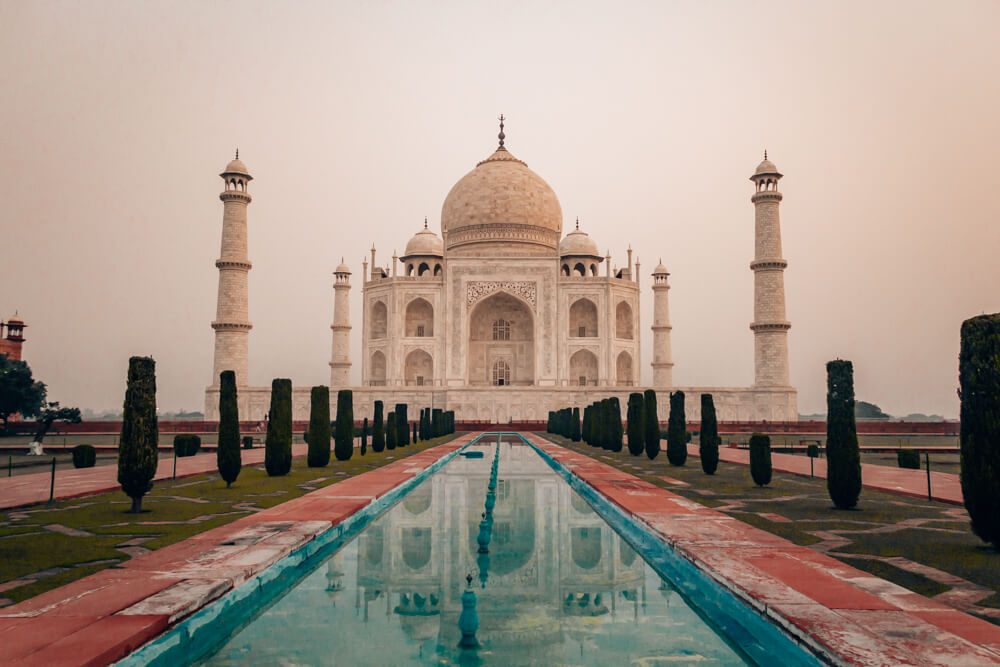
Containing tombs of both Mumtaz Mahal and Shah Jahan himself, Taj Mahal is an architectural masterpiece and a World Heritage Site. If you could only visit one place in India, then by all means, don’t even think twice before heading here. The monument’s perfect symmetry is so compelling that you have to see it in person to understand why it is often regarded as the most beautiful building in the world.

Apart from the white marble mausoleum, the Taj Mahal complex also houses Taj Museum, Charbagh , a mosque, a reflective pool and a guesthouse. Most travellers visiting Taj Mahal stop at the reflecting pool at the front, trying to jolt each other for the iconic shot with the mausoleum. While it is a really picturesque spot, I would advise you to head to the mosque on the west and spend more time there instead. You’ll be surprised to see how less crowded it is!
Re ad More: Best Taj Mahal Viewpoints in Agra

There are three gates that visitors can usually use to enter the premises when visiting, but at present, the South gate is not functional . Between the other two, the West gate is the busiest as most tourists and tour guides tend to avoid the East gate due to the longer walking distance between the vehicle drop-off point and the main entrance. However, in my opinion, it is the best one to use as it is the least crowded.
CG’s tip: Sunrise is the most beautiful time to visit the Taj Mahal. The crowds are relatively smaller and you will get to admire the monument as it ethereally reveals itself through the morning mist. Try to reach 30 minutes before opening hour to ensure you are at the front of the queue in time for opening. If visiting on a day trip from Delhi, you can accordingly book a sunrise tour for the same.
Opening hours: 30 minutes before sunrise to 30 minutes before sunset, every day except Friday. Taj Mahal is closed every Friday for religious reasons. There are also night viewings two days prior to the night of and the two days after the Full Moon, except during the month of Ramadan and on a Friday. Entrance fee: INR 45 for Indians and INR 1050 for Foreigners. Entrance to the mausoleum is an additional INR 200 for both.
Restored by Mughal Emperor Akbar, Agra Fort is the city’s second most impressive landmark and another World Heritage Site. It was primarily constructed as a military fortress in 1565, but was later transformed into a palace by Shah Jahan, who embellished it with white marble and precious stones during his reign.

When visiting Agra Fort, make sure to take a moment to appreciate its impressive red sandstone wall that is nearly 22 m high in several parts. The interiors are equally stunning as well and there are also a few vantage points that provide an unobstructed view of the Taj. When Shah Jahan was overthrown and imprisoned by his son Aurangzeb, he spent eight years here gazing out at the river and admiring the Taj Mahal from a distance until his death.

Some of the places to not miss in Agra Fort are Jahangiri Mahal (Jahangir’s Palace), Khas Mahal, Diwan-i-Khas (Hall of private audience), Diwan-i-Aam (Hall of public audience), Sheesh Mahal (Mirror palace), Musamman Burj, Moti Masjid (Pearl mosque) and Nagina Masjid (Gem mosque). The area is enormous and you’ll need a few hours to see it all. There is also a light and sound show here every evening.

CG’s tip: Agra Fort can get really crowded on Fridays due to Taj Mahal being closed. If you are in Agra for more days, then plan to visit here the same day as the Taj. Alternatively, you can go early morning and enjoy it while it is still quiet. Just avoid going near closing time as the guards tend to rush people out from beforehand.
Opening hours: Sunrise to sunset, every day. Entrance fee: INR 35 for Indians and INR 550 for Foreigners. Plus, a separate ticket for ADA Toll Tax upon arrival, which is INR 10 for Indians and INR 50 for foreigners.
Mehtab Bagh
Located directly across the Yamuna river from the Taj Mahal, Mehtab Bagh is a Mughal botanical garden that has one of the best viewpoints in Agra. If you are looking to get epic sunrise and sunset photos of the Taj Mahal without the crowd, then make sure to not skip this spot. The garden is perfectly aligned with the Taj and there are several photo points facing the monument.
Mehtab Bagh is also known as The Moonlight Garden and there is even a popular myth associated with this place. Legend says that Shah Jahan wanted to make an exact copy of the Taj Mahal for his own burial here, only with black marble instead of white. But the construction of Black Taj never took place as he was imprisoned by his son, who buried him next to Mumtaz Mahal inside the Taj Mahal itself. Whether this is true or just a myth remains unverified.
CG’s tip: Although Mehtab Bagh is just opposite the Taj Mahal on the other side of Yamuna river, getting there takes time. The garden is approximately 8 km from the Taj Mahal and you will need to hire an auto-rickshaw or taxi to get there. Nevertheless, the picture-perfect view of the Taj Mahal is worth it, especially at sunrise or sunset.
Opening hours: Sunrise to sunset, every day. Entrance fee: INR 20 for Indians and INR 250 for Foreigners. No ADA Toll Tax is charged here.
Tomb of I’timād-ud-Daulah
Often known as the Baby Taj or the Bachcha Taj, the tomb of I’timād-ud-Daulah is another Mughal mausoleum in Agra. It was built by Empress Nur Jahan for her father Mirzā Ghiyās Beg, who was known by his title I’timād-ud-Daulah, meaning pillar of the state. Completed in 1628, this mausoleum was one of the first Mughal structures to have ever been built entirely in white marble.

This tomb is situated in the centre of a Charbagh, with four usual enclosing walls and side buildings made of red sandstone. Out of these, the pavilion on the western side beautifully overlooks the Yamuna river. But what sets I’timād-ud-Daulah’s tomb apart from other monuments is the beautiful floral patterns depicted by stone inlays and mosaic work. It even served as an inspiration for the Taj Mahal, which was built for Mirzā Ghiyās Beg’s granddaughter Mumtaz.

CG’s tip: Being a lesser known monument in Agra, the tomb of I’timād-ud-Daulah doesn’t see that many visitors throughout the day. I would suggest you to visit popular places in the morning and then visit here afterwards. Since it is located near Mehtab Bagh, you can easily club the two together too.
Opening hours: Sunrise to sunset, every day. Entrance fee: INR 20 for Indians and INR 250 for Foreigners. Plus, ADA Toll Tax of INR 5 for Indians and INR 10 for Foreigners upon arrival.
Chini ka Rauza
Situated just 1 km north of I’timād-ud-Daulah’s tomb, Chini ka Rauza is another funerary monument in Agra. It contains the tomb of Shukrullah Shirazi Afzal Khan ‘Allami’, a Persian scholar and poet, who later became the Prime Minister of Emperor Shah Jahan. It also has a large garden and nice riverside views.
If you like exploring lesser known places and are in the area anyway, then definitely make a pit stop here. The exterior of this monument is covered in glazed tile work, which is one of the reasons to admire it. The interiors, on the other hand, feature paintwork and inscriptions from the Quran, both of which seems to be depleting to an extent.
However, seeing the dome from inside is still pretty impressive. Just don’t head here with high expectations as the structure isn’t maintained like other popular places in Agra. Some of the tile work on the outside is either falling off or has lost its colour due to the weather. Hopefully it can be restored to its former glory someday!
Opening hours: Sunrise to sunset, every day. Entrance fee: Free.
Tomb of Akbar
Akbar’s tomb is another beautiful example of impressive Mughal architecture. It is a hidden gem that is the final resting place of Mughal Emperor Akbar. It is located in the town of Sikandra, about 40 minutes outside of the main city. Emperor Akbar planned and constructed most of the monument himself while he was still alive. But, it was completed by his son Jahangir, after his death.
The mausoleum itself is five stories tall and is made with red sandstone and white marble. It is surrounded by vast gardens, housing deer, monkeys, peacocks and other wildlife. If you love architecture and photography, then make sure to not give this picturesque sight a miss. The chhatri-topped minarets, painted interiors and detailed inlay work are really remarkable to see up close.
CG’s tip: Sikandra is en-route to Fatehpur Sikri from Agra. If you are planning to visit there, then you can make a stop at Akbar’s tomb on the way to save time. The tomb of Mariam Zamani, Akbar’s wife, is also situated close by in Sikandra itself.
Tomb of Mariam-uz-Zamani
Not too far from Akbar’s tomb lies another Mughal mausoleum in Sikandra. This is the final resting place of Emperor Akbar’s favourite wife, Mariam-uz-Zamani. It was built by their son Jahangir and is about a 5 minute driving distance from the tomb of Akbar. If you are travelling to Sikandra to see Akbar’s tomb, then you can make a stop here as well.
Mariam’s tomb was formerly an open baradari (pleasure pavilion) built by Sikander Lodhi in 1495 AD. The Mughals acquired it in the 17 th century and reconstructed the exterior walls by introducing red sandstone to the edifice. Similar to other Mughal sites in Agra, this mausoleum is also surrounded by lush gardens. However, there isn’t much else to see at the site.
Opening hours: Sunrise to sunset, every day. Entrance fee: INR 10 for Indians and INR 250 for Foreigners. ADA Toll Tax is not levied here.
Note: All the above-mentioned entrance fees are as per the online ticketing charges. The prices will be slightly higher if you purchase them via cash, when or if the ticket counters open up (more on this below). You can book online tickets to any of these on the official website here .
Taj Nature Walk
Located a few metres away from the East Gate entrance of Taj Mahal, it is a peaceful park providing walking trails and beautiful viewpoints. If you are looking to get away from the hustle and bustle of Agra, then take a stroll through this 70 hectare green belt and enjoy glimpses of Taj Mahal every now and then.
Taj Nature Walk is home to a wide variety of flora and fauna. Including an array of birds, you can expect to come across peacocks, peahens, hyena, and more here. Some people also like to go here for a picnic, but in general, it is not a busy attraction. For the best experience, visit here in the morning or evening hours when the weather is pleasant.
CG’s tip: The entrance to Taj Nature Walk is on the Taj East Gate Road. You may be asked for an ID when visiting, so make sure to carry one with you. Taking a reusable water bottle is also recommended as there is no place to buy it once there.
Opening hours: Sunrise to sunset, every day. Entrance fee: INR 20 for Indians and INR 100 for Foreigners.
If you are in Agra for longer, then there are also some other landmarks that you can check out. Taj Mahal itself has plenty of viewpoints, especially for those willing to walk around the nearby areas in pursuit of different perspectives. My personal favourite is the chhatri situated close to Dussehra Ghat, and from the boat ride on Yamuna river.

Agra also enjoys local markets which are an experience in themselves. If you don’t mind the constant honks, large crowds, haggling, etc., then visit the narrow lanes of Kinari Bazaar near the Taj Mahal. The enormous Jama Masjid is also located there. Sadar Bazaar is another famous market in Agra.
Day trips from Agra?
Even though there is a lot to see in Agra itself, there are also remarkable destinations outside it that you can explore when there. The roads are in good condition and you can easily do a day trip to see other gems of Uttar Pradesh. Here are some places that I would recommend checking out:
Fatehpur Sikri
Situated less than 40 km from Agra, Fatehpur Sikri is a 16 th century city that was built predominantly in red sandstone by Emperor Akbar. It was founded as the capital of the Mughal Empire and later abandoned after just 15 years due to multiple reasons. Today, it is a UNESCO World Heritage Site that is a must visit for every architecture lover.

Combining Hindu and Muslim elements, Fatehpur Sikri is one of the finest examples of Mughal architectural splendour. The city is surrounded by a large fortification wall and there are several entryways to access the premises. Known as the Gate of Magnificence, the Bhuland Darwaza at Fatehpur Sikri is the highest gateway in the world at a height of 54 metres.
Other must-see attractions at Fatehpur Sikri include The Jama Masjid, which is one of the most beautiful mosques in India. The Palace of Jodha Bai, Panch Mahal, Anup Talao, Diwan-I-Khaas, Diwan-I-Aam, and the Treasury are wonderful too. Just try to visit early in the day so you have enough time to go around and see everything at a relaxed pace. You will easily need a couple of hours here.

CG’s tip: Fatehpur Sikri is divided into two parts: the mosque, and the palace complex. Most taxi drivers will try to drop you close to Bhuland Darwaza, which is the entrance to the Jama Masjid. But, I suggest visiting the palace area first.
Bhuland Darwaza is surrounded by many hawkers, beggars and young children that roam around freely pretending to be guides harassing tourists in the name of charity. Just head to Diwan-I-Aam or Jodha Bai entry gates and visit there later to have a quick visit of the mosque.
Opening hours: Sunrise to sunset, every day. Entrance fee: INR 35 for Indians and INR 550 for Foreigners. An additional ADA Toll Tax of INR 10 for Indians and INR 50 for Foreigners is also charged upon arrival. The Jama Masjid complex at Fatehpur Sikri can be visited free of cost.
Located about 25 km from Fatehpur Sikri lies Bharatpur. It is an Indian city in the state of Rajasthan that has an array of beautiful palaces, forts and temples to offer. I would typically suggest to stay here overnight to be able to explore it properly, but if you are short on time, then it can be a great addition to your Fatehpur Sikri day trip from Agra too. There are many tours that cover both places.
The most popular site to not miss in Bharatpur is the Keoladeo National Park, formerly known as the Bharatpur Bird Sanctuary. It is a World Heritage Site where you can spot over 350 species of birds, especially during the winter season. The landscape is really beautiful and you can choose between covering the trails on foot, bikes or a cycle rickshaw. Boating is also available there.
CG’s tip: Bharatpur and Fatehpur Sikri both fall on the way on the Jaipur-Agra route. If you are travelling between Jaipur and Agra by road, then you can visit either of them or both, depending on how much time you have. For Keoladeo National Park, I would recommend having a few hours in hand.
Opening hours: Keoladeo National Park is open from 6:30 am to 5:00 pm in Winter and 6:00 am to 6:00 pm in Summer. Entrance fee: INR 75 for Indians and INR 500 for Foreigners. Prices for vehicle hire at the Keoladeo National park are separate.
For those interested in spirituality and Hindu culture, the city of Mathura is another option for a day trip from Agra. It is located approximately 57 km from Agra and is popular for being the birthplace of Lord Krishna. Offering landmarks like sacred temples and serene ghats, Mathura is unlike most other cities in India.
Known as the holiest place in the city, the Shri Krishna Janmabhoomi Temple is one of the must visit sites in Mathura. There are large celebrations here during the festivals of Holi and Janmashtami. Other notable landmarks in Mathura are Vishram Ghat, Kusum Sarovar, Kans Qila, Jama Masjid, Krishna Balaram Mandir, Goverdhan Hill and more.
Your trip to Mathura can also be combined with a visit to its twin city of Vrindavan. The town of Deeg is also an easy drive from both Mathura and Bharatpur.
Located around 15 km from Mathura, Vrindavan is another holy city situated on the banks of the Yamuna river. It is a Hindu pilgrimage site that is known for being the city where Lord Krishna spent a considerable amount of his childhood. There are numerous temples dedicated to Lord Krishna in Vrindavan.
Shri Banke Bihari Mandir is one of the most popular temples to visit in Vrindavan. It is also the main centre of celebration of the Holi festival in Vrindavan, where events take place for a whole week. The shrine at Banke Bihari Mandir is one of the most admired in all of India.
Other places to see in Vrindavan include Prem Mandir, Govind Devji Temple, ISKCON Vrindavan, Radha Raman Temple, Nidhi Van, Keshi Ghat, and more. You can drive to Vrindavan yourself, use public transport or book a private guided tour. This one from Agra takes you to both Mathura and Vrindavan.
Where to eat in Agra?
Indian food is one of my all-time favourites, so I love travelling within India and tasting local delicacies of different regions. Here are some places that I would recommend for good vegetarian food in Agra:
Bellevue: Bellevue is an all-day dining restaurant at The Oberoi Amarvilas, serving Indian and International cuisines. It has both indoor and outdoor seating, where the latter overlooks the hotel’s beautiful, lush gardens and the pool area. From hand rolled pastas to chaat boxes containing mouth-watering street food, you can expect to find great quality no matter what you order. Their Thai Stir Fried Tofu and Vegetable Krapow were my personal favourite!

Esphahan: Esphahan is a speciality tandoor dining restaurant serving Mughal cuisine at The Oberoi Amarvilas. You can order Thalis or multiple course set menus here and enjoy a delicious dinner while listening to live music. My friend and I went with the traditional Indian Thali option and loved everything. The Dal Esphahani and Pistachio Kulfi were a delight!

Peshawri: Peshawri is another North Indian fine dining restaurant in Agra. It is located inside the ITC Mughal and serves dishes that are cooked in traditional clay pots or tandoors. Some of the dishes were not available during our visit as the restaurant had just re-opened that night itself, but we had Dal Bukhara, Kebabs and lots of butter Naan. Their bread was so good that I could eat just that on its own!

Sheroes Hangout: Sheroes Hangout in Agra is a café with a cause. It is a colourful place that is run by acid attack survivors who welcome customers with utmost love and big smiles. Their mission is to raise awareness about these attacks and empower other victims to continue living life in public. The menu at Sheroes Hangout doesn’t have any prices and customers are requested to pay what they deem right. Please remember to pay fair and support them in whatever way possible.
Other than these, we mostly ate our weight in breakfast buffets and decent looking all-day dining places close to where we were. If you happen to be in the Taj Ganj area, then you can also check out rooftop restaurants like Hotel Saniya Palace that are known for their view of the Taj Mahal. The food is mostly simple, but worth a visit for the viewpoint.
What to buy in Agra?
Agra is known for many things, out of which Petha is the most popular. It is an Indian soft candy made from white pumpkin. Most sweet shops in Agra sell Petha and there are often numerous flavours available. If you like sweets, then make sure to try this local delicacy or bring back some for your loved ones. You can get Petha near the Taj Mahal, at bus and train stations, and in local markets and speciality stores.
Another souvenir that you can buy from Agra are marble replicas. From a Taj Mahal miniature to products like trays, vases, or boxes, you can find many items inlaid with semi-precious stones in ornate floral designs that are commonly found in Mughal architecture throughout Agra. There are many stores on Fatehabad Road that sell these.
Other products that Agra is known for are leather goods, silk sarees and textiles, rugs and carpets, handicrafts, and more. Have a stroll around Kinari Bazaar or Sadar Bazaar and you’ll probably find something interesting for yourself. Just note that Kinari Bazaar is closed every Tuesday.
What to pack for Agra?
- A camera! Taj Mahal is one of the most photogenic sites in the world, so you would be crazy to travel to Agra and not capture it. Whether you are comfortable using a smartphone or a professional DSLR or mirrorless camera, make sure to take one with you and snap some pictures. I recently upgraded to a Sony mirrorless !
- A wide angle lens . The monuments in Agra are designed in such a way that you’ll sometimes wish you had a wider lens to shoot the entire setting. Landmarks like Akbar’s Tomb are enormous in size, and if you want the iconic arch shot of the Taj Mahal then definitely carry this with you.
- A zoom lens may also be useful if you are looking to get some detailed shots while in Agra. It would particularly come handy in places like Mehtaab Bagh where Taj Mahal would be a little further.
- A hard drive because all those photos need to be stored somewhere now, don’t they? This may not apply to everyone, but I like to take a backup of my files every day and thus carry a hard drive on all my trips. Not only does it help to empty SD cards, but I honestly sleep better knowing my photos are safely backed up. This is the one I use.
- Weather appropriate clothing. The temperatures in Agra vary vastly between the different seasons, so make sure to bring suitable clothing for your trip. However, for women, I suggest leaving tanks behind and bringing light maxis or similar if travelling in summer. Agra is still a conservative city.
- If you are a female, then carrying a scarf to cover your bare shoulders when visiting masjids, temples and other religious sites is also a must. I personally take one or a light jacket with me on most trips around India as they can also be useful in crowded areas to avoid unnecessary attention.
- A travel plug adapter that supports outlet types C, D, and M. If your devices are bought from outside India, then make sure to check this to have a seamless experience at your accommodation or check with your hotel for a spare. This one works in most places around the world.
- A portable charger. Since you are going to be out and about all the time and using your phone for photos, directions, restaurant reviews, you may run out of battery quickly. A portable charge ensures you always have a working device with you!
- Last but not the least, make sure to carry hand sanitizers and face masks . You can never have too much of these while travelling during these uncertain times.
Some things to know before visiting Agra
- Entrance tickets for all the monuments in and nearby Agra must now be purchased online. There used to be functioning ticket counters at all the touristic sites before the pandemic, but that isn’t the case anymore.
- You can now either buy your tickets for Agra monuments here before visiting or scan one of the QR codes displayed on the entrances and get an electronic ticket on the spot. However, sometimes the portal does not work efficiently due to poor connectivity so it is better to purchase from before with hotel WIFI.
- Should the ticket booths open again soon, remember that in person tickets are more expensive. If you purchase tickets to monuments in Agra online (either before visiting or paying by card on arrival), then automatic discounts are applied to the final price. The deductions are not huge, but do make a difference when visiting many places.
- On top of the entrance fee, the Agra Development Authority (ADA) also imposes a charge commonly known as ADA’s Pathkar or Toll Tax. It will already be included in the price of your Taj Mahal ticket, but you will be asked to pay it on top of your tickets at other landmarks.
- All foreign citizens visiting other monuments in Agra on the same day as the Taj Mahal do not have to pay the ADA Toll Tax again (make sure to show your ticket for the same if asked). However, you will not be exempted from it the next day. The ADA doesn’t levy any Toll Tax on Fridays so you can visit then to save money.
- Some landmarks in Agra have a huge list of prohibited items that are strictly not allowed inside the premises. Before visiting any of these locations, make sure to check the list from beforehand to avoid wasting time in cloak rooms and security checks. For instance, visitors cannot carry any food, tobacco products, tripods, portable charges, pens, etc. inside the Taj Mahal.
- Know the best time to visit popular places. Being regarded as the most beautiful building in the world, it is safe to say that the Taj Mahal gets REALLY crowded even at sunrise. I, fortunately, got lucky as India was still closed to international tourists at the time of my visit, but try going as early as possible.
- Trust that the fog is real. If you are planning to visit Agra during the winter season in India, then expect that you may not be able to see the Taj Mahal clearly early in the morning. The visibility can get so low that you can stand just beneath it and still not be able to get a detailed glance!
- You may come across articles online that claim there is nothing else to see in Agra apart from the majestic Taj Mahal. But in reality, this couldn’t be further away from the truth. Give the city more than a few hours and explore some other incredible structures from the Mughal era to see what else it has to offer.
- There is also a lot of talk about Agra being a dirty and smelly place. Since this was only my first time properly seeing the city, I cannot argue if that is always incorrect, but I personally didn’t think the same was true from what I saw and experienced. Maybe it is due to the ongoing pandemic, or less number of daily visitors at the moment, but all the sights and areas I saw were clean.
Final Thoughts

That’s a wrap on a comprehensive Agra travel guide from me! I hope you found information in this blog post helpful in planning your trip to Agra, the home of the Taj Mahal.
I tried to include everything I could think of, but if there is anything else I can help you out with, then please don’t hesitate to leave a comment below. You can also DM me on Instagram or send an email. I love hearing from you and helping you plan your trips!
Happy Exploring, Charu xx
Want to keep reading? You may like “ Best Instagrammable Places in Jaipur ” and “ 11 Best Instagram Spots in Bikaner ” too.
LIKE THIS POST? PIN IT FOR LATER ⤸

This Post Has 20 Comments
Charu, I love how beautiful your pictures are and how detailed the guides. I started following you on Instagram after coming across your Agra posts and have been waiting for this guide. Thank you for covering every topic that was needed so thoroughly!
Thank you so much for joining me here and on Instagram, Suman. I am glad that you came across my pictures from Agra, thanks for all your kind words 💖
Agra is incredible. I’m so glad I went before COVID. I hope to return one day. Thanks so much for the info. Your pictures are beautiful.
Thank you, Sharon. And yes, so good that you could visit India before the borders shut down. I hope that we can reopen properly soon and people can start returning!
I am blown away by your photos of these historic buildings.
The architecture in India is incredible, thank you Terri.
Beautiful photographs! I love the way the sun appears to set the marble on fire, Although when we visited at sunrise I looked half asleep. The nearby forts are equally magnificent. A really comprehensive post – so useful and visually appealing.
Me too! We were there for quite a few hours, so it was interesting to see how the marble changed colours under different lighting conditions. Our guide also made us observe some precious stones that illuminated due to the sun’s position, which was fascinating to say the least. Thank you for your kind words, Hels!
Your photos are so beautiful! Agra looks amazing to explore, thank you for this great detailed guide!
It really is, Lyne! Have you thought about visiting someday?
Your pictures are incredible!!! Lovely post, thanks for sharing all the details with us 🙂
Thank you for reading, Karla! I am glad you liked it 🙂
Your photos are absolutely stunning! And that architecture!! Thanks so much for sharing such an incredible destination!
Thank you, Kathryn! Agra is truly special.
Beautiful pictures! I visited the Taj Mahal a few years ago but I didn’t get a chance to go there at sunrise. I’d love to go back again some day!
You must. Although the Taj Mahal is beautiful at any time of the day, seeing it at sunrise is truly incomparable. I hope you get to experience that one day!
Wow loved the pictures..so amazing .i remember Visitng long back during childhood..need to visit again
Thank you, Madhu. And yes, you must!
I don’t even know where to start on saving all this info in my planner lol So helpful! Thank you 🙂
Just a side question, but your amazing dresses… do you wearing them out all day when traveling or change at the location before/after? Also, where do you buy your dress, they look so beautiful and flowy.
Hi Channy, I am so pleased to hear that you found this post helpful. I usually wear the dresses all day, but sometimes also change at the location or before/after if it involves a hike. Typically, I take most of my photos in the morning or during sunset so I may also change into something more comfortable for just roaming around the city when not shooting. Most of my outfits from this article are linked in my ‘Outfits’ Instagram Highlight but feel free to DM me for any links if you need.
Leave a Reply Cancel reply
Save my name, email, and website in this browser for the next time I comment.
Please enter an answer in digits: 7 + seventeen =
Sign me up for the newsletter!

Inside Agra Fort: Your Detailed Guide To Explore
- February 8, 2021
- January 27, 2024
- Uttar Pradesh , India
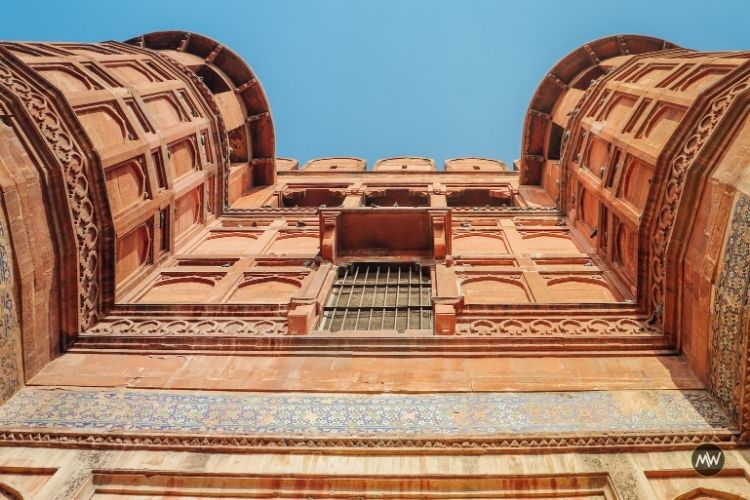
Agra Fort is a red sandstone fort and was originally an expansion of a brick fort built by King Badal Singh. The grandeur and the credit for its construction are given to Mughal emperor Shah Jahan.
Agra means Taj Mahal and Taj Mahal means Agra.
This notion arises in our hearts when we think of Agra. Albeit, the city is also famous for the sweet Pethas which no traveler goes back without tasting.
Our recent visit to Agra has been a special one. We didn’t visit Taj but everything beyond Taj. So in this post, we’ll introduce you to some hidden gems of Agra which are generally ignored or visited less frequently.
What’s Down The Line?
Video travel guide.
After exploring Fatehpur Sikri , in the same sequence, we reserved the next day to visit Agra Fort.
Since our hostel was near to the Agra Fort, it took us a few minutes taxi ride to reach the Agra Fort.
As we walked near the entry gate, Vipin started booking the ticket online. Suddenly, one of the sahibs called himself a formal guide and said to me, “I’ll show you the fort for just 200 rupees.”
“No, I will do that myself, thanks for asking,” I answered.
“There are 16 palaces inside the fort, you won’t be able to identify! Well, let’s agree on 100 rupees for 2 people,” he insisted.
“Brother, this is my third visit to Agra Fort, I know things,” Vipin said confidently.
We reached the security cordon and then a guard said, “You cannot carry this tripod,” showing us our tripod. On requesting a little, he agreed that we can take it if we promise we will not use it at all.
The Grand Amar Singh Gate
Although the palace mainly has four entrances, three gates are closed to tourists (acquired by the army), and the door through which you enter is the Amar Singh Gate, which is on the south side. Another gateway, located on the north side, is known as Delhi Gate.
View this post on Instagram A post shared by Misfit Wanderers | Travel Blog (@misfit.wanderers)
After entering through the Amar Singh Gate, another entrance stands ready to welcome you. Fine workmanship and colorful tiles add to its beauty.
Here the gatekeepers were stationed on elephants, so it is also called the Elephant Pole. As you keep going, high walls on both sides start to emerge, at the end of which stands another gate.
History: Agra Fort Dates Back The Mughal Rule
Historians believe that in the 11th century, a Rajput king named Badal Singh built this fort out of bricks named it after his name as ‘Badalgarh,’ which remained so until Akbar’s arrival.
In 1180 AD, Ghaznavi’s army captured it. After that Alexander Lodi was the first emperor of Delhi who lived in this fort. Since then, Agra has become the second important capital after Delhi.
The fort was inhabited by Ibrahim Lodi, son of Alexander Lodi until he was defeated by Babur in the Battle of Panipat in 1526 AD. Babur also lived here for a few years and his son Humayun also lived in the palace till 1540 AD. He built some noticeable buildings and the Baoli .
Humayun was defeated by Sher Shah Suri in Bilgram and lived in the fort until Humayun regained it. And finally, this fort came under Akbar with victory in the Battle of Tughlakabad in 1555 AD.
Akbar understood the importance of this fort and he shifted his capital from Delhi to Agra and converted this simple-looking fort from red sandstone to a plush fort. The fort which is seen today is the result of 8 years of construction and the hard work of ~4000 workers.
From Akbar to the last Mughal ruler Aurangzeb, all lived in this fort. Shah Jahan built many white marble buildings in his era in the fort.
The historian Abul Fazal claimed that the fort encompasses 500 buildings and described it as a marvelous piece of architecture.
It was invaded and captured by the Marathas in the 18th century and eventually the British took control of it in the Anglo Maratha War in 1803. It also played an important role in the Indian mutiny of 1857.
Buildings Inside Agra Fort
This fort once had many buildings, but over time the buildings were destroyed.
Today, 70% of the entire fort is under the control of the Indian Army and only 30% is open to the general public.
In 1983, this fort was included in the list of World Heritage by UNESCO.
Jahangiri and Akbari Palace
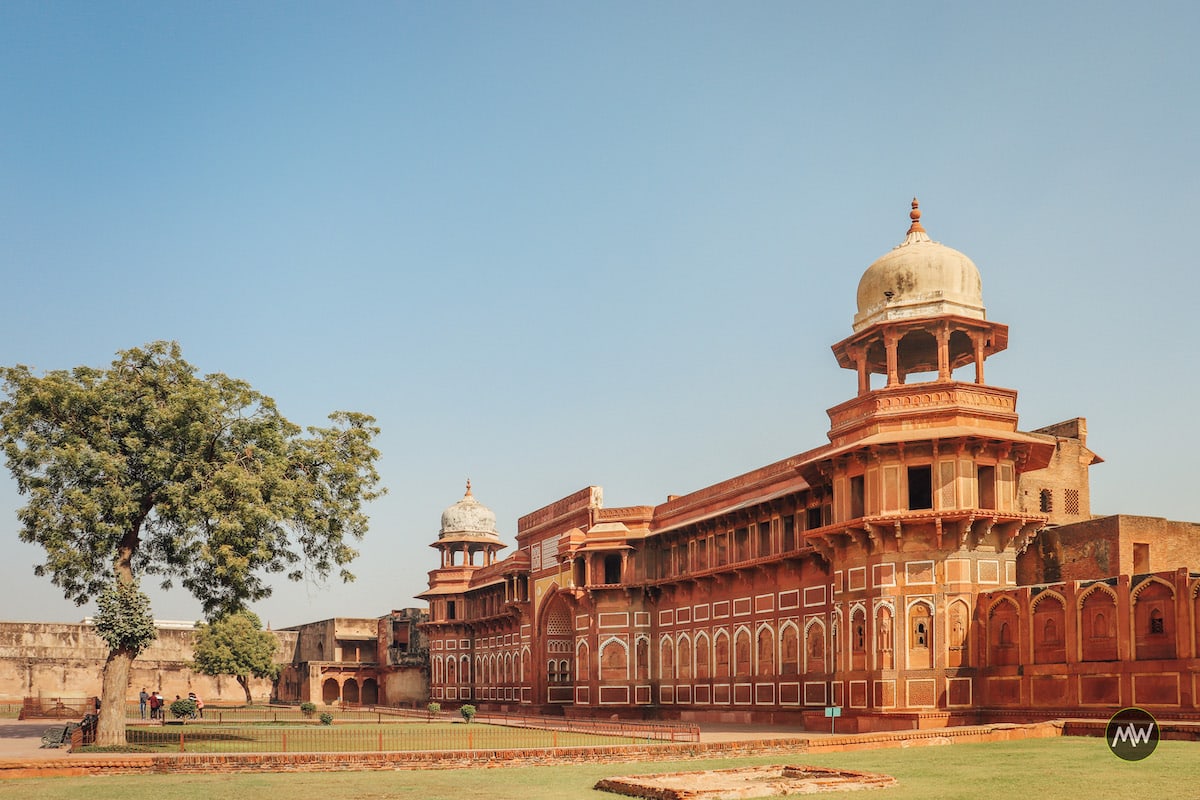
As you pass through the emerging wall, just before the gate, Jahangiri and Akbari Palace can be seen on the right side.
The Akbari palace is in a demolished state and only a few walls still stand. We started exploring this palace first before going to Jahangiri palace.
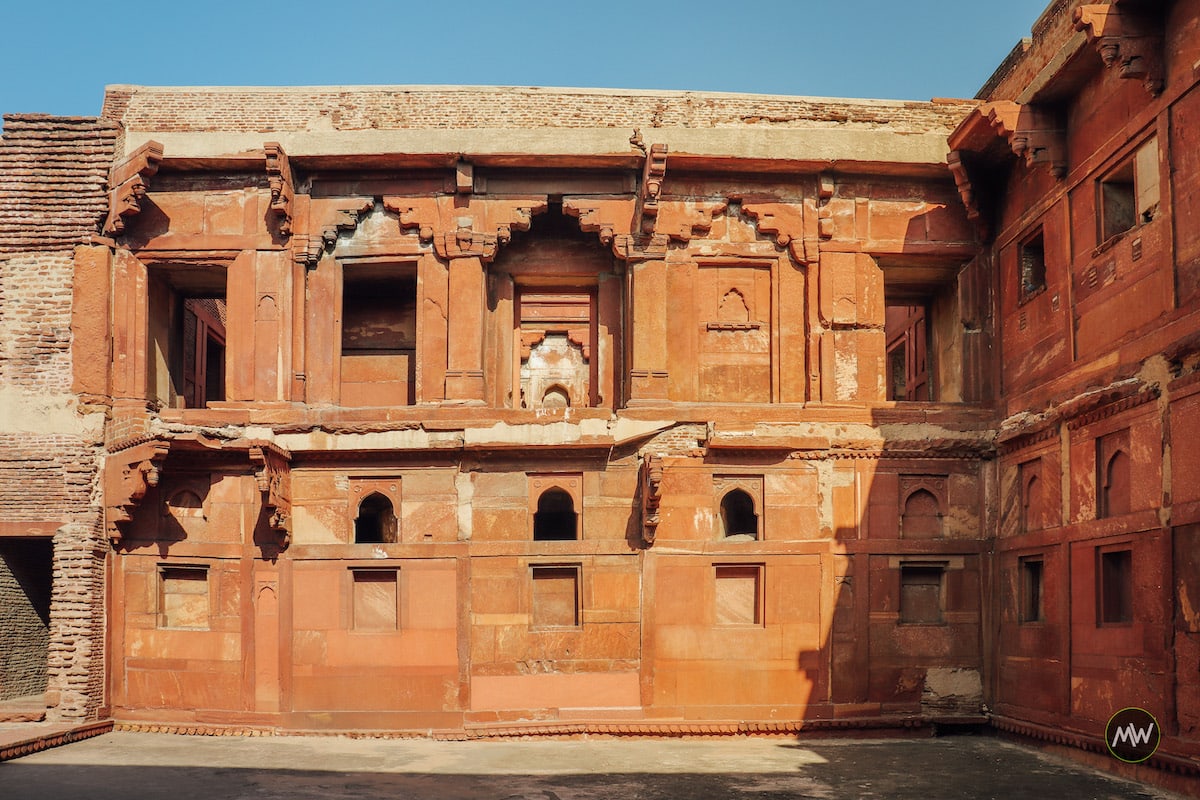
Having clicked a few good pics, we started moving towards the Jahangiri Palace. At the front gate, you will see a big pot. The inscriptions tell us that this was the bathing pot of Jahangir.
The palace is made from red sandstone with beautiful sculptures. It was the harem of Akbar where more than 500 women lived. It is one of the largest buildings with considerable expansion.
Since Jahangir’s childhood was spent here, it is named Jahangiri Mahal. Akbar and Jahangiri palace are jointly called Bengali Mahal, because like Bengali architecture it had small courtyards and flat terraces.
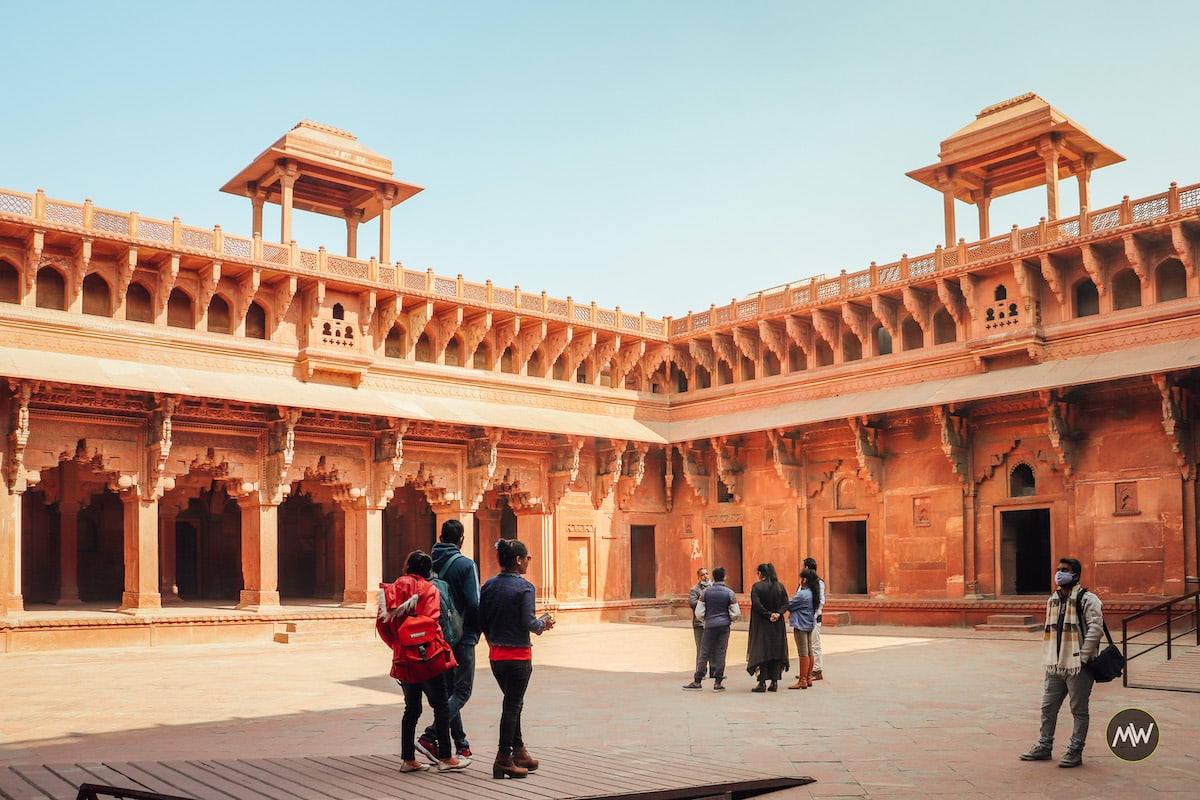
As soon as you enter the palace, you come into a square-shaped courtyard. The palace is of Rajputana and Persian architecture, along with hanging-carvings, stone beams, and plaques. Along with the carvings, the lime embellishments add sparks to its beauty.
Can you imagine the making of this fine architecture without the aid of modern machinery and tools?
Shahjahani Palace and Ghazni Darwaza
The next stop is the Shahjahani Palace, which was the first building built by Shah Jahan by demolishing the old building in this fort. It has rooms with a spacious hall. Shah Jahan made white lime plaster over it and made some flower leaves and other figures, due to which it started glowing.
In the verandah of Shahjani palace, you’ll see a 16.5 feet high and 13.5 feet wide gate put in a small room. It is the Ghazni Darwaza believed to be overthrown by the Britishers from the mausoleum of Mahmud Ghaznavi.

Once an English official had said that this is the same door of sandalwood which Ghazni looted from Somnath in 1025 AD and hence also known as Somnath Gate. Later, it was found that it is a normal door of cedar with Arabic inscriptions on it.
Khaas Mahal (Special Palace)
After passing through Shahjani Palace and Ghazni Gate, you will arrive at a square-shaped, white marble palace with two palanquin-like buildings alongside.
This fine marble edifice used to be the residence of Shah Jahan and Mumtaz Mahal. Its windows are forged in such a way that you can see the Taj Mahal from here.
On both sides, you see palanquin-like buildings. These were inhabited by the daughters of Shah Jahan, Jahanara, and Roshanara. The architecture appears to be of Rajput style.
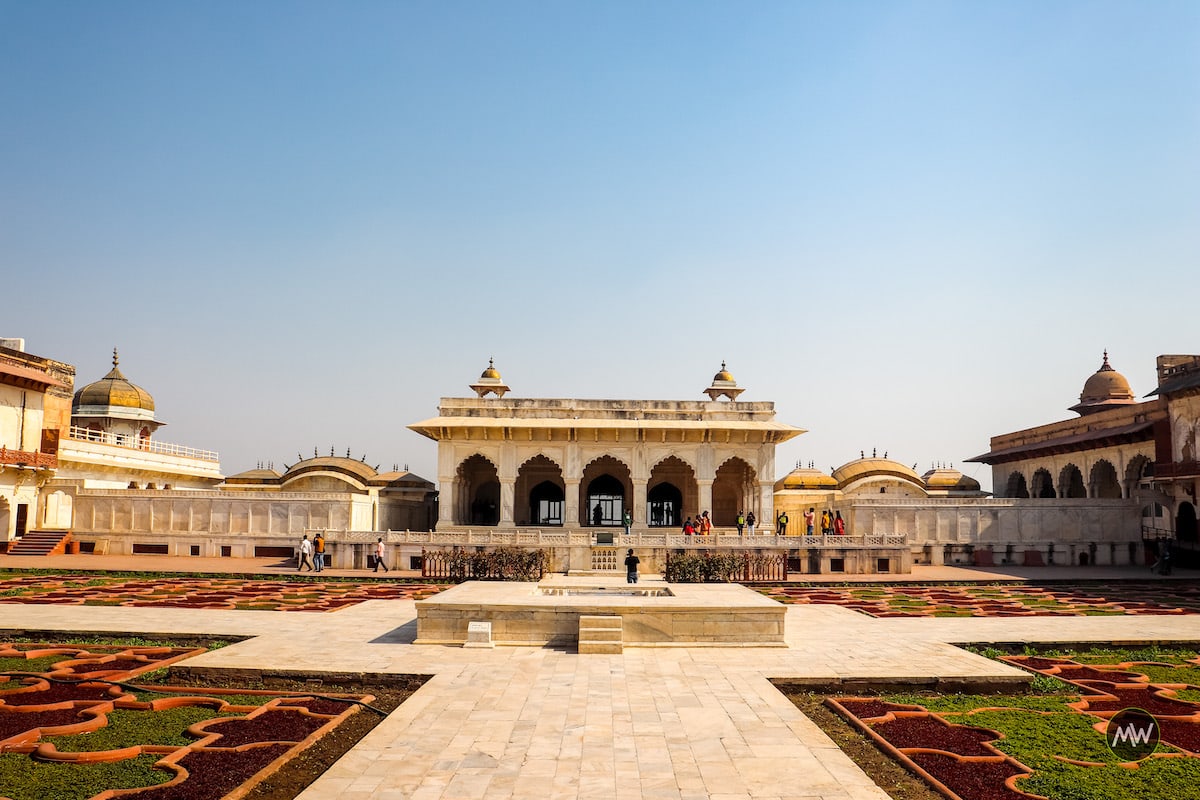
Right in front of the Khas Mahal, there’s a small royal pond and Angoori bagh.
Musamman Burj and the Chain of Justice
Aurangzeb captured his own father, Shah Jahan, and held him captive in Agra Fort for 8 years. The place where he was held is Musamman Burj.
You will see Musamman Burj on the left side of Khaas Mahal as you pass through the palanquin-like building.
Shah Jahan used to stare at the Taj Mahal from here.
Akbar built this building with red sandstones where he used to perform Suryopasana. Jahangir also used this place as Jharokha Darshan.
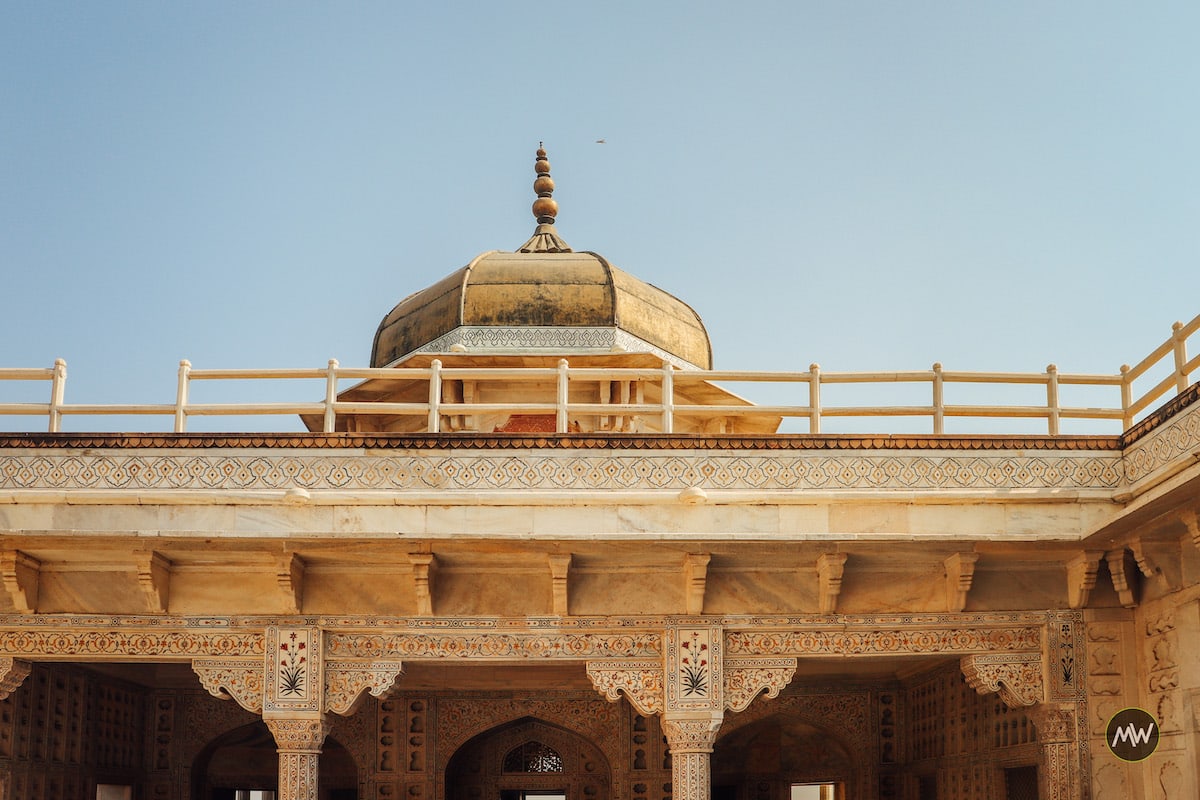
You see a stylized belle and flower leaves studded on its margins and a mix of yellow in white marble.
Next to the Musamman Burj, you see Jahangir’s Chain of Justice.
It was an ~80 feet long chain with bells attached, connecting Agra Fort to a post by the nearby riverbank. It weighed about one quintal and was also called Adal-e-Jehangir.
It was an innovative method forged by Jahangir to hear complaints of the common public. Anyone who had a complaint could ring the bells and the emperor would address his/her issue.
Sheesh Mahal – Palace of Glass
On the west side of the Musamman Burj and near the Khaas Palace, there is another unique specimen that offers an amazing view of the artwork – Sheesh Mahal or the Palace of Glass.
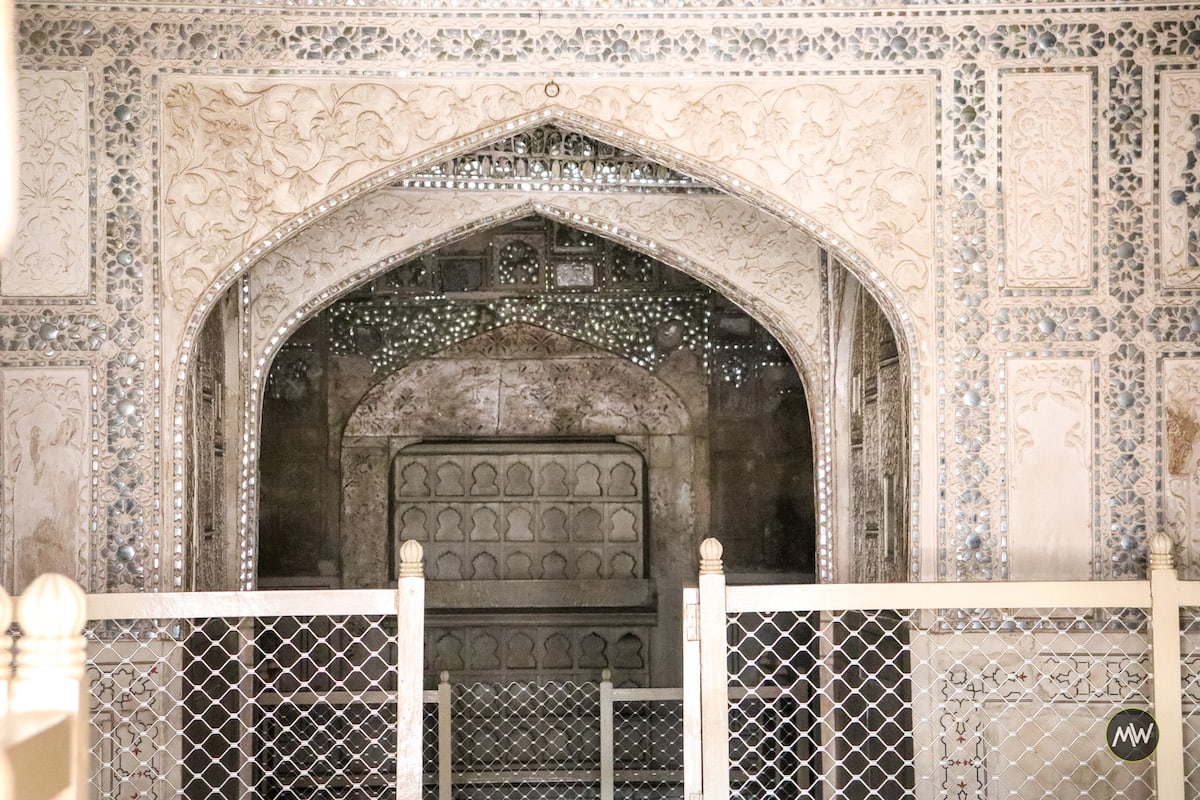
This palace is closed for tourists but you can peep and admire its beauty through a see-through door.
The glass ornamentation has been done on all the walls and roofs. The vials were imported from Syria. Due to the presence of glass all inside the Sheesh Mahal, it used to reflect light illuminating every corner,
Outside, you’ll Angoori Bagh with 2 fountain pools with saffron-colored and green grass.
Diwan-e-Aam
In front of the Khas Mahal and at the end of Angoori bagh, you cross a small door to arrive at Diwan-e-Aam.
The Diwan-e-Aam is an open, large rectangular building standing on beautiful columns and has a large open space in front. The emperor used this place to listen to the problems of the general public and give solutions to them.
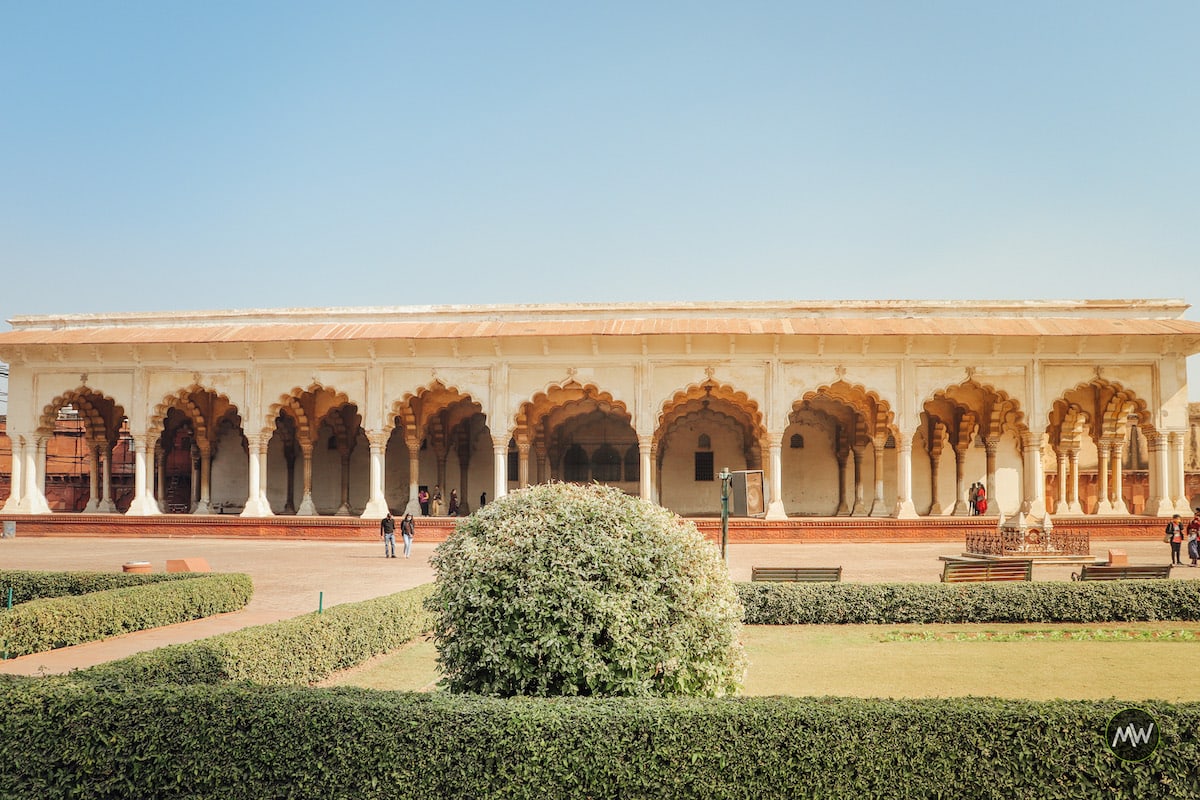
Just in front of it is the tomb of an English officer named John Ruskell who was killed here in the revolution of 1857. During the revolution, the British made it a storehouse of ammunition.
Machhi Bhawan and Nagina Mosque
On the left of the emperor’s seat in Diwan-e-Aam, you will see stairs taking you towards the Macchi Bhawan and the Nagina Mosque next to it.
Macchi Bhawan is a square courtyard with green grass. Once it had a small pond with golden fishes in it. Eavesdropping a guide standing near me, I came to know that there used to be a market at this place which was known as Meena Bazaar.
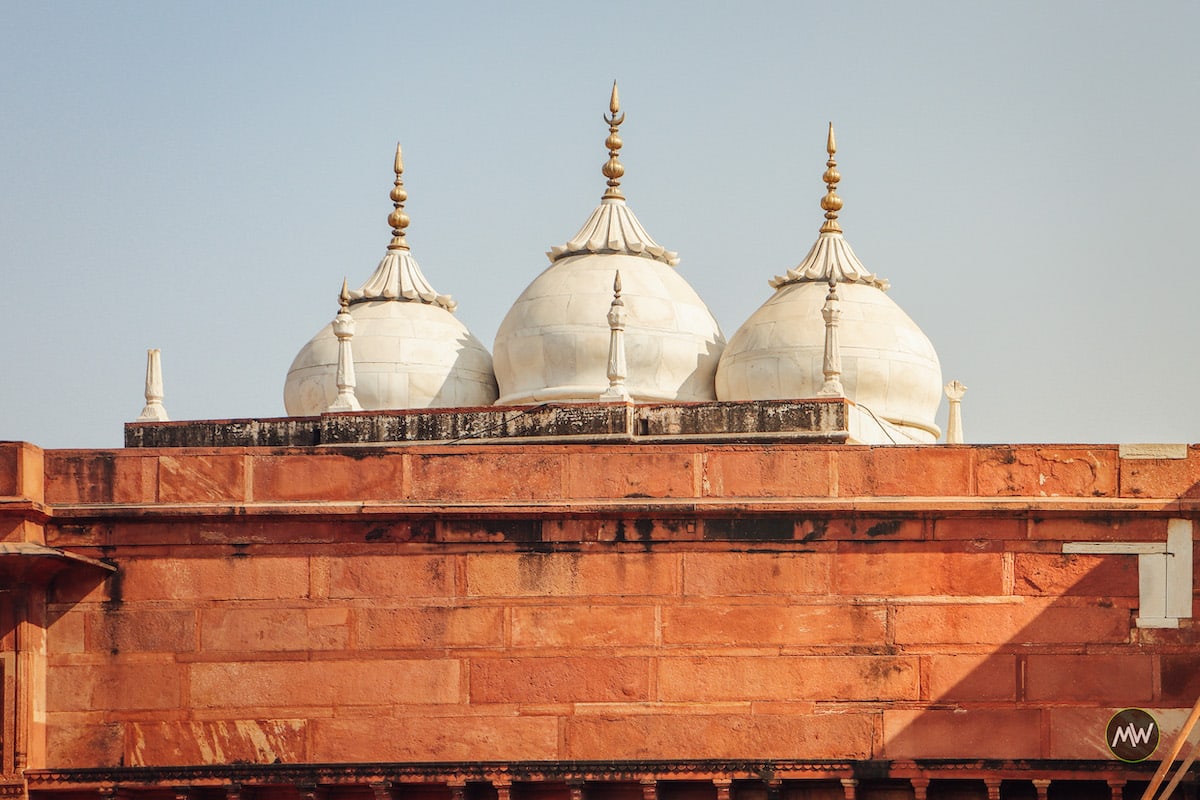
The Nagina Mosque, built-in 1635, was a private mosque. It was used to offer prayers by Shah Jahan and ladies of haram. You can see white domes of this mosque even from the open space of Diwan-e-Aam
Important Points To Keep Mind
- Cameras are allowed inside the premises for free, however, there’s no provision to take camera accessories.
- Food items are strictly prohibited too.
- You can take a water bottle with you.
- Wear comfortable clothes and shoes because you have to walk a lot.
- If you have to, take official guides by ASI. Ask at the ticket counter for the same.
- Please wear face masks and follow social distancing.
Ticket Rates
Due to COVID-19, physical ticketing is banned and you’ll have to buy tickets online by scanning a QR code near the ticket window. You can also book tickets using the Monuments of Agra app.
Commonly Asked Questions About Agra Fort
Who built the agra fort.
The credit for the construction of the Agra fort is given to Mughal Emperor Shah Jahan. Historians believe that in the 11th century, a Rajput king named Badal Singh built this fort out of bricks named it after his name as ‘Badalgarh,’ which remained so until Akbar’s arrival.
How far is Agra Fort from the Taj Mahal?
The distance between Agra Fort and the Taj Mahal is approximately 4.5 km.
How to reach Agra Fort from the Taj Mahal?
You can travel between these Agra Fort and the Taj Mahal using e-rickshaw, tuk-tuk or taxi service like Ola, Uber etc.
When was Agra Fort built?
The construction of Agra Fort was started in 1565 by Akbar and completed by his grandson Shah Jahan in 1573.
Closing Words
I regret that I couldn’t see Diwan-e-Khas and the Jahangir’s throne due to some unavoidable reasons.
My visit to Agra fort has surpassed my expectations. This grandeur fort can’t be missed. You’ll especially like it if you love to admire the architectural beauties and loves history.
Hope this in-depth travel and exploration guide to Agra fort has met your expectations.
Tell us your views in the comment box below – have you been to Agra fort? How did you like it?
An appeal: Please do not throw litter around. Use a dustbin and if you can’t find one, take the trash with you and throw it when you find it. Your small steps like this one can make the world clean and green.
Misfit Wanderers
Misfit Wanderers is a travel portal that helps you explore a place in its true essence. Captivating stories, strange facts, hidden gems, unexplored trails, fascinating history, and more — everything’s by travelers, for travelers.
Newsletter Updates
Enter your email address below and subscribe to our newsletter
I accept the Privacy Policy
its a great way to explore our historical knowledge .by your post i get the knowledge of indian heritage site which is recorded inthe world heritge.
We’re very glad to know you liked the post and learned something from it. Thanks 🙂
Had visited Agra Fort years before. Had wanted to show it to my children the last time we went to Agra, unfortunately since we visited in summers we had to skip it. I do think Agra Fort rivals the Red Fort of Delhi in terms of workmanship and grandeur
Comments Cancel reply
Kingdom of Travelers

2 Days in Agra: The Perfect Agra Itinerary
Are you planning to spend 2-days in Agra, India? This 2-day Agra itinerary will help you plan your trip to visit all the most famous places with ease and joy.
Agra is an ancient city and one of India’s most popular tourist destinations, known for its rich culture and vibrant history. Plus, The city is the home to the iconic Taj Mahal, one of the Seven Wonders of the World and a UNESCO World Heritage Site.

The Taj Mahal attracts people from all around the world who want to see it with their own eyes. Tourists visit Agra to see the Taj Mahal, Fatehpur Sikri, Red Fort, Mehtab Garden, Akbar Tomb, and many other famous tourist attractions.
However, I have put together a 2-days in Agra itinerary to help you in planning your perfect 2-day tour of the city, so you have enough time to explore all the monuments, enjoy a delicious meal at one of the many restaurants, and indulge in some shopping on your way back home.
You’ll also get detailed information about each monument or location, so you’ll be ready for the next step.
Let’s Start.
Table of Contents
How Many Days For Agra?
If you want to visit all famous destinations with ease then 2 days are sufficient. However, if you only want to see the Taj Mahal and the Agra Fort, you can do so in a single day.
I strongly advise you to spend at least two days in Agra to learn about the city’s culture and history, as well as to spend a bit more time inside the Taj Mahal.
Note:- I’m assuming you reach Agra in the afternoon.
Things to do in Agra
Agra itinerary day 1.

The Red Fort, located 2 kilometres from the Taj Mahal, was constructed between 1565 and 1573. This magnificent structure is made of red sandstone and is a Unesco World Heritage site.
This grand structure is a symbol of the Mughal reign in India and remains one of their most important monuments to this day. The Fort contains magnificent palaces made of white marble and red sandstone, and also offers a stunning view of the Taj Mahal.
Inside the red fort, you’ll find Jahangir Mahal, Macchi Bhawan, Diwan-I-Am, Kas Mahal, and Diwan-I-Khas. For me, Jahangir Mahal is the most beautiful two-story building in the fort, because of its excellent carving and architecture.
Timing : 6 AM to 6 PM.
Duration of Visit : 1:30 Hours
Next Destination : 4 kilometres, Walking takes 50 minutes and taking a taxi or auto rickshaw (tuk tuk) takes 10 minutes.
Baby Taj /Itimad-ud-Daulah

Itimad-ud-Daulah is Mirza Ghiyas Beg’s tomb, also known as the Baby Taj due to its small size and white marble construction. Furthermore, this is the first Mughal monument constructed of white marble rather than red sandstone.
The Baby Taj’s walls is made of white marble with semi-precious stone decoration. As a result, the monument is also known as a box of jewels. The carving and painting on the wall were the most appealing aspects of the mausoleum to me.
This magnificent structure was built before the Taj Mahal between 1622 and 1628, and it is believed that the Taj Mahal was influenced by Baby Taj. So don’t forget to include this unique structure in your two-day Agra itinerary.
Timing :- 6 AM to 6 PM.
Duration of Visit: 30 Minutes
Next Destination :- 2.5 kilometres, Walking takes 30 minutes and taking a taxi or Auto Rickshaw (tuk tuk) takes 8 minutes.
Mehtab Bagh

Mahtab Bagh is a garden complex located on the other side of the river from the Taj Mahal. In the evening, The Garden is an excellent place to enjoy the Taj Mahal’s breathtaking view in the evening..
The incredible view of the Taj Mahal from garden astounded me, and seeing the Taj domes change colour as the sun set was mesmerising. If you are a photographer or enjoy taking stunning photographs, you will adore this location.
Mahtab Bagh also includes fountains, pools, sandstone domes, and a large pond. This is the best place to spend some time observing the Taj Mahal.
Timing : 6 AM to 6 PM
Duration of Visit: 1 Hour
Agra Itinerary Day 2

The Taj Mahal is not only an architectural wonder but also an enduring symbol of eternal love. It was built by Emperor Shah Jahan between 1632 and 1653 to house the tomb of his beloved wife, Mumtaz Mahal. This stunning monument took 21 years to complete, with the help of over 20,000 workers.
The structure is widely regarded as one of the most beautiful buildings in the world, made from marble and red sandstone with inlay work in semi-precious stones. Not only that, but the monument is one of the world’s wonders and a UNESCO World Heritage Site.
Also, this is the most beautiful masterpiece built by the Mughals.
Most first-time visitors to India include this incredibly beautiful masterpiece on their itinerary. The Taj Mahal attracts more than two million visitors each year through its doors.
Inside the Taj Mahal, you will see a completely beautiful carving and colourful flowers made of semi-precious stone.

I’ve visited the monument several times and never get tired of it; every time I saw Taj for the first time was a wow moment. I recommend going early in the morning because it looks stunning.
Note :- You are not allowed to carry: smoking items, tobacco products, liquor, eatables (Toffees), headphones, knives, wire, mobile charger, extra battery, electric goods (except camera), Arms, ammunition, fire, and tripods are also prohibited.
Inside the Taj Mahal, eating and smoking are strictly prohibited, and large bags and books may cause the security check to take longer. So keep with you only your mobile, camera, and passport, along with money and water.
Timing :- 6 AM to 6 PM. Friday close .
Duration of Visit: 2 Hours.
Next Destination : 15 kilometres, 40 minutes by taxi.
Akbar Tomb ( Sikandra)

Akbar’s tomb, also known as Sikandra, is a beautiful Mughal Emperor Akbar’s tomb located approximately 13 kilometres from Agra. And constructed between 1605 and 1613. Akbar built this tomb by himself but died before it was completed. The mausoleum was completed by his son Jahangir.
This is one of Agra’s most popular tourist attractions, with over 4 million visitors each year.
The entrance gate to the tomb is brilliantly decorated with white marble and red sandstone, and ceiling is beautifully designed with floral and geometric patterns in white and coloured marble.
The monument was built entirely of sandstone and marble. In addition, surrounded by a lovely garden. Akbar’s tomb is one of the best things to include in your 2 days Agra Itinerary.
Timing: 6 AM to 6 PM. Friday Close
Duration of Visit : 45 Minutes
Next Destination : 46 kilometres, 1 hour by taxi.
Fatehpur Sikri

Fatehpur Sikri, situated 40 km from Agra, is the largest palace complex in India and was constructed in 1571 by the Mughal Emperor Akbar the Great. They call it “the city of victory”.
The town used to be the capital of the Mughal Empire, but it was abandoned after only a decade. Because of a lack of water and being forgotten for hundreds of years.
This city is now one of the most magnificent ghost cities in the world and a Unesco World Heritage Site.

Fatehpur Sikri complex includes Jodha Bai Palace, Panch Mahal, Diwan-e-Khas, Diwan-e-Aam, the Archeological Museum, and many other structures. it’s filled with architectural beauty and stunning carvings.
For me, the most interesting aspect of this monument was that Akbar built three separate places for his favourite wives: one Hindu, one Muslim, and one Christian.

Fatehpur Sikri also has one of the largest mosques in India, and the Buland Darwaza (entrance door of the mosque) is the most impressive part of the mosque.
Note: Please keep in mind that you must remove your shoes before entering the masjid.
You can either keep your shoes in your bag or there are people who will look after your shoes for a fee.
Prepare yourself both outside the Fatehpuri complex and inside the Jama Masjid. Many people or children will approach you and ask for money.
Timing : 6AM to 6 PM.
How to Reach Fatehpur Sikri
If you only have two days in Agra, taking a taxi to Fatehpur Sikri is the best option. I would recommend that you hire a taxi for the entire second day and begin with the Taj, then Akbar’s tomb, then Fatehpur Sikri, once you arrive at the Fatehpur Sikri Parking.
To get to the Masjid and the complex area, you’ll need to take a minibus. The bus ride to the attraction will take about 10 minutes. The bus service is free, but you can give the conductor some money if you want.
Map of Agra Attractions
To make your travel planning easier, this map includes all of the tourist attractions mentioned in this two-day Agra itinerary. The blue pointer represents Day One, and the green pointer represents Day Two.
What If You Have Only One Day in Agra
If you only have one day in Agra or arrive by morning train from Delhi, then you can visit these places.
Baby Taj /Itimad-ud-Daulah.
When Is The Best Time to Visit Agra
The weather in Agra is extremely unstable, with cold winters and hot summers. The best time to visit is from October to March, when the weather is cool and pleasant.
However, if you want to visit Taj without crowds and save money, you can do so during the summer months of April to June, when temperatures range from 40°C to 48°C, and in the rainy season from July to August, when temperatures can range from 30°C to 35°C.
How To Reach Agra from Delhi
Agra is easily accessible by bus, train, or taxi. The train is, in my opinion, the best way to get to Agra. There are several trains that run from Delhi to Agra. The quickest one takes about 90 minutes to get there. The following are the best trains to take to get to Agra.
Gatimaan Express from Hazrat Nizamuddin Railway Station at 8:10 ( Duration 1h 45m)
New Delhi Habibganj Shatabdi Express from New Delhi railway station at 6:00 AM (Duration 1h 55m)
Taj Express from Hazrat Nizamuddin Railway Station at 7:06 AM. (Duration 2h 30m)
I recommend that you book your train ticket in advance. Two to three months in advance is the ideal time frame. Reservations for international travellers can be made through 12Go Asia . This is an easy and risk-free website for booking your train ticket.
The bus is the cheapest way to get to Agra, but it takes the longest, around 4 to 5 hours. Fares for buses and trains differ slightly. So I recommend taking the train, but if you have to take the bus because the train is full, you can book tickets on the RedBus website.
Book only Deluxe or Super Deluxe buses because regular buses take longer to arrive and stop more frequently.
Agra by taxi is the most convenient and hassle-free way to get to Agra. If you prefer the simplest mode of transportation, this is the best option for you. Your hotel can arrange a taxi for you and provide you with all the travel information.
Where to Stay
Hotel Amer on Fatehabad Road, where I quite often stayed with my Polish group. I had a great time at this hotel because the rooms were clean and comfortable, and the food was delicious. The hotel has a pool, but I never use it.
More Budget Accommodation in Agra
The Coral Court Homestay
Taj Castle A Boutique Homestay
Hotel The Taj Vilas
How to Get Around in Agra
Taxis and auto-rickshaws (tuk-tuks) are the best ways to get around in Agra. You can easily book an Auto Rickshaw or a taxi using the Uber or Ola App, or you can check the price on the app first to get an idea of how much you should pay to book an auto rickshaw without using an app.
I would recommend booking a taxi for the entire second day because Fatehpur Sikri is 40 kilometres away, and taking a taxi to all of the spots will be the most convenient option.
What to Eat in Agra
Petha, a sweet dish made from sugar syrup, pumpkin, and some spices with flavours, is the most popular food in Agra. In Agra, you can easily find incredibly delicious North Indian and Mughlai cuisine.
Below are the best foods to try while visiting Agra.
Petha :- Best Petha in Agra is from the Panchi Petha store.
Mughlai food :- kakori kebab (minced lamb meat with spices), Gulnaar kebabs ( Chicken Kebab dish), Tandoori chicken are some best Mughlai foods to try in Agra. Pinch of Spice and Jahanpanah are the best restaurants to eat this delicious food.
Bedai :- Fried puffed bread served with spicy potato curry. Deviram Sweets & Restaurant is making the best Bedai in Agra.
Paratha :- A paratha is a flaky flatbread cooked with a sprinkle of oil and with different stuffing, such as potato, cauliflower, cheese, etc. Rambabu Paratha is the best place to eat Paratha in Agra.
Some more best restaurants.
Peshawri :- Most luxury restaurants in Agra
Dasaprakash Restaurant :- South India Restaurant.
The Salt Cafe: – Greece style cafe serves delicious food and drinks in a nice atmosphere.
Mama Chicken & Franky House :- Delicious chicken dishes. But no place to sit.
What to Shop
Agra is home to some of the most famous markets in India, where you can find a wide variety of handicrafts, leather goods, and marble crafts.
The markets in Agra are best known for their leather goods. As the city has a long history of producing high-quality leather goods. You can find many shops that specialize in selling leather products like shoes, jackets, bags, and more at affordable prices.
The Sadar Bazaar is one of Agra’s most popular markets for leather goods shopping.
The other popular items that you can buy at these markets are marble crafts and handicrafts. Kinari Bazar is the right place to buy handicrafts, marble crafts and leather goods. It is common to see marble statues, carvings, and furniture being sold at these markets.
More India Travel Itineraries.
- Delhi Itinerary: 3 Days in Delhi: The Perfect Delhi Itinerary
- Jaipur Itinerary: 10 Best Things to Do in Jaipur in 2 Days.
- Pushkar Itinerary: 8 Best Things to Do in Pushkar in 2 Days.
Downloadable Image of Day by Day Delhi Itinerary.

If you have any questions, please leave them in the comments section and I will do my best to answer them.
Sharing is Caring
- 1 (888) 414-6804 (USA & Canada)
- +91-99274-65808
- [email protected]
India is now open for International Travelers
Guidelines for international travelers (updated feb., 2023).
- Effective February 2023, mandatory self-declaration form on Air Suvidha for international arriving passengers has been discontinued. So, no self-declaration needs to be completed by international tourists from any country arriving in India.
- RT-PCR Covid Test NOT required for traveling in India, Nepal, Sri Lanka and Bhutan
- To Travel to India Covid Vaccination also NOT required.
- The use of masks on flights is mandatory. Masks are not required anywhere else in India

The Red Fort of Agra – A Vision in Stone
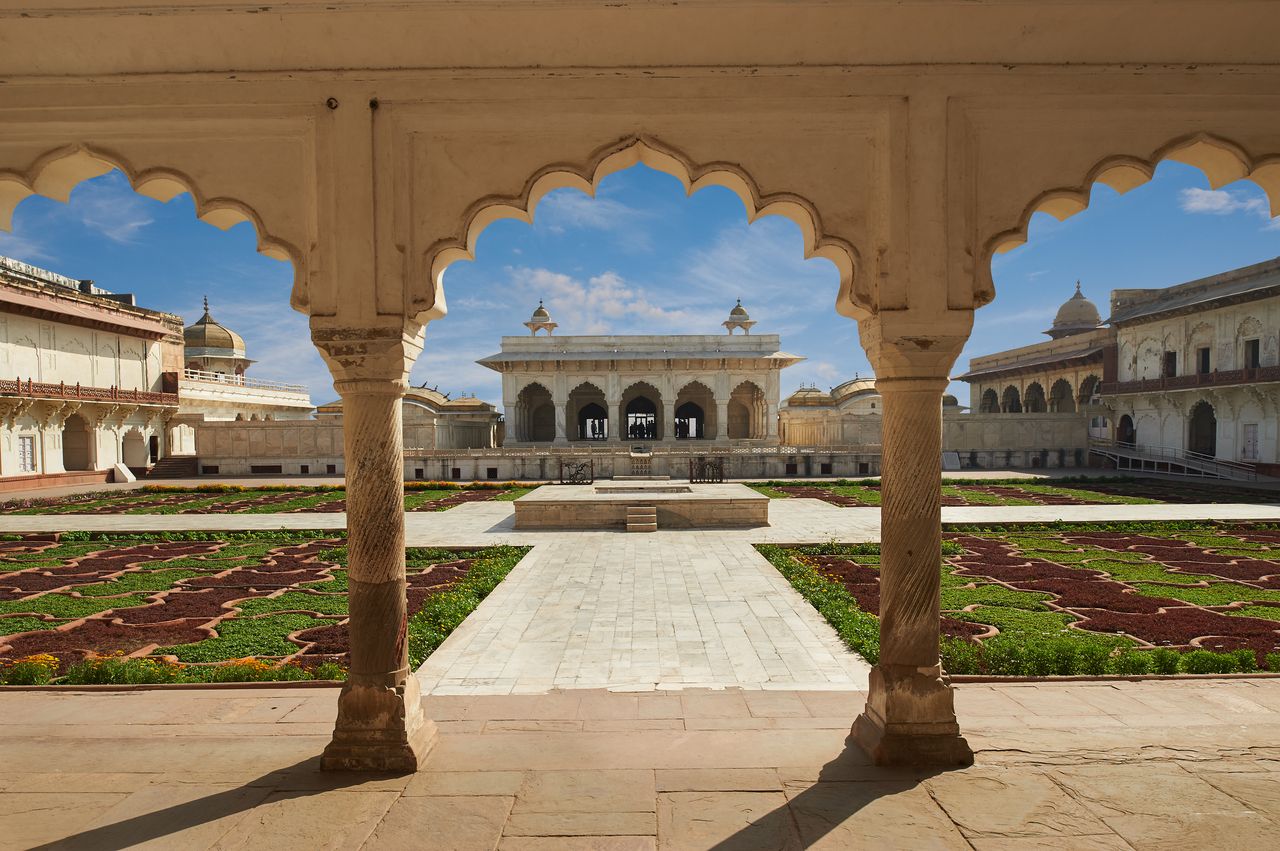
The Red Fort of Agra – A Vision in Stone
Diwan-i-Am and the large courtyard The Macchi Bhavan and Diwan-i-Khas Jahangiri Mahal
The Agra Fort is a masterpiece of medieval architecture, reminiscent of a great legacy. Its visually stunning marble and red sandstone palaces, mosques and pavilions reveal the incomparable aesthetic sentiment of the Mughals and the architectural representations of their royal life, art and culture.
All the historical forts around the world are filled with stories and memories that give life to the stones that make up their physical structure. The Agra Fort in India holds this type of history behind its doors, in its walls, and all the way down to its firm foundations. In order to understand the architectural aesthetics of this fort, an exploration of its history helps. A millennium ago, the Agra Fort had a different name. It was attacked and occupied in 1080 by the ruling governor of Hind, Mahmud Shah, according to the historical writings of the 11th century poet Salman.

Front view of the Red Fort in Agra and the main entrance. The gigantic red sandstone walls and ramparts of the fort were once equipped with canons and bow & arrows © isaray / Shutterstock
Time passed and the Sultan of Delhi adopted Agra as his capital city from 1487 to 1517. It flourished as a center of culture and knowledge. Badalgarh Fort was built in eight years by order of Raja Badal Singh on the same plot of land. Sikandar Lodi’s death in December 1517 began a nine-year reign by his son, Ibrahim Lodi, who oversaw the addition of a palace from 1518 to 1526 on the same property.
The year they finished the palace, Babur invaded India and won many battles against Ibrahim Lodi in Panipat. The foreign army conquered and occupied the fort at Agra, killed the Raja of Gwalior, and imprisoned his family. Babur’s son, Humayun, took over as leader at the fort, laying claim to the treasures hidden behind its walls. A collection of rare and wondrous gems including the ‘Koh-i-Noor’ diamond fell into his possession. In 1527, Babur ordered the building of a three-story stepwell, or baoli. Visitors can still see it today. The fort changed hands again in 1540 when the Sur dynasty’s Sher Shah defeated Humayun at Bilgram, but he only held it for five years before it was attacked yet again.
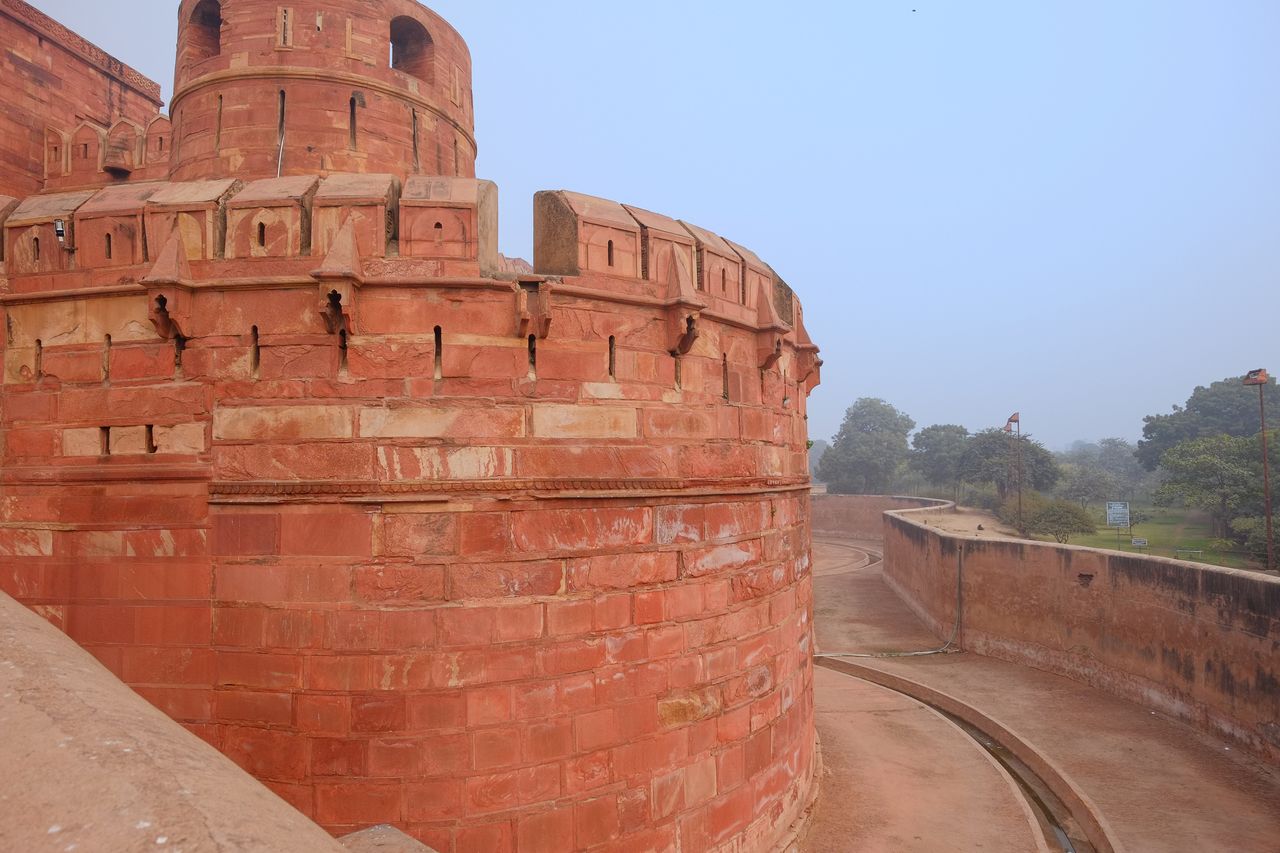
For over 200 years a 2km/1.9-mile-long moat surrounding the fort safe- guarded it from hostile invasions © Julian52000 / Shutterstock
In 1556 the Mughal army came to the region to wage a second battle. Iskandar Khan successfully held the fort until Akbar arrived in 1558. He then transformed the occupied fort into the Mughal Empire’s capital city and the Dar’ul Khilafat. To fully stake his claim, he also changed the name of the city to Akbarabad. For almost 100 years, this new capital was free from battles and bloodshed. It flourished and grew throughout the medieval period to become a grand power in that part of the world.
Its long and embattled past left its scars on the buildings so Akbar orchestrated a complete tear-down of the Badalgarh Fort in 1565. The overseer of buildings, Muhammad Qasim Khan, planned and supervised the design and construction of a new fort in the same location. Artisans and architects from faraway places like Bengal and Gujarat came to help with the design and fulfill Akbar’s vision. For eight years 3000 builders, masons, and laborers toiled to bring it to fruition. Within the fortress walls, a collection of palaces, residences, mosques, gardens, pavilions, and hammams were built. They worked with dressed red sandstone, an unusual choice as it had never been used in such a massive architectural landmark project before. The culmination of this massive project resulted in an unsurpassed masterpiece of Mughal architecture.
Akbar wanted an imposing fortress to be the crowning glory of his world, but he also appreciated the beauty of the artistic styles and accents that were popular in the culture of the day. While battlements, embrasures and string-courses pointed to majesty and strength, the inclusion of Islamic geometry, calligraphy and the favorite flowers, birds, and beasts of Hindu aesthetics produced a truly unique and glorious example of architectural excellence.
Fort Agra is surrounded by an impregnable double wall constructed of red sandstone. It runs almost straight along the Yamuna River and continues for 2.4km/1.5 miles in a semi-circular shape around the fort. The outer wall is lower than the inner wall and both are fortified with crenulated battlements. Both walls have double ramparts interspaced with massive round bastions, all aligned with one another. The perimeter walls have a height of 21m/69ft and has only been breached once by the English at the time of the 1857 Indian Rebellion. A 10m/33ft deep moat, 9m/30ft across lends extra protection against enemy invasions.
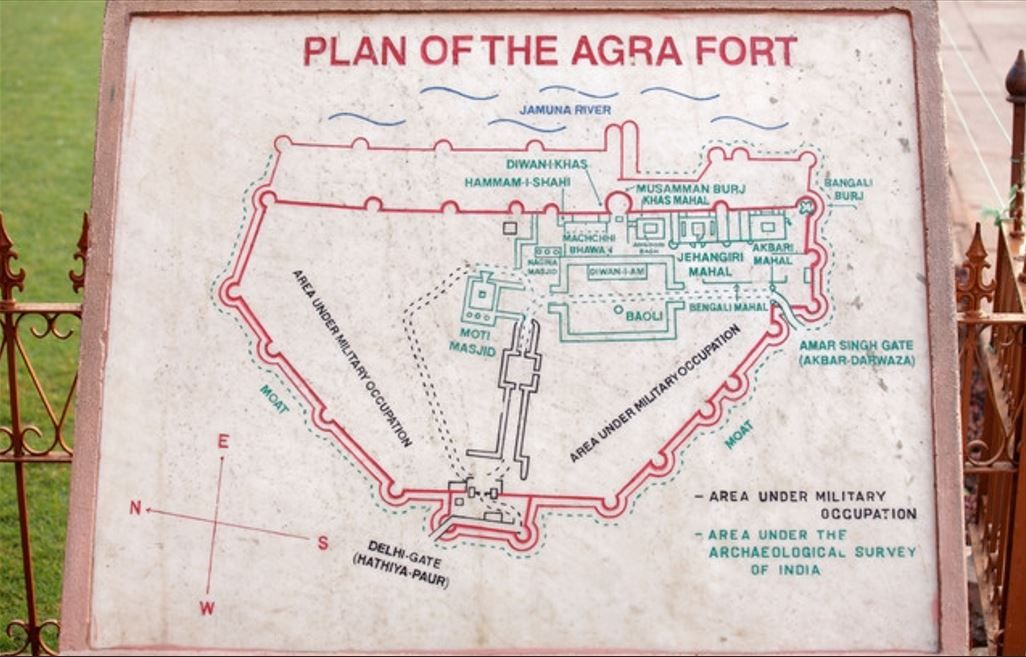
A plan of the crescent shaped Red Fort of Agra
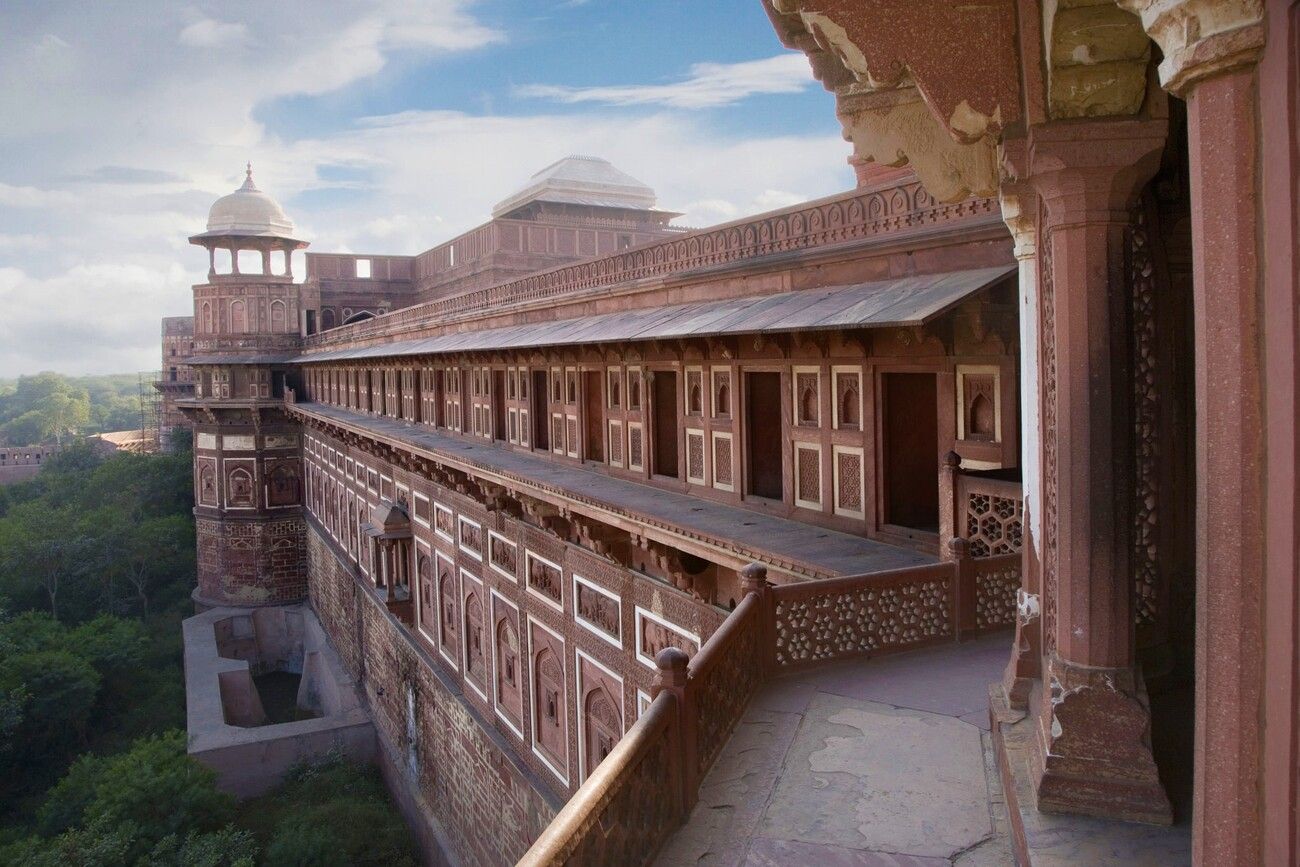
The eastern wall that runs almost in a straight line along the Yamuna River. The river was once the natural barrier of the fort, guarding it from enemy invasion on the east side © Don Mammoser / Shutterstock
There are four entrance gates leading into the Red Fort, namely the Amar Singh to the south, the Delhi Gate to the west, the Jal Darwaza on the east side facing the river, and the Darshani Gate to the north. Of these only the latter is used today as the main entrance into the fort.Of the structures that remained in a fairly good condition since the time of Akbar are the Akbari and Jahangiri Mahals, formerly the Bengal Mahal (1568 to 1569), the southern Amar Singh Gate (1568 to 1569) and the west facing Delhi Gate (1568 to1569). These buildings give a good indication of the high architectural and aesthetic standards of its creator, Akbar.
Both the Amar Singh and Delhi Gates have additional fortifications like raised walls, strong bastions, trapping points and crooked entrances to confuse and keep out possible invaders. These features also provided extra safety for the soldiers who were firing at the attackers. Because of the fort’s almost impregnable fortifications, the Moghuls felt safe and secure enough to keep their valuable treasures stored in the underground vaults.
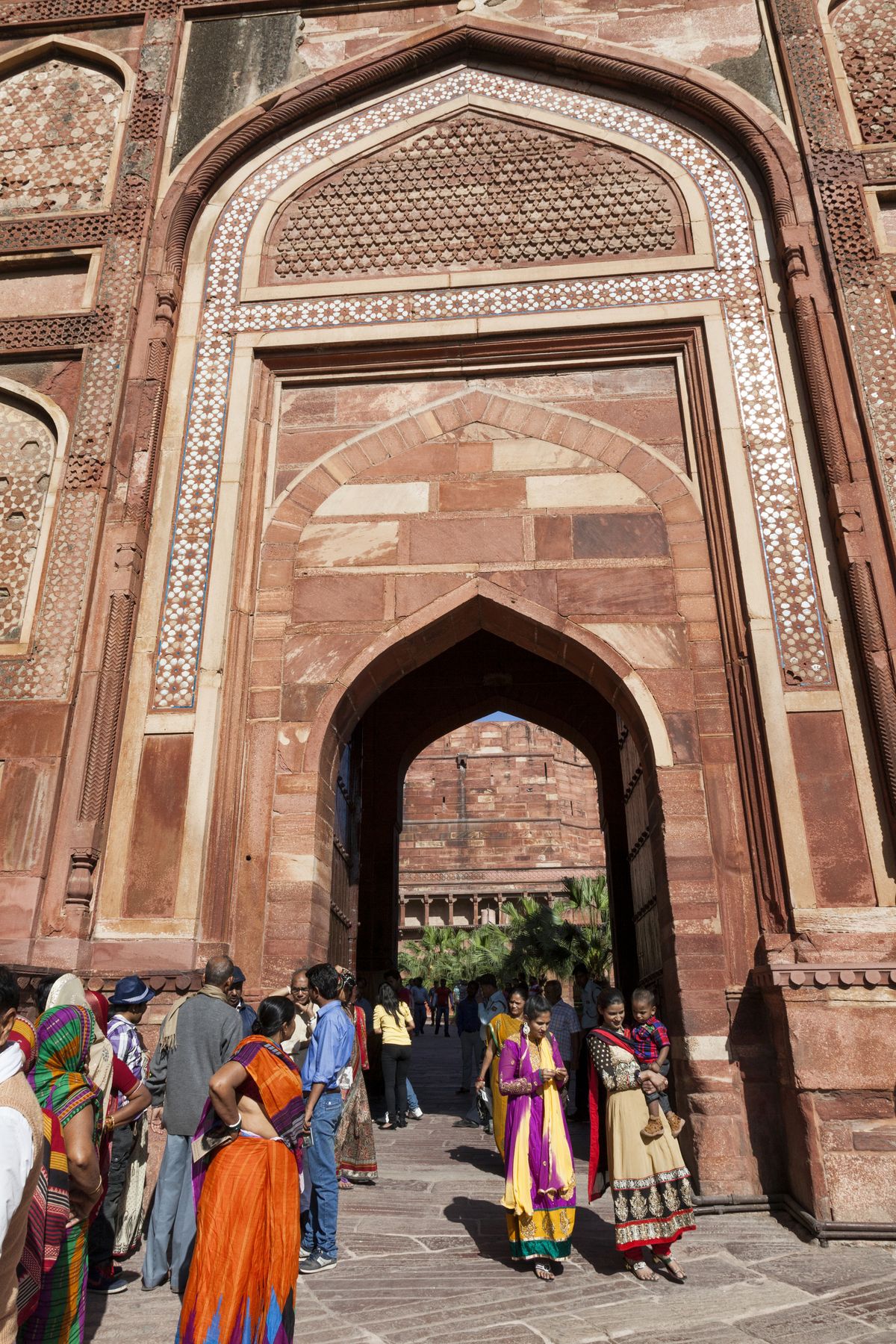
The second grand entrance gate to Agra Fort. One can see the beautiful fusion of white marble and red sandstone © powerofforeever
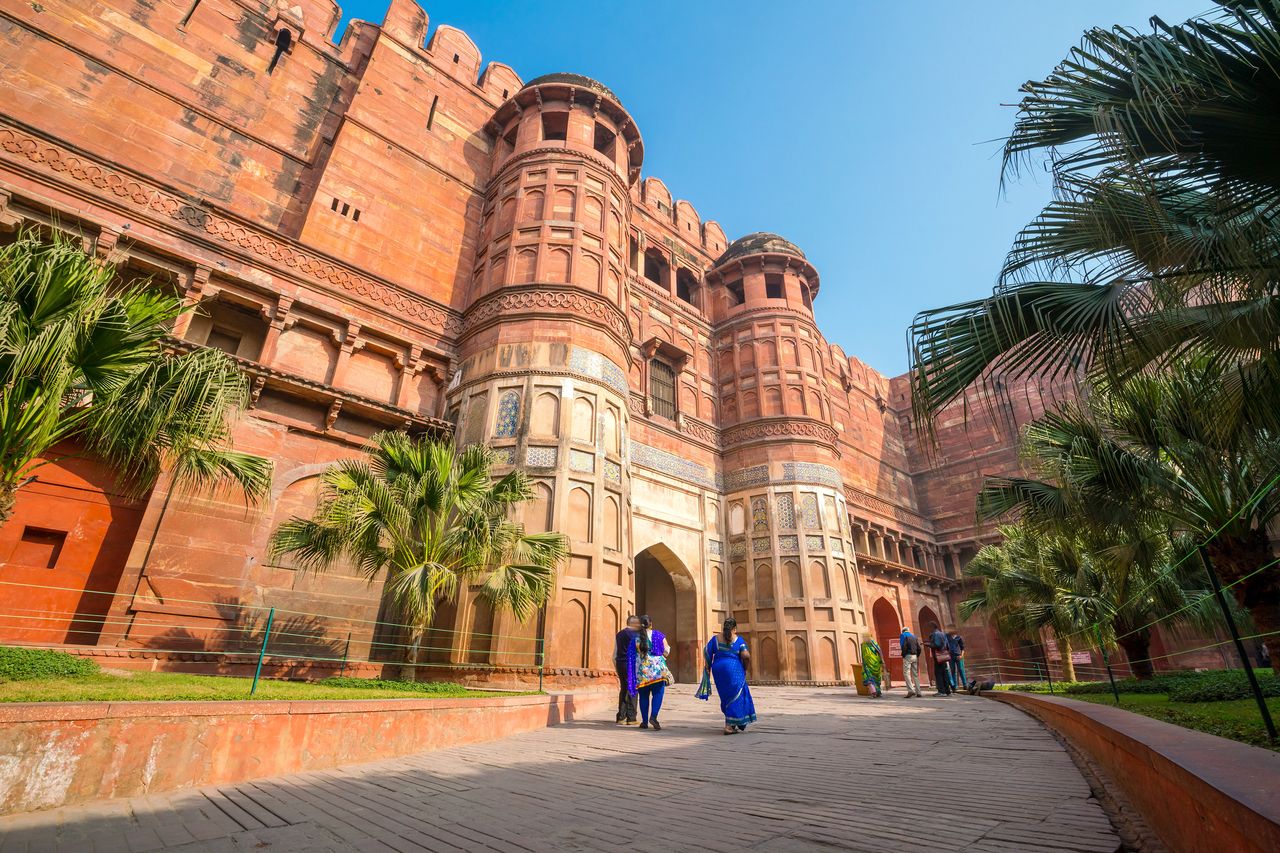
The third of the impressive, grand entrance gates into the Red Fort in Agra © f11photo / Shutterstock
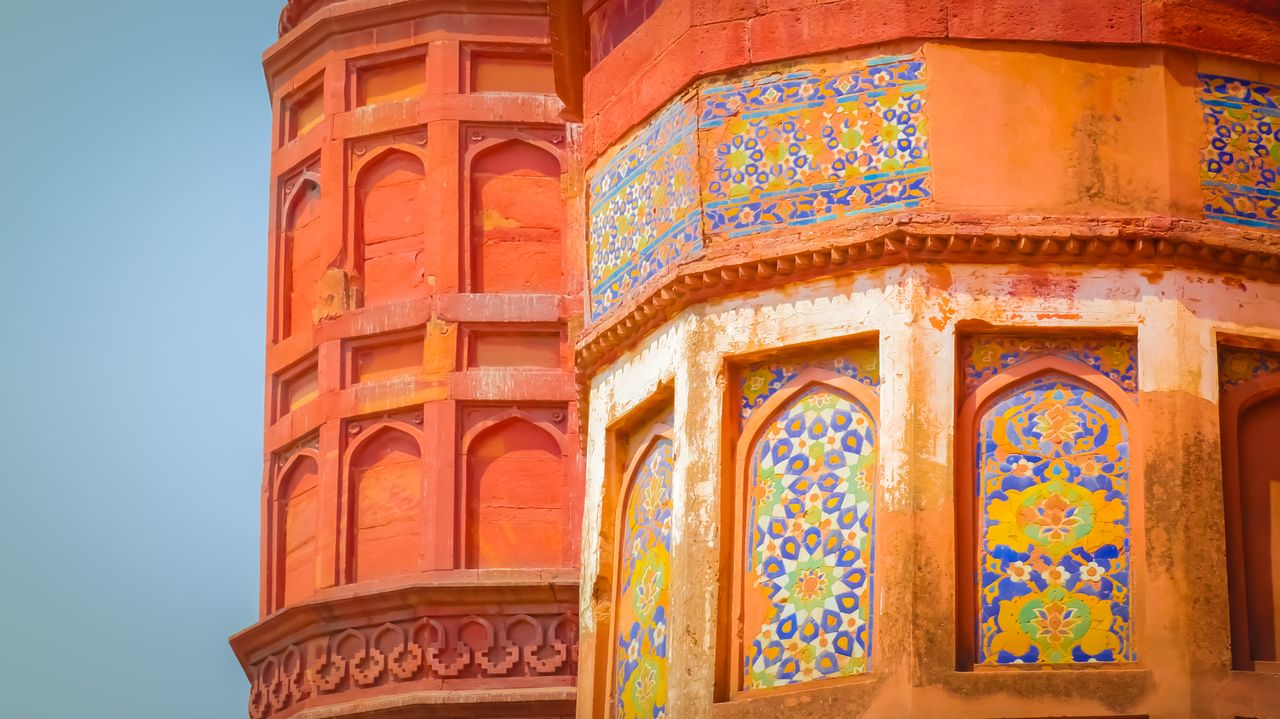
The third entrance to Fort Agra still has its original colorful 16th century ceramic tiles decorating the red sandstone towers © Vivvi Smak / Shutterstock
In 1565 Akbar started the construction of the Jahangiri Mahal as a private residence for his son Jahangiri, incorporating parts of the former Ibrahim Lodi Palace built in 1518. These parts form the east and northeast sections of the large new palace and can easily be distinguished by their exceptional aesthetic standards and building techniques.
In 1605 after the death of his father, Jahangiri became ruler of the empire. Although he spent more time in Kashmir and Lahore, he paid regular visits to Agra, staying in the Red Fort on these occasions.
In 1628 Shah Jahan, third son of Jahangiri, became the next Mughal Emperor and promptly started to replace most of Akbar’s structures in the Red Fort with his own marble creations. Most important amongst these are the Nagina and Mina Masjids, the octagonal Jasmine Tower, also known as the Musamman Burj, and the Audience Hall or Diwan-i-Aam, all constructed between 1631 and 1640.
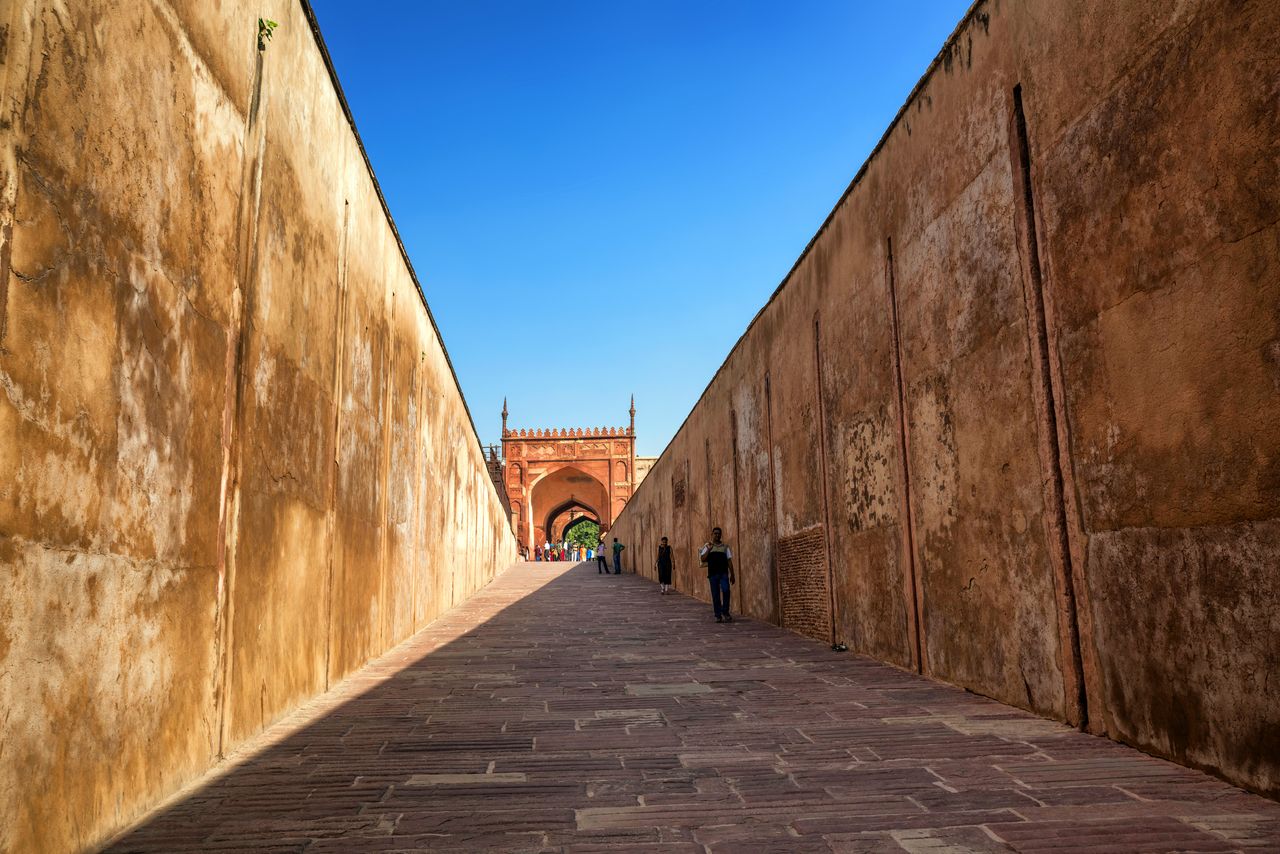
The royal courtyard in Fort Agra is reached by walking up a slightly inclining ramp flanked by high walls © Images of India / Shutterstock
Diwan-i-Am and the large courtyard
The Amar Singh Gate, previously reserved for use by the emperor and his entourage exclusively, is now the main entrance to the fort. It consists of three different gates, built close together but at right angles to cause confusion amongst invaders and prevent them from using their weapons in the tight space. A gently ascending ramp between high walls leads to another gate which opens onto the large inner courtyard with trees lining the lawns. A three-sided portico commissioned by Shah Jahan in 1628 to replace a former wooden structure leads to the imposing Audience Hall or Diwan-i-Aam. The perfect proportions of the hall with its columns supporting engraved arches allow an uninterrupted view of the raised throne on which the emperor sat to listen to petitions. In days of old the hall would have been elegantly furnished with rugs, satin canopies and rich brocade. The Diwan-i-Aam was also the venue for the Nauroz Festival held during Mughal times with great pizazz and fervor. Persian and Gujarat gold cloth, European umbrellas and drapes, brocades from China and Constantinople, and brocaded velvet lent grandeur to the interior during the festivities.
The ornate throne, built to house a gemstone-encrusted Peacock Throne seat, was eventually brought to Delhi to be plundered by Nadir Shah and later ended up in Tehran, Iran. The throne room was decorated with three-winged arches, recessed niches and inlaid marble, and was connected to the royal chambers. Perforated marble windows on both sides (right and left) of the throne room allowed the royal ladies to observe the events at Diwan-i-Aam from the privacy of their chambers. At that time, the throne chamber was known as the Throne Room or Nasheman-e-Zill-e-ilahi or Jharoka-e-Daulat Khana. In front of the niche, was the baithak, a small marble table where the ministers sat down to receive requests and orders. Here, too, trials took place and justice was swiftly served and executed.
The area north of the Diwan-i-Aam courtyard is closed to visitors, although the delicate white marble domes and chhatris of the striking, if rather clumsy Moti Masjid or Pearl Mosque can be seen protruding above the courtyard walls. Just outside Diwan-i-Aam, an inappropriately gothic Christian tomb marks the grave of John Russell Colvin, Lieutenant Governor of the Northwestern Provinces, who died here during the 1857 uprising when Agra’s British population barricaded themselves inside the fort.
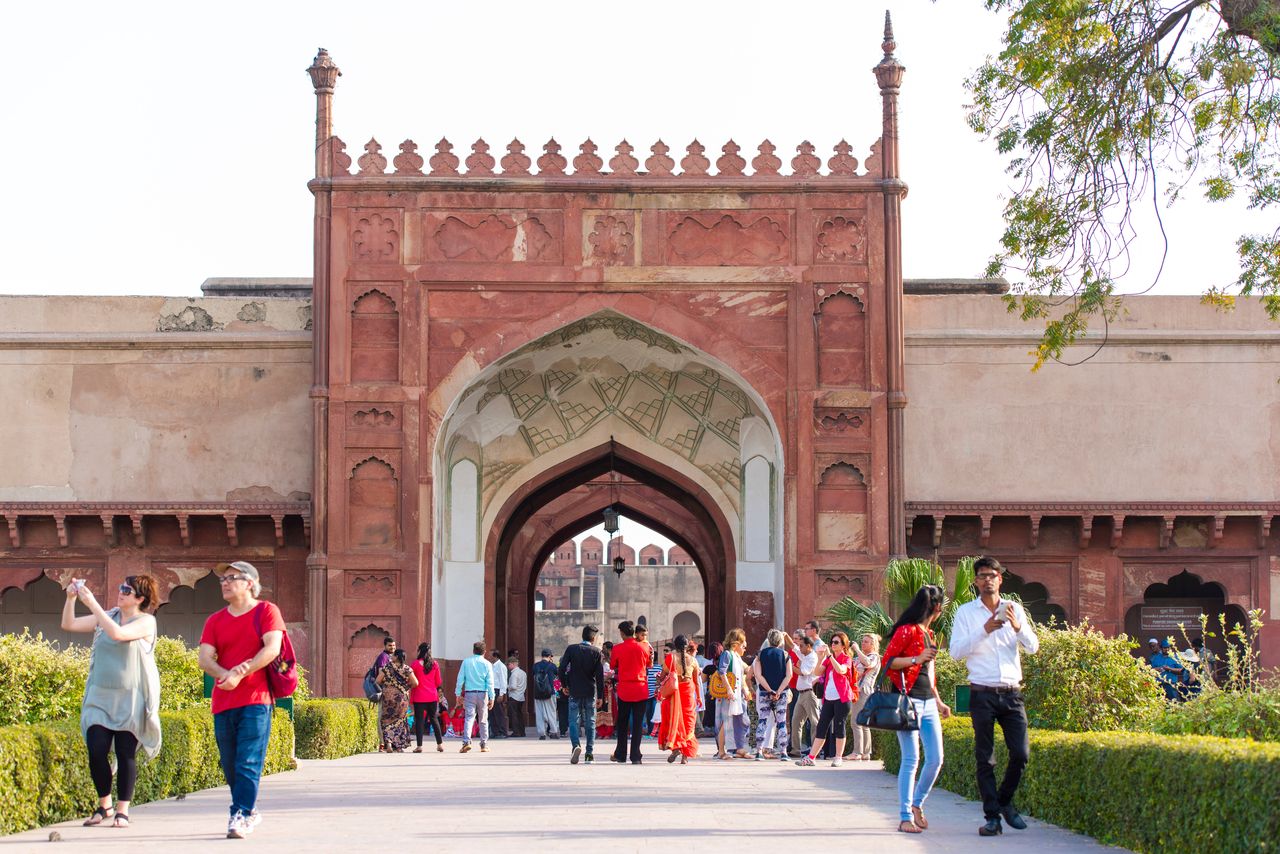
After going through the three grand entrances, the fourth one brings you to the inner complex of the Red Fort of Agra. Visitors are always astounded by the massive size of the fort complex © Savvapanf Photo / Shutterstock
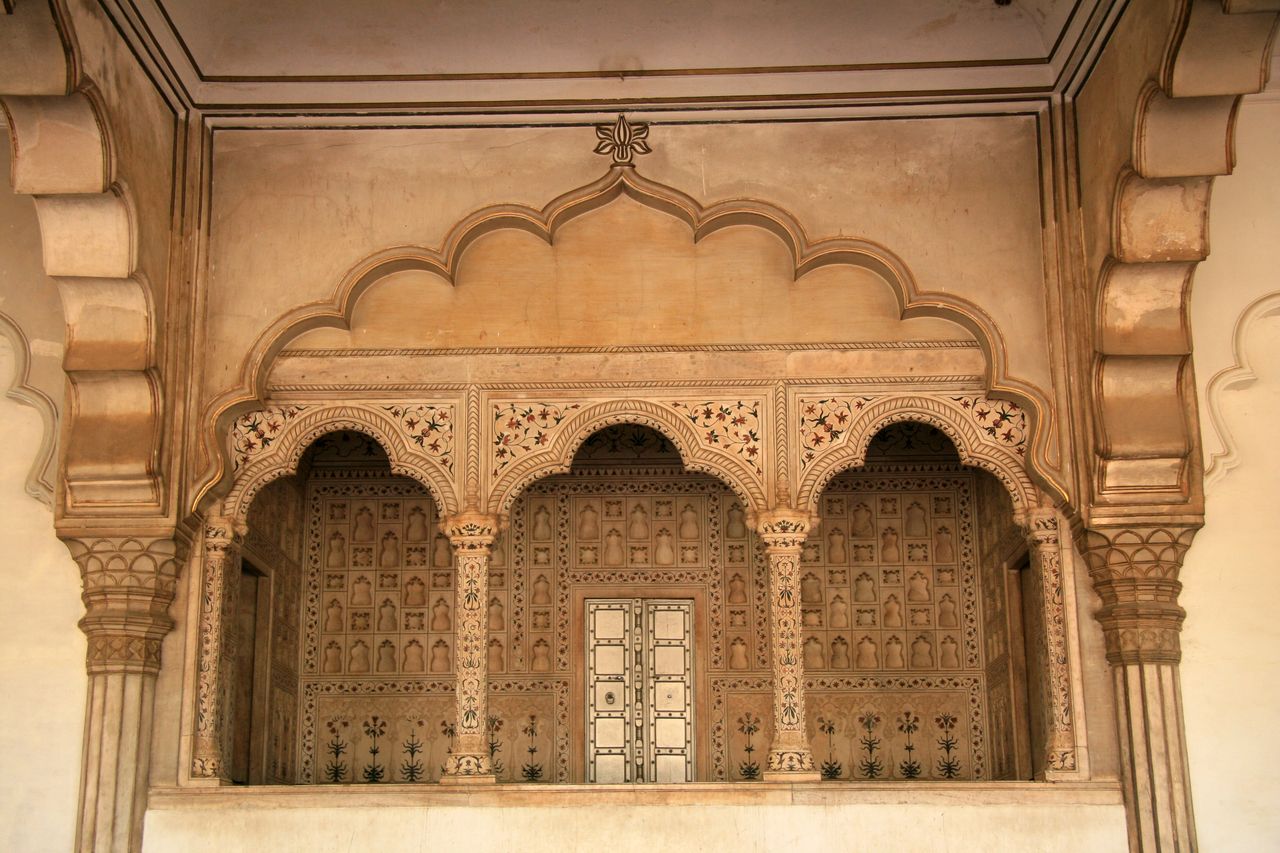
The Peacock Throne in the Public Audience Hall (Diwan-i-Aam in Persian). This is where the Mughal Emperors sat to address the general public to listen to their grievances. Today the famous throne is still adorned with its original semi-precious stones inlaid in white marble
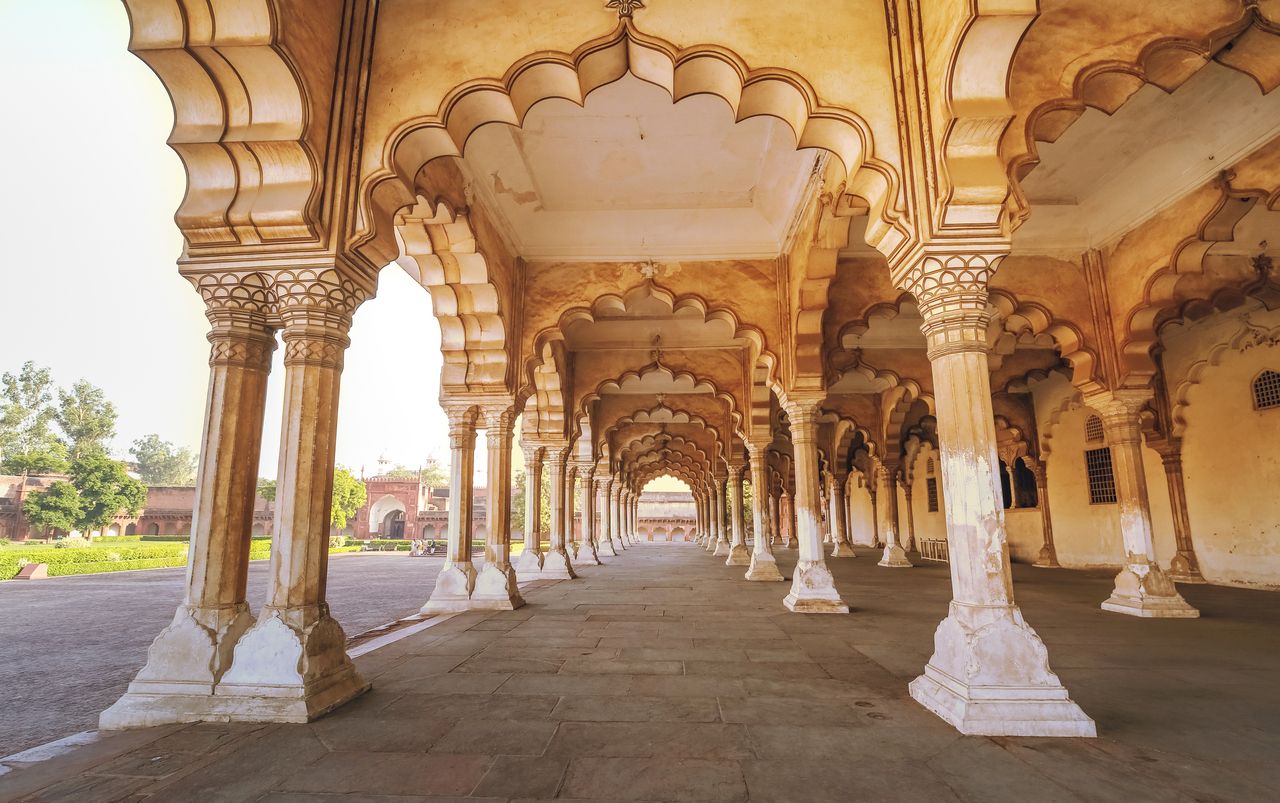
Exterior view of the Diwan-i-Aam with double column architecture. Public meetings were held here by the Mughal Emperors, Agra Fort
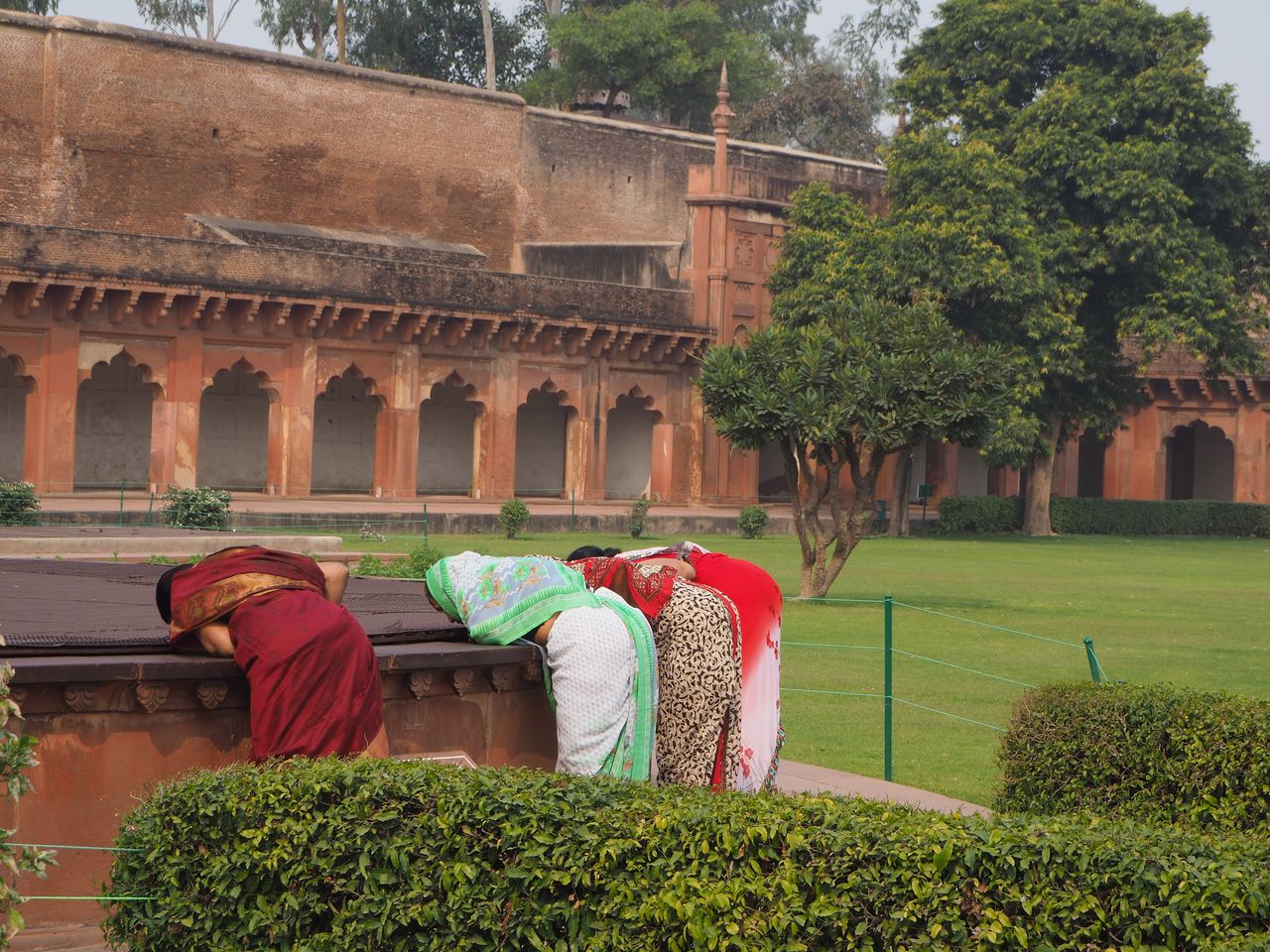
Local visitors try to peer down an ancient well at the Agra Fort. The well is covered for safety’s sake

A lady leans on a large ancient well with the white marble Moti Mosque in the background behind a red sandstone wall. This mosque inside the Red Fort Complex in Agra was used exclusively by the royal family members during Mughal times © Yurataranik / Dreamstime
The Macchi Bhavan and Diwan-i-Khas
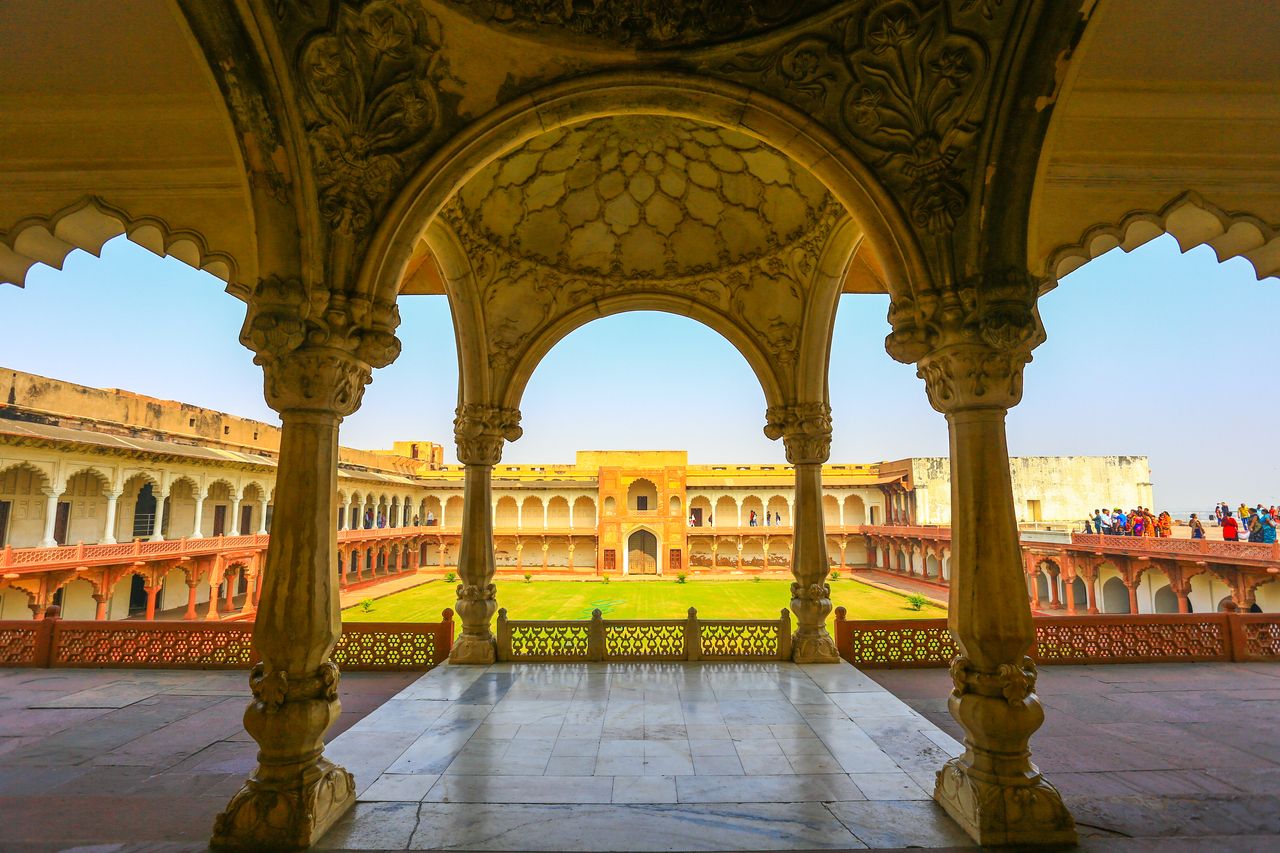
The so-called Fish Palace or Macchi Bhavan with its spacious courtyard once filled with bodies of water teeming with fish for the emperor’s entertainment © Club4Traveler

Divan-i-Khas or the Hall of Private Audience has arches with double columns. Here the Mughal Emperors held private meetings with their nobles and dignitaries from around the world © efired
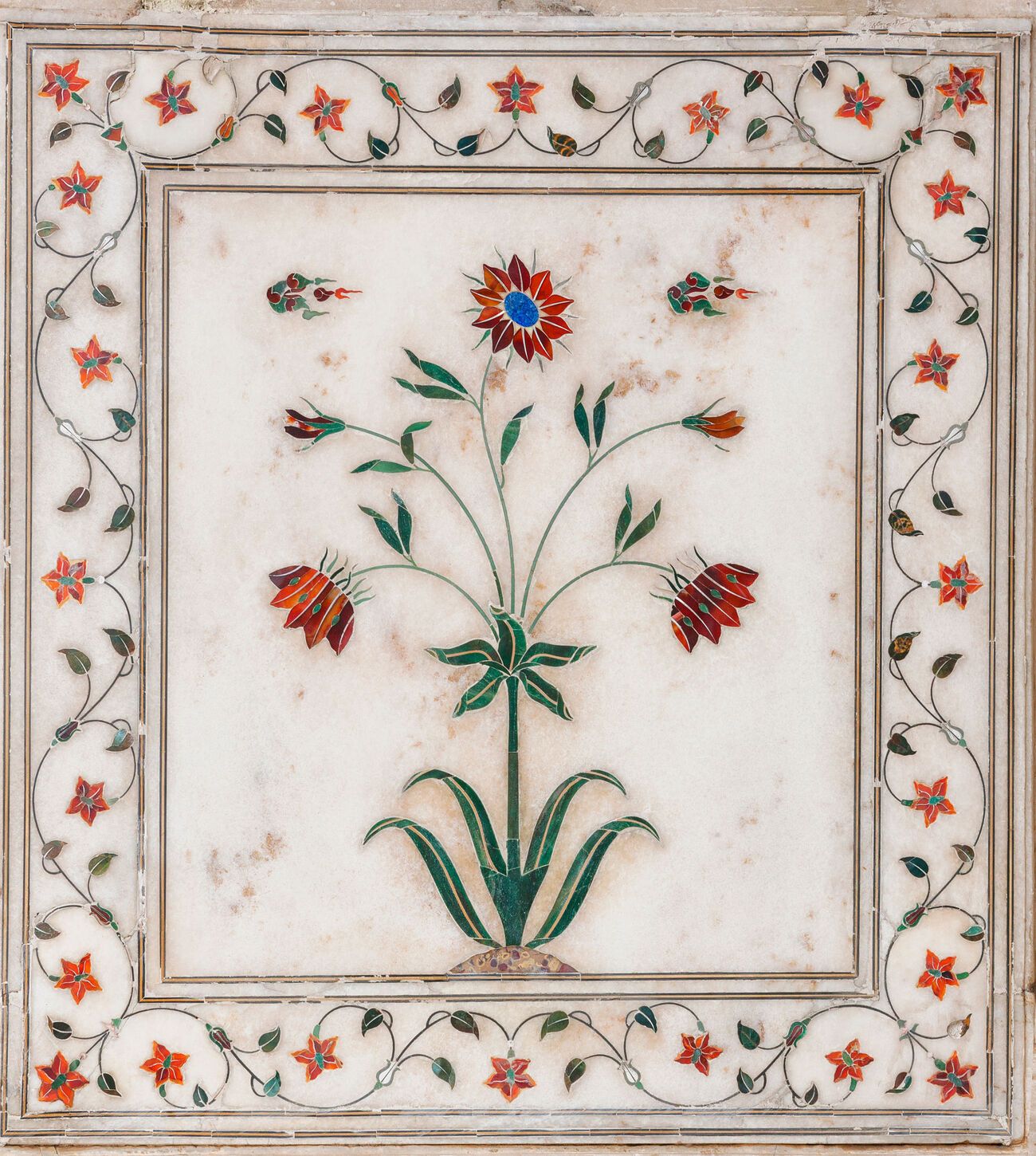
Delicate semi-precious stone inlay work and decoration on a marble column in the Private Audience Hall of Agra Fort. The same inlay work can be seen in the Taj Mahal © Powerofforever
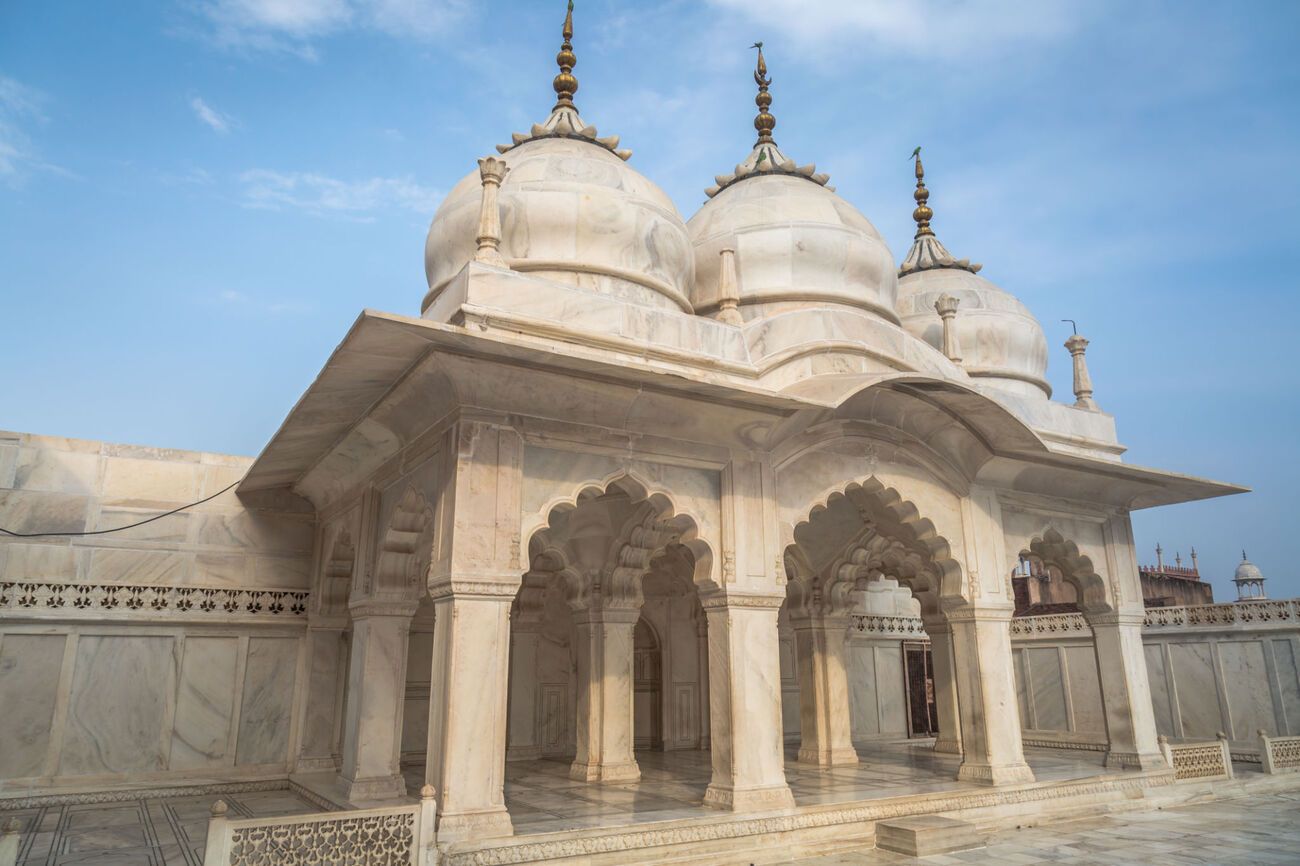
Nagina Mosque in Agra Fort. This mosque was built exclusively for the ladies of the royal family © Roop_Dey
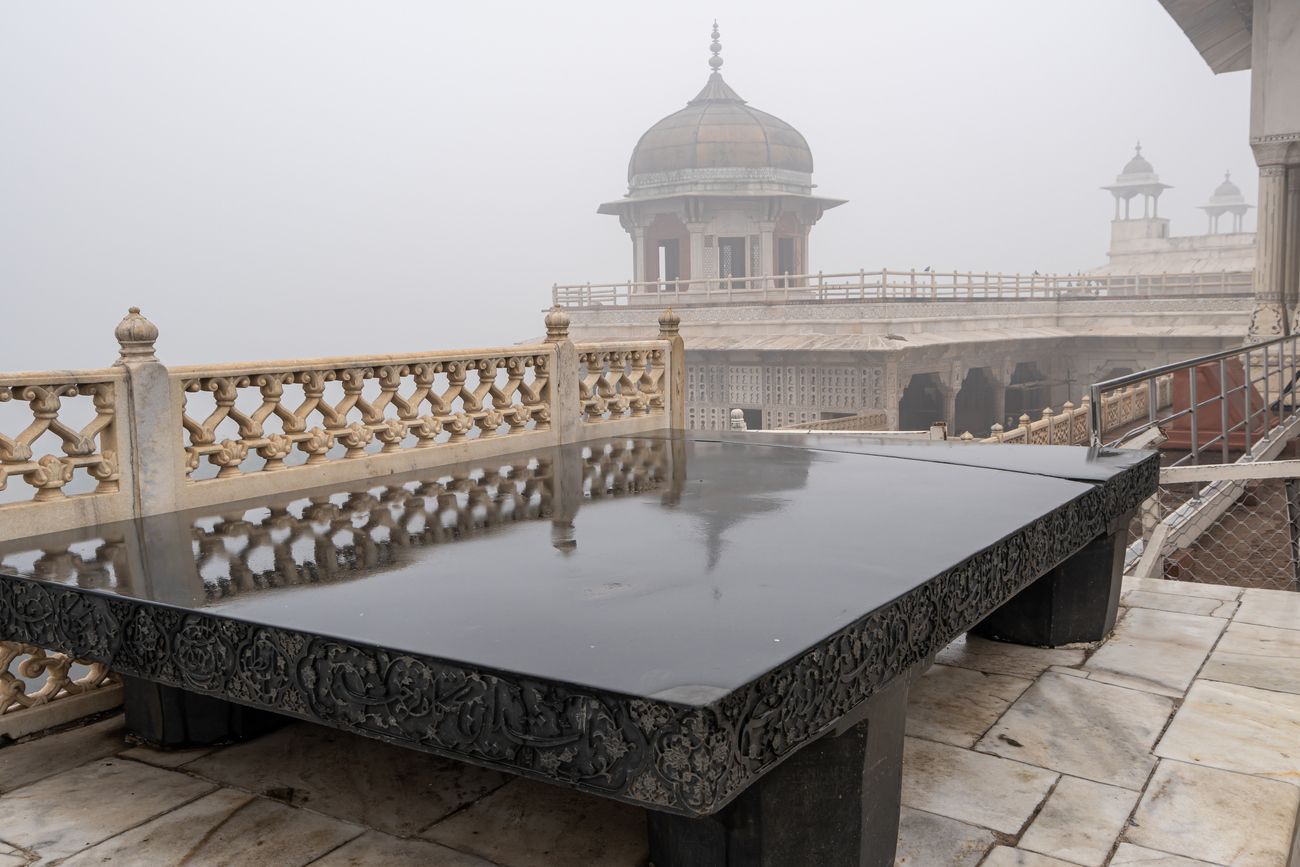
Takht-i-Jahangir, the throne of the Mughal Emperor Jahangir in Agra fort. The throne is made of rare black marble and Arabic verses from the Quran are inscribed around the throne
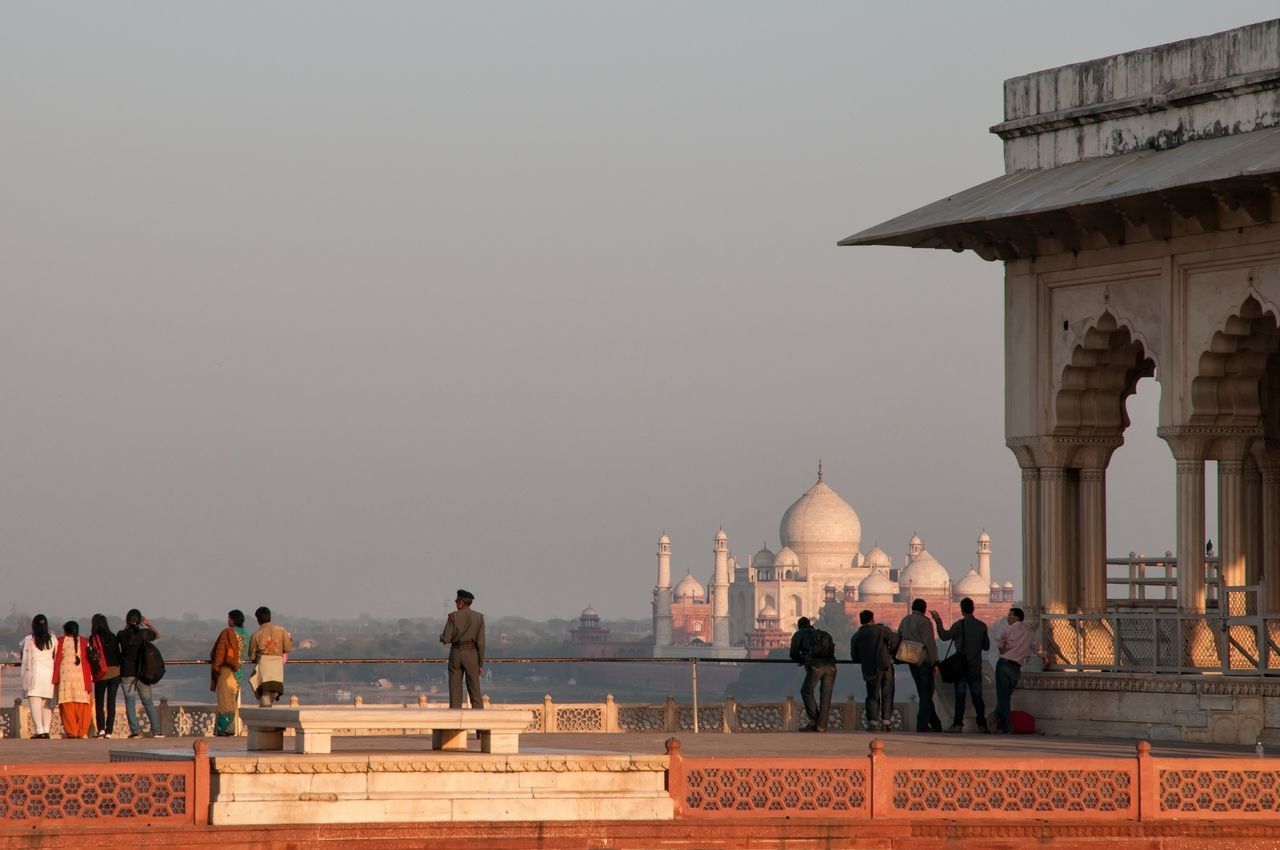
Opposite the black throne of the Emperor Jahangir one can see the white marble throne, which was meant for the princes of the Mughal family. On the right hand side is the pillared Diwan-i-Khas or Private Audience Hall. This platform offers a beautiful view of the Taj Mahal © Rolf_52 / Shutterstock
Overlooking the river, to benefit from the breeze cooled down by the water, to the right, a high terrace supports a number of roomy royal apartments. Amongst them is the beautifully decorated Hall of Audience, the Diwan-i-Khas, dating back to 1635, where the Mughal Emperor held audiences with visiting dignitaries, ambassadors and kings. It was adorned with peacock bows inlaid with jasper and lapis lazuli, and numerous marble columns.
Shah Jahan’s private palace, the Khas Mahal was built in 1636 and consists of three parts. Under the cleverly designed flat ceiling with its cavities to bring down the oppressive summer temperature in the rooms, the emperor could relax in comfort looking out onto the garden and soothing river below. His Royal Bed Chamber or Aramgah-e-Muqaddas as described by Hamid Lahauri, is considered one of Shah Jahan’s architectural masterpieces. Flanking the royal palace are two Golden Pavilions, so called for the gold tiles that once covered the curved roofs. Curved roofs later became an essential feature of Rajput architecture and was inspired by the shape of the thatched roofs of Bengali huts. The original purpose of the pavilions is not clear but they are rumoured to have belonged to the shah’s two daughters, Jahan Ara Begum and Roshan Ara Begum.
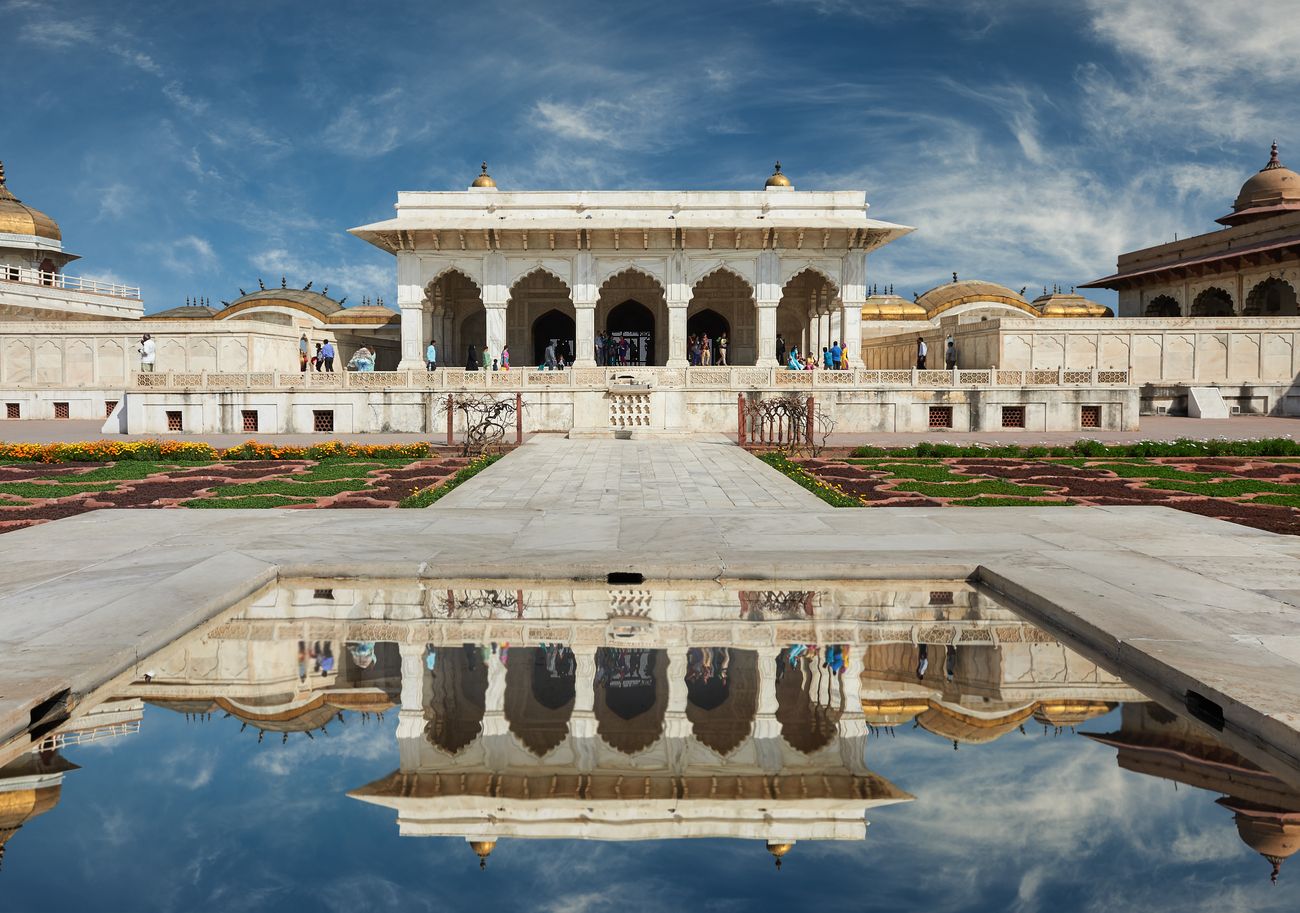
Reflection of the Marble Palace in the ornamental pool. The Khas Mahal served as the private chambers of the Mughal Emperor and is seen here with the Charbagh style garden © Yurataranik / Dreamstime
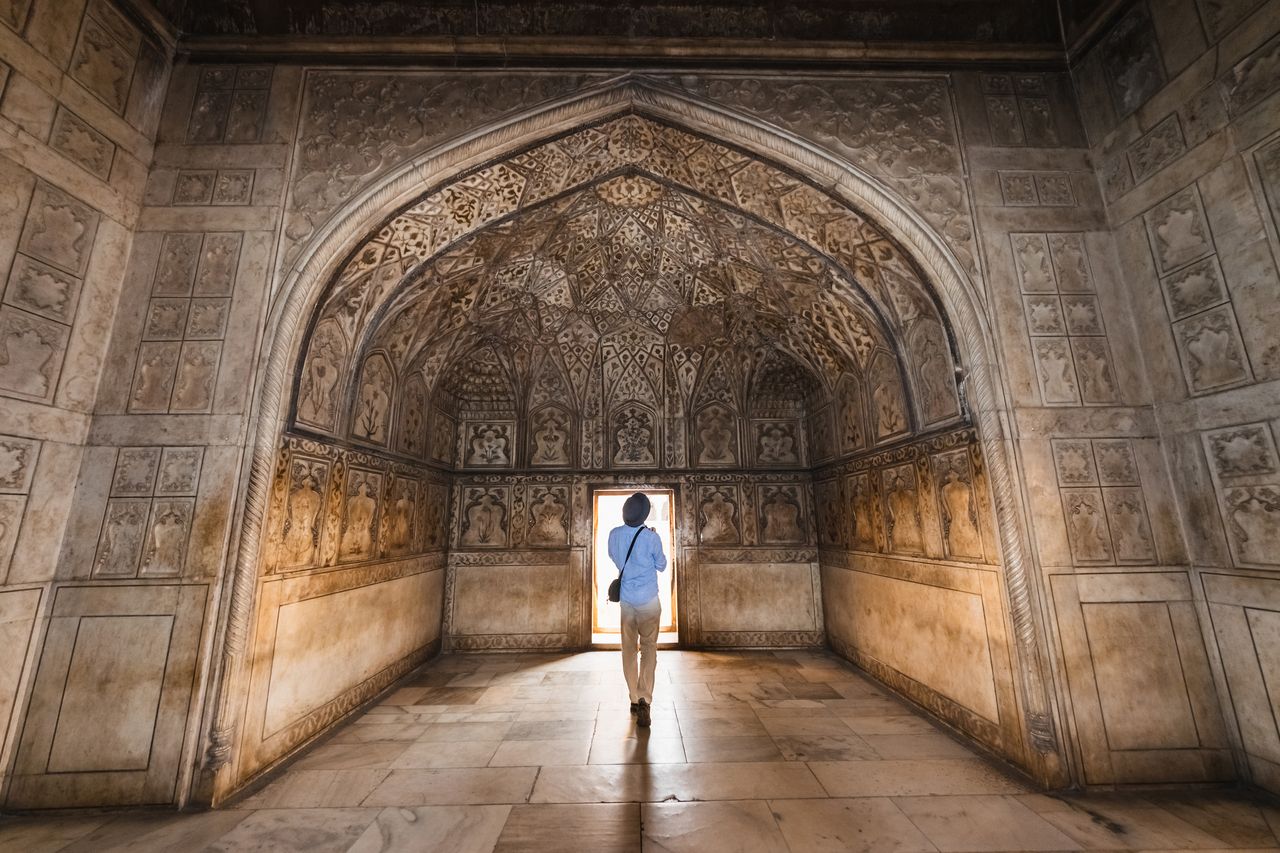
A tourist at the Khas Mahal or Private Chambers of the Emperor admiring one of the few remaining wall paintings © Pamela Loreto Perez
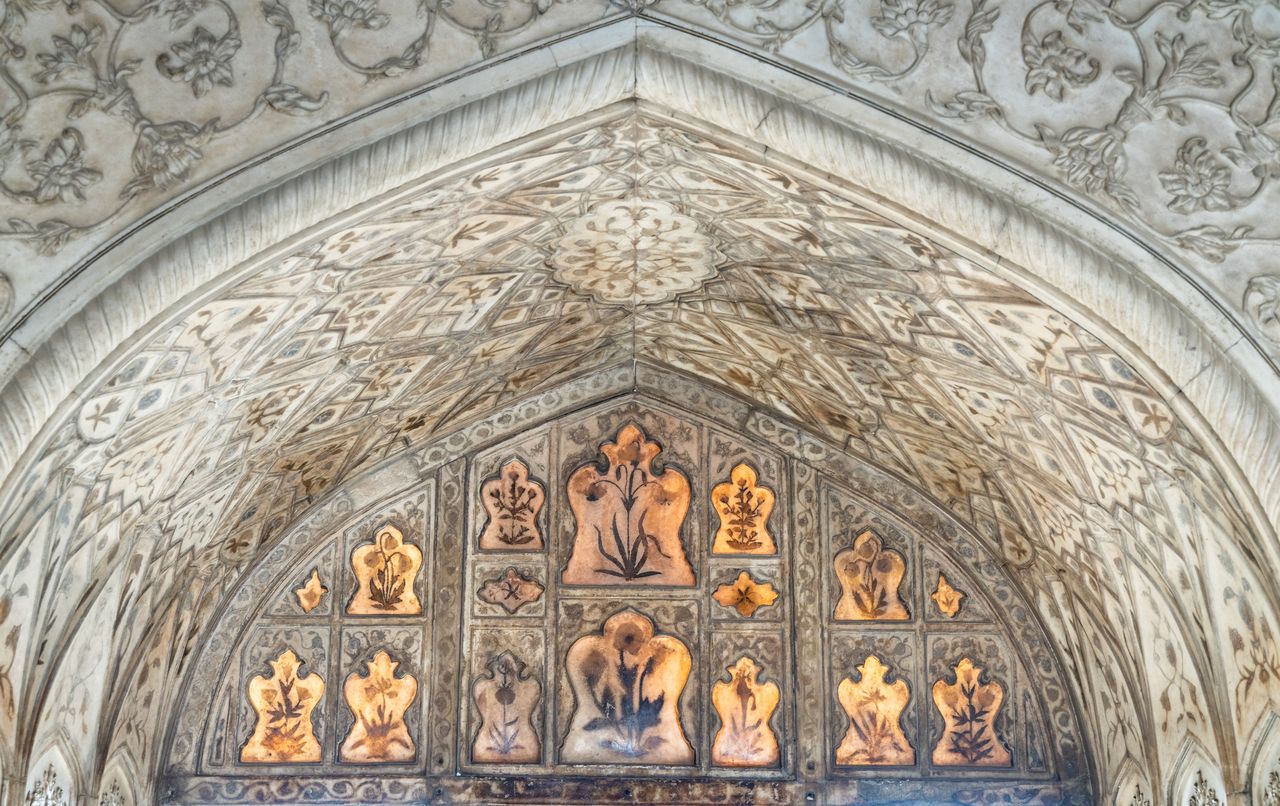
This panel in the marble palace of the emperor is deliberately made of thin slabs of marble so that it remains translucent. The decorations on the panel which remained since ancient times start glowing when sunlight falls on it. It is a true architectural marvel © Kevin Standage
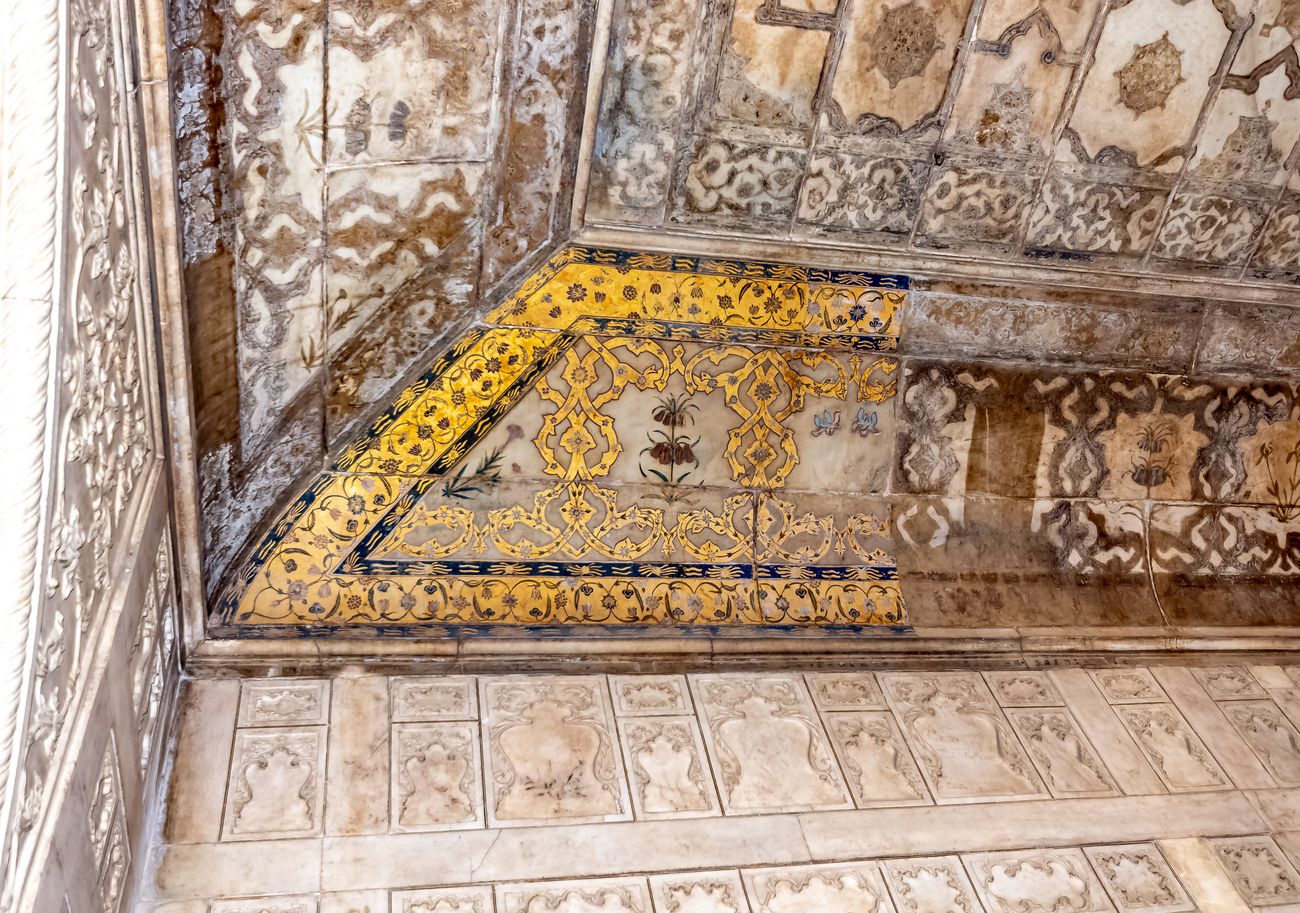
This gold painted decoration in the private chamber of the emperor has been restored by the Archaeological Survey of India to show visitors the former glory of the palace when the interior walls of the entire palace were painted in gold © Marcin
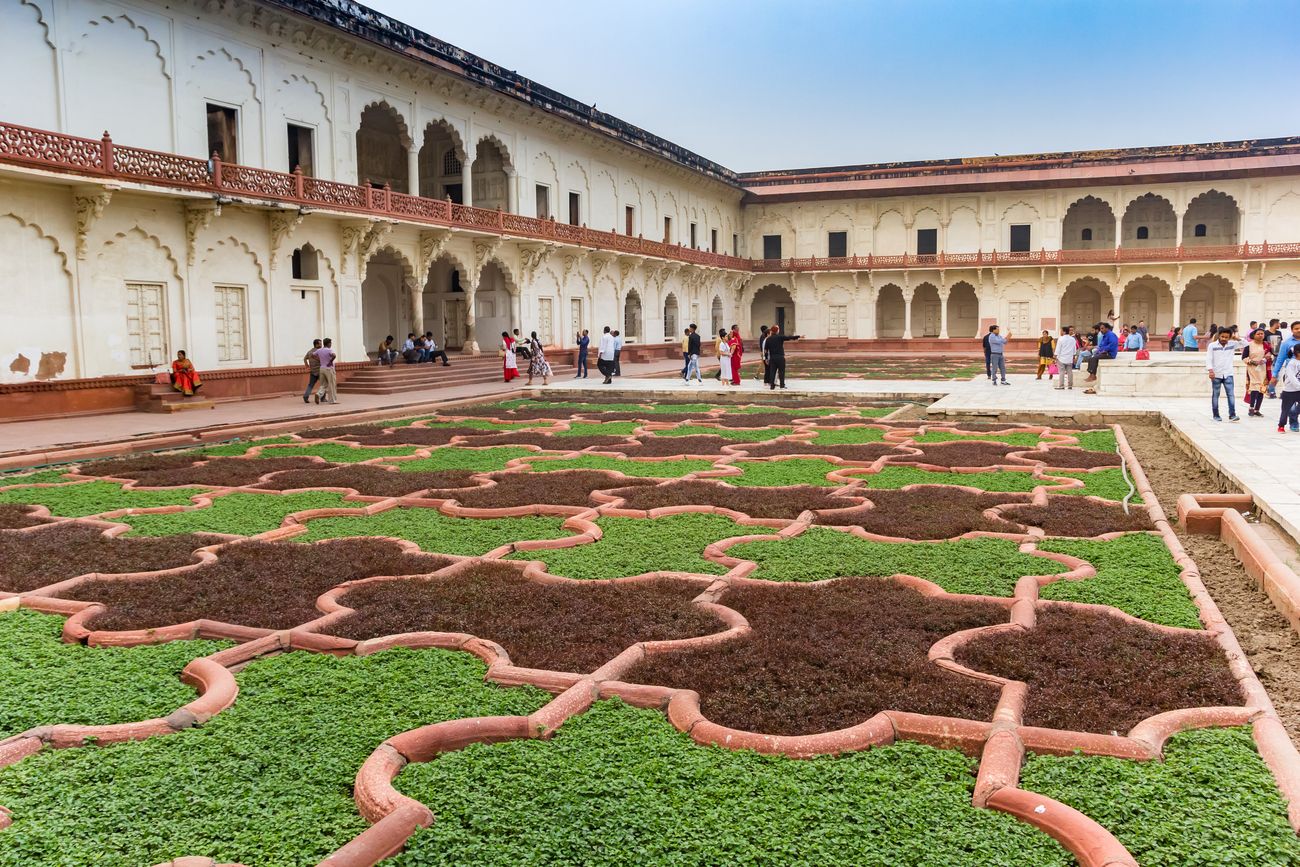
The Anguri Bagh gardens surrounded by living quarters in the Marble Palace in the Red Fort. These garden were once filled with Indian grapevines used for making wine during the Mughal period © Venemama
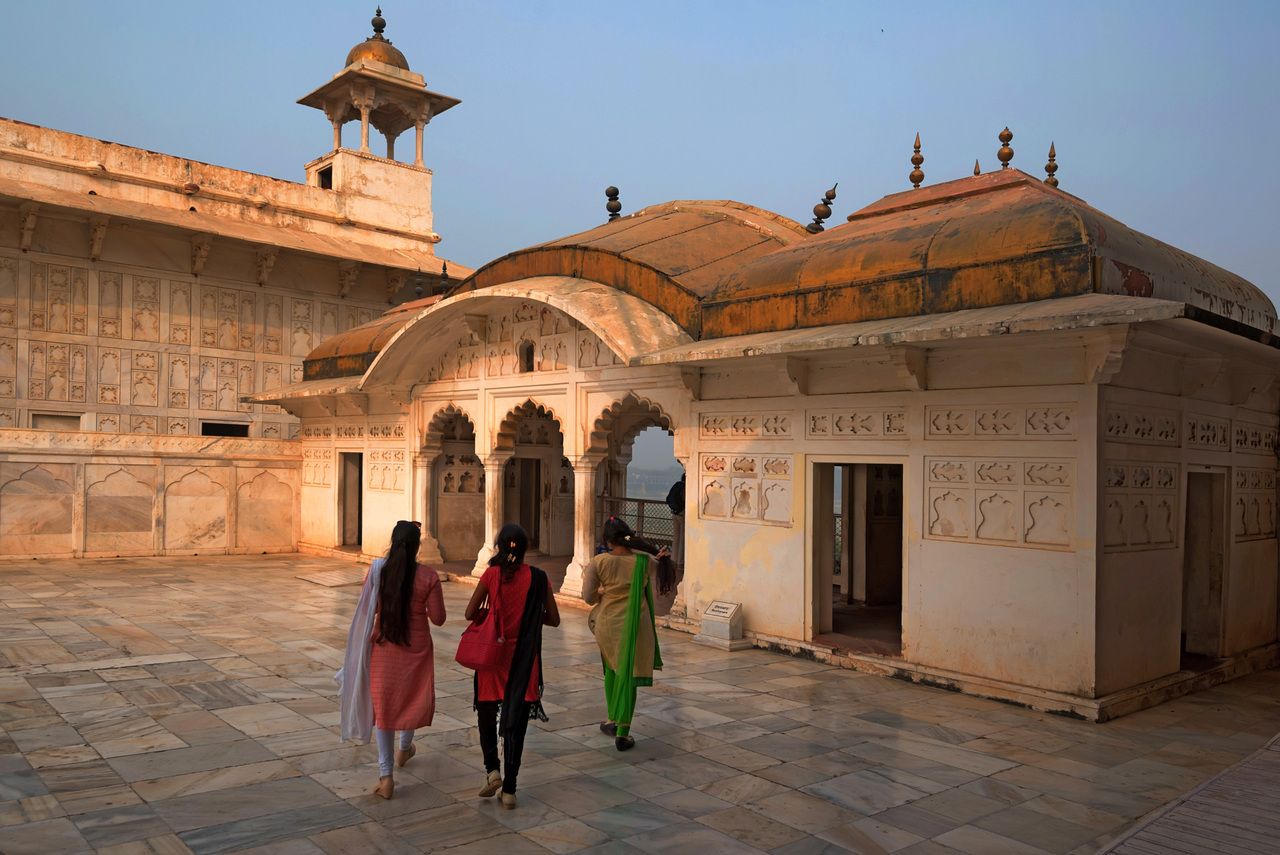
Golden roofed palanquin shaped pavilions can be found on both sides of the Khas Mahal, the Sleeping Chambers of the King. These pavilions were the living quarters of the two favorite daughters of Emperor Shah Jahan © Yakov Oskanov
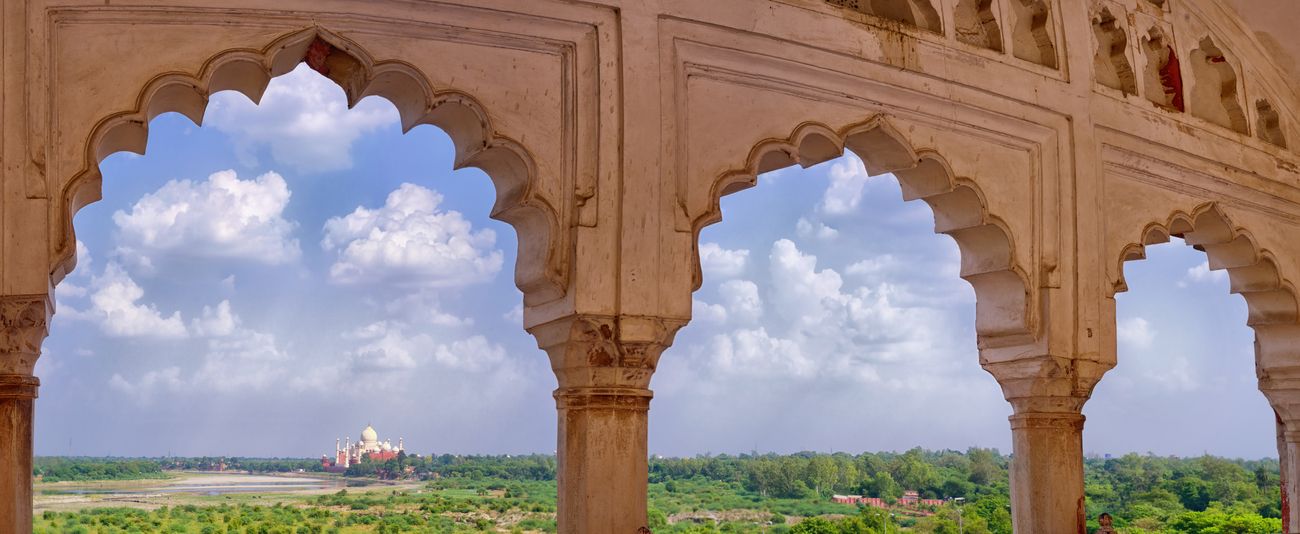
The Taj Mahal in the distance is framed by one of the arches of the palanquin shaped Golden Pavilion © Belikova Oksana
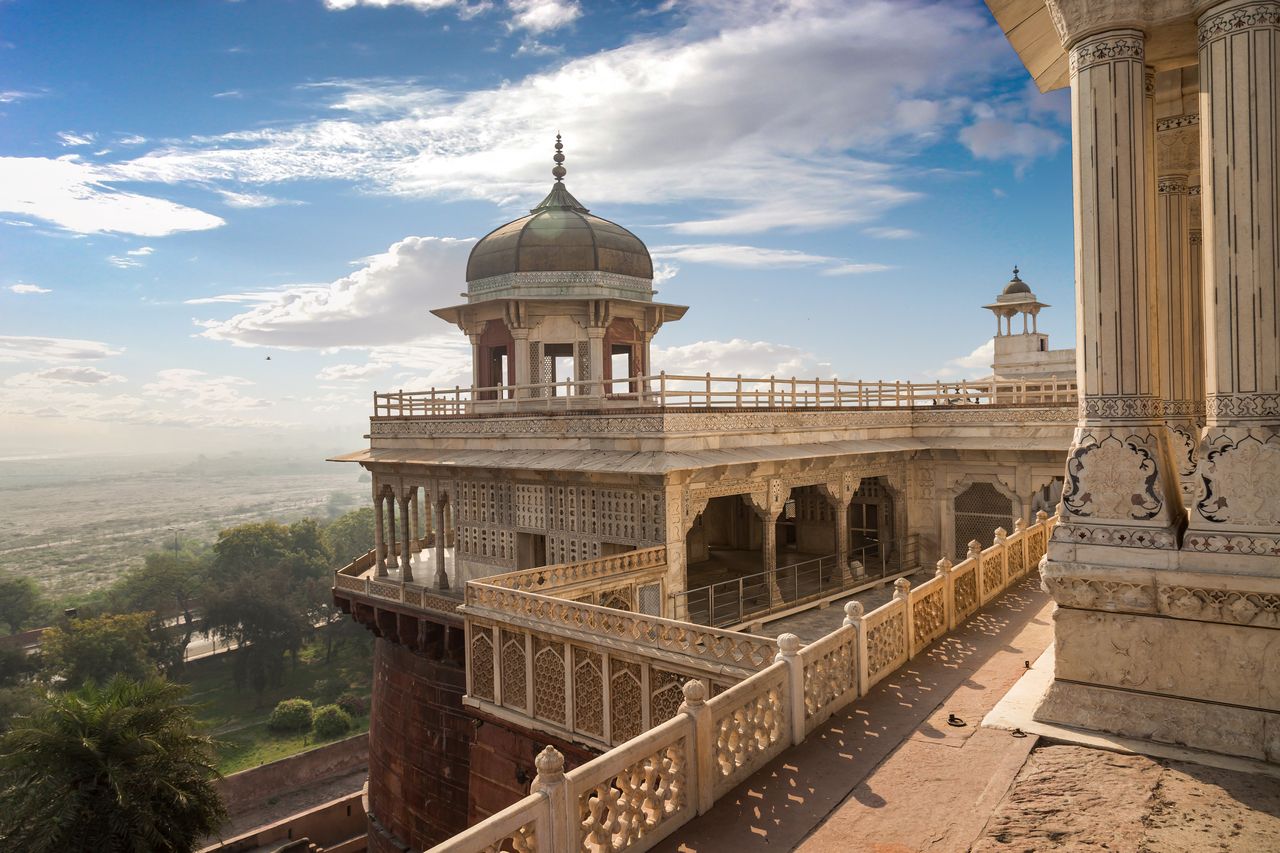
Beautiful perspective of Musamman Burj, the Jasmine Tower and the Yamuna River taken from the platform of Diwan-i-Khas, the Hall of Private Audience. This was the place where Emperor Shah Jahan, who built the Taj Mahal for his beloved wife, was put under house arrest for 16 years. The emperor died in this tower © Roop_Dey / Shutterstock
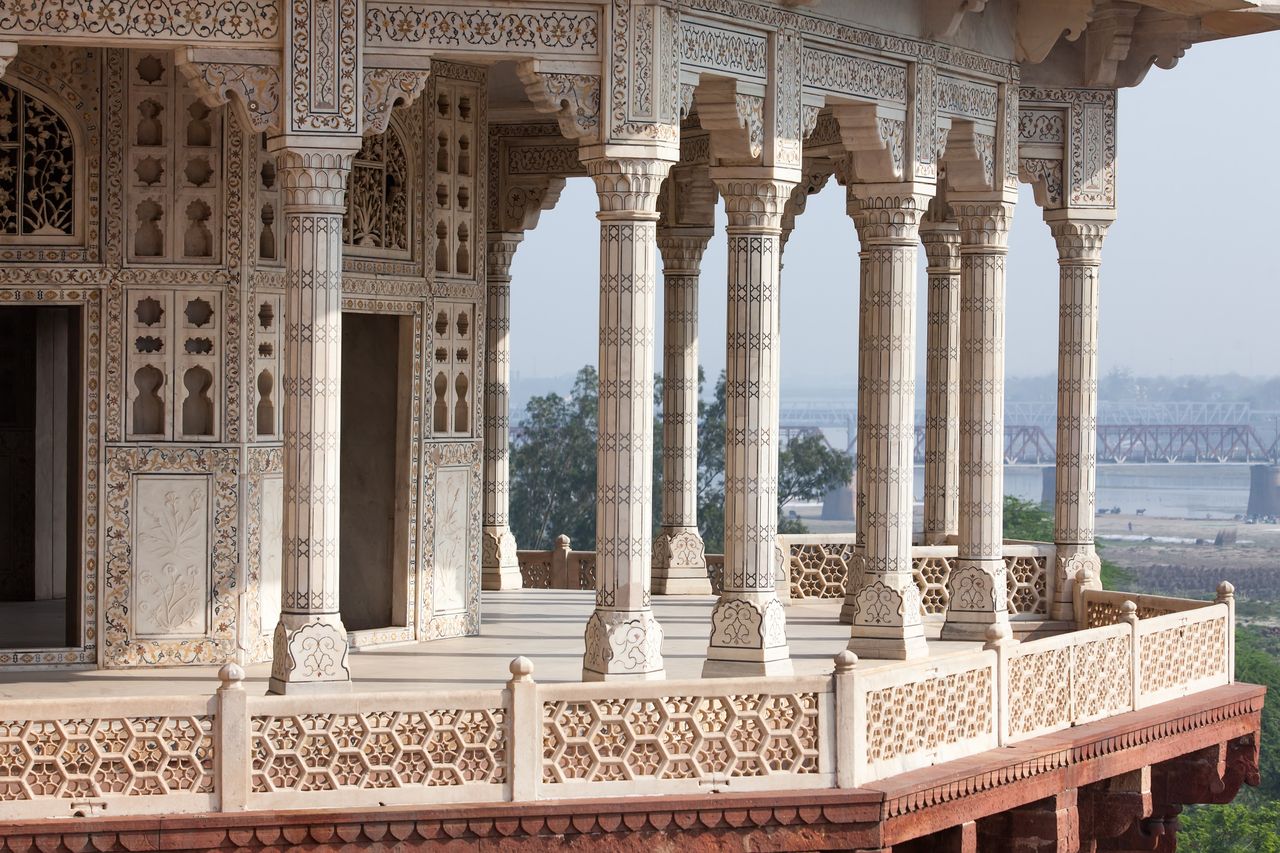
Close-up view of the Musamman Burj or Jasmine Tower overlooking the River Yamuna, where the Mughal Emperor Shah Jahan was held captive by his son Aurangzeb. This is one of the most beautiful structures in the fort and offers an uninterrupted view of the Taj Mahal. This is also the place where Shah Jahan died © My Good Images / Shutterstock
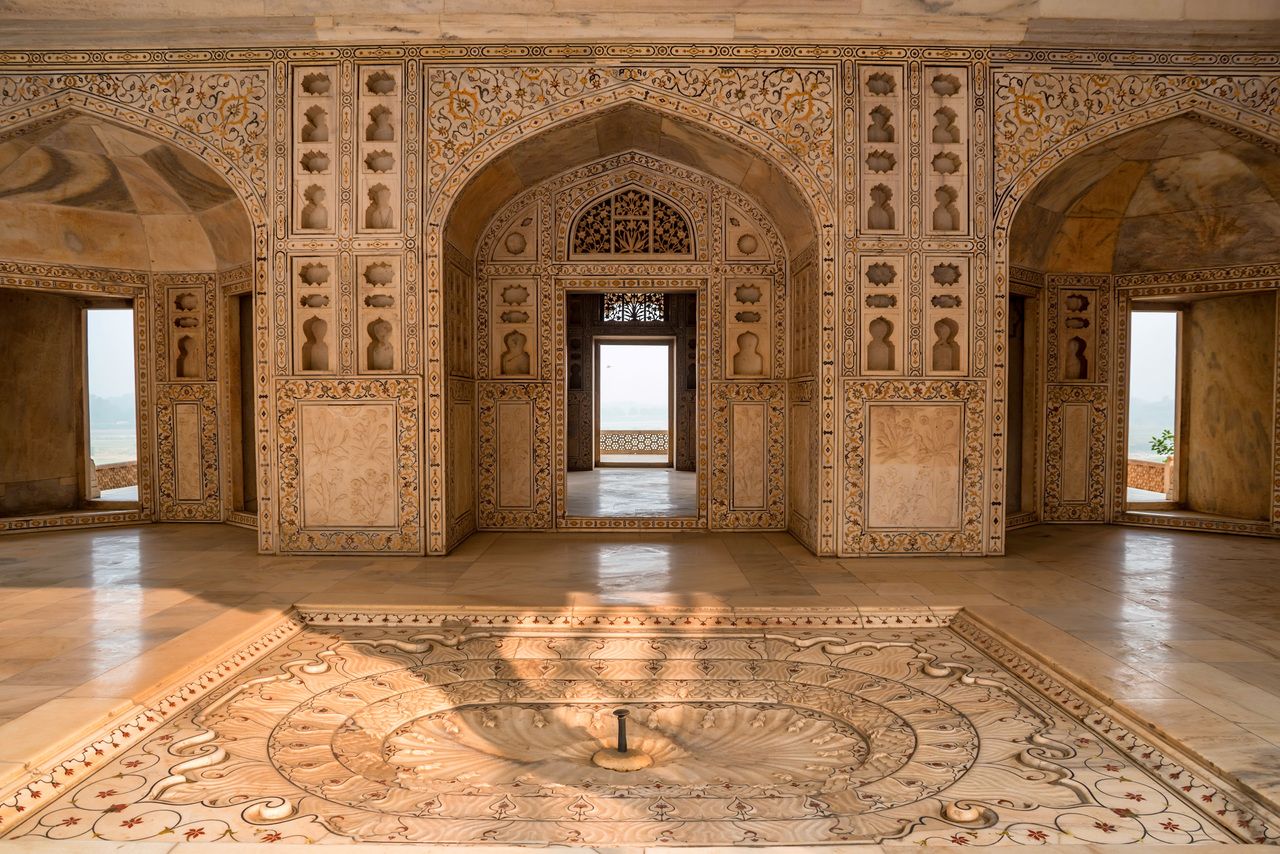
Interior of the Golden Pavilion in the Jasmine Tower with a fountain and pietra dura semi-precious stone work in white marble © Yakov Oskanov / Shutterstock
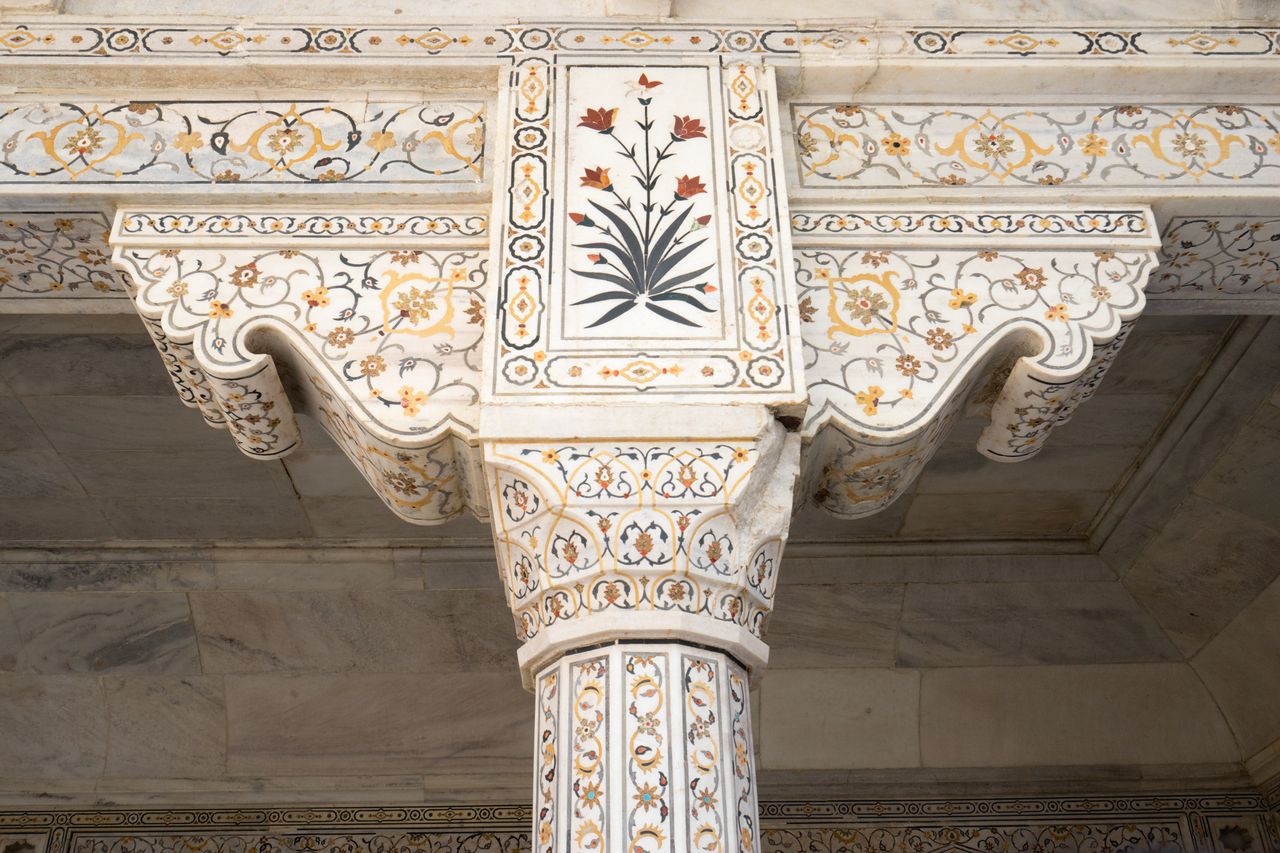
Close-up view of the pietra dura inlay work in one of the towers of the Jasmine Tower Palace of Agra Fort © yong922760 / Shutterstock
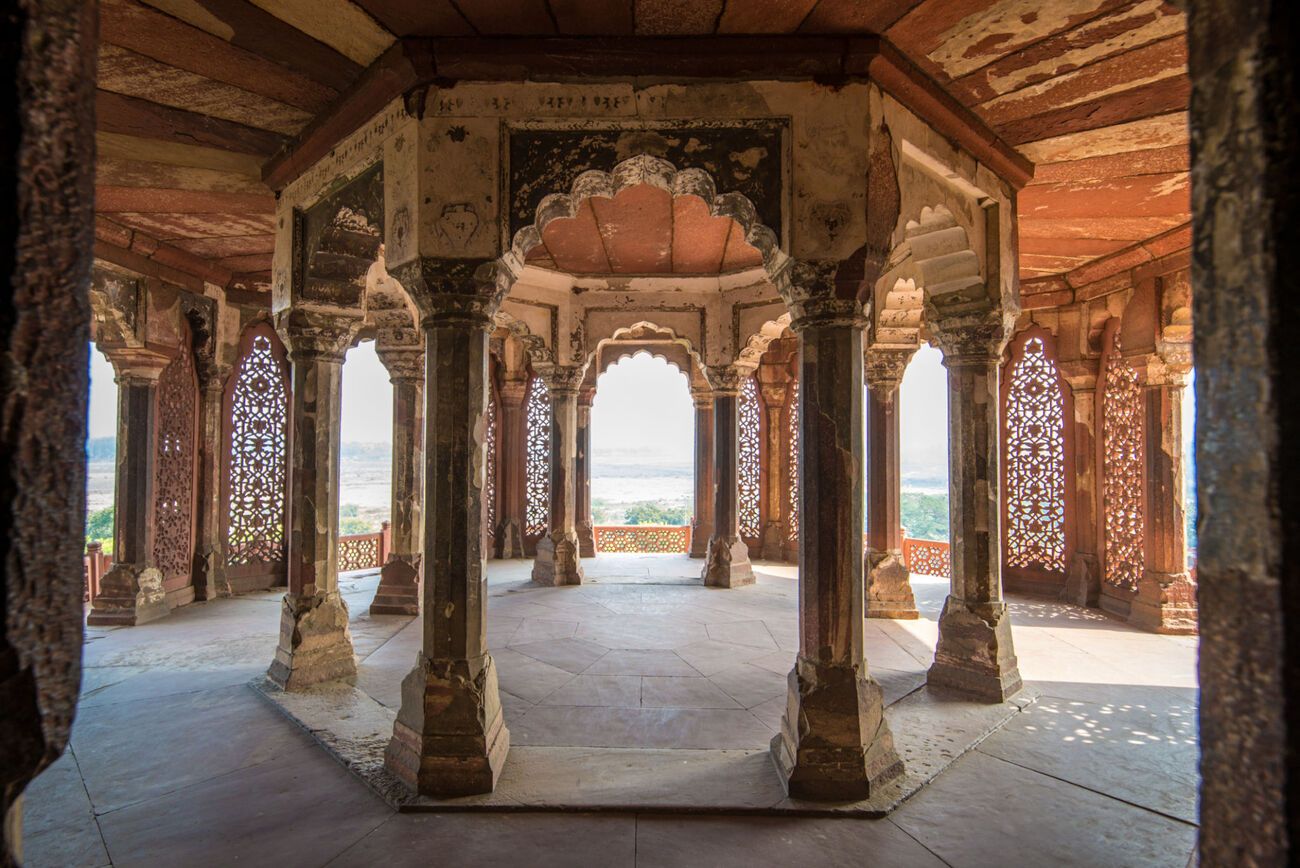
There are several open pavilions in the fort that offer panoramic views of the distant Taj Mahal and the Yamuna River. In this image from one such pavilion you have the view of the dry river bed of the Yamuna during the summer season © Edwin Remsberg
Jahangiri Mahal
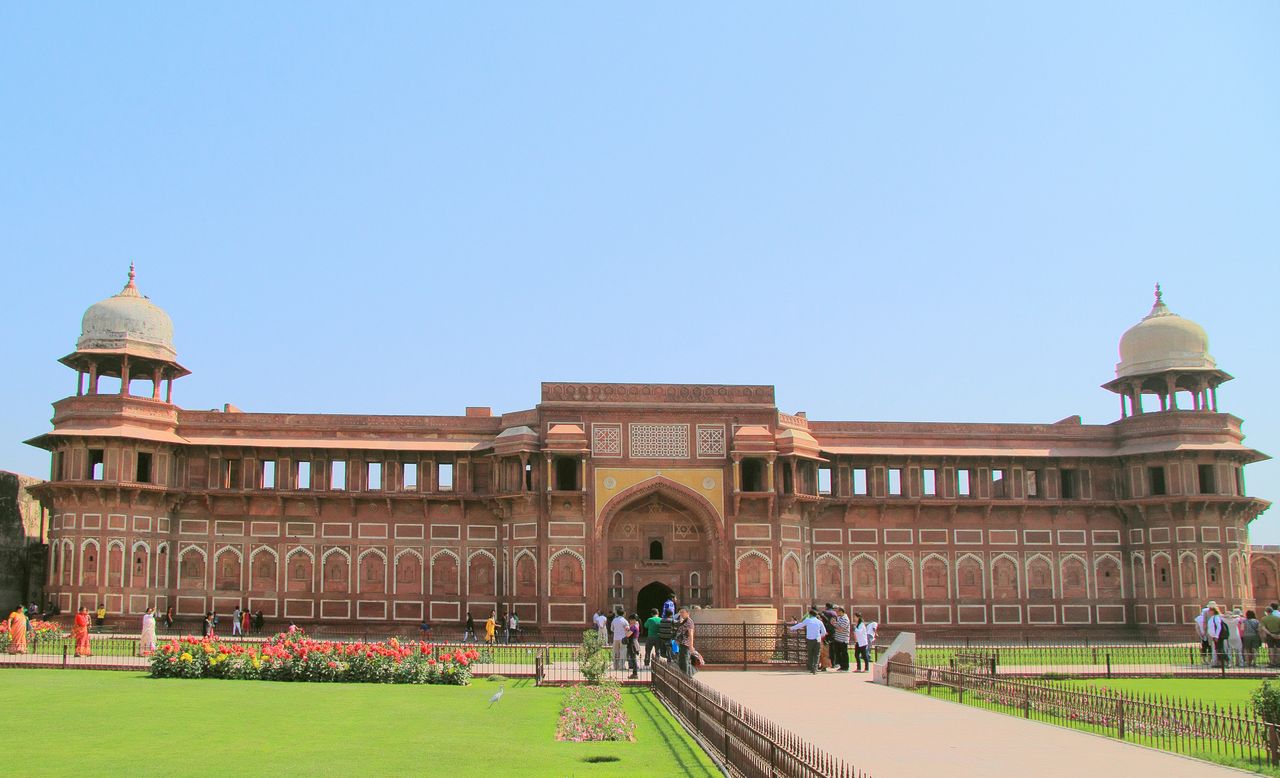
The façade of the Jahangiri Mahal in Agra Fort. The palaces in this part of the fort are constructed from red sandstone contrary to the marble palaces which were added later. This part is the oldest in the fort and survived intact in its full glory © Andrew
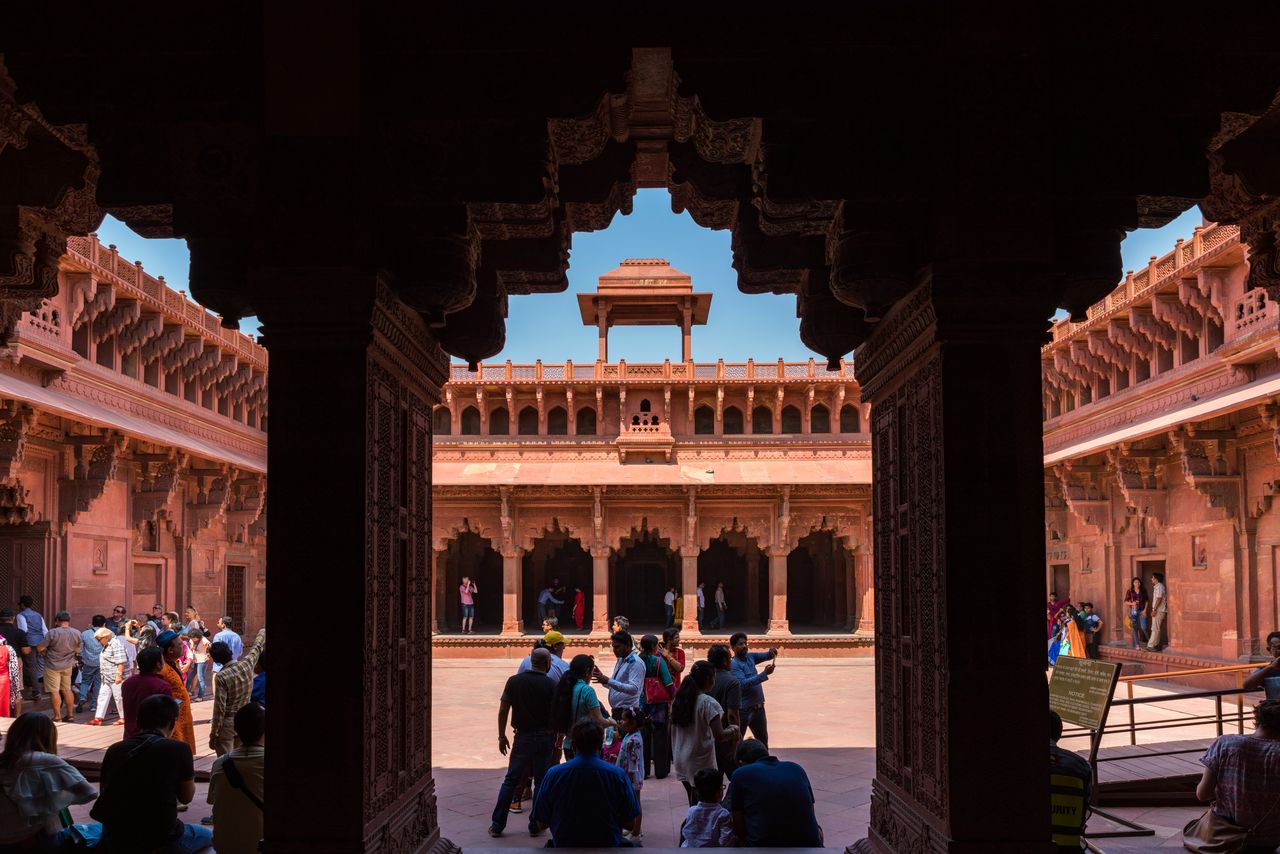
The courtyard of the Jahangir Mahal in the Red Fort of Agra. Decorated with different Hindu elements, balconies, halls and a Hindu temple, this is also the complex where the Hindu wife of the Mughal Emperor Akbar resided © Images of India / Shutterstock
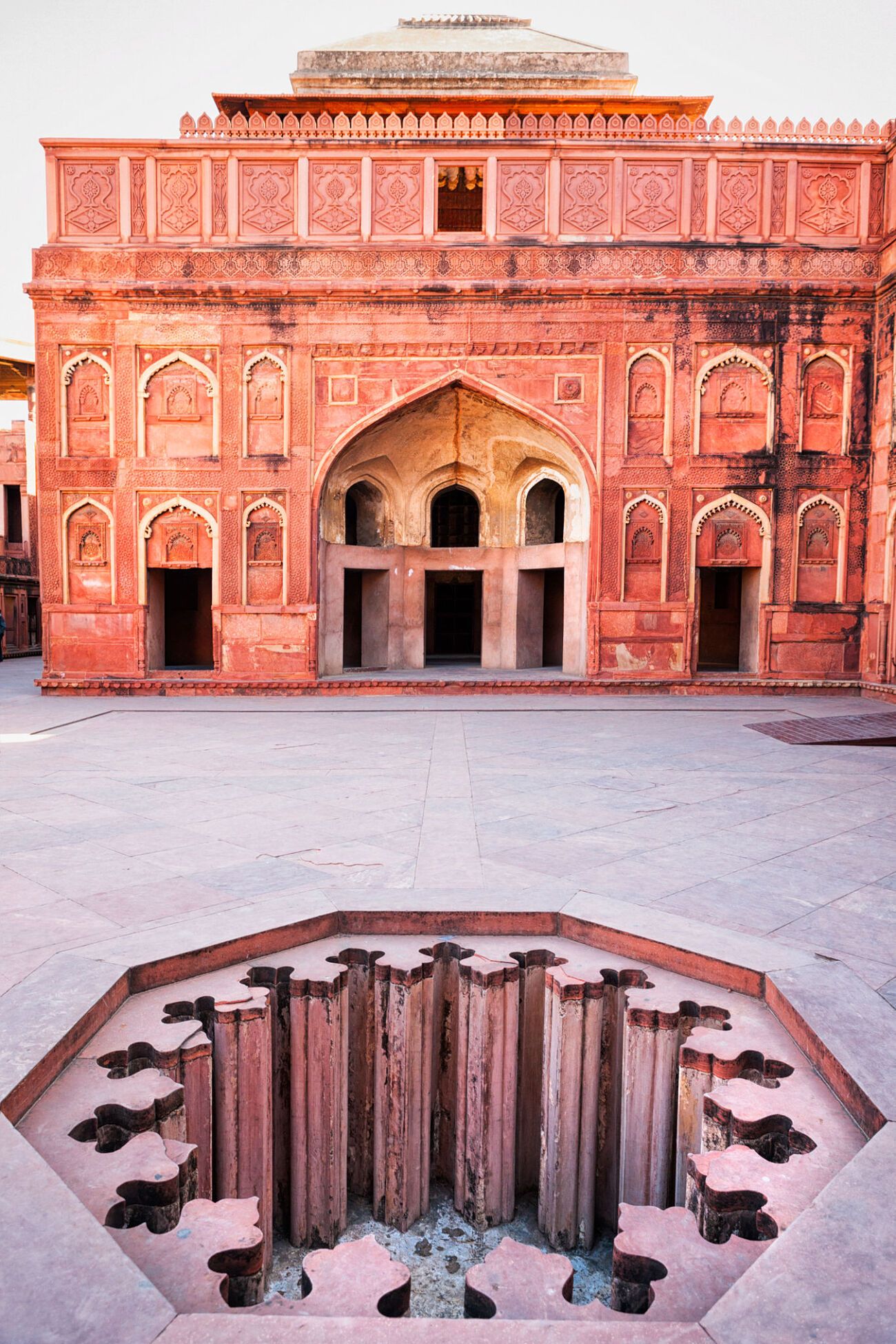
An especially elegant fountain in the Jahangir Mahal inside the Red Fort Complex © Powerofforever
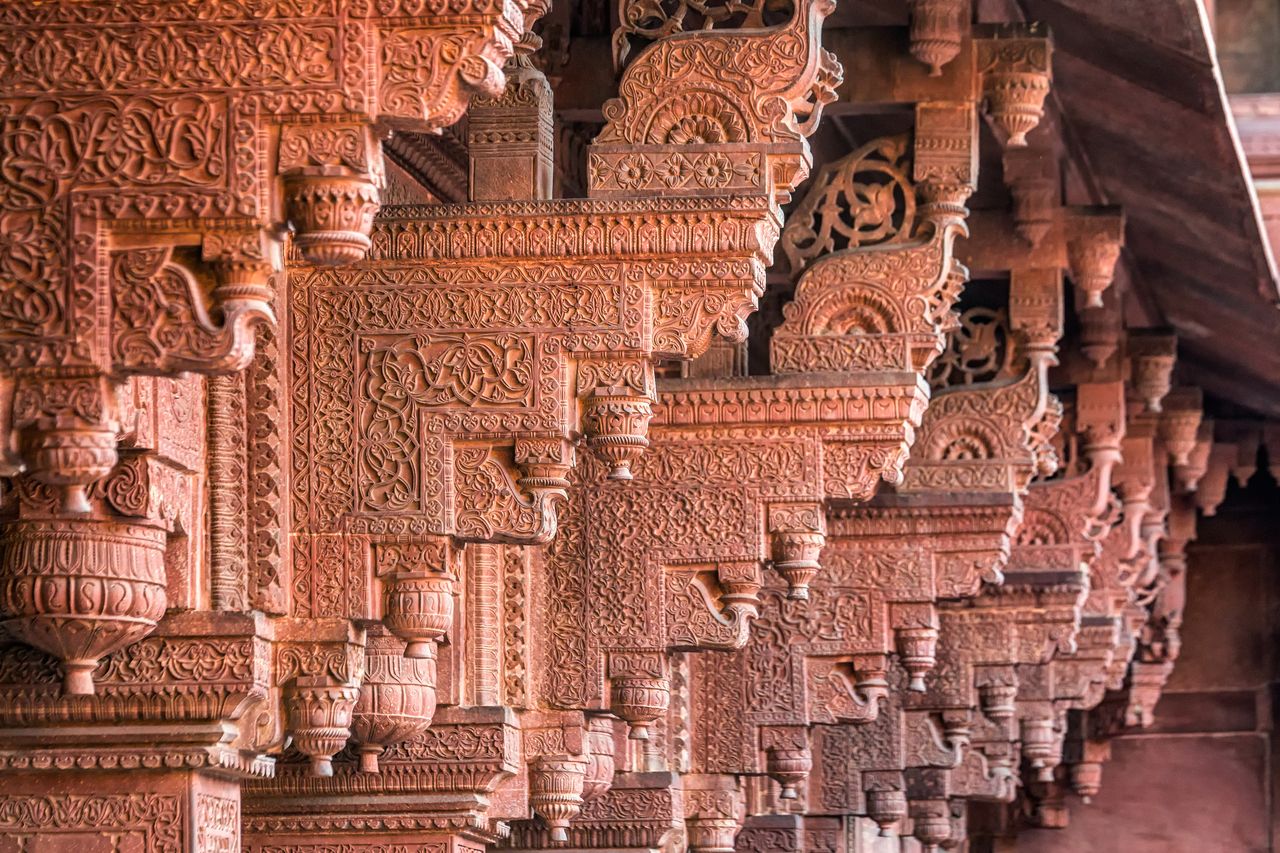
Beautifully carved stone brackets in one of the intact royal palaces in the Red Fort Complex © Ruslan Kalnitsky / Shutterstock
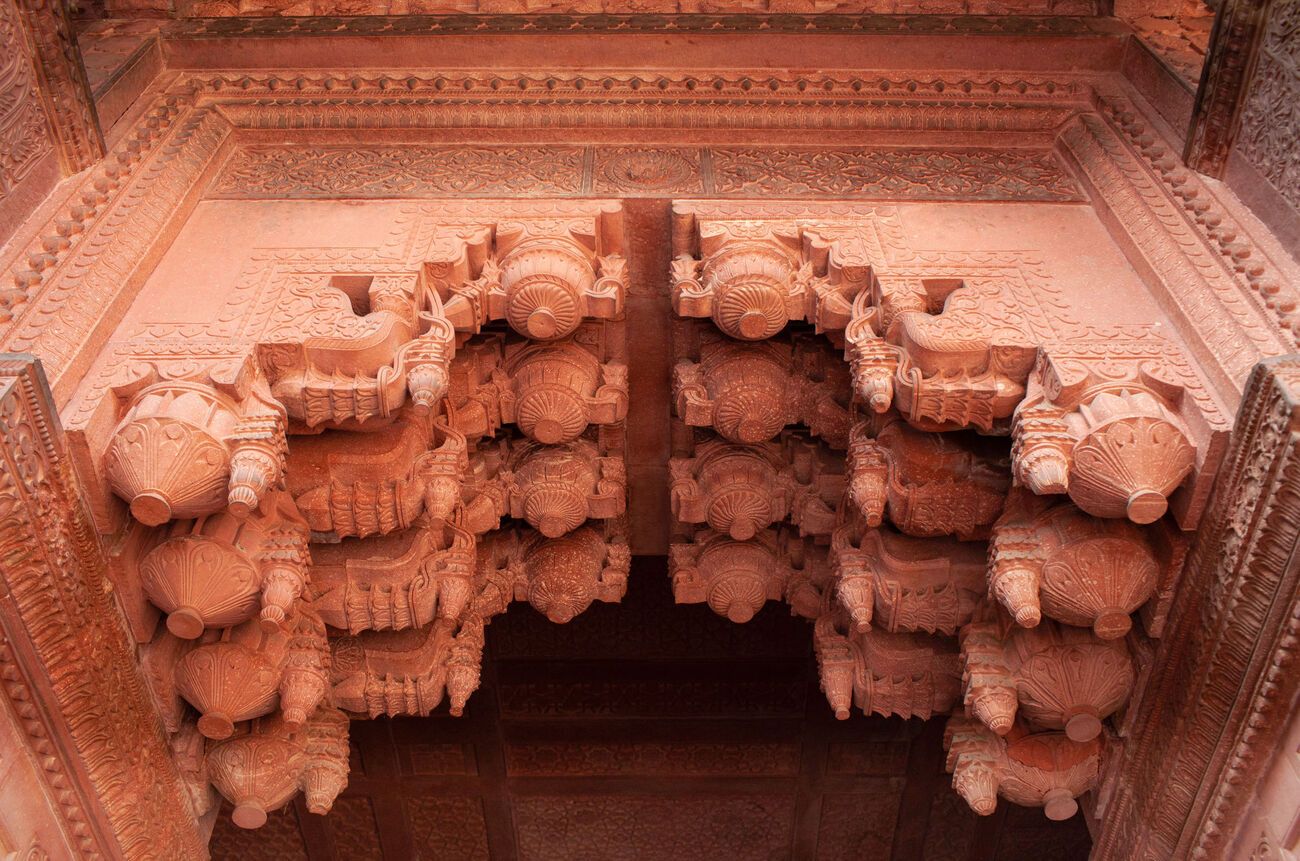
A red sandstone arch with intricately carved adornments. Although an Islamic fort, many decorative elements are from Hindu mythology. For example, the carved bells in sandstone in the Jahangir Palace is an element typical of Hindu temples © Zzvet
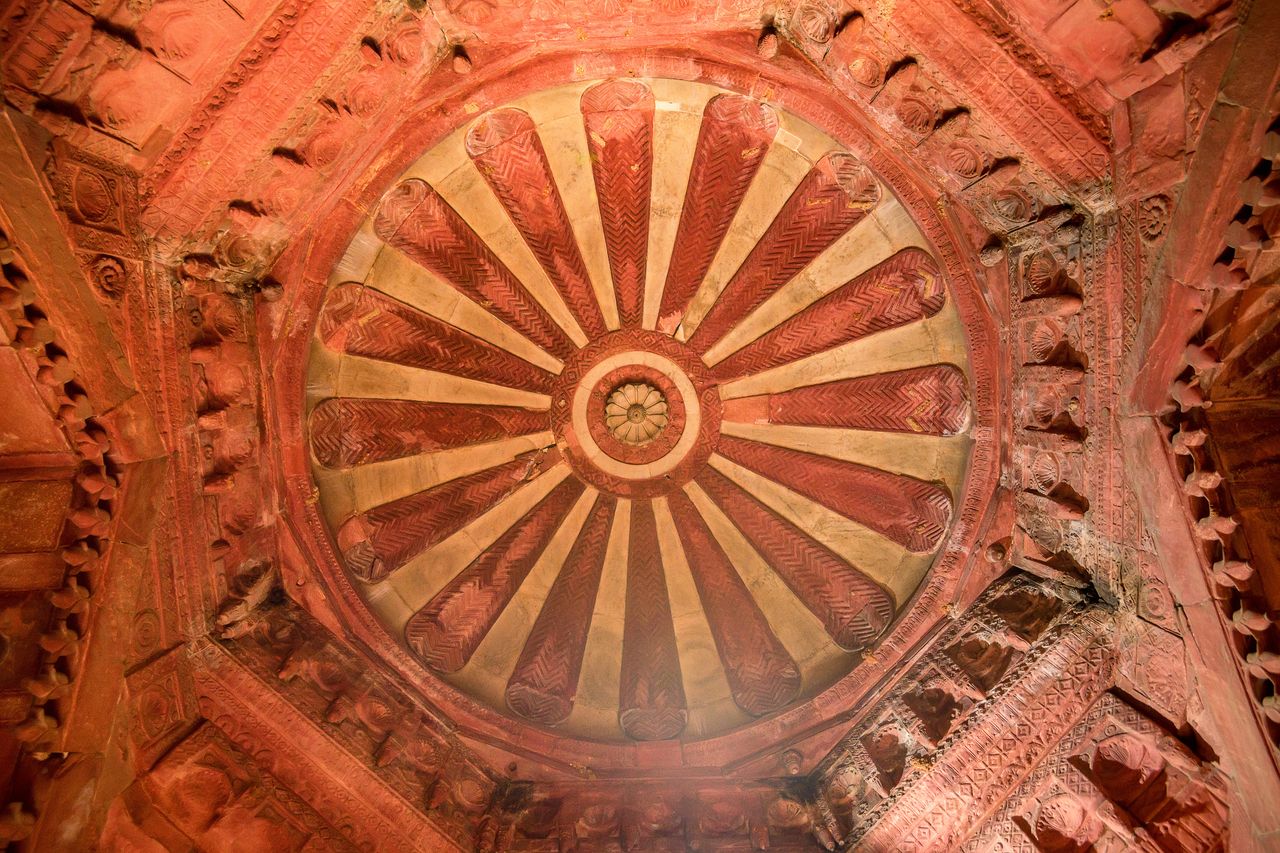
Ceiling of the Jahangir Palace in the Red Fort of Agra
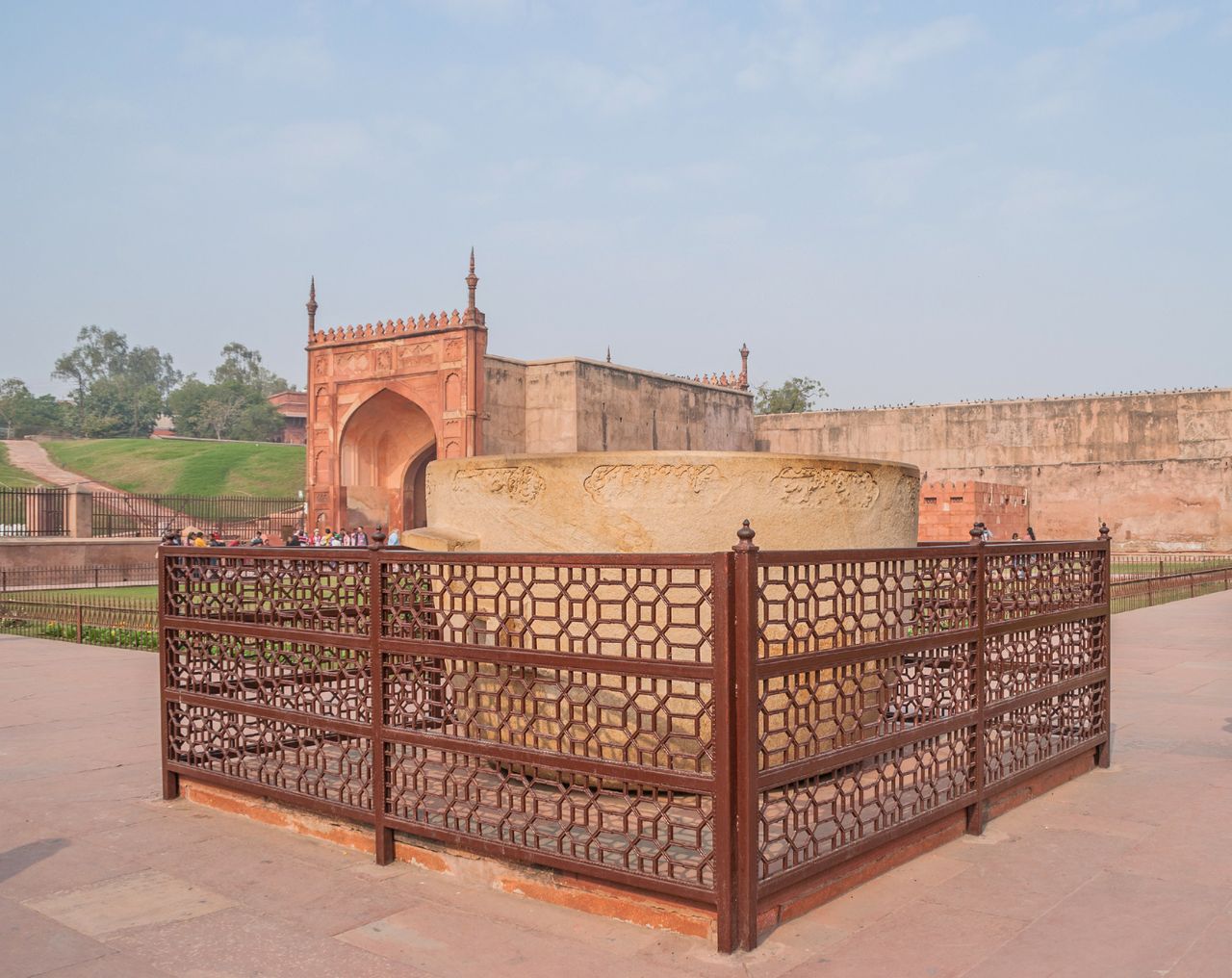
Jahangir’s enormous bathtub, called the Jahangir Hauz faces the palace. Circular in form, it was carved from a single granite block, 2.4m in diameter, 1.22 in depth and with a circumference of 7.62m. It might have been used by the ladies of the harem in Mughal time. According to a Persian inscription in Nasta’liq script it was built in 1611
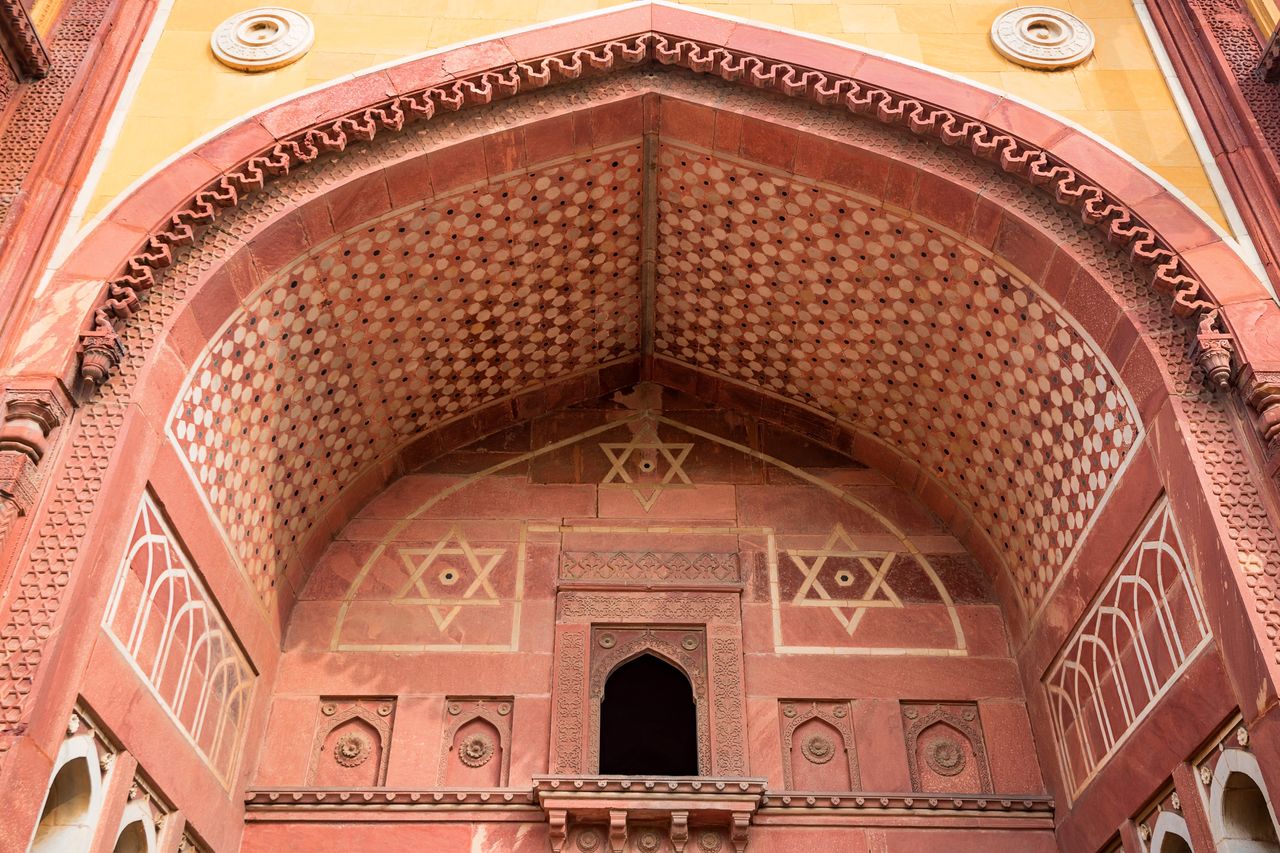
Signs resembling the Star of David adorn the entrance to the Jahangir Palace. However, this design, also used in Humayun’s Tomb in New Delhi has nothing to do with the Jewish symbol. It is actually a Hindu element symbolic of the Muruga, formed by both the male aspect of the Hindu god and goddess Shiva, and the female Shakti version to make up the whole. Like the yin and yang in Chinese culture, the two intersecting triangles representing the two parts of the whole, each one pointing in the opposite direction of the other
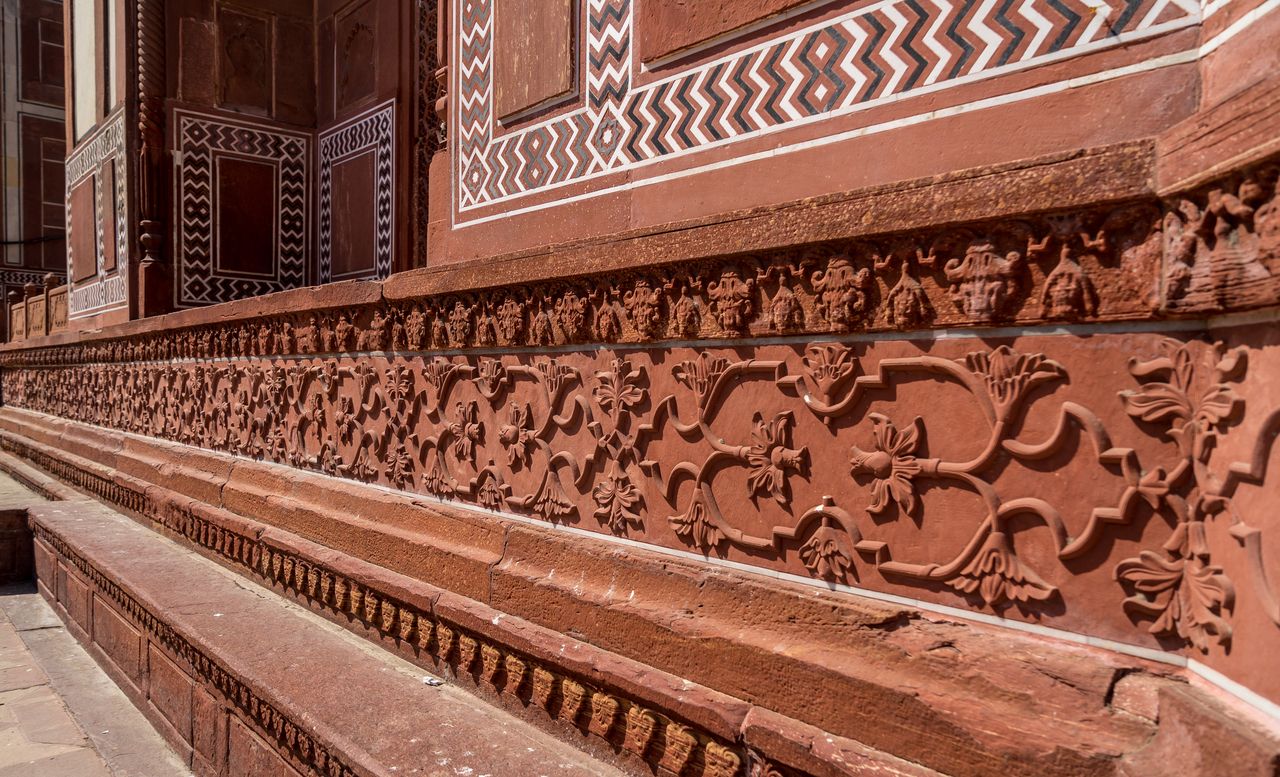
The lower part of Jahangir Palace is finely carved in red sandstone with beautiful floral motifs and designs created by inlay work of white and black marble in red sandstone © Eillen
Shah Jahan moved his capital to Delhi in 1638. However, he continued to use Agra Fort as his residence. As time went by, Shah Jahan’s beautiful home became his prison. He was placed under house arrest by his son Aurangzeb in 1657 for political reasons. The last nine years of his life were spent imprisoned in his home in Agra Fort from where he had a view of the magnificent Taj Mahal. But more important to Shah Jahan was what lay in the mausoleum in the Taj Mahal ― the body of Mumtaz Mahal, his favorite queen and the woman he loved dearly.
Shah Jahan died on January 22, 1666 at the age of 75 years. In those days, the River Yamuna connected with the fort on the eastern side. Hence, they lowered Shah Jahan’s body and took it out through the Water Gate on the eastern side. It was no surprise that his last request was to be laid to rest next to his beloved Mumtaz Mahal at the Taj Mahal. His wish was granted.
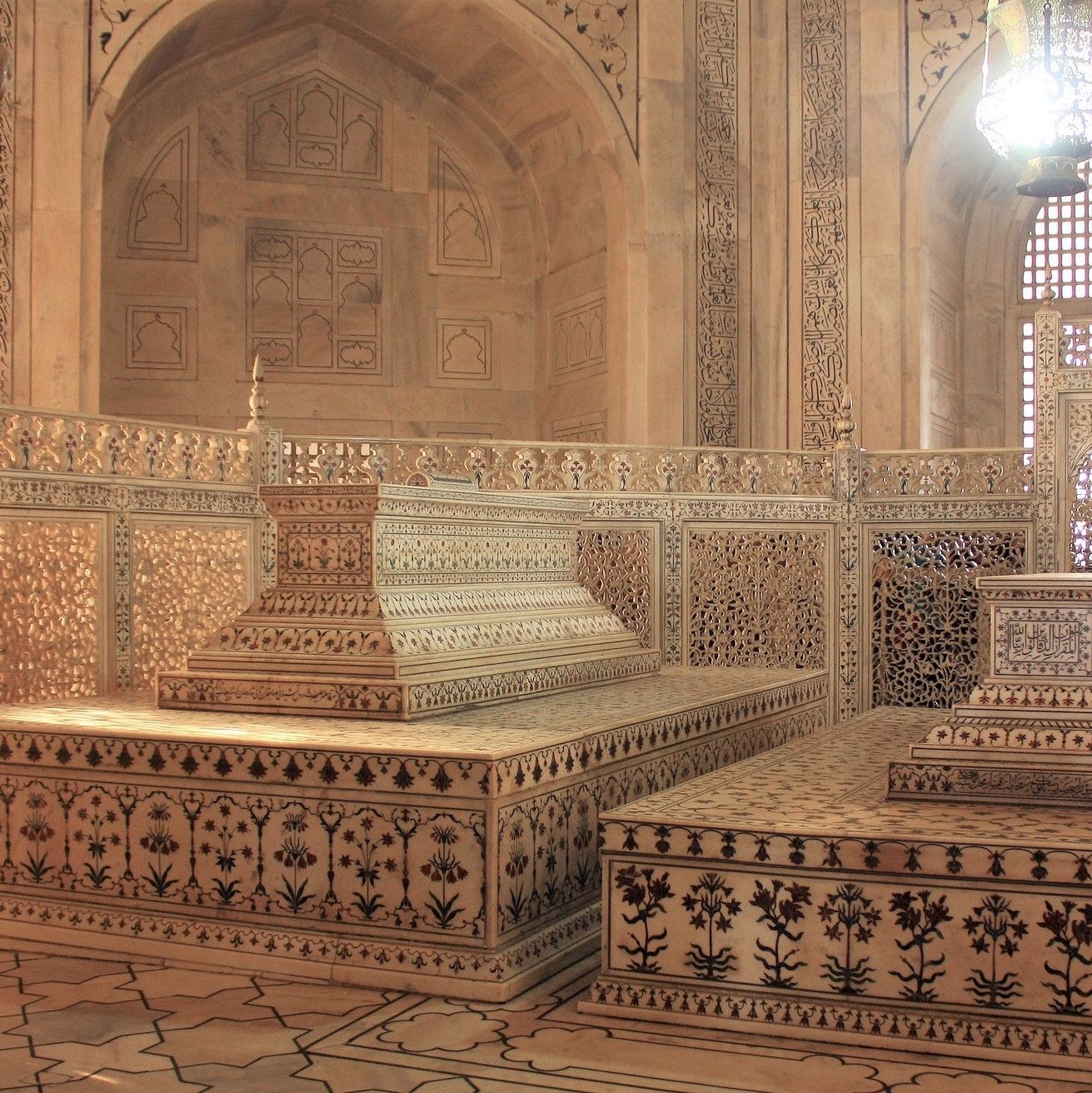
Tomb chamber of the Mughal Emperor Shah Jahan and Empress Mumtaz Mahal in Taj Mahal, Agra
After Shah Jahan’s death, the glory of Agra Fort faded despite the fact that Aurangzeb, though busy with conflicts in the Deccan, would visit the fort and hold durbar or audiences there.
After Aurangzeb died in 1707, the Mughal Empire started to decline. It became fragmented to the point of no return. Between 1761 and 1774, the Jats took over control of the Agra Fort. In 1784, Mahadji Scindia and the Marathas claimed the throne and maintained their control until the year 1803. It changed hands again when the British forces led by Lord Lake took over.
From the years 1803 to 1862 most of the fort’s architectural landmarks were destroyed by the British. They did this to make room for constructing barracks for their men. Suraj Mal, the Jat leader at the time, carried the marble tanks to Bharatpur while he had control of the fort. In Deeg in Rajasthan, Mal used the marble tanks to decorate his garden.
The British forces did not attack the fort. However, in 1857, while the Great Mutiny took place, over 4,000 Europeans claimed shelter inside. One of these Europeans was John Russel Colvin, who had been the North-Western Provinces’ Lieutenant Governor. On September 9th, 1857, he died at the fort of cholera. A tomb was set up for his burial next to Diwan-i-Aam, the Public Audience Hall in the Fort.
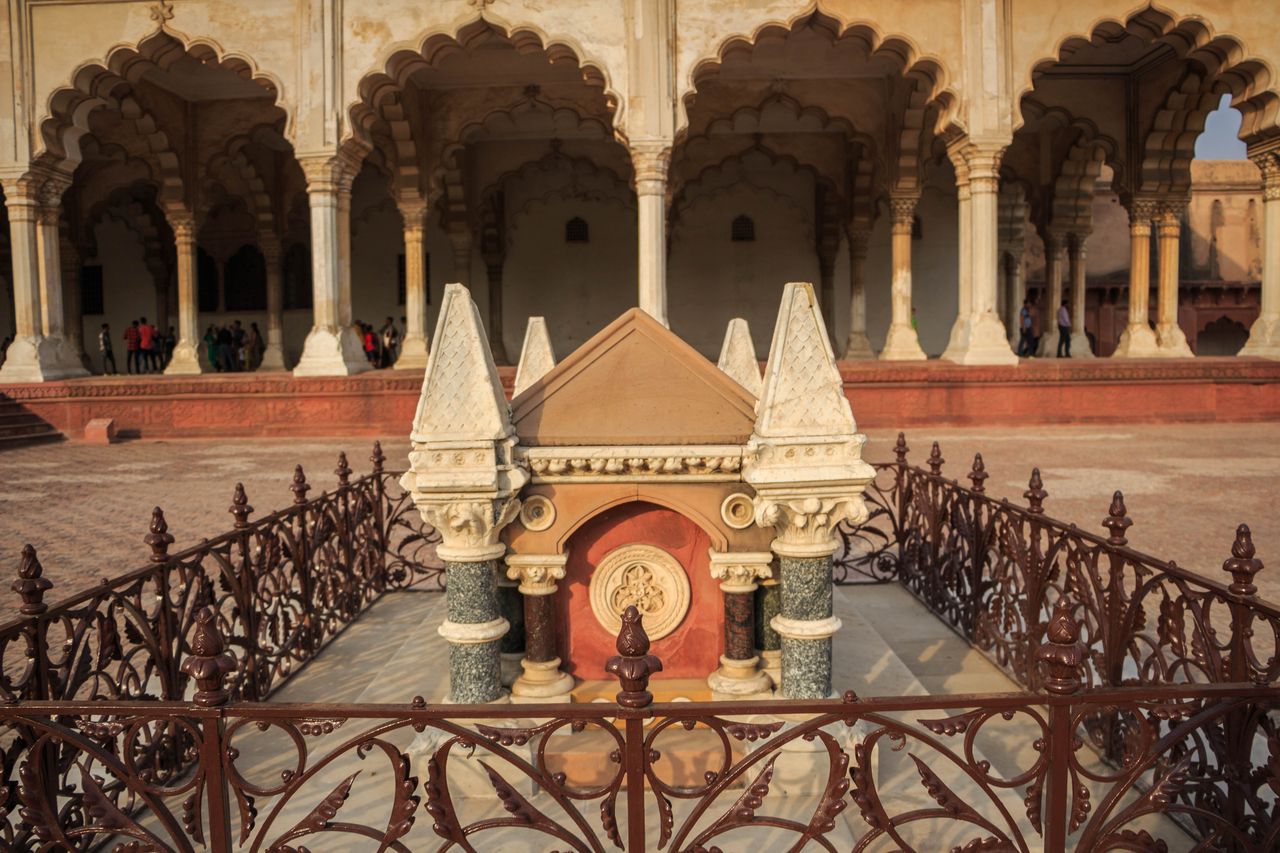
The grave of John Russel Colvin, the British Lieutenant Governor of the Northwestern Provinces, who died in the fort of cholera on September 9, 1857. He was buried in front of the Diwan-i-Aam © Arif Areeman / Shutterstock
To this day, Agra Fort is a prominent historical site rich in antiquity and it chronicles centuries of past events. Its beautiful architecture and long history combine to create a compelling narrative. The remarkable and explicit character of Agra Fort earned it its rightful place as a UNESCO World Heritage Site in 1983 and the well-deserved Aga Khan Award for Architecture. These awards reflect Agra Fort’s worthiness of being preserved for posterity. However, it is difficult to capture the exceptional intellectual and creative ability that brought this fort into existence.
Tip: Keep in mind that there are nowhere to buy drinks anywhere in the fort, and exploring the complex can be tedious. Therefore, it is essential to bring your own water.

A laborer prepares sandstones for the renovation of the Red Fort. Due to its vast size, renovation and repair works are frequently done and is an ongoing . The fort was mentioned for the first time in 1080 © travelview / Shutterstock
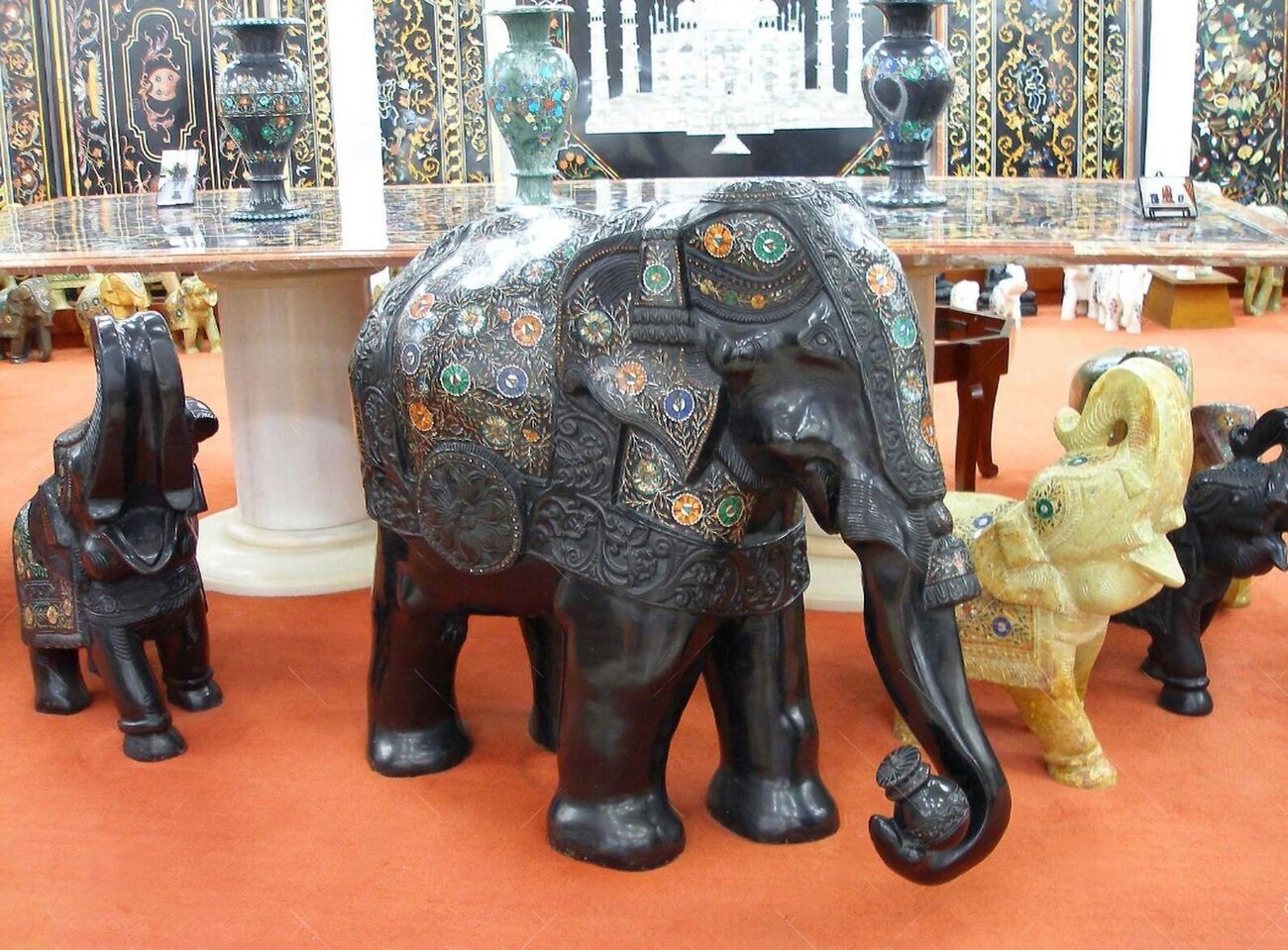
Near the Red Fort many souvenir shops sell items like these marble and stone elephants, inlaid table tops and vases. The items are inlaid with semiprecious stones, turning them into exquisite pieces of artwork
Share this post
You may also like.

Related Tours
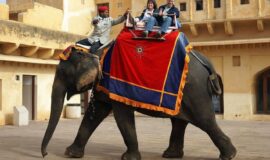
© ALL CONTENT COPYRIGHT UNDER DIGITAL MILLENNIUM COPYRIGHT ACT (DMCA)
ALL RIGHTS RESERVED - PHOTOGRAPHS AND WRITTEN CONTENT CANNOT BE REPRODUCED WITHOUT OUR PERMISSION.
Cookie Settings
Sustainable, Budget-friendly and Informative Travel guides for every Destination.

Agra Travel guide – 4-day Itinerary on best Places to Visit
What would you call a city that has preserved its fascinating history through the reigns of several kingdoms and governments, a city that has its reference in the pages of epic Mahabharata? A place that is home to some of the most iconic monuments and has never failed to capture the imaginations of tourists from around the world. A city that will tickle your taste buds with its culinary richness and leave you with a foodgasm. What else would you call it other than ‘AGRA’ – a land that is known for architectural brilliance, rich heritage, culinary delights, and boasts as ‘City of the Taj’.
Located just 220 km away from the capital Delhi, Agra is the hub to witness the artistic finesse and grandeur of the Mughal era. The amalgamation of Indian, Islamic, Turkish, Persian elements and symmetric patterns in the structures is what makes Mughal constructions wonders of their kind. With several magnificent mosques, tombs, and palaces, Agra has pinned itself in the limelight of the world tourism map. Often explored as part of the famed Golden Triangle loop (along with Delhi and Jaipur), Agra tops as one of the must-see destinations in India. If you are covering it as part of the Golden triangle tour, you might be having only a day to explore. But after visiting this amazing city our suggestion is to take some more time to take pleasure in the sights beyond Taj Mahal and Agra Fort. Over the past decades, Agra has become synonymous with the grand mausoleum ‘Taj Mahal’ and attracts major tourists, but the city has a lot more to offer to those who are willing to stick around for longer than a day.
So here is our guide on what you could do in 3 to 4 days without having any dull moments in this vibrant, lively city.
Table of Contents
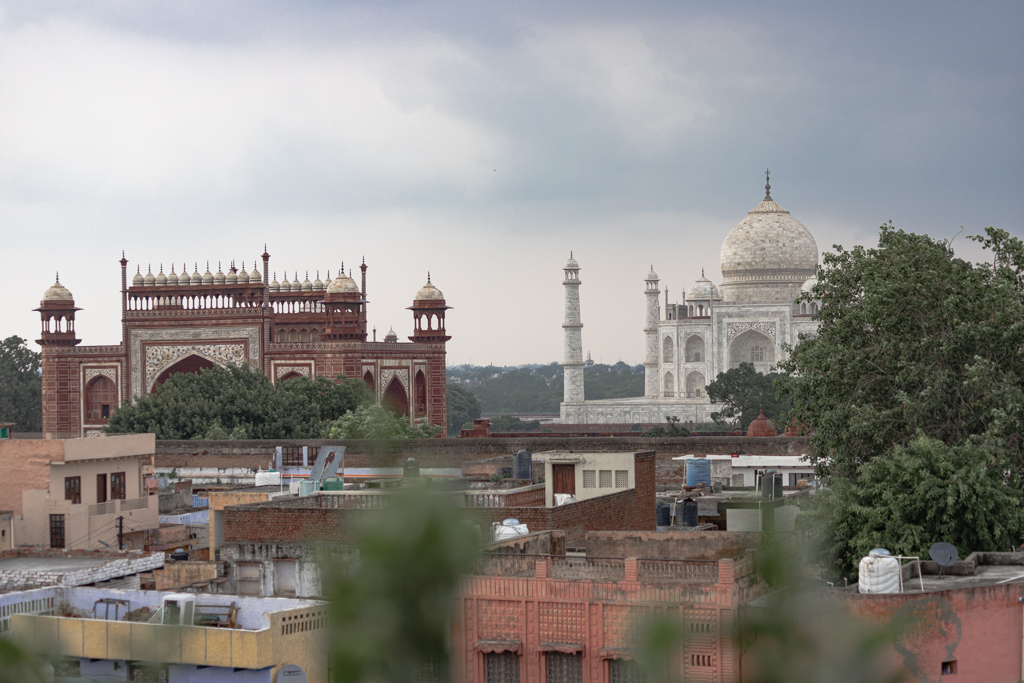
Day 1- Arrive at Agra and check-in:
Most tourists usually get to Agra from Delhi/Jaipur via train or travel agency-operated buses. A few of the Indian cities (Bengaluru, Mumbai, Jaipur, Lucknow, Delhi, Varanasi, and Bhopal) are also directly connected to Agra through non-stop flights. From other cities/countries your best bet is to connect to Delhi and then to reach Agra via train/bus/cabs. We visited Agra during August 2021 just when lockdown restrictions were lifted after several weeks due to the Covid pandemic. We arrived in Agra on a Sunday afternoon which happened to be during the weekend lockdown (though at the timing of writing this blog, lockdowns have been completely lifted). All shops and attractions were closed. So, Day 1 was just about relaxing and scouting areas nearby the Taj Mahal.
Where to stay in Agra:
We booked hotel Atulyaa Taj which was adjacent to Taj East gate, to be precise just 700 meters away. The property is quite up to snuff for the budget accommodation and facilities it offers in a prime location such as Taj East gate road. Although interiors are just average, with a Taj view terrace, rooftop pool, complimentary breakfast, and proximity to the Taj it was perfect for what we were looking for. We highly recommend staying somewhere on the east gate road which offers rooms to fit every budget from hostels and homestays to guesthouses, lodges/bed and breakfasts to 5-star hotels.
A few highly reviewed accommodations that we could list down around this area are Joey’s hostel, Moustache Agra, Atulyaa Taj, The Coral tree homestay, Pearl of Taj, The Retreat, Taj hotel, and convention centre, Trident hotel, The Oberoi Amar Vilas, etc.
Some more places around Agra where you can stay are Howard Plaza-The Fern, Grand Imperial Hotel, ITC Mughal.
After checking in, we took a stroll to look at our surroundings. We walked into one of the well-known rooftop restaurants for a quick bite, but mainly to have a glimpse of the Taj Mahal. Joey’s hostel and Sania Palace restaurant are some of the most sought-after places and each has its unique view of the Taj Mahal to offer.

With every other market, museum, emporiums being closed we spent the evening sipping coffee at our hotel’s terrace restaurant.
Day 2- ‘Wonder of the World’ – Taj Mahal and ‘red sandstone stronghold of the Mughal era’ – Agra Fort
We woke up at 4:30 AM to get ready and visit the greatest wonder of the world. At 5:45, we left our hotel and started walking toward the eastern entry gate. The road from our hotel leading to the entry gate was scenic. The grey sky waiting for the sun to rise, the chirpy birds singing in the nearby forest reserves, the tall trees lining the pathway slowly lighting up, the cool breeze from the surroundings, and the early risers going about their business gave a sense of tranquility.

Entry to Taj Mahal: Taj Mahal has three main entrances. The eastern gate faces towards the Taj Nature walk side and was built in the memory of Emperor Shah Jahan’s other wife Sirhindi Begum; thus, it was named ‘Sirhi Darwaza’ (also referred to as Fatehabadi Darwaza). This gate seems comparatively less crowded than the main entrance on the west side called ‘Fatehpuri Darwaza’ dedicated to another wife Fatehpuri Mahal. While the third entrance The South Gate or ‘Sidhi Darwaza’ faces towards the (old Mumtazabad) present Taj Ganj, a market that has existed since the inception of the monument itself. This gate is perfectly aligned in symmetry to the Great Gate as well as to the Taj Mahal. At present, the gate is closed for Entry and is meant for the pedestrians to exit. There is a red stone Tomb on the right side of this gate which is believed to be a grave of the maid of Mumtaz Mahal. Due to this reason this it is called the ‘Tomb of a Maid of Honour’.
Note: Although before the pandemic there were manual ticket booking counters available near the gates, at present only online ticketing is available, which can be booked from the ASI website in advance ( https://asi.payumoney.com/ )
Check the ticket prices from the official link ( http://www.tajmahal.gov.in/ticketing.aspx )
We scanned out e-tickets from our phones. After a quick frisk through security, we were allowed to walk toward the forecourt of the Taj complex (Jilaukhana). This part of the complex used to serve as a gathering point for the visitors.
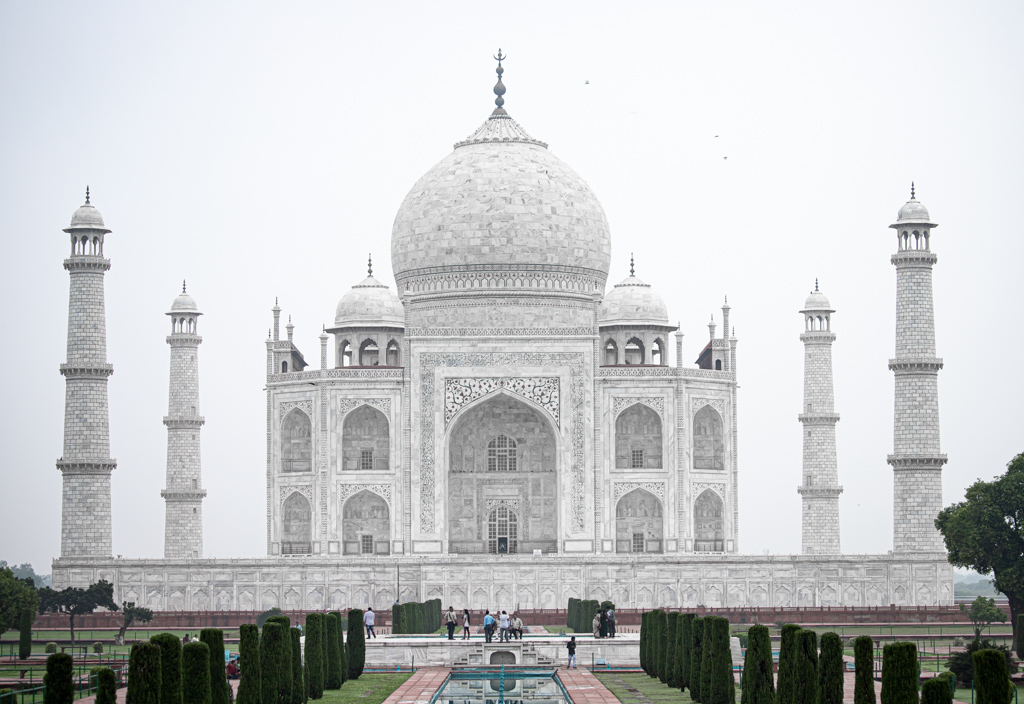
Taj Mahal:
A few steps ahead from the east gate and the first thing we saw was the massive red sandstone entrance known as the Great gate or ‘Darwaza-i-Rauza’. This gate itself is a piece of art that separates the mausoleum and garden from the forecourt. With two ornamented doors on each side (one towards the courtyard and the other towards the Taj) and prolific inlay work of white marble and precious stones, this gate will give you a glimpse of what is in store ahead. This grand entrance is believed to be the gateway to the gardens (Charbagh) which, symbolically, represents Paradise. The 22 domes on top of the rectangular entry building (11 on each side between two high columns) represent the number of years it took for the construction of the Taj Mahal to complete.

We couldn’t help but get on setting up our camera for some pictures. Some of the aged men sitting on the stairs took us through the dos and don’ts in the complex, mainly don’ts. We politely nodded our heads and walked on. As our eyes fell on the gigantic marvel, we were hypnotized, there was love and wonder in the air. Sourab was seeing the Taj for the second time but was astonished as if it was his first time witnessing the wonder. However, we had to stop wondering and move ahead as the crowd slowly started building up. There was a queue of tourists taking photographs and guides advising them on poses, all while talking about the history of the place. We quickly clicked a few frames and moved ahead.
The inner/main complex of the Taj mahal mainly consists of Charbagh (the ornamental gardens divided into four parts, dissected by 4 water bodies with an ornamental marble plinth running through its center). When the first rays of the Sun hit this water body and reflect the image of the main mausoleum it appears to be other-worldly.
At the end of the gardens towards the North, on the bank of the Yamuna there stood the magnificent marvel ‘The Taj Mahal, on a high marble plinth. At the corners of the plinth stand minarets: the four large towers. On the northernmost side, you can see the ‘Chameli Farsh’ the riverfront terrace. This elevated terrace supports the mosque (to the west), the guest pavilion or Mihman Khana or Jawab (to the east), and the main mausoleum (in the center). The mosque and the guest pavilion are the two identical red sandstone buildings on both sides of the mausoleum. While Mosque is an integral part of the complex the guest house was done on the east side considering symmetry.
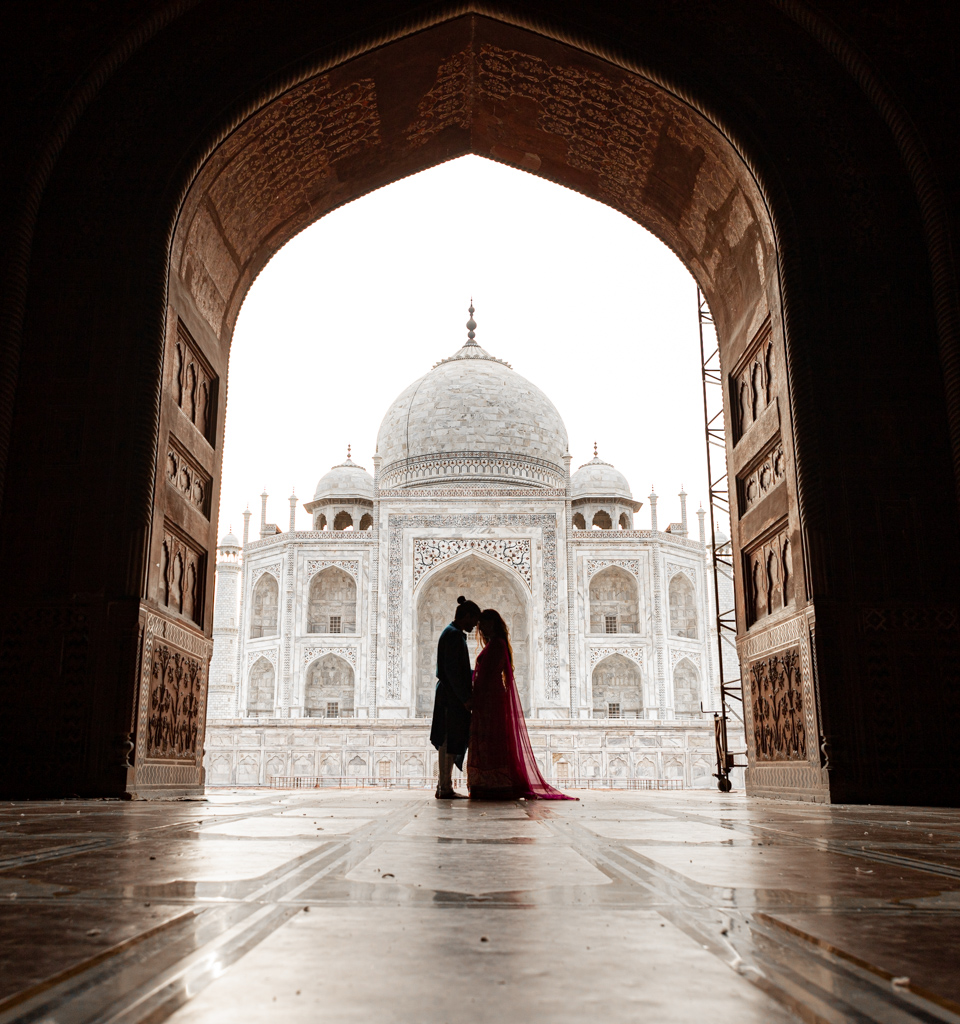
At the center stood the “Crown of all palaces”, a symbol of a husband’s eternal love for his bereaved wife. Built-in semi-translucent white marble this octagonal tomb is a perfect example of symmetrical structure. The intricate carvings and floral motifs of precious and semi-precious gems, the calligraphy works, the symbolic cenotaphs of the Mumtaz Mahal and Emperor Shah Jahan make you realize why it is considered the first wonder of the world.
We walked through the mosque, the seating area, and the mausoleum gazing through every wall, every pillar, and every art. We luckily found an amazing guide who transported us back to history with his superb storytelling. After listening intently through every word of every sentence of what he had to say, we were left wowed. The more we gazed upon the white beauty the more captivated we were. We bid our temporary goodbyes and left the complex at around 10 AM. We took the golf cart service straight to our hotel. After a quick breakfast, we made our way to the next destination
Opening hours: 30 Minutes before sunrise and closes 30 Minutes before sunset during normal operating days. Closed on Fridays for general viewing.
Ticket Price- Indian Visitors- INR 50 per person (200 additional for the mausoleum) / Foreign Visitors- INR 1100 (200 additional for the mausoleum)
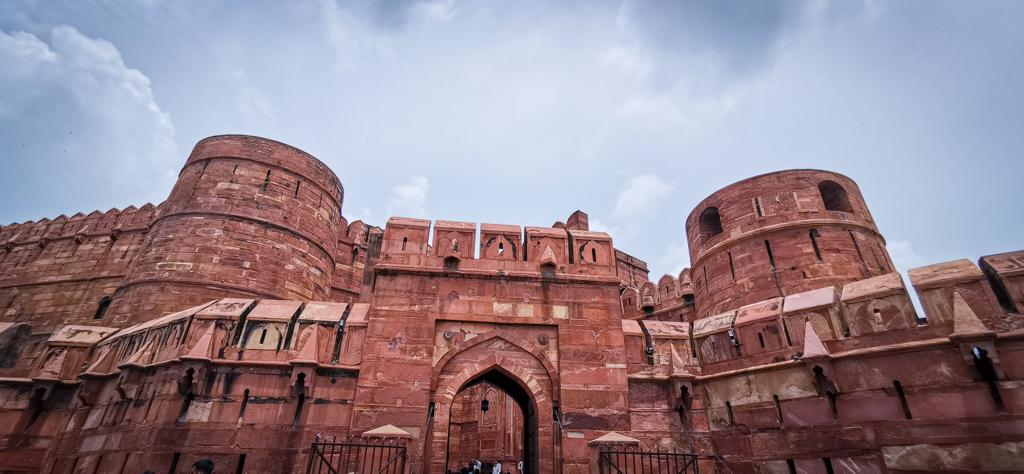
Tip – Do take an umbrella as it gets quite sunny during the afternoons.
Opening hours: 6:00 am – 6:00 pm
Ticket Price- Indian Visitors- INR 50 per person / Foreign Visitors- INR 650/-
Booking website- https://asi.payumoney.com/
Lunch at GMB:

Exploring Agra’s Street food culture:
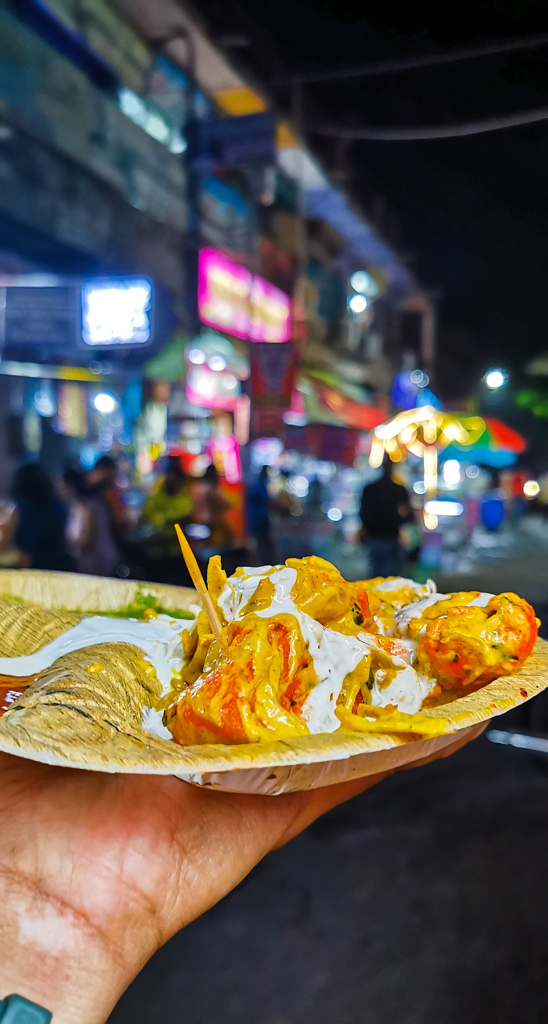
Day 3: Fatehpur Sikri- City of Victory
We woke up early to make it to the secret spot to view the Taj Mahal as well as a boat ride on the Yamuna. Unfortunately, the boat ride did not happen due to monsoons and the river being flooded. However, we did get to the secret place and were blessed with some beautiful captures. Check our other blog to know more about this place, link below.
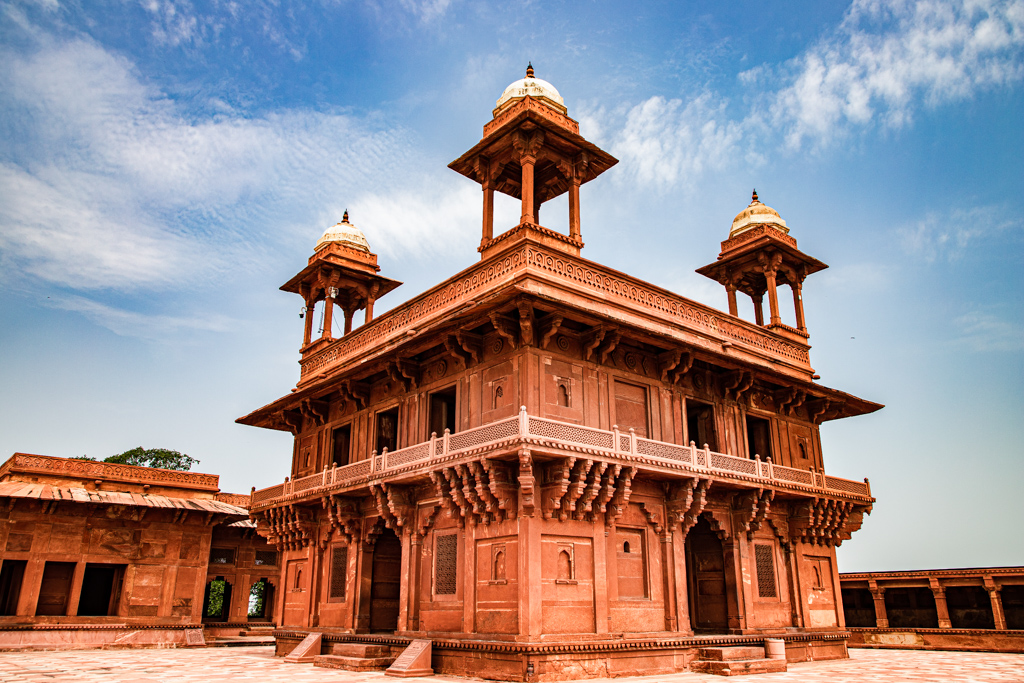
Tips: Try to avoid unauthorized guides who might pose as genuine. Qualified guides are available near the ticket counter. There is no standard price for the guides so fix up the rate and itinerary upfront before you hire one. We were absolutely amazed getting to hear wonderful stories from our guide Maan Singh who also entertained us with his pun and banter from time to time. We said our goodbyes and headed back to Agra.
Opening hours: Sunrise to Sunset
Ticket Price- Indian Visitors- INR 35 per person / Foreign Visitors- INR 550
Booking website- https://asi.payumoney.com/
Lunch at Pinch of Spice:

Mehtab Bagh:

Ticket Price- Indian Visitors- INR 20 per person / Foreign Visitors- INR 250
Visiting a rooftop restaurants to unwind:
We didn’t have many plans for this evening. Agra has some of the best rooftop restaurants, so decided to go for one such place – The Salt Cafe Kitchen & Bar. The ambiance and the décor were appealing and the staffs were courteous. We got to spend some amazing time here relishing the great food, sipping some refreshing cocktails, and indulging in some romantic conversations over live music. A few other rooftops that were recommended were Molecule Air Bar, Cafe Turquoise Cottage, Hichkee, Unplugged Courtyard all of which are highly reviewed.
Day 4- Taj Mahal 2nd Visit
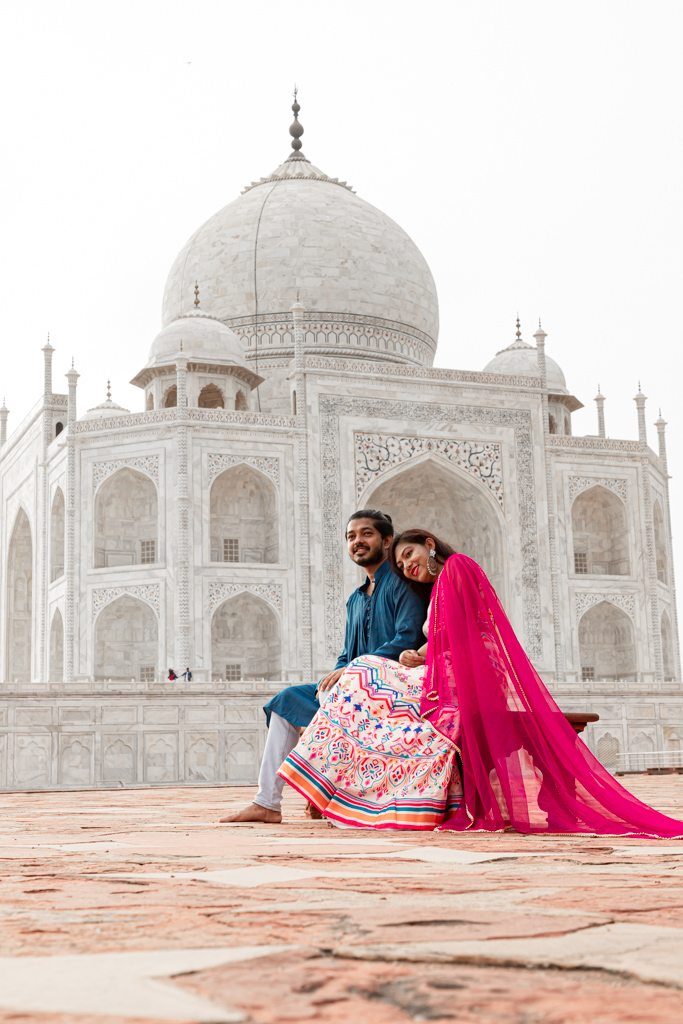
Rightly so the first day was cloudy and gloomy, not to mention crowded too. A lot of pre-wedding shoots were happening and we hardly got any shots we hoped for. The second visit was a blessing. Clear sky, fewer people and we were free to explore and capture all angles of the Taj. We sat down for a while and absorbed as much as magnificence to serving a lifetime. It was surreal to realize that we are amidst the top wonders of the world.
Itmiad Ud Daulah’s Tomb:

This fascinating tomb is undoubtedly a heritage that needs to be preserved, maintained, and explored by every traveltravelerute to Agra.
Ticket website- https://asi.payumoney.com/
Akbar’s Tomb:

Situated on the outskirts of Agra in Mathura National Highway Road, the tomb of the Great Akbar is open from 6 in the morning to 6:30 in the evening on all days except Friday. The ticket costs 20 for Indian visitors and 250 for foreign tourists.
Chini-Ka-Rauza:

Once upon a time, this architecture might have astonished many onlookers but today it is not what it used to be centuries ago.
The monument is open from sunrise to sunset and there is no entry fee.

Sheroes Hangout:
This place was one of the major places that we wanted to visit for lunch while in Agra. Sheroes Hangout is a cafe and community in India opened by an NGO, is a symbol of bravery, empowerment, and the fight against social stigma. Run by survivors of acid attacks this café has a modest menu of snacks, Indian bread, gravies, and Chinese dishes. Earlier they offered a ‘pay what you want’ model for the menu. But in recent years it was set to a fixed menu with a fixed prices model. The café aims to increase awareness about the brutality of acid attacks and forbid this act of violence. It has not only offered employment to its survivors but has given them the confidence to face society without any regret and earn a respectful living.
Unfortunately, the cafe was closed for a few days when we visited and couldn’t get a chance to meet these warriors/sheroes.
At our driver’s recommendation, we ate our lunch at a local restaurant named Taste of India in Tajganj. We opted for a combo meal. The ambiance was average but the food was tasty and also very filling.
Day 5- Soaking in the Sun and Chilling in the pool in a Vintage hotel

Sourab and Gloriya are travel bloggers who love to explore the world and share their experiences with their audience. They write in-depth travel guides, tips and hacks to help you plan your trips better and save money. Whether you are looking for the best places to visit, the best time to go, or the best way to travel, they have you covered. Follow their blog and discover new destinations, cultures and adventures.

How to plan your budget for the Maldives

Ella: Why you must visit this hill station in Sri Lanka?
You may also like.

The best things and activities to do in the Maldives?

Seychelles Wedding (Renewal of Vows)- #becausemarryingyouonceisntenough

Singapore: What makes this tiny nation one of the most visited destination on the planet?
Leave a reply cancel reply.
Your email address will not be published. Required fields are marked *
How to Visit Agra Fort: The Complete Guide
One of India's Most Important Mughal Forts
:max_bytes(150000):strip_icc():format(webp)/10947453_10153084623948270_8191342691038933499_o-591d1e8d3df78cf5fa731909.jpg)
The Taj Mahal invariably steals the spotlight in Agra but the city also has one of India's most significant Mughal forts. Four generations of influential Mughal emperors ruled from Agra Fort, while Agra was the capital of the flourishing Mughal Empire. The fort was among the first monuments in India to be declared a UNESCO World Heritage Site in 1983. It reflects both the strength and splendor of the Mughal dynasty, which dominated India over three centuries. This complete guide to Agra Fort explains its fascinating history and how to visit it.
Agra is approximately 200 kilometers (125 miles) south of Delhi, in the state of Uttar Pradesh. It's part of India's famous Golden Triangle Tourist Circuit but is also popularly visited on a day trip from Delhi.
Agra Fort sits about 2.5 kilometers (1.5 miles) west of the Taj Mahal, alongside the Yamuna River.
History and Architecture
Agra Fort was constructed in its current form by Akbar, the third Mughal emperor of India, in the 16th century. However, its existence can be traced as far back as the 11th century in historical documents. When Emperor Akbar decided to strategically establish a new capital in Agra in 1558, the fort had already gone through many occupations and wars. At the time, it was a brick fort known as Badalgarh, which originally belonged to Rajput kings.
The remains of the fort were in poor condition, and Akbar had it extensively rebuilt out of red sandstone. The work started in 1565 and was completed eight years later in 1573.
Agra Fort is considered to be the first grand fort of the Mughals. It was designed primarily as a military installation, with a colossal 70-foot high wall that stretched for more than 2 kilometers (1.25 miles) around 94 acres of land. Emperor Shah Jahan, Akbar's grandson, added fancy white marble palaces and mosques to the fort during his reign from 1628 to 1658. (A big fan of white marble, he also used it for the Taj Mahal). Shah Jahan's son, Aurangzeb, further expanded the fort by making an outer wall with a deep moat. The fort reportedly even has a secret tunnel for the royal family to escape through, although it has been sealed by the Indian government.
It's said that Emperor Akbar was inspired by Gwalior Fort, in Madhya Pradesh, and aspects of it were incorporated into Agra Fort. Shah Jahan later modeled the Red Fort in Delhi on Agra Fort, when he stated making his new capital there in 1638.
Despite the move to Delhi, Shah Jahan continued to spend time at Agra Fort. He even died in the fort, after power-hungry Aurangzeb imprisoned him there and took over the throne.
Agra Fort declined, along with the Mughal dynasty, after Aurangzeb passed away in 1707. The Marathas wanted to free India from the Mughals, and it wasn't long before they invaded the fort and seized it. Various parties continued to fight over the fort for the next hundred or so years, until the British took control of it in 1803.
The Indian Rebellion of 1857 added another twist to the fort's turbulent narrative. More than 5,000 people (about 2,000 of whom were British) shut themselves inside the fort for three months to escape the mutiny and unrest. The rebels attacked but ultimately were defeated. What's interesting to note is that this battle at Agra Fort is portrayed in Sir Arthur Conan Doyle's second Sherlock Holmes mystery, The Sign of the Four.
After India attained independence in 1947, the British handed the fort over to the Indian government. The Indian Army now uses most of it.
What to See Inside Agra Fort
Agra Fort is renowned for its magnificent architecture, incorporating Akbar's signature Islamic and Hindu styles. Apparently, he crafted hundreds of buildings with Bengali and Gujarati features inside the fort. Unfortunately, most of them no longer exist. Shah Jahan demolished some to make way for his extravagant white marble creations, while others were destroyed by the British when they set up barracks.
Jahangir Palace is Emperor Akbar's most notable surviving structure. He made it for his son, Jahangir, although the royal women resided there. Its robust and stately architecture strikingly contrasts with the more elegant and sensuous approach of Shah Jahan.
The sublime Khas Mahal, where Shah Jahan lived with his favorite wife Mumtaz Mahal, shows distinctive Islamic and Persian influences. It was adorned with pure gold and precious gems, and its white marble is covered in intricate etchings and floral inlay work. There are ornamented ceilings, fountains, alcoves, and lattice windows that look out across the river to the Taj Mahal. On either side are the Golden Pavilions, where Shah Jahan's daughters slept.
To the left of the Khas Mahal is Musamman Burj, an octagonal tower where Shah Jahan is thought to have been confined by his son until his death. It also provides an outstanding view of the Taj Mahal and has exquisite inlay work.
The wooden Diwan-i-Khas (Hall of Private Audience), next to Musamman Burj, was remodeled by Shah Jahan. It has more white marble inlaid with gemstones shaped into floral motifs. Most of this decorative work comes from Persian art and their love of flowers.
Shah Jahan's opulent Peacock Throne, made of gold and gemstones (supposedly including the precious Kohinoor diamond) was positioned in the center of the Diwan-i-Khas. It really must've wowed his important guests! Unfortunately, the throne was lost after Persian Emperor Nadir Shah looted it from the Red Fort in Delhi in 1739.
Further mirror work can be seen on the walls of the Sheesh Mahal, although it's not possible to go inside because the Archeological Survey of India closed it off. Other attractions include the three white marble mosques (Moti Masjid, Nagina Masjid and Mina Masjid) constructed by Shah Jahan, a marble public audience hall, courtyards, and gardens.
Those who watch Bollywood movies may also recognize backdrops from scenes in Jodha-Akbar and Mere Brother Ki Dulhan, which were partially shot at Agra Fort.
How to Visit Agra Fort
Agra Fort is open daily from sunrise until sunset. The best time to go is from November to February, when the weather is dry and not too hot.
Ideally, Agra Fort should be visited before the Taj Mahal, as it's an evocative prequel to the monument. Shah Jahan built the Taj Mahal as a mausoleum for his beloved Mumtaz Mahal after she died in childbirth. However, many tourists understandably choose to see the Taj Mahal at sunrise and go to Agra Fort afterwards, especially if they're on a day trip from Delhi.
Agra can easily be reached by road and rail from Delhi. Here are the best train options from Delhi to Agra, with the fastest ones taking about two hours. The Yamuna Expressway, which opened in August 2012, reduced the travel time by road from Delhi to Agra to less than three hours. It starts from Noida and there's a toll of 415 rupees per car for a one way trip (665 rupees round trip). Agra also has an airport that receives flights from major cities in India.
You'll find a multitude of companies offering day tours to Agra from Delhi, and they all include the Taj Mahal and Agra Fort. Alternatively, you can hire a car and driver.
If you're staying in Agra and looking for an inexpensive tour option, UP Tourism conducts full-day Agra Darshan sightseeing bus tours to the Taj Mahal, Agra Fort and Fatehpur Sikri. The cost is 750 rupees for Indians and 3,600 rupees for foreigners. The price includes transport, monument entry tickets, and guide fees. Half day tours, only including Fatehpur Sikri, are also offered. The cost is 550 rupees for Indians and 1,500 rupees for foreigners.
Although Agra Fort initially had four functional gates, two were walled up. Tourists can only enter through Amar Singh Gate on the south side. This gate was originally called Akbar Darwaza, as it was reserved for Emperor Akbar and his entourage. The fort's formal entrance was the lavish Delhi Gate, on the western side.
There's a ticket counter outside Amar Singh Gate. Tickets can also be purchased online here. Ticket prices increased in August 2018 and a discount is provided on cashless payment. Cash tickets now cost 50 rupees for Indians, or 35 rupees cashless. Foreigners pay 650 rupees cash, or 550 rupees cashless. Children under 15 years of age can enter for free.
Audio guides in various languages can be hired from a booth inside they fort's entrance. Allow a couple of hours to explore the fort, as there's quite a lot to see.
Do note that security checks are in place and certain items cannot be taken into the fort. These include headphones, cell phone chargers, electronic goods, knives, food, alcohol and tobacco products.
If you're really intrigued by the history of Agra Fort, there's a sound and light show there every evening, from sunset in Hindi and in English after that. Tickets can be purchased on the spot, and cost 200 rupees for foreigners and 70 rupees for Indians.
What Else to Do Nearby
Agra isn't a city that tourists usually want to spend a lot of time in. However, there are some other worthwhile things to do. This article lists the top places to visit in and around Agra .
Fatehpur Sikri in India: The Complete Guide
11 Places to Visit Around Agra Beyond the Taj Mahal
The Ultimate Guide to the Taj Mahal in India
12 Most Popular Historical Monuments of India
14 Famous Forts and Palaces in India that You Must See
Humayun's Tomb in Delhi: The Complete Guide
Delhi's Red Fort: The Complete Guide
20 Top Things to Do in Diverse India
How to Travel from Delhi to Agra by Train, Bus, and Car
10 Iconic Attractions and Places to Visit in Delhi
12 Top Historical Places in India You Must Visit
31 Top Things to Do in Jaipur, Rajasthan
Delhi's Jama Masjid: The Complete Guide
Jaipur's Amber Fort: The Complete Guide
The Best Day Trips to Take From Delhi
One Week in Delhi: The Perfect Itinerary
American and the Brit - Travel Couple
3 Day Guide To Agra
3 day guide to Agra – For the most part, tourists flock to Agra for one reason and one reason only and that is to visit the infamous Taj Mahal. Like everyone else, we decided to spend two nights and three days in Agra. Giving us the chance to visit the Taj Mahal in person. From what we read and heard online, visiting the Taj Mahal for sunrise is simply magical. Not only do you get to avoid the heavy crowds, but you also have the chance to explore the grounds at an extremely peaceful time. Watching the sunrise over the top of the Taj Mahal was a memory the both of us will never forget. If you are planning on making the visit yourself, we couldn’t recommend a sunrise mission more!

So if you’re like us, chances are you will spend more than just one day in Agra. For that reason we have written up a short, yet informative guide for you to help plan your few days here.
Candidly, Agra is a city that you can pretty much see in just one, or two days. Thus, if you follow our guide below, you will be sure to hit all the key destinations
How To Get There
Our journey to Agra was nothing short of an adventure. We were not quite ready to give the train a shot, so we opted to take an Uber. Fortunately this ended up being only a bit more expensive than the train anyway. Looking back on it now, we slightly regret not giving the train a go at that point. This is because our Uber driver got lost along the way! Luckily we booked an Uber premium, which gives you the fixed price prior to departure. Our biggest pro tip when using Uber in India is to book a premium car.
Generally it’s a bit more expensive than a regular car, but it is definitely worth it in the end. With all the traffic, closed roads, and detours, your fee is likely to rise once on the road. For the peace of mind spending a bit more up front is definitely worth it. Our 2 hour drive to Agra became a 6 hour journey and we were so glad the price was fixed. Anyways…I digress. You can get to Agra from New Delhi via Uber, or train. Pick your poison.
Additionally, if you are not on a budget you can hire a private car. There are many private car services that drive to and from Agra daily. This is great for those looking to just visit the Taj Mahal for a day trip. So if you are not keen on staying a night in Agra, this is probably your best bet. Prices are around $30-$50 per way.
Things To Do
Visiting the Taj Mahal is likely the soul purpose of your trip to Agra. If you are interested in reading our entire guide, with tips and tricks about our visit to the Taj Mahal click here . As you can imagine the photos of this place just don’t even do it justice. Once inside you will be blown away by its beauty. It was the highlight of our entire time in India and we felt so lucky to have had the chance to visit it on such a beautiful morning.
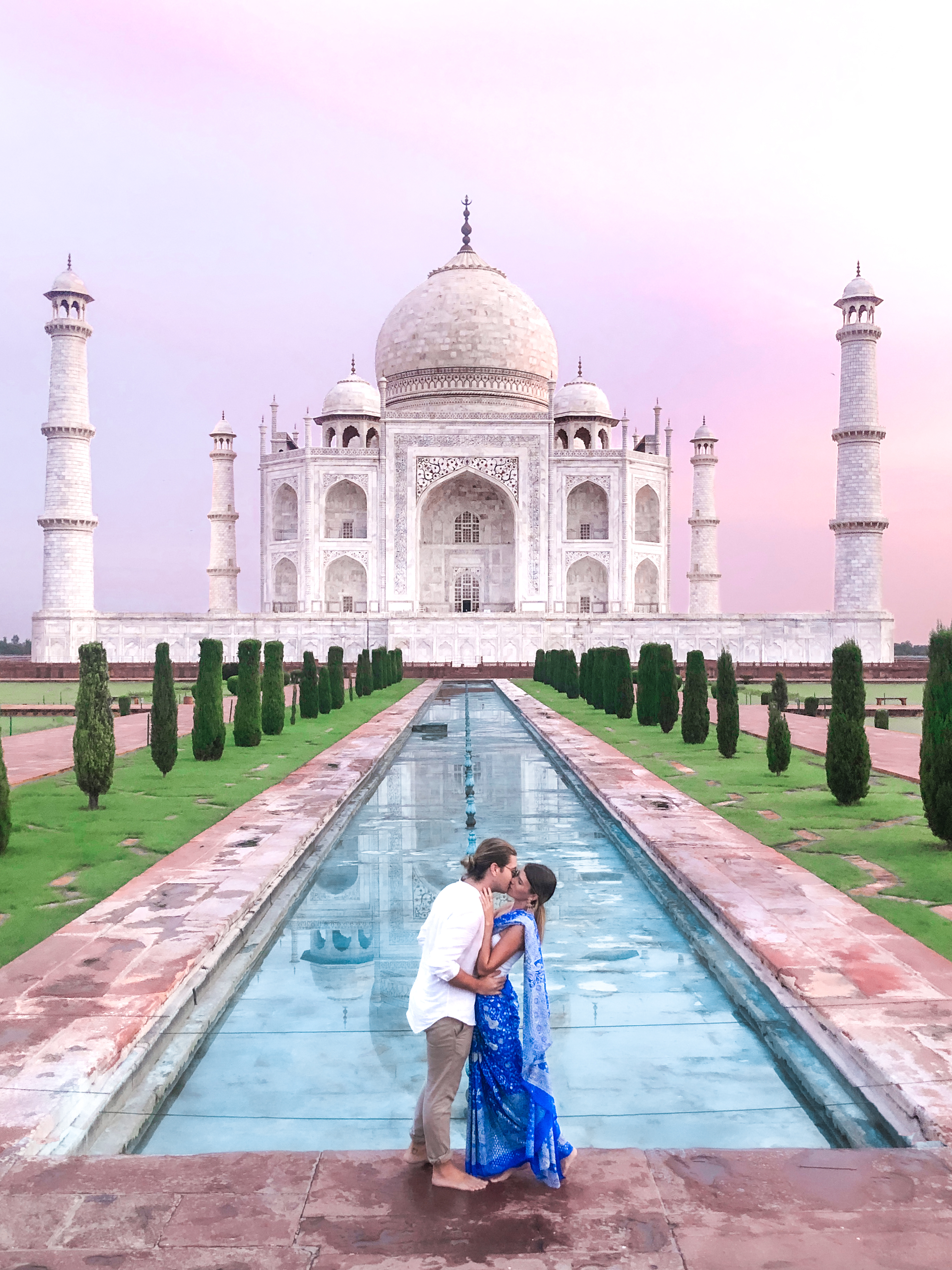
Bear in mind that tickets to the Taj Mahal are only valid for 3 hours, so pick your time wisely! This is something that is really not advertised at all. It only is written in small print on your ticket. If you overstay your three hours, you will be required to pay the entry fee again. Entry is 1,100 rupees per person.
Built in 1573 with the help of over 4,000 workers, Agra Fort was the main residence for the Mughals under the reign of Akbar- a great Mughal Emperor. It took nearly 8 years to complete and its expansive grounds are a sight to behold. We visited the Agra Fort early one morning and found that it was a great place to spend our afternoon. There are dozens of hidden walkways and tunnels you can explore. The fort also has a really great view of the Taj Mahal from the distance.
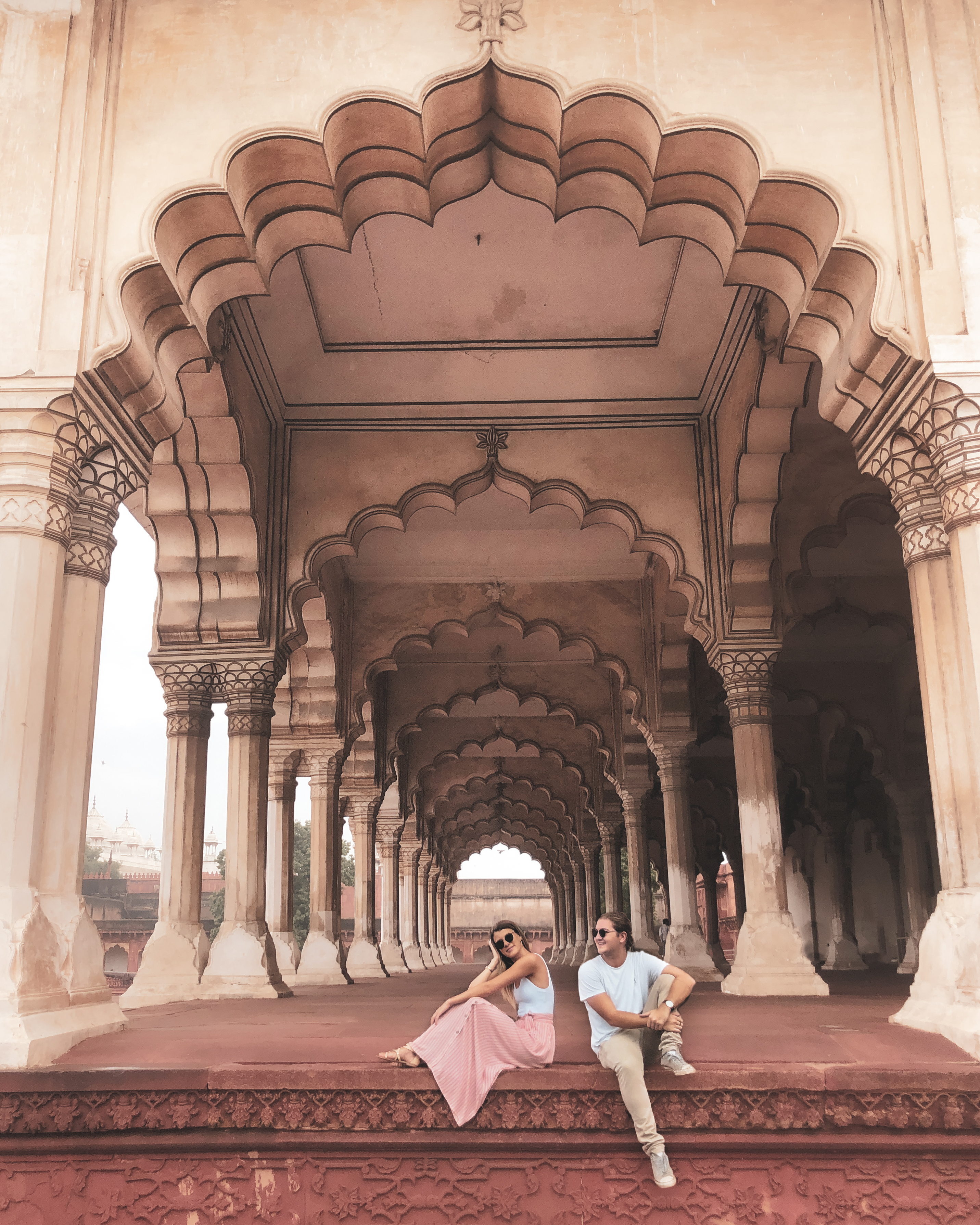
Tomb of Akbar the Great
If you have extra time in Agra, take a quick trip to the suburbs to explore the tomb of Akbar the Great. The tomb itself is very intricate. You can admire the red sandstone and marble geometric patterns of the structure, whilst walking around the surrounding garden.
Mehtab Bagh
If you are looking for one of the most famous places to photograph the Taj Mahal from a different perspective, be sure to check out Mehtab Bagh. Located opposite of the Taj Mahal, along the Yamuna River, this massive garden complex is a great place to visit for sunset, or early in the morning. If you go, you will be treated to some unique vantage points of the Taj.
Taj Mahal Secret Sunset Spot
This is another great spot to visit to get an epic view of the Taj Mahal. We have written an entire blog post on how to find this place, which you can read here . The best time of the day to go is in the late afternoon, or sunset hour. After taking pictures, it also makes for a great place to watch the world go by around you. We highly suggest you try to find this incredible spot!
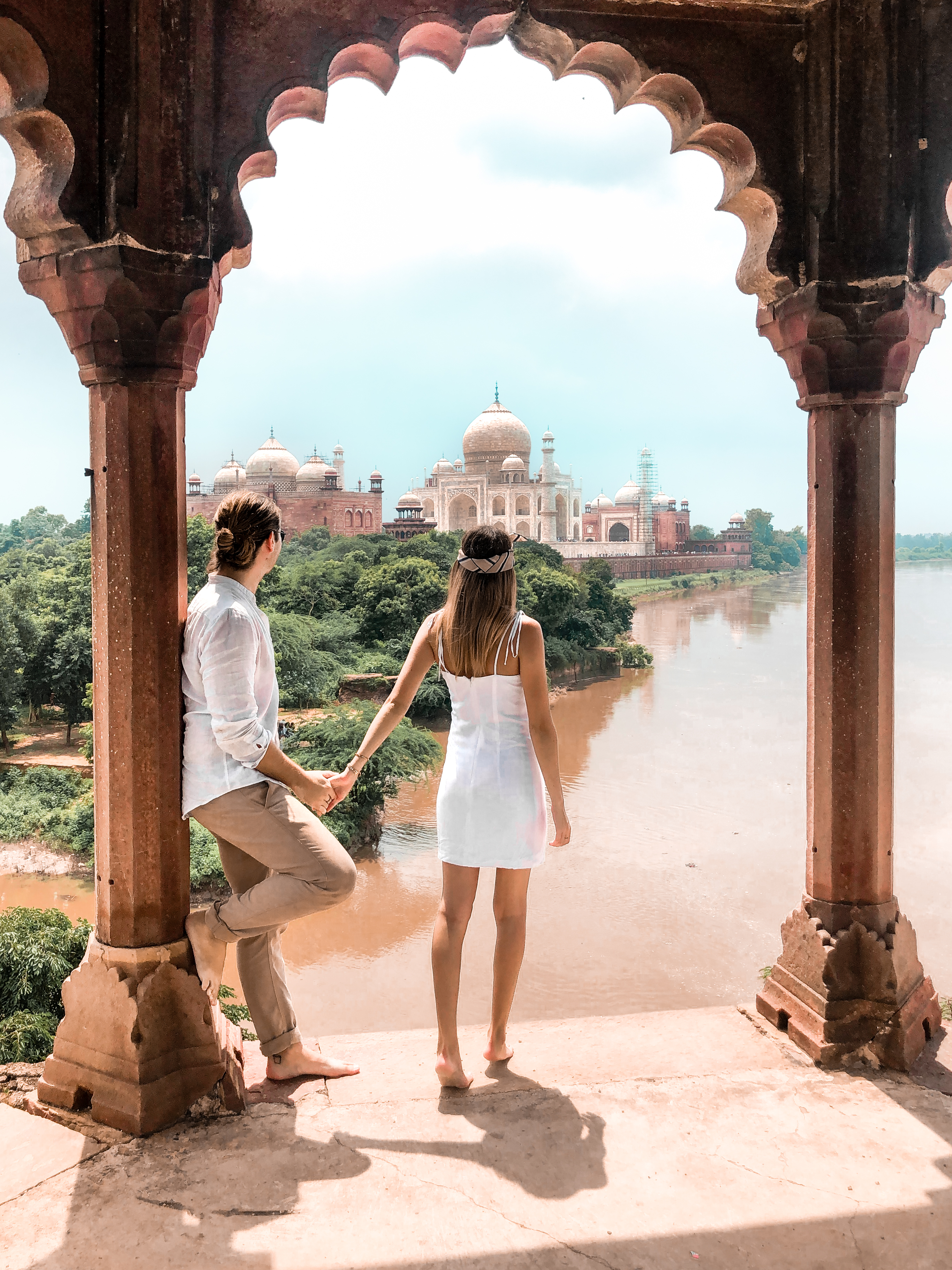
Places To Stay
Atulyaa taj hotel.
We stayed at the Atulyaa Taj hotel. Whilst it’s nothing too spectacular, it did have its major advantages. We loved the fact that it was just 600 meters away from the East gate entrance to the Taj Mahal. This made it very easy for us to access early in the morning for the sunrise. We also really loved the restaurant attached to the hotel. Agra had limited places to eat near the hotel, so we were happy with the food options provided. Also, if you are staying a few days, the hotel also has a rooftop pool which is an added bonus. Check out availability and prices here.
Where To Eat
As we mentioned before we really did not get out to eat much in Agra. This partly had to do with the fact that we were only there for 2 nights, but also because we enjoyed the restaurant inside our hotel. Breakfast was included in the stay and they made a great butter chicken dish we ate every night!
Overall, Agra is definitely a city you pass through on your time in India. That being said, we still recommend you spend at least 2 nights there so that you can get the full experience. We hope our guide provides you with some alternative activities and sights to see apart from the Taj Mahal during your visit to Agra.
You’ll Also Love
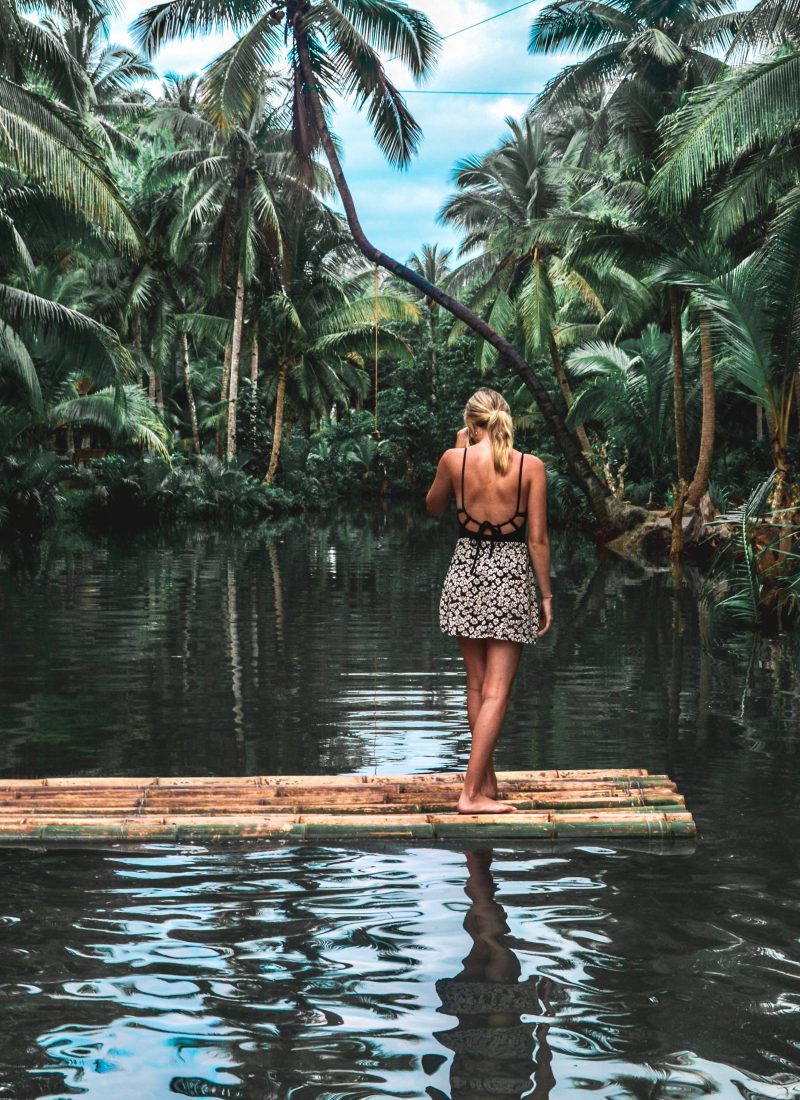
Leave a Reply Cancel reply
Your email address will not be published. Required fields are marked *
Please enter an answer in digits: 1 × one =
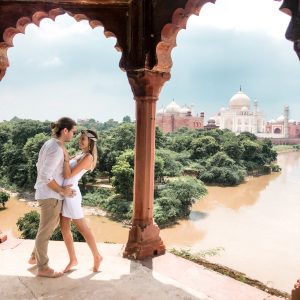
How to Find the Perfect View Point – The Taj Mahal

Follow @ americanandthebrit
Copyright © 2024 American and the Brit - Travel Couple · Theme by 17th Avenue

Travel Blogs
Ultimate Travel Guide to Agra Fort
Agra Fort is the second-most visited monument in the city, right after Taj Mahal in Agra. Agra used to be the capital of Mughal Empire and the fort was built as the royal residence. Previously also called as Badalgarh Fort. Later, this was one of the first monuments in the country to be tagged as a heritage site.
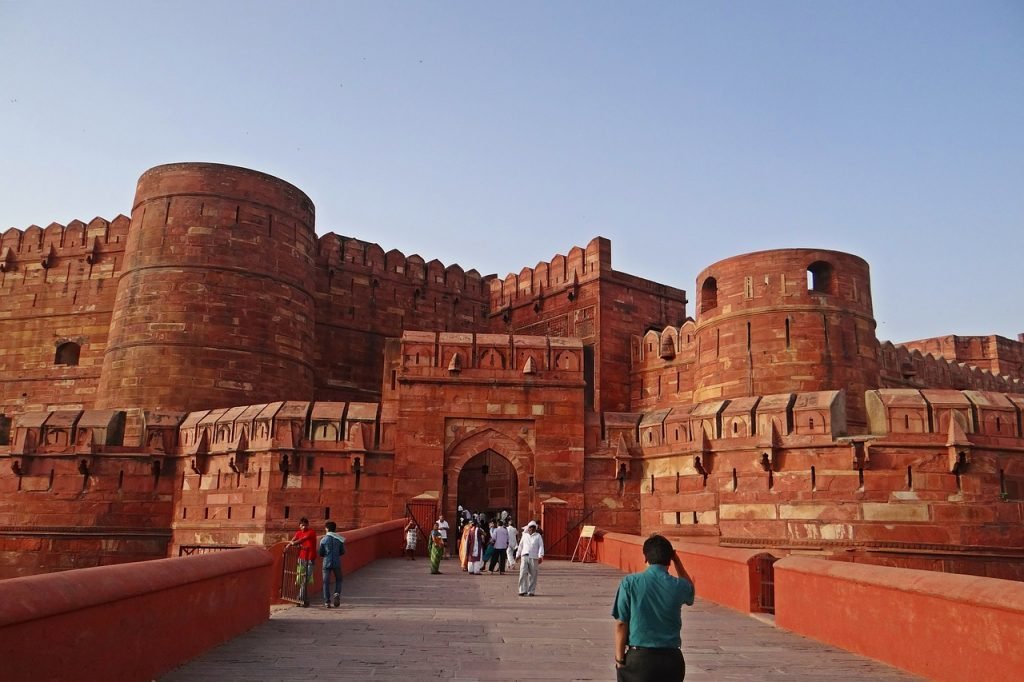
Explore the beauty of Agra with
- Same Day Taj Mahal Tour By Car From Delhi
- 2 Days Taj Mahal Tour By Car From Delhi
- Overnight Agra Tour
History of Agra Fort
The fort was built to the current form by Akbar, the Great of Mughal reign in 16 th century. However, the fort has been in existence since 11th century. By the time the fort fell into the reign of Akbar, the structure had undergone many battles and rulers. It is assumed to once belong to Rajput kings and it was called as Badalgarh.
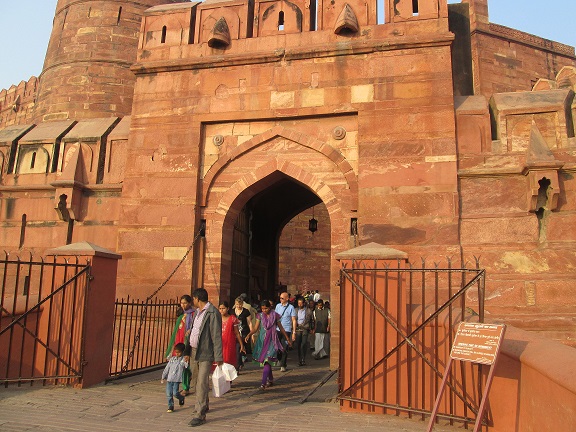
Badalgarh was entirely built with brick. When the fort reached Akbar’s hand, it was just a ruin. Akbar wanted to establish a capital in Agra and found the fort area to be strategic. He started to build a fort entirely out of red sandstone. The work started in 1565 and ended in 1573. Primarily, the fort was built as a military installation rather than a royal residence.
The 70-foot wall stretched for around 2 km of land. When the fort ended up under Shah Jahan, great grandson of Akbar in 17 th century, he tore down several palaces and structures inside the fort to make space for marble palaces. Later, his son, Aurangazeb expanded the fort’s outer wall into a moat and formed a secret escape tunnel.
After Aurngazeb’s death in 18th century, the Agra Fort was left to become a ruin. Marathas invaded and seized the fort. The other kings around the region fought with the Marathas for the hand on the fort. It moves from one reign to another for the next hundred years before ending with British. British used it as their military base. After independence, Indian army now uses a part of the fort.
Also read: Check out the list of adventure destinations in Himachal Pradesh?
Tourist attractions
The fort as a whole is a fine example of Islamic and Hindu style of architecture with Gujarati and Bengali architectural structures inside. Most of the architectural features were destroyed by Shah Jahan to build marble palaces.
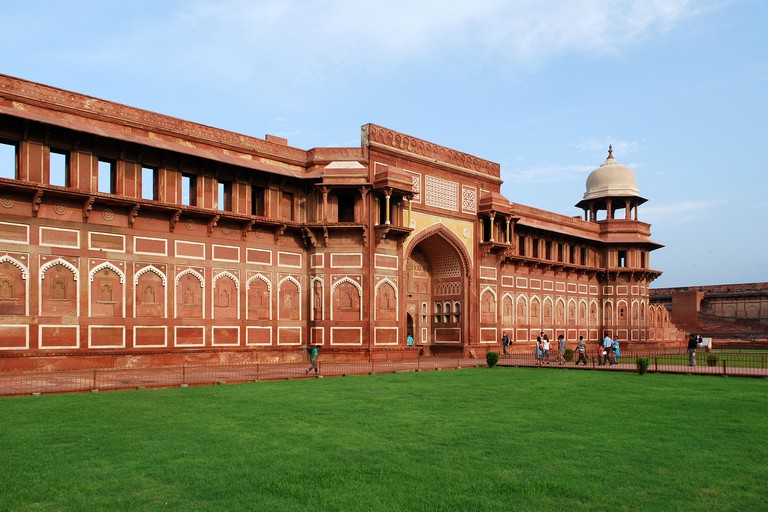
The fort has two main gates; The Lahore and Delhi Gate. Tourists should enter into the fort via the Lahore Gate.
The Delhi Gate was once the royal gate. It is now controlled by Indian Military. The gate is decorated with white marble. You can find wooden drawbridge and a moat in front of the gate. The inner gate is called as Elephant Gate because of the two elephant statues on the side. Delhi Gate is however not open for tourists.
The main building of the fort is the Jahangir Palace . This is the one of the beautiful structures built by Akbar, which still stands. This was built by Akbar for his Jahangir.
The Khas Mahal is where Shah Jahan lived with Mumtaz Mahal . This was built with a mix of Persian and Islamic features. The walls are covered with gold and precious gems with floral inlay work. You can find ornamented walls and ceiling, alcoves, lattice window, ornamented fountain and much more. From the lattice windows, you can spot the Taj Mahal and the river. You can also find halls of Shah Jahan’s daughters.
Musamman Burj is a tower in Octagonal shape. This is a fancy jail, where Shah Jahan was contained until death by his own son. It is said that Shah Jahan requested to be jailed in the tower as the tower has a good view of the Taj Mahal.
Right next to the tower, you can find a wooden hall of private audience, also known as Diwan-i-Khas. This hall has marble inlay work, floral motif and Persian art works. This hall is famous for holding the Peacock Throne, in the past.
This throne has the Koh-i-Noor diamond (one of the most valuable diamonds in the world) was initially located before Nadir Shah, a Persian invader looted it from the fort.
Must Read: Top 10 Tourist Places in North India for Winters
Best time to visit Agra Fort
Agra Fort is at prime beauty throughout the year. However, people prefer choosing winter season for its pleasing climatic conditions. The fort is open from sunrise to sunset. During government holidays, the fort tends to get very crowded.
Ticket Cost of Agra Fort
There is a small ticket counter right outside the Lahore Gate. You can also choose to buy tickets through online portal. The cost of the ticket is
- Indian – INR 40
- Foreigner – INR 550
- Children below the age of 15 are Free to enter.
You can also hire audio guides from the booth, right next to the ticket counter. The cost of the guide changes with season. It would take at least an hour or two to explore the fort. You can also buy tickets for the sound and light show , which is conducted every evening.
- Cost of show ticket for Indian – INR 70
- Cost of ticket for foreigner – INR 200
Check out the famous itineraries of Agra
How to reach Agra Fort?
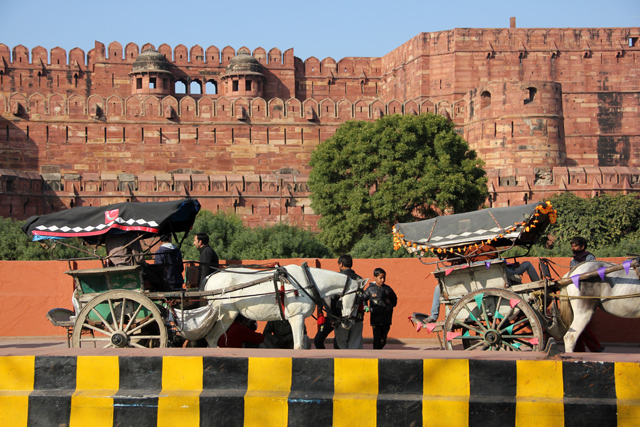
Agra is very close to Delhi. Delhi has a busy international airport that connects many important international destinations with India. You can also find flights from every major city in the country to Delhi .
From Delhi, you can choose to hire a cab, bus or train to reach Agra, which is 200 km away from it. Once inside Agra, it is easier to reach Agra Fort. This fort is located around 2.5 km away from Taj Mahal .
You can find auto rickshaws, cabs or other transportation from any part of Agra to Agra Fort. People usually combine Taj Mahal and Agra Fort visit, together. Taj Mahal is best visited during sunrise or sunset. So, Agra Fort is usually selected for a lazy afternoon exploration before or after enjoying Taj Mahal .
- How to Spend a Day in Agra – Ideas and Itineraries
- Top Things to Do in Agra in a Day
- A majestic trip to the land of palaces, Agra
- Taj Mahal is The Iconic Symbol of Love!
- Top Monuments and Historical places in and around Agra
Leave a Reply Cancel reply
Your email address will not be published. Required fields are marked *
Save my name, email, and website in this browser for the next time I comment.

Inside Agra Fort: Architecture, History & useful information for a visit
When you plan to visit the Taj Mahal , the one place that you must include in your itinerary is the Red Fort of Agra. Popularly referred to as Agra Fort, this mighty UNESCO World Heritage Site perpetually lives in the shadow of its glorious neighbor – the Taj Mahal. For most travelers to India, it comes second in Agra. This is where I tend to disagree and urge them to start their tour of the city with the Agra ka kila. It is a befitting prequel to what they would see later and most likely will help them to understand and appreciate the story of the Taj Mahal better.

The Agra fort in India was the powerhouse of the Mughals – where wars were fought, romance was born and power struggles were witnessed. It is the place where the story of Taj Mahal really began. As I walked through its grounds, I could well envision all those tales that I had read, and by the end of my tour- I was ready for the Grand Finale of the tale at the Taj.
In this Agra fort guide, I will take you on a journey through the key attractions of the 94 acres of this Mughal powerhouse along with its architectural highlights. You will soon, discover the connection between the Agra Fort and Taj Mahal. Along with the tour, I have included important information about Agra Fort like its timings and fees that will help you plan your visit. So let’s get going and immerse ourselves in the tale of this fortress that well predates -even the Mughals.
Planning a trip to Agra Fort or Taj Mahal?
In case you are looking for some quick links to tours, places to stay and travel accessories for your Agra trip, you can consider using these online options.
- Booking.com has several good Agra hotels listed on their site. You could use this link to browse and book the same.
- Viator.com offers several tours to the Taj Mahal and Agra fort. You have the option of booking skip-the-line tickets to the Taj Mahal and Agra Fort with a guide . Use the link to discover more like the private tour of Agra attractions , a walking tour of Agra city , transfers between Delhi and Agra etc.
- GetYourGuide has various local tours and car bookings available that you can use to explore Agra. Here too, you can book your Agra fort and Taj Mahal tour from Delhi as well as the skip-the-line tickets for the fort using the link given.
- For any of your travel needs or general shopping, consider using Amazon through this link.
- 1 History of Agra Fort in India
- 2 The architecture of Agra Fort Uttar Pradesh
- 3 The map of Agra fort
- 4.1 Amar Singh Gate
- 4.2.1 Akbari Mahal in Agra Fort
- 4.2.2 Jahangiri Mahal, Agra Fort
- 4.3 Ghaznin Darwaza
- 4.4 Khas Mahal in Agra Fort
- 4.5 Pavilions of Roshanara and Jahanara
- 4.6 Anguri Bagh
- 4.7 Shish Mahal of the Agra Red Fort
- 4.8 Babur’s baoli
- 4.9 Musamman Burj, Agra Fort (Muthamman Burj)
- 4.10 Diwan-i-Khas, Agra Fort
- 4.11 Machchi Bhawan
- 4.12 Nagina Masjid, Agra Red Fort
- 4.13 Diwan-i-Aam in Agra Fort
- 4.14 Ratan Singh ki Haveli
- 4.15 Moti Masjid
- 5 Agra fort timings and entry fees
- 6.1 What is the best way to reach Agra Fort?
- 6.2 What is the best time to visit Agra Fort?
- 6.3 Who built the Agra Fort?
- 6.4 What is the distance between Agra Fort and Taj Mahal?
- 6.5 Can you do Agra Fort and Taj Mahal as a day trip from Delhi?
History of Agra Fort in India
The Agra fort history goes much before its current structure came into existence. Historical evidence says that there was a brick fort built in the 11 th century. It is not very clear who built this old fort – then called Badalgarh . The earliest attribution to this fort is the Chauhan Rajputs. It was later occupied by Sikander Lodhi and later his son, Ibrahim Lodhi till 1526. The fort came into possession of the first Mughal emperor – Babur who won the battle of Panipat against Ibrahim Lodhi.

Delhi was the capital of the Mughal Dynasty in India while Babur and Humayun were the rulers. However, even they considered Agra as a strategic city and used Badalgarh as their stronghold when in Agra. In fact, Humayun was crowned king in this ancient fortress. Briefly, during his rule, he lost control of Badalgarh to Sher Shah Suri but soon gained it back after another battle.
It was Humayun’s son – Akbar who decided to make Agra a major city of his empire in 1573. This is when the Agra fort was built by Akbar using red sandstone from Rajasthan. This red fort in Agra took around 8 years to be constructed – around the same time as the grand tomb of Humayun in Delhi. There were over 500 buildings inside Agra Fort and it remained a powerhouse of the Mughals till Aurangzeb ruled.

While Akbar was the one to build it, it was his grandson Shah Jahan who changed a few things around and brought it to its present state. Where the grandfather – Akbar favored red sandstone, his grandson – Shah Jahan loved white marble – which is of course, evident in his most epic monument – the Taj Mahal. Shah Jahan broke down quite a few structures inside Agra Fort of Akbar and rebuild them as white marble palaces . It is this glorious combination of red sandstone and white marble that you must see as the story that led to the Taj. It was in fact, Shah Jahan who shifted the Mughal capital from Delhi to Agra .
The Agra Fort story continued with the Bharatpur Jats for 13 years after the Mughals. In the 18th century, the fort was annexed by the Marathas. During the British era, it became a center for the East India Company and also, a point during the 1857 rebellion. Today, part of the Agra fort is used by the Indian Army while the rest has been converted into a UNESCO World Heritage site that is open to the public.
The architecture of Agra Fort Uttar Pradesh

Agra Fort architecture is a fusion of Islamic, Persian, and Hindu styles . Primarily made using red sandstone, the entire fort is laid out in a semi-rectangular manner, quite close to the banks of River Yamuna. Planned more as a military stronghold, the Agra red fort has several defensive mechanisms – starting with its 2 km long double wall. Thes e 70 m high walls are interspersed with bastions and ramparts.

There are actually four gates to the Agra Fort. Inside the complex, at one point in time, there were 500 buildings – ranging from gorgeous palaces to courts, mosques and even a marketplace for the women. While not all still remain, there is plenty to showcase the architectural elements of the fort. You can still see a blend of Islamic and Hindu features in the ornate balconies, intricately carved stone screens and domed chambers of Jahangiri Mahal and Shah Jahan’s palace. And the best part, you have a beautiful view of the Taj Mahal from Agra Fort when you walk along these palaces.

The map of Agra fort
Here is an interactive Agra Fort Map that you can use when you visit this heritage monument. As you can see only a smaller part of this huge fort is available to the public. 70% of the place is occupied by the Indian army and is out-of-bounds.
What to see inside Agra Fort?

The layout of the Agra Fort is somewhat linear. It is fairly easy to navigate through the various sections of the fort – however, do keep aside at least 2 hours for your Agra Fort tour . I have visited this fort at least thrice and every visit took 2 to 2.5 hours
There are so many stories around the courtyards, the palaces, the royal gardens and the viewpoints along the corridors and balconies. Besides the tales, as a photographer, you will always find amazing photo opportunities – be that of the Agra Fort architecture or Instagram-worthy pictures. So, let’s begin our own virtual tour of the Agra Fort in Uttar Pradesh.
Amar Singh Gate

The Agra fort has four gates of which the most strategic one is no longer open to the public. This gate called the Delhi Gate was the one favored by Akbar and was known for its defence. A drawbridge over a moat full of crocodiles led to another smaller gate called the Hathi Pol (Elephant gate) where the guards were on elephants. The entrances were at 90 degrees and had an elevated slope that ensured that the enemy was vulnerable even before they entered the fort. This gate is now in the Indian Army section of the fort and one can only imagine its glory.

Today, t here is only one gate to enter Agra Fort – Amar Singh Gate, a smaller version of the Delhi gate . It has a similar layout with a small bridge of what remains of the moat. The gate was originally called the Lahore Gate. It was renamed by Shah Jahan after Amar Singh Rathod – a brave general in his army.
This is where I entered from and the first thing I noticed was the colorful mosaic designs along the façade of the 2nd inner entrance. Higher up on the inner gate are windows – through which flowers were showered down on the visitors to the fort.

The gates are tall enough for an elephant to enter and walkthrough. Past the guard room is an elevation that served as a defense mechanism. Not only did it slow down the enemy but if lores of the fort are to be believed, the offenders were sure to be crushed by rolling boulders even before they reached the end of the elevation. At every gate, don’t miss the holes from which the unassuming enemies were doused in hot oil.
Bengali Mahal
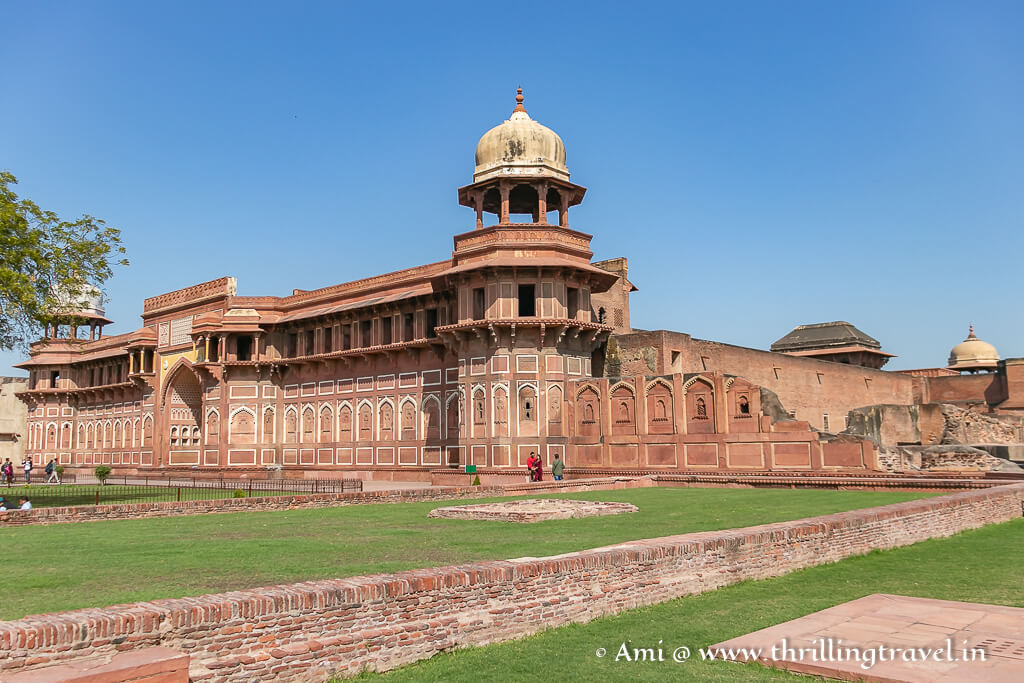
Bengali Mahal was the name to the palaces built by Emperor Akbar . It was called so owing to the Bengali style of architecture that involved the use of curved chhajjas (roof coverings), small courtyards and flat ceilings. The chhajjas in particular are termed as Bangladar – which is what I think got modified to the name of the palace.
The Bengali Mahal is distinctly split into two sections – the Akbari Mahal and the Jahangiri Mahal . Initially it even included the buildings till Musamman Burj but when Shah Jahan rebuilt that area and changed the sandstone palaces to marble, the Bengali Mahal became smaller.

When you exit the ramp from Amar Singh gate, you will be directed to the right. What you will find before you is the Jahangir’s palace – which is quite intact. To its right, closer to the walls of Agra fort, are ruins of the Akbar Mahal.
Akbari Mahal in Agra Fort

Though in ruins, you can still walk around what is left of Akbar’s palace. This part was the earliest section of Agra red fort. It used to have several mansions, smaller courts and a large step well (baoli). The British used this part as quarters for their Provost sergeant. Later they changed it to prison cells.

During Akbar’s time, there was a large section for his harem of over 5000 women . As per Abul Fazal (author of Akbarnama) , each lady in the harem was given a separate apartment and to ensure there was peace and efficiency, eunuchs and chaste women were hired to manage the system.

Walking around the ruins, I could spot the carved remnants of the lintels and the ornate brackets that might have supported the flat roofs and chhajas of the palace. At the far end, you even have a small opening that gives you a magnificent Taj Mahal view from Agra fort.

Akbar Mahal in Agra Fort is known for its secret passages – most of which are now blocked. As I walked towards the Jahangir Mahal, I could see the sub-level structures with some chambers – connecting the father and son’s palaces. I could well imagine, what the other secret tunnels might have been like.
Jahangiri Mahal, Agra Fort

As the name suggests, this was the palace of Jahangir. However, this was built by his father – Akbar and thus, you can still see it in red sandstone that he favored.
Before you step into Jahangir’s palace, you will pass this huge bath tub called Jahangiri Hauz . 5 feet tall, it has a Persian inscription that says “Hauz-i-Jahangir”. The interesting thing about it is that this is monolithic and was found in Akbar’s palace. The giant tub has small steps that lead into it on one side and is said to have been made for Jahangir.

Once you pass this, you come to the main entrance of what actually was the residence for the women of Akbar’s home. One look at the façade and I was able to discern the distinct Islamic and Hindu styles of architecture and design. The most obvious was the arched gateway that is very Islamic in its design while the jharokha windows are distinctly Rajputana styled. The intricate work along the walls are reflected the Persian influence while the floral patterns of its windows reminded me of the palaces of Rajasthan .
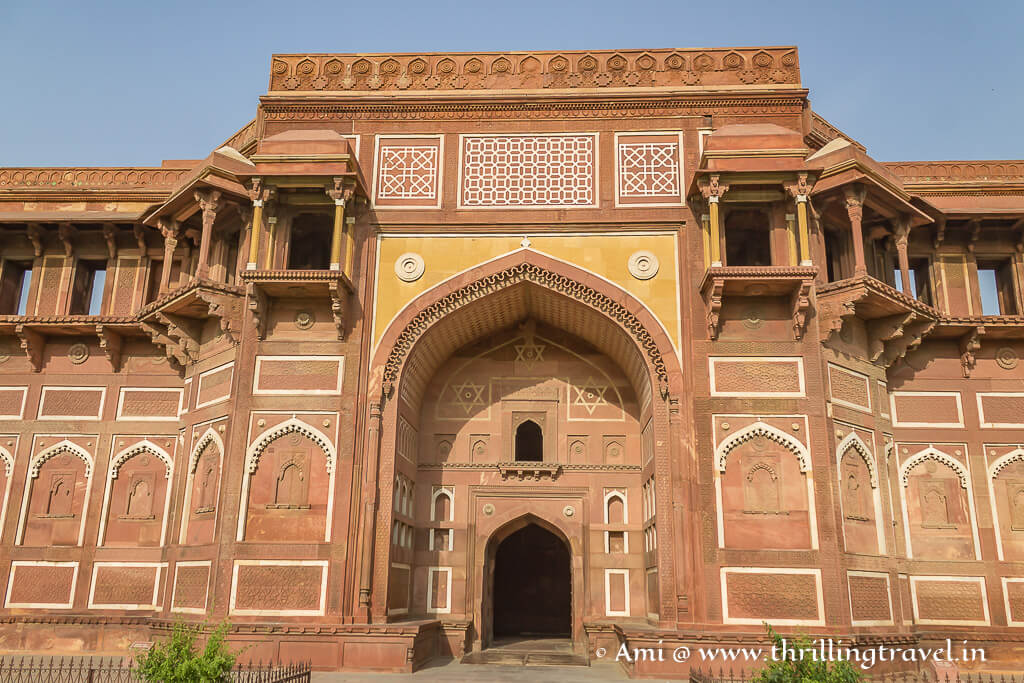
One of the interpretations of the six-pointed star on the doorway is that it symbolizes Christianity – in honor of one of Akbar’s wives who was a Portuguese Christian. Akbar was known for his religious tolerance and had established a unique faith called Din-i-Ilahi – which drew elements from various religions. This entrance is believed to have symbols of the same – with the arch representing Islam, the star of David for Christianity and the flowers for Hinduism. There is no historical evidence to this but if I were to compare it what I saw of Akbar’s palace in Fatehpur Sikri, I think there might be some merit to this interpretation.

The Jahangiri Palace is now home to several bats and I could actually smell the bat droppings in some of the chambers. It has a very deserted look now. However, back in those days, the courtyard came alive with song and dance as colored curtains separated the women watching from the enclosures from the men who graced the occasion.
Every door, window and pillar still has the remnants of its original design and the sheer number of them made me wonder, what patience the workers had back them to have done it all so precisely and beautifully.

There is a small terrace area that you can access through one of the doors – at the center of which are remains of what might have been a fountain. There are small water channels leading to it – which along with the breeze from the river bank must have made this area so cool and refreshing for the royalty. Even during my visit, I found some respite from the Agra heat by this window with an unobstructed view of the Taj Mahal.
Ghaznin Darwaza
This is a 11 th century ornate gate that has been kept on display between the Jahangiri Mahal and Shahjahani Mahal. It used to belong to the tomb of the muslim raider Mahmud Ghazni . It was never a part of the Agra fort .

Who brought it here and why is what makes an interesting tale. As the story goes, the British wanted to earn the favor of Indian people in 1840s. So, the Governor General at that time – Lord Ellenborough brought this gate from the tomb stating that the door was the original sandalwood one that belong to the historic Somnath temple . He claimed that he had brought it here to avenge the insult that Mahmud Ghazni had heaped on the locals when he stole it from the temple.
Turns out that this was one big fat lie . First the door was not sandalwood but made of deodar wood. 2 nd there are inscriptions in Arabic mentioning Mahmud Ghazni. And most importantly, the design itself was not Gujarati. After some debate in the House of Commons back in England, the truth was agreed upon and since then this gate has been left in the Agra Red fort.
Khas Mahal in Agra Fort

The red sandstone palace of Jahangir is attached to the white marble Khas Mahal. Also, called as the Shahjahani Mahal , this gorgeous white building is set between two golden pavilions. Complete with fountains and stunning inlay work, this palace was the bed chambers of Emperor Shah Jahan.

Every inch of the place is covered with floral etchings. The rich alcoves with their jhali screens is where you can creatively position your camera eye to get that first glimpse of the Taj Mahal.

The Khas Mahal was built after destroying the original sandstone structure made by Akbar ( earlier part of the Bengali Mahal) . The cool interiors and the breeze from Yamuna river still gave me a good respite from the summer heat, making me wonder how lovely it might have been with those fountains and the whole palace lit with candles on a full moon night. Magical!
Pavilions of Roshanara and Jahanara

The two golden pavilions – one on either side of the Khas Mahal are just unmissable. These are named after Shah Jahan’s daughters – Roshanara and Jahanara . While they might appear as a viewpoint for the Taj Mahal , they are believed to be the bed chambers of the princesses.

To me, the rooms did seem small for a princess but I guess that the rest of the courtyard around it formed their mini palace. I sure would not have minded these small rooms, for the view from them was just spectacular!
Anguri Bagh

If you thought that fountains at Khas Mahal were magical, what is beyond it was just mesmerizing. A gorgeous garden called as the Anguri Bagh (Grape garden) completes the landscape of the Khas Mahal. In glory days, the water from the fountain flowed along a white water slide to form an artificial stream through a garden of flowers.
Along the perimeter of the garden is the Zenana section of the palace where various ladies of the Harem stayed in complete privacy. This garden and its refreshing fountain was enjoyed by the royal ladies.
Shish Mahal of the Agra Red Fort

The Glass or Mirror Palace of the Agra Fort is no longer open to the public and you can only see it from the entrance. However, even then the glimmer of the Syrian mirrors in the Shish Mahal does not fail to dazzle. Our guide explained that this was the Shahi Hammam or the Bathroom of Mumtaz Mahal. As amusing as this was, it was not true as challenged by the signboard next to it.
This was the summer palace of Shah Jahan , complete with water fountains and streams that aimed at not just beautifying the palace but cooling its interiors. They say that a single lamp lit within the palace twinkled through its many mirrors to light up the entire structure. There is no way to ascertain that right now but you sure can admire the gorgeous interiors even from that restricted entrance.
Babur’s baoli
The first Mughal king – Babur had built a step well or a baoli in the old brick fort – Badalgarh. This was a three-floored baoli that had a mechanism to raise the water and channel it to the other parts of the fort. It is possibly the oldest remnant of this fort.

Akbar built on top of Babur’s baoli and enhanced the water system for the new red sandstone fort. This further changed with the Shahjahani palace and only a fragment of the original baoli remained in the basement. While I could not see this, there was a sign on the spot telling me about this epic spot. You can find this when you walk from the Sheesh Mahal to the Musamman Burj.
Musamman Burj, Agra Fort (Muthamman Burj)

This is by far the most important part of Agra Fort. The place where Shah Jahan was imprisoned by his own son – Aurangzeb, where he spent the last 8 years of his life, pining for his dead wife. It is here that he breathed his last while gazing at his beloved Taj Mahal.
The Musamman Burj is an octagonal chamber that you can only see from a distance. A sunken fountain greets you at the entrance which in its simple white marble form adds to the rich interiors of the place. I was quite mesmerized by the grandeur of the walls that are completely covered with floral engravings. The small grooves seemed like the place to hold candles while at the far end I could spot the balconies that had the Taj Mahal in clear sight.

I got an even more clear view as I stepped into the Diwan-i-Khas. The Musamman Burj with its octagonal pavilion atop its terrace and open balconies below seemed perfect for the cool Yamuna breeze in the evening. I could well imagine how gorgeous the Taj would have looked at sunrise when it turned pink. Something that I think Shah Jahan found peace in while being locked in.
Diwan-i-Khas, Agra Fort

The Hall of Private Audience or the “Diwan-i-Khas” was my next stop from the Musamman Burj. Climbing up the stairs, past Shah Jahan’s private mosque – Mina Masjid, I emerged to a lovely white structure with tall pillars, placed at a height. Intricate marble work with flower designs over tall arched doorways beckoned me to enter, except that this area too, could only be inspected from afar.

A close shot of the same decor showed Persian scripts etched on the walls. The writing was in praise of Shah Jahan who was responsible for this lovely hall. The Agra Fort Diwan-i-Khas was used in two parts – the outer hall for dignitaries that were important but less so and inner hall for the high-level meetings. The famous Peacock throne of India which no longer is with us, used to be kept here as a throne till it was shifted to Delhi.

A glimpse over the low walls of the palace allowed me to see the Yamuna entrance gate. It is from here that Shah Jahan’s body was taken in a boat over to the Taj where he was finally buried with his beloved.
Machchi Bhawan

The large terrace adjoining the Diwan-e-Khas along with its hallways of various chambers is what is referred to as Machchi Bhawan. Machchi means Fish and the name came from the various pools and fountains here that were home to fish. A large marble platform overlooks the entire area and the purpose of it, as per our guide, was to allow the Emperor to see the proceedings of the courtyard below.
The large space on the ground floor is where a market was held for the women of the Agra Fort. The surrounding rooms belong to the various offices of the court – from accounts to trade – the staff used to sit in those rooms.

In the terrace itself, you can see a black throne that overlooks the Musamman Burj. This black onyx throne is associated with Emperor Jahangir. There was a time when he defiantly became a traitor and opposed his father Akbar. He sat on this throne and declared himself King until he was overthrown by Akbar’s army.
A large gate at the far end leads to the Zenana Area of the fort. The place was originally built by Akbar and modifications were made later by Shah Jahan. Evidence of this is in the fact that the pillared hallways on the first floor are all white marble while the ones below have red stone.
Nagina Masjid, Agra Red Fort

Diagonally opposite to the Diwan-e-Khas of Agra Fort, is the entrance to the Nagina Mosque. It is a very simple but elegant white mosque that was built by Shah Jahan for the women of the Royal family . It has three domes with an inverted lotus design on its apex. Its arched alcoves adds to its elegance and makes the small masjid really picturesque.

Stepping barefoot into the masjid made me aware of how cool and refreshing the marble flooring felt after a long walk through the Agra Red Fort. It was then that I appreciated Shah Jahan’s love for this construction material.
Below the masjid was the space where the Meena Bazaar was held for the women of the zenana to buy their wares. The Meena Bazaar is where the romance between Jahangir and Nurjahan bloomed. While you can no longer visit this area, a glimpse of it is sure to take you back in time to what might have been a bustling market for women.
Diwan-i-Aam in Agra Fort

The Hall of the public audience lies on the ground floor of Agra Fort. If Diwan-i-Khas was about impressing the other royals, the Diwan-i-Aam was about flooring the common with its majestic proportions. The Emperor’s seat is in white marble at a height that overlooks the large red hall below. This is where the courtiers stood. Far beyond on the grounds is where the subjects stood with their woes. A clear distinction of a class is visible here. For the king – his seat provided an overview of his world and for the peasants, clear respect and class of their Overlord.

Within the grounds, you will also, find a large cannon left from the days of the British as well as the grave of John Russel Colvin , a British who died in the 1857 rebellion. There are gates that lead you out of the palace on either side but one of them is closed to the public for it leads to the Indian Army area.

Ratan Singh ki Haveli
This is a small haveli built by the Bharatpur Jats in the 18 th century. It is close to the Diwan e aam and reflects the Rajputana style of architecture. I have only managed to see it from the outside as I always run out of time by the time I reach this point.
Moti Masjid

This is one attraction of the Agra Fort that is totally out of bounds for visitors. You can view the pearly white domes of this masjid rising over the red sandstone wall near the Diwan -e aam. The mosque was built by Shah Jahan and has red sandstone on its external façade. However, the interiors is completely made with white marble. I am told that it is a sight to behold. Maybe some day I will get lucky and get to see this for myself. For now, I am just content capturing the seven domes of this elegant mosque.
There are plenty of more gems inside Agra Fort that you are bound to see. And then there are some which you can’t like the mysterious underground passages. However. the place gives you the right background of how life was with the Mughal royalty -especially that of Shah Jahan. You can actually see the place where he lived happily with his Beloved, how he spent his evenings with her, how he ruled the place, where his childhood was and finally, where he ended his life. This was the place where he was the happiest and also, the saddest. If you are in town to see the epic monument of love, don’t forget to start with the Agra Fort – the place where it began and it ended – the prelude to the famous Taj Mahal.
Agra fort timings and entry fees
The timings of Agra fort are from 6 am to 6 pm on all days . The monument is open on all days of the week.
The Agra fort ticket price differs for Indians, SAARC residents and other foreign nationals . They are as below –
- Entry fees for Indians and SAARC nationals – INR 50 per adult
- Agra fort fees for foreigners – INR 650 per adult
If you book an online ticket for Agra fort, you get a little discount. Tickets for Indians are at INR 35 per adult and foreigners can buy it for INR 550 per head. You can book the tickets directly from the ASI site or get the skip-the-line tickets from Viator or GetYour Guide .
Common FAQs about Agra Fort
What is the best way to reach agra fort.
Agra Fort is right in the center of Agra city and can be easily reached using the local tuk-tuks or cabs. To get to Agra city, you have three options –
By Air : The nearest airport to Agra Fort is the Agra Airport (AGR) at a distance of 13 kilometers. However, Agra Airport has limited flight options, and most domestic and international travelers prefer to arrive at the Indira Gandhi International Airport (DEL) in Delhi. From there, you can opt for road or rail transportation to reach Agra.
By Road: Delhi is around 230 km from Agra and is well connected with the Yamuna Expressway. The approximate travel time between the two cities is around 4 hours.
There are regular buses to Agra from Delhi. These include private and government buses and can be booked online. You can also, get an outstation taxi from these cities or opt for private transfers (that sometimes include a guide).
If you are in Jaipur, you can use NH21 which takes you via Fatehpur Sikri to Agra. The travel time on this road is around 4 to 5 hours. The road conditions are excellent and you can even plan to stop at Bharatpur or Fatehpur Sikri on the way.
By Rail : Agra fort railway station is the nearest train stop to the fort. Alternatively, you can even get off at Agra cantonment railway station which is just 5 kms away. There are numerous trains throughout the day that connect Agra to all the major cities of India.
What is the best time to visit Agra Fort?
The best time to visit Agra Fort is during the winter- that is October and March – when the weather is pleasant. The temperatures during this period range from around 8°C (46°F) in the mornings to 25°C (77°F) in the afternoons, making it comfortable for sightseeing. Visiting early in the morning or later in the afternoon is recommended to avoid the peak heat of the day. The fort opens at sunrise and closes at sunset, providing ample time to explore its magnificent architecture and historical significance. During summers, Agra experiences extreme temperatures. This is usually between April to June and the temperatures rise to over 40°C (104°F). It can get quite draining to explore this Fort which is likely to take at least 2 hours.
Who built the Agra Fort?
The current red sandstone Agra Fort was made by Akbar in 1573. It took around 8 years to build. Later Shah Jahan modified some of the sandstone buildings to the current marble palaces.
What is the distance between Agra Fort and Taj Mahal?
The distance between Agra Fort and Taj Mahal is just 2.5 km.
Can you do Agra Fort and Taj Mahal as a day trip from Delhi?
It is quite possible to do a day trip to Agra fort and Taj Mahal from Delhi. There are several day tours available from Delhi that can be booked online and will help you cover these two heritage sites well. You can even plan and do this trip on your own by opting for an early morning bus, train or cab to Agra from Delhi.
Before you go, pin this

Popularly referred to as a Restless Ball of Energy. My Mom refuses to entertain my complaints about my equally restless daughter & assures my husband that I was born with a travel bug.
I am a Post-Graduate in Marketing by qualification and a travel blogger by passion. Besides travel, I enjoy photography and if you don’t find me at my desk, I would be out playing badminton or swimming or just running. I believe in planning for every long weekend through the year. And when I cannot travel physically, I travel virtually through this travel blog. My travel stories have also, got published on various websites and magazines including BBC Travel, Lonely Planet India and Jetwings. I have recently published my first book – When Places Come Alive – a collection of stories that are based on legends, landscapes, art and culture of a place which is available in both ebook and paperback format.
You might also like these posts –
- The best time to visit Taj Mahal Agra
- How to enjoy a Sunrise at Taj Mahal? – What to expect, tips & tricks
- A guide to Mehtab Bagh Agra : how to get there, timings & history
- 15 interesting facts about Humayun’s tomb & your reasons to visit it
- All about Humayun’s tomb garden: Inside Humayun tomb, plan & history
- How to plan a trip from Delhi to Jaipur by road?
Leave a Comment Cancel reply
This site uses Akismet to reduce spam. Learn how your comment data is processed .
Complete Travel Guide to Agra Fort: History, Entry Fees, and How to Get There
Agra in Uttar Pradesh state has been undoubtedly one of the most visited cities in India, thanks to the magnificent Taj Mahal. The white marble structure by the Yamuna River was built by the Mughal emperor Shah Jahan for his beloved wife Mumtaz Mahal. While it is definitely a reason why tourists flock to Agra, we cannot deny the charm of the equally mesmerizing other monuments and one of them being the Agra Fort adjacent to it. Built of red sandstone entirely, the UNESCO heritage site is also famously called the Lal Qila. It is a testament to the royalty of the Mughal architecture and their regal way of living. The Agra Fort light and sound show is an unmissable part when you visit the city.
To plan a visit to the Agra fort, make sure to select a stay that is close to these monuments. This will not only save your travel time but allow you to explore the splendid fort at your own pace. Make it hassle-free by booking a suite at the Jaypee Palace Hotel & Convention Centre in Agra . But to be well-planned ahead and know about the Agra Fort history, Agra Fort timings and the Red Fort Agra ticket price will only make your exploration a lot better.
When visiting a historical place, it is very important to know a bit about its history. Know some interesting facts about it. This 70-foot-tall structure was created of red sandstone which gave it the popular moniker of the ‘Lal’ (red) ‘Qila’ (fort). The structure even from before the 11 th century got its actual glory as a red fort when the Mughal emperor Akbar decided to rebuild it with red sandstone.
In the 16 th century, this vast fort area was built in eight years, which was connected to the Taj Mahal. Some of the structures inside the fort were later rebuilt by Akbar’s son, Emperor Shah Jahan using white marble. Agra Fort is also the place where Shah Jahan was imprisoned by his son Aurangzeb till his death. It is said that Shah Jahan asked Aurangzeb to prison him inside this fort so that he could watch his wife’s tomb (Taj Mahal) visible easily from there. Post Aurangzeb’s death, the fort was captured by Marathas and later taken over by the British rulers.
Post-Independence, the Indian government overlooks its management.
What to See?
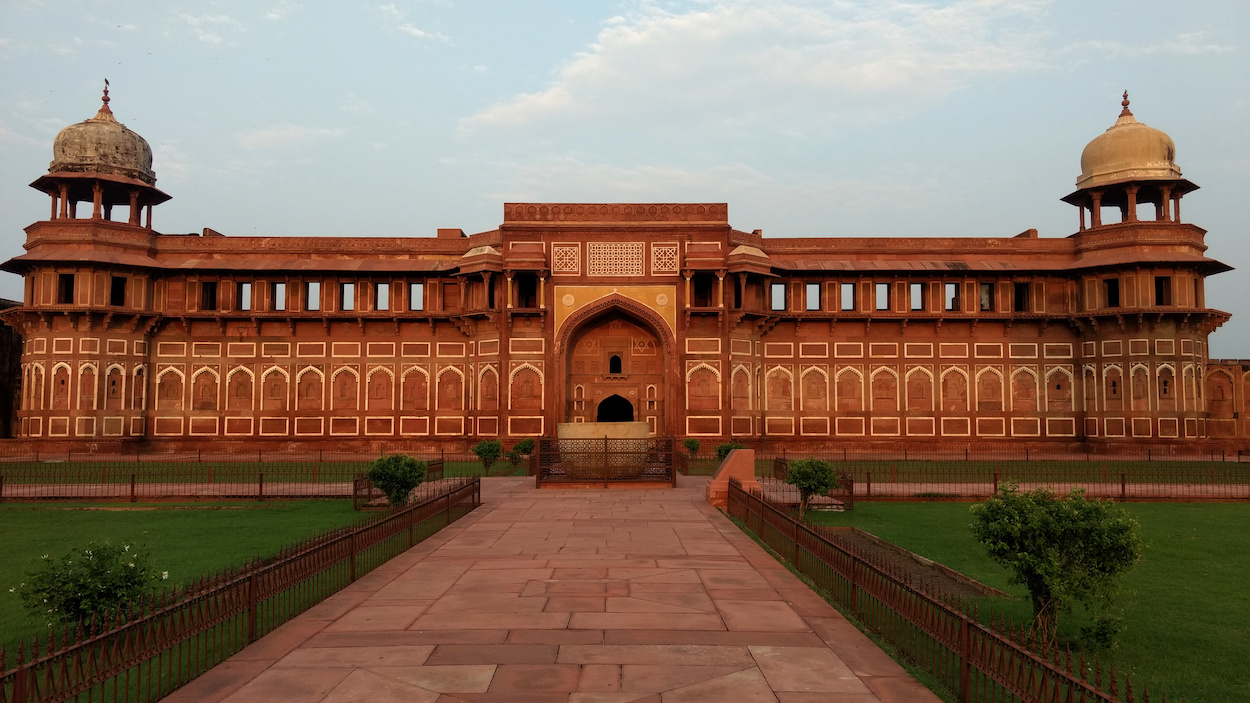
Even though there are four gates to the fort originally, the only gate that allows entrance is the Amar Singh Gate. You will get to see a plethora of structures, a museum and gardens inside the fort. Some of the unmissable sight-seeing spots are Jahangir Palace, Khas Mahal, Diwan-I-Am, Diwan-I-Khas, Sheesh Mahal, Anguri Bagh, Jahangir’s Chain of Justice, Musamman Burj to name a few. The best time to go around the evenings as the entire structure is brightly lit giving it a lustrous vibe. The Agra Fort light and sound show is a must-see when in Agra. It is conducted in Hindi and English languages separately for one hour between 7 pm to 9 pm. This show is held in the Diwan-e-Aam area and narrates the history of the Agra fort engagingly.
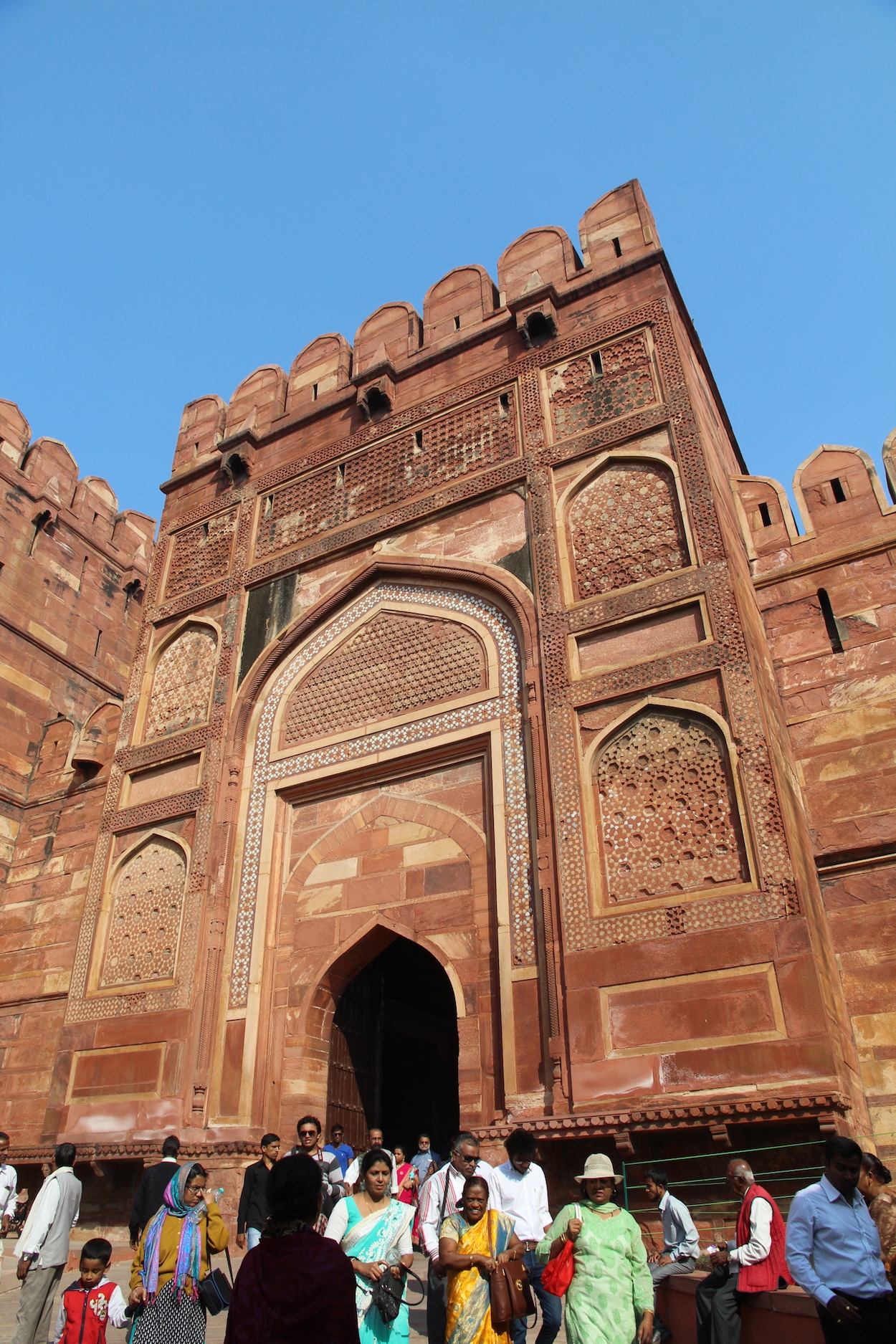
Agra Fort Ticket Price
You do not have to scout for the Red Fort Agra ticket price as we have all the basic details queued up for you. The entry fee for Indians is Rs 50 per person for adults and children below 15 years are allowed to enter for free. The Red Fort Agra ticket price for foreign visitors varies. Foreign tourists above 15 years of age have to pay Rs 650 per person. On Fridays, they must pay Rs 600 for an entry ticket.
The Agra Fort light and sound show tickets are as follows:
- Adults: Rs 70
- Students: Rs 40
- Foreign tourists: Rs 400
- Children below 15 years: Free
How To Get There?
You can reach Agra Fort by railway, airport or vehicle. The nearest railway stations are Agra Cantt, Agra Fort, and Raja Ki Mandi. You can also directly fly to the city as the Pandit Deendayal Upadhyaya or Agra Airport is 5 km away from the main city and well-connected to cities like Delhi, Jaipur and Lucknow. There are also local buses, cabs and autos to commute internally.
And make your Agra visit a lot more enjoyable by staying at the Jaypee Palace Hotel and Convention Centre, a five-star luxurious hotel with modern facilities. It is located just a few minutes away from the Agra Fort, the Taj Mahal and the commercial hub of the city. Stay like royals in this lavish hotel made of Mughal-style architecture including red sandstone and white marble décor. You can explore five restaurants, a spa, a gym, unique amusing packages and a comfortable stay in one of the plush 341 rooms with contemporary amenities. So, next time you are planning to visit Agra Fort, do check out Jaypee Hotels website.
References – How to Spend Three Days in Agra and See the Taj Mahal?
Top Must-Visit Golf Courses in India – A Sporty Journey
Best locations for a memorable pre-wedding photography experience, related articles, complete guide: akshardham temple delhi, ticket price, laser show timing, best spots to watch the sunrise in mussoorie, uttarakhand, leave a reply cancel reply.
Save my name, email, and website in this browser for the next time I comment.
Automated page speed optimizations for fast site performance
Complete Travel Guide to Agra Fort
It is true that Taj Mahal gets all the attention from those who visit Agra. However, the second commonly visited monument is Agra Fort. This is one of the most elegant pieces of architecture, which has stood through four generations of Mughal Era. This is one of the first monuments to be declared as heritage sites in India. Mughals recognized the Agra Fort as their symbol of strength and prosperity. If you are visiting Agra, you ought to visit Agra Fort. Explore the Complete Travel Guide to Agra Fort.

Suggested tour package: Overnight Agra Tour
Read more - How to Reach Agra from Delhi?
Agra Fort Attraction
Agra Fort can be reached from any part of the city. You can find buses, cabs, rickshaw and other road transportations to reach Agra Fort from any part of the city. Tourists usually visit Agra Fort along with Taj Mahal as it is just 2.5 km away from Taj Mahal.
Suggested tour package: Same Day Taj Mahal Tour By Car From Delhi
Read more: Gatimaan Express- India’s First Semi-Bullet Train from Delhi to Agra
History behind Agra Fort
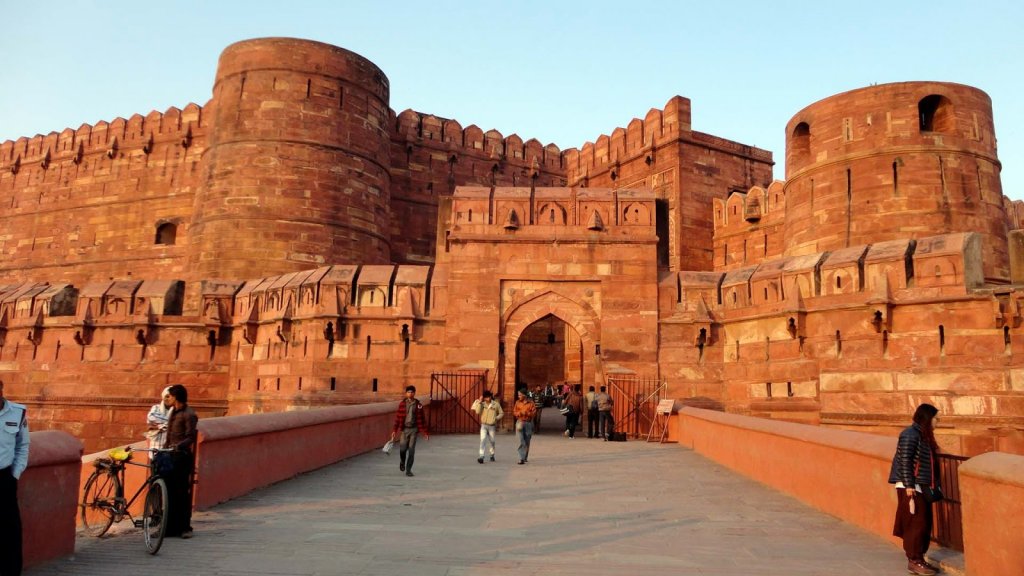
The existence of the fort is mentioned in many literature and inscriptions dating to the 11 th century . Thus, the fort is assumed to exist before 11 th century. I n 16 th century , Emperor Akbar renovated this fort from a brick fortress to a sandstone beauty monument. When it was a brick structure under the control of Rajputs, it was called as Badalgarh. During the Mughal Era, it got the name of Agra Fort.
Read more - Top Weekend Getaways from Agra
The fort was in ruins when Akbar took over it and he built the fort entirely with red sandstone. It took eight years to complete this massive fort. However, his grandson, Shah Jahan deliberately brought down many structures to dust to make room for marble structures. This was considered to be a massive revenue waste during his reign. Later, his son took over the fort and imprisoned him in the very same fort. It is said that Shah Jahan requested to be imprisoned inside the fort, in a tower, from where he could spend rest of his life watching Taj Mahal from the tower.
When the fort was in Aurangazeb’s control (son of Shah Jahan), there wasn’t many changes to the structure. A moat was added to the walls to increase the defense. After Aurangazeb’s death, there were no strong rulers to take Mughal reign under control. Smaller kingdoms fought with the reign and it wasn’t too long before Agra when under the control of Marathas. Over the next century, the fort went to many dynasties, which made little to no changes to the structure of the fort.
Later, British took over the fort and used it for military purposes until independence. They set up barracks inside the fort and destroyed many monuments to make room for the army. After independence, the fort came under the control of Government of India.
Suggested tour package: 7 days – Private Delhi Agra Jaipur tour
Explore about Shopping in Agra
Architectural Beauty of the Agra fort

This was one of the early forts of Mughal and it was mainly built for military purposes. This colossal fort had 70 feet tall walls, which still stands. These walls were designed for defense purposes. The walkways and entrances are specifically made narrower to make it hard for enemies to plunder into the fort at once.
The fort also has many tunnels through which royal families can escape to the shore of River Yamuna in case of unfortunate events. The entrance and the routes of the tunnels were passed on only to the royal heirs and it is assumed that there are numerous other secret passages in the fort that are yet to be discovered.
In terms of architecture, it is a fusion of Hindu and Islamic styled architecture. There are also theories about Agra Fort being inspired by the grand Gwalior fort. Each structure inside the fort has a unique style. You can find Gujarati structures, Bengali styled monuments and so on.
Suggested tour package: 8 days – Golden Triangle tour
Read more: When Is The Best Time To Visit Golden Triangle India (Delhi Agra Jaipur)?
What to see inside the Agra Fort
1. jahangir's palace.
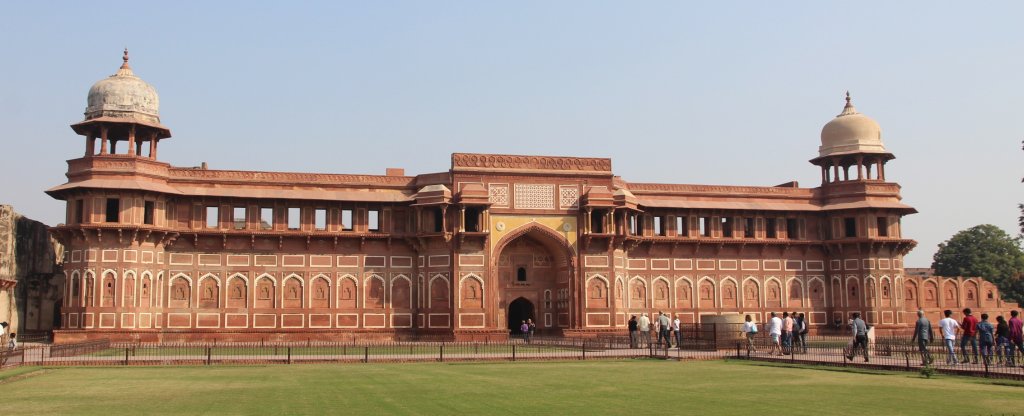
This is one of the most notable structures and oldest palace in the fort. This fort was used by the royal females and has many delicate carvings and architectural elements.
2. Khas Mahal
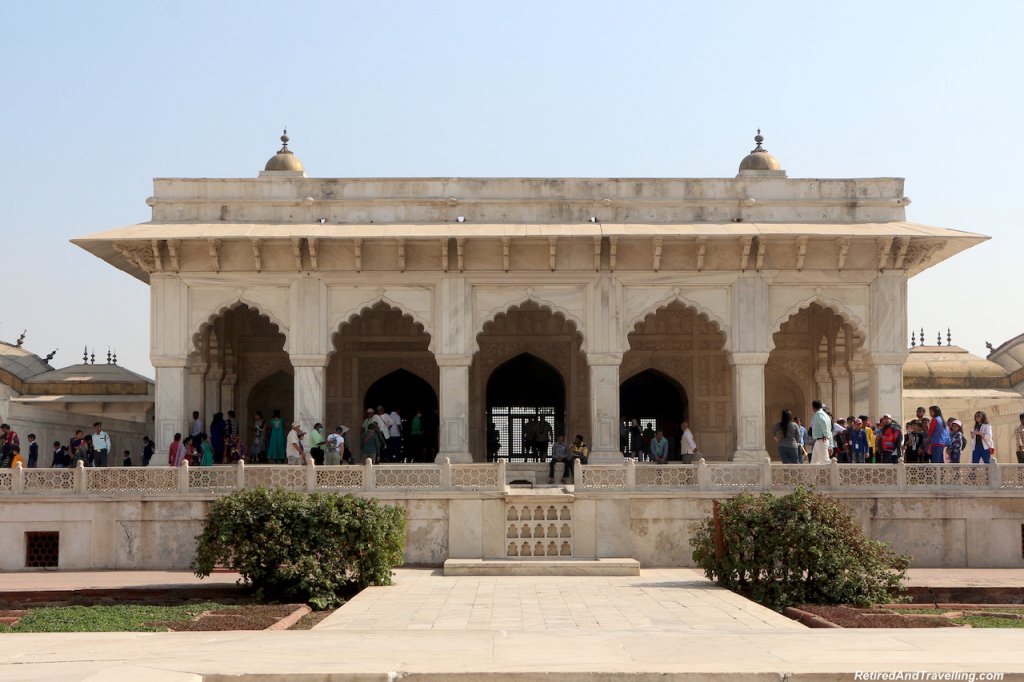
This is the palace of Mumtaz Mahal, wife of Shah Jahan. This structure is built in a fusion of Persian and Islamic architecture. The interior walls are decorated with gold, gems and precious stones. The palace is made with marbles and etches are made to create floral designs. Other notable architectural elements are lattice works, fountains, ceiling art and others.
3. Musamman Burj
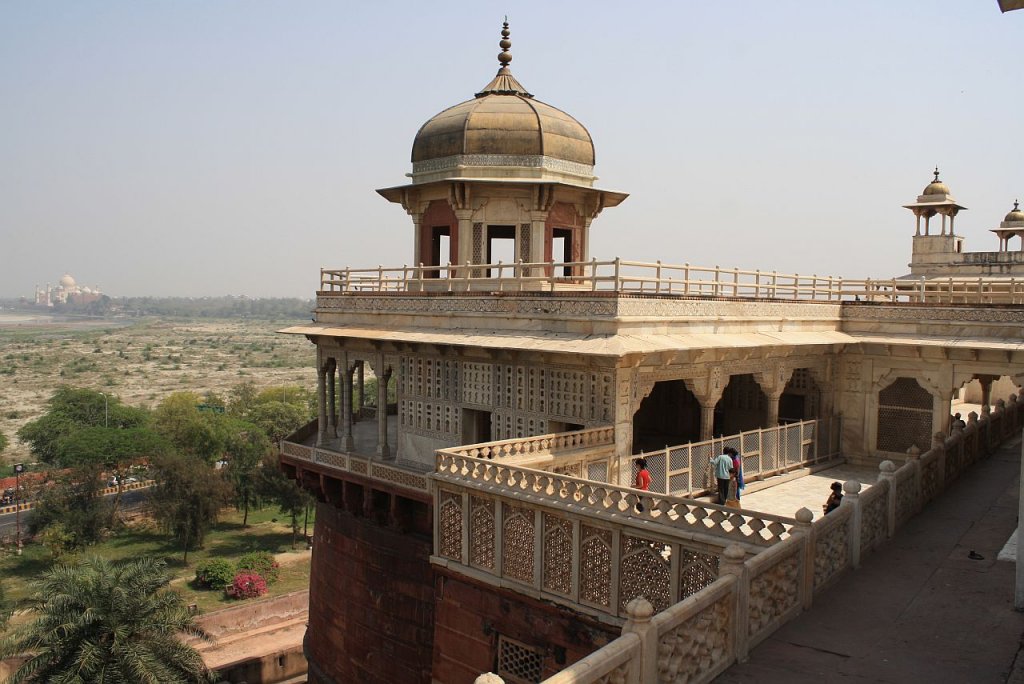
This is also called as the octagonal tower. This is the place where Shah Jahan was imprisoned by his son. As mentioned before, from this tower, you could get a flawless view of Taj Mahal, if you are visiting on a clear day. The tower is decorated with simple but elegant inlay work.
4. Diwan-i-Khas
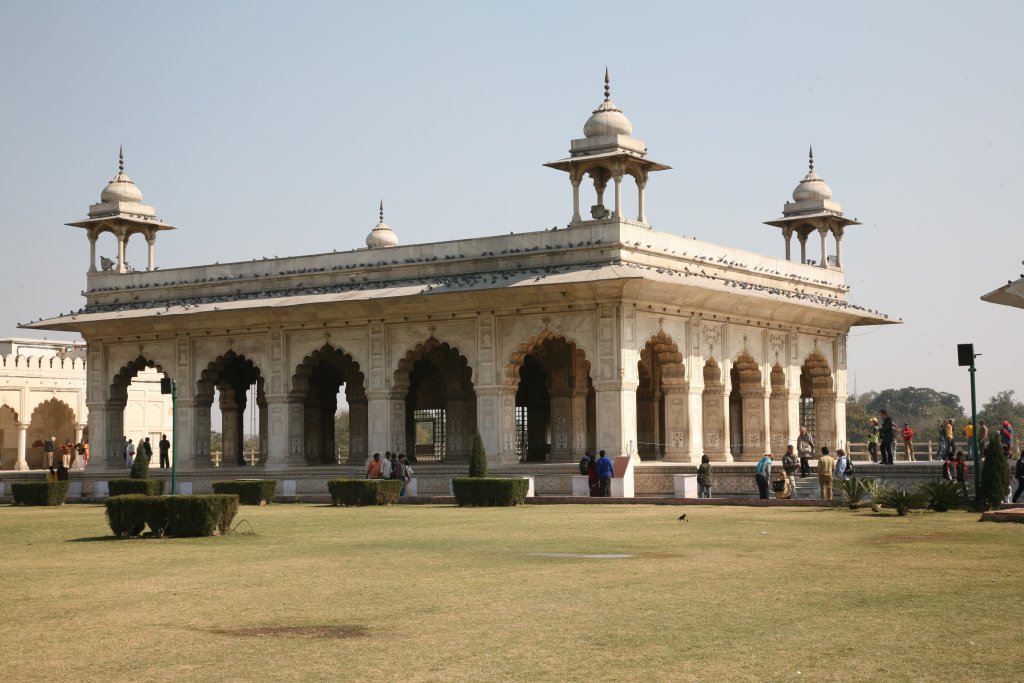
This is the place where the rulers met with private audience. This hall was built by Akbar and was remodeled by Shah Jahan. Thus, you can find many marble carvings, floral motifs and decorative works of Persian style. This hall used to hold the famous peacock throne, which was later looted away from India in 18 th century.
5. Sheesh Mahal
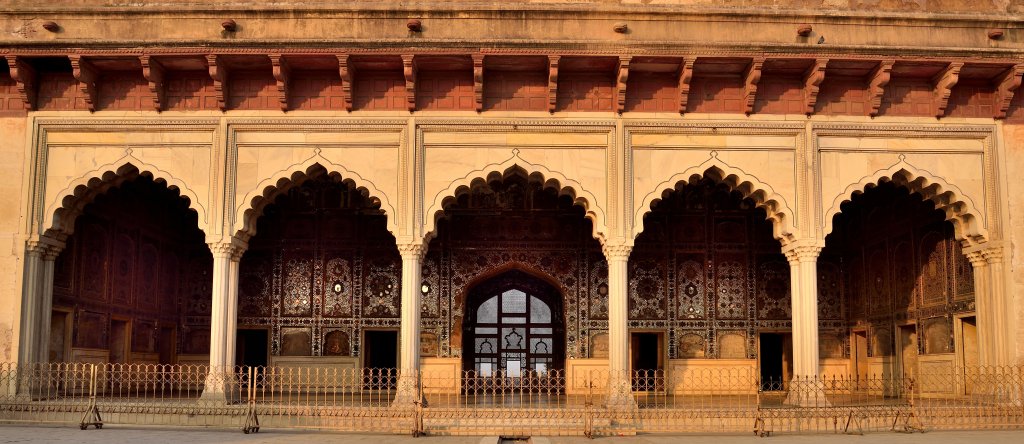
This mirror palace is made entirely with reflective surfaces. This palace has intricate mirror works, attractive carvings and a serene beauty.
6. Shahjahani Mahal
This is a fusion of marble and sandstone. This is the earliest monument made with sandstone that Shah Jahan tried to remodel with marble.
7. Jahangir’s chain of Justice
this is a large chain made with gold. Any citizen who believed that there is injustice in the reign would shake the chain and create a colossal sound with the 60 bells attached to it. This is the grievance redressal method during Jehangir reign.
Other important structures to see here are
- Moti Masjid
- Mina Masjid
- Golden Pavilions
Suggested tour package: 9 days – Delhi Agra Jaipur with Goa tour
Read more: 20 Best Places to Visit in India with Kids
Visiting time
The fort is open from sunrise to sunset . The best time to visit the fort is during early morning or sunset to watch the effect of sunrays on the fort. The best season for visiting the fort is winter or early summer.
It is best to visit between October and April. The climate will be pleasing and the sky will be clear for a convenient sightseeing. Mostly people choose to visit Agra fort in the evening and stay back for the sound and light show. Also read few more information about Best time to visit Agra.
Read more: Top Things to do in Agra
Suggested tour – 4 Days – Delhi Agra Private Tour
Entry to the Agra fort
There are four entrances to the four and out of these, two are walled shut. Among the rest, only the southern gate is open for the tourist. The North Gate is under the control of Indian Army and is not open to public. The southern gate is called as Amar Singh Gate. During the Akbar reign, this fort gate was called as Akbar Darwaza as it was used by Akbar for all his entourages.
Suggested tour package: 9 days – Delhi Agra Jaipur + Varanasi (Ganges tour)
Once you enter into the fort via the southern gate, you will find the ticket counter.
Ticket cost for Indians:
- Cash tickets – INR 50 per head
- Cashless tickets – INR 35 per head
- Sound and light show – INR 70 per head
- Children below 15 years – free
Ticket cost of foreigners
- Cash tickets – INR 650 per head
- Cashless tickets – INR 550 per head
- Sound and light show –INR 200 per head
Suggested tour package: 10 days – Delhi Agra Jaipur with North India temple
Things that are not allowed inside the fort
- Cell phone charger
- Dangerous items like explosives
- Knives or sharp items
- Tobacco items
- Merchandisable items
Read more: Top 20 Tourist Places to visit in Agra
Other Attractions in Agra
- Itimad-ud-Daulah
- Fatehpur Sikri
- Tomb of Akbar
- Chini ka Roja
- Mariam's tomb
- Mehtab Bagh
- Agra Museum
Agra Travel Guide
- Top Reasons to Visit Agra
- Best Time to Visit Agra
- How to Reach Agra
- Things to do in Agra
- Shopping in Agra
- Tourist Destinations Near Agra
- What to Wear in Agra
- Fairs & Festivals Celebrated in Agra
- Famous Restaurants in Agra
- Photography Tour in Agra
- Culture & Tradition of Agra
Related Packages
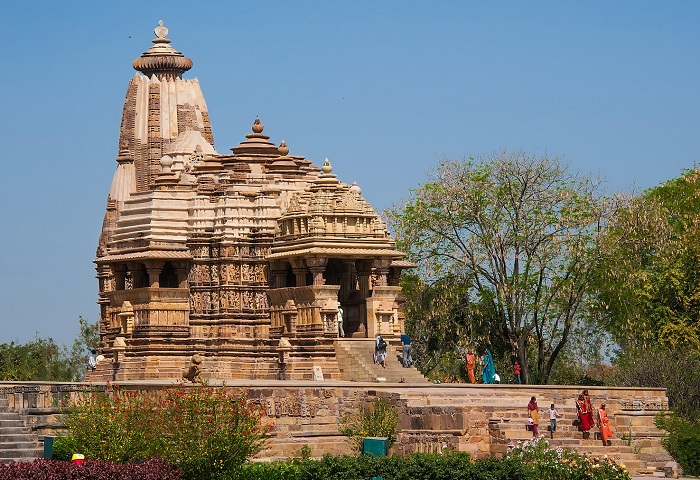
7 Days - Taj Mahal Tour with Khajuraho
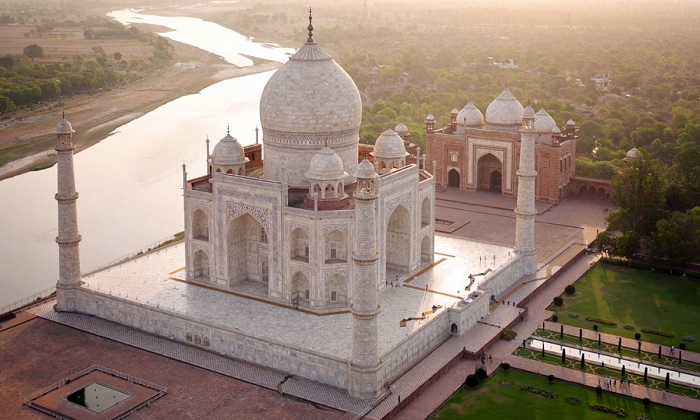
5 Days - Exclusive Taj Mahal Tour
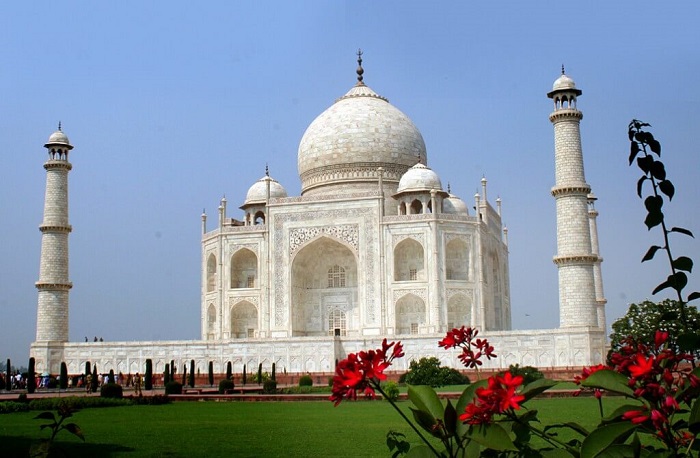
5 Days - Taj Mahal Holidays
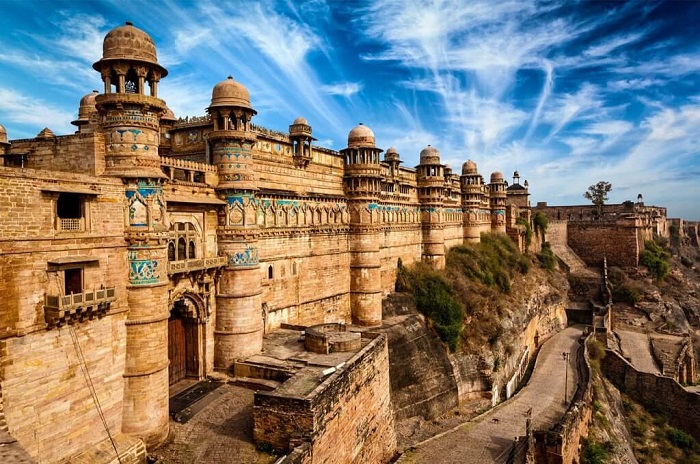
8 Days - Taj Mahal Tours with Gwalior
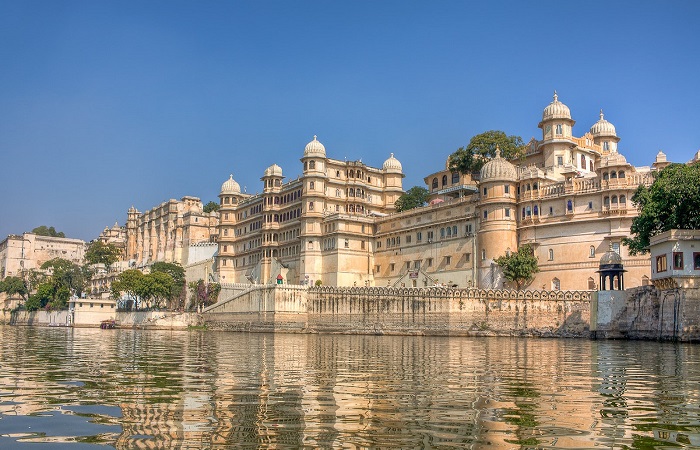
9 Days - Taj Mahal Tour With Udaipur

12 Days - Taj Mahal Tour and Tiger Safari
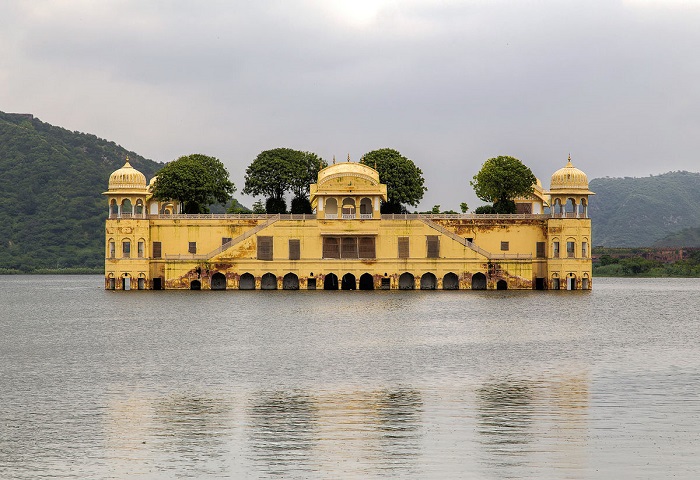
21 Days - Taj Mahal Tours with Camel Safari
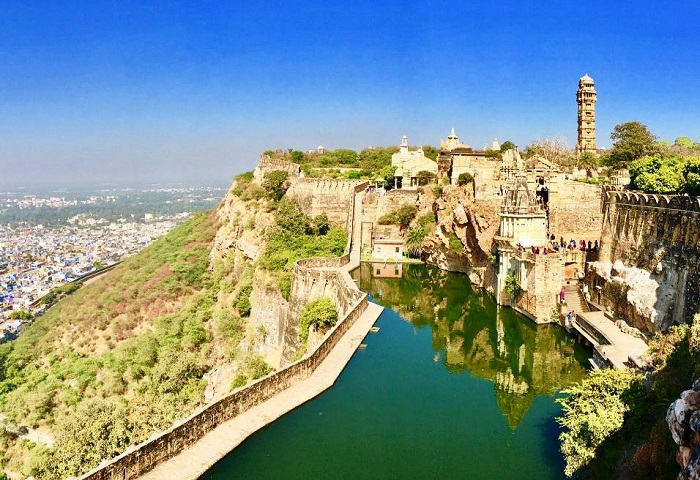
17 Days - Taj Mahal with Rajasthan Tour
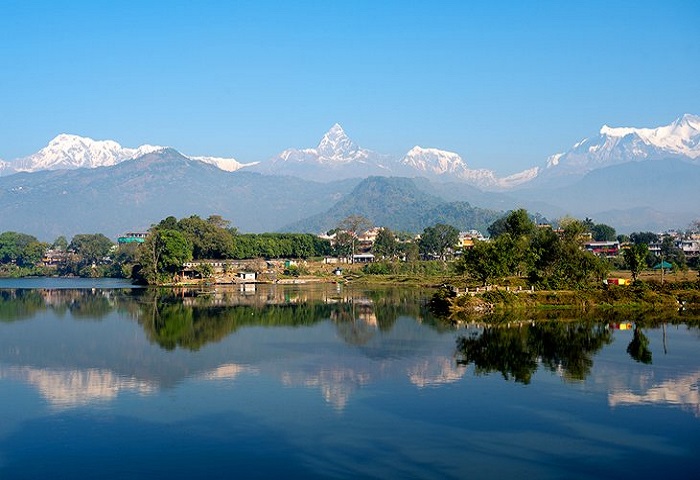
11 Days - Taj Mahal Tour with Nepal
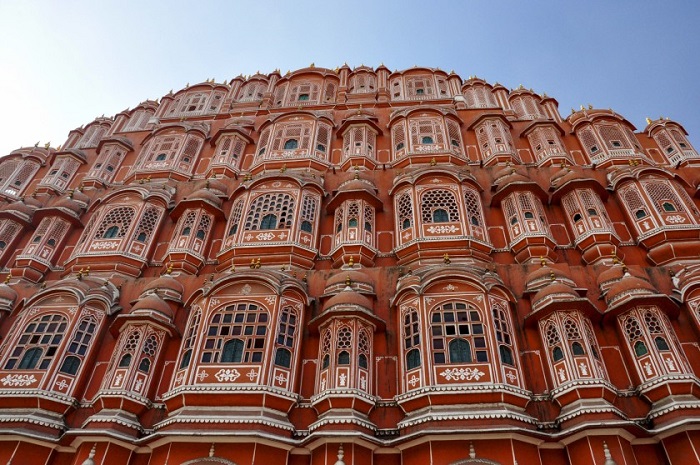
13 Days - Taj Mahal and North India Tour
- North India
- Uttarakhand
- South India
- Andhra Pradesh
- Central India
- North East India
- Arunachal Pradesh
- Other Destinations
- Jammu & Kashmir
- Andaman & Nicobar
- First Timers
- Family Holidays
- Golden Triangle
- Himachal Pradesh
- Lakshadweep
- Jammu Kashmir
- Andaman Nicobar
- First Timer Tours
- Wildlife Tour
- Honeymoon Tours
- Heritage & Culture
- Adventure Tours
- Spa & Ayurveda
- Taj Mahal Tour
- Luxury Train
- Beaches Tours
- Hill Station Tours
- Pilgrimage Tours
- Chardham Yatra
Luxury Trains
- Palace on Wheels
- Maharajas' Express
- Deccan Odyssey
- Golden Chariot
- 1 to 5 Days
- 6 to 10 Days
- 11 to 15 Days
- 16 to 20 Days
Help Center

1800 22 7979
+91 22 2101 7979
+91 22 2101 6969
+91 88799 00414
Business hours
Top Recommended Destinations
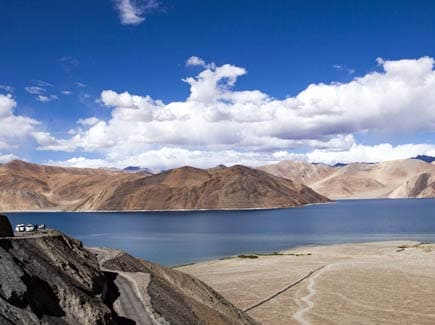
Jammu and Kashmir
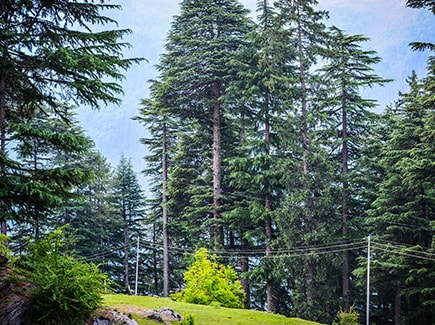
Himachal Pradesh

Sikkim Darjeeling
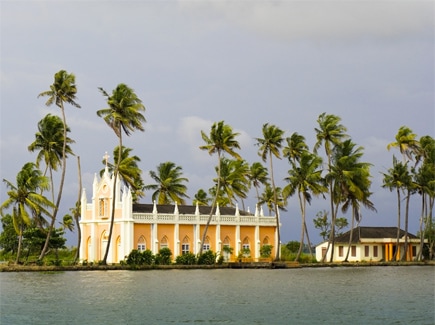
North India
- Chandrataal
- Dharamshala
- Spiti Valley
- Nubra Valley
- Pangong Tso
Punjab & Haryana
- Kurukshetra
Uttarakhand
- Jim Corbett Park
Uttar Pradesh
- Fatehpur Sikri
Andaman & Nicobar Islands
- Neil Island
Andhra Pradesh
- Visakhapatnam (Vizag)
- Chitradurga
- Murudeshwar
- Shravanbelagola
- Athirappilly
- Thiruvananthapuram
- Kanchipuram
- Kanyakumari
- Mahabalipuram
- Pondicherry
Arunachal Pradesh
- Kaziranga National Park
- Manas National Park
- Cherrapunjee
- Bhubaneshwar
West Bengal
- Narmada Tent City
- Rann of Kutch
Madhya Pradesh
- Omkareshwar
Maharashtra
- Chittorgarh
- Kumbhalgarh
- Ranthambore
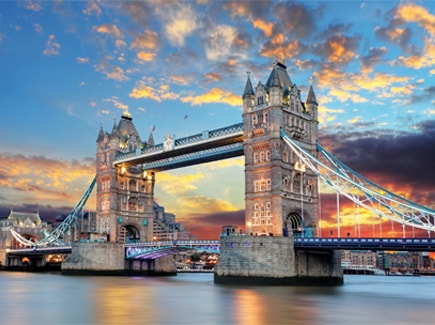
South East Asia
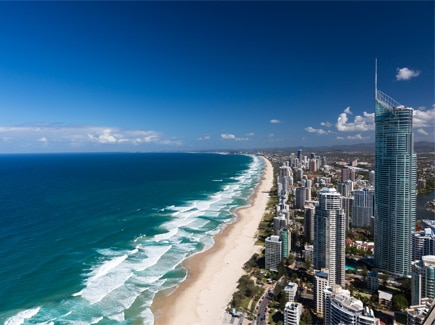
Australia New Zealand
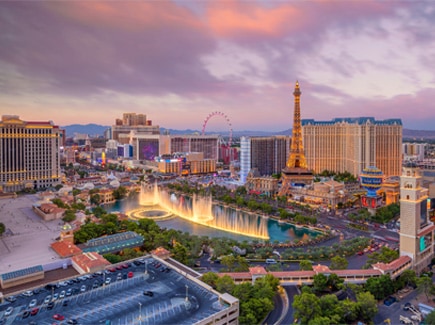
Dubai Egypt Israel
- Nile Cruise
South Africa
- Johannesburg
- Pilanesberg National Park
- Port Elizabeth (Gqeberha)
- Stellenbosch
- Victoria Falls
- Rio De Janerio
- Los Angeles
- Niagara Falls
- Philadelphia
- San Francisco
- Nuwara Eliya
- Kuala Lumpur
- Genting Highlands
- Nusa Penida
- Ho Chi Minh
- Cherry Blossom Tours
South Korea
Philippines
- Great Barrier Reef
- Great Ocean Road
New Zealand
- Christchurch
Western Europe
- Liechtenstein
- Netherlands
- Switzerland
- Vatican city
Central & Eastern Europe
- Czech Republic
Northern Europe
Mediterranean Europe
- Midnight Sun
- Northern Lights
- Scandinavia
United Arab Emirates
- Ferrari World
Saudi Arabia
An adventure of a lifetime awaits you. Immerse yourself in the untouched beauty of the last frontier on Earth, the serene beauty of icebergs, and witness landscapes that seem straight out of your dreams.

Speciality Tours
POPULAR & available TOURS
Honeymoon special.
Embark on a journey of togetherness.
Inspiring beautiful journeys & Scenic Routes.
Seniors' Special
Golden age celebration tours for 55+ yrs.
Women's Special
Exclusive handcrafted women only tours.
Family Tour Packages
Veena World’s safe, secure, and popular tours
Upcoming Tours
Couples only.
Exclusive tours for middle aged couples.
Luxury Tours
Enjoy the sweet life of luxury & pampering.
One Week One Place
Explore one place at a relaxed pace.
Post Tour Holidays
Explore the city after your big tour.
Short Trips
Quick getaways to stunning destinations.
Treks & Hikes
Exiting adventure & challenges (15-55 yrs).
YOLO Adventures
Experiences for adrenaline junkies (18-35 yrs).
City Walks & Day Trips
Explore the city and culture.
WOW Adventures
Thrilling holidays for family (10-55 yrs).
Students' Special
Dhamaal tours after 10th & 12th exams
Women's Special with Kids
Travel with your kids (boys & girls, under 12 yrs)
Customized Holidays
THEMED EXPERIENCES - Find your reason!
Romantic Holidays
City Breaks
Adventure Stories
Taj Holidays
Air Inclusive Holidays

Luxury Holidays
choose the right tailor-made luxury travel vacations

Island Getaways
explore the tropical island getaways
Buy & Sell Foreign Currency
Aed - uae dirham, gbp - british pound.
All your FOREX needs taken care of
- An Ultimate Travel Guide To Agra Fort – History, Timing, Entry Fee
An Ultimate Travel Guide to Agra Fort - History, Timing, Entry Fee

Cover Photo by Bishnu Sarangi
Situated on the right bank of the Yamuna River, Agra Fort is one of the most significant monuments built in India during the Mughals' reign. Also famous as Qila-i-Akbari, Fort Rouge, and Lal–Qila, the Agra Fort was declared a UNESCO World Heritage Site in 1983. Built purely from red sandstone, the fort is the perfect example of Mughal architecture and art, reflecting the majesty and strength of the Mughal Empire.
The Red Fort in Agra had been owned by several rulers and emperors in diverse periods in the past that include Lodhi reign, Mughal realm, British Empire, and more. One of the best places to visit in Agra , the fort comprises many glorious monuments, halls, and palaces.
Here is everything you want to know about the Agra Fort including its structure, history, entry fee, and much more.
1. Agra Fort – Architecture
The Agra Fort impresses visitors with its semi-circular design which faces towards Yamuna River. With spectacular gardens, secret passways, royal rooms, grand Mahals, courts, and other astonishing structures, the fort or Agra ka Lal Kila (Qila) will keep you awestruck throughout the trip. A blend of Hindu and Islamic-styled structural design, this brilliant monument originally had four gates, including Amar Singh Gate, Delhi Gate, Ghazni Gate, and Hathi Pol.
However, visitors are permitted entry through the Amar Singh Gate. All the walls in the fort are around 2 km in perimeter and 70 feet in height. Delhi Gate displays the exclusive art of that era and it is the most glorious amongst all the four gates in the Agra Fort. Adorned with intricate artwork with white marble, the Delhi Gate was used as the emperor’s formal gate. As the northern part of the fort is used by the Indian Military now, the Delhi gate remains close to the public. The Red Fort in Agra also has several tunnels that were built to allow royal families to escape to the banks of River Yamuna in case of adverse events.
2. Agra Fort: History
This monumental masterpiece has been the possession of many Mughal rulers since 1500. The interesting history about the Agra Fort is that it was once a property of Ibrahim Lodhi who structured this fort as his abode. During the first battle of Panipat in 1526, the fort was detained by Babur who defeated Lodhi in the war. Agra Fort was rebuilt in its present form by Akbar, the third Mughal emperor of India. When Akbar took over the fort and decided to make it his capital, the fort had already gone through several wars and it was losing its majestic appeal. So, he restructured the entire fort with red sandstone in exteriors and bricks in the inner areas.
Under the reign of Shah Jahan, the grandson of Akbar, the Fort was renovated using white marbles for interiors. He destroyed several structures inside the Agra Fort and rebuilt mosques and palaces using white marbles. Later, the red fort was occupied by Maratha after defeating Aurangzeb, who imprisoned his father in the fort itself. Many other rulers and emperors around the reign fought with the Marathas to take control over the fort. Thus, it kept on moving from one dynasty to another for the next several years before ending with the East India Company. At present, the fort is the property of the Government of India.
3. Attractions inside the Agra Fort
The Red Fort in Agra comprises many palaces and monuments structured at different points of time by various emperors in history. Some of the major attractions inside the Agra Fort include:
3.1 Jahangir Palace
As soon as you enter the Amar Singh Gate you will get to explore Jahangir Palace, one of the most remarkable structures in the fort. Built by Akbar for his son Jahangir, the palace is embellished with delicate carvings and architectural elements. Here, a marvellous gateway leads to the inside courtyard encircled by grand halls adorned with intricate carvings on stone, piers, brackets, and crossbeams.
3.2 Musamman Burj
Also known as the octagonal tower, Musamman Burj is the most romantic and attractive pavilion inside the Agra Fort. This is the place where two gorgeous and dominant Mughal queens Mumtaz Mahal (Shahjahan's chief queen) and Nurjahan (Jahangir's chief queen) used to live during the Mughal region. Also, Musamman Burj is the place where Shahjahan spent his last few years during the captive held by his son, Aurangzeb. Decorated with elegant artwork, the octagonal tower provides the perfect view of the Taj Mahal.
3.4 Khas Mahal
Built in a unique combination of Islamic and Persian architecture, Khas Mahal is the palace built by Shahjahan for his wife Mumtaz Mahal. The interior walls of the palace are adorned with precious stones, gold, and gems. Khas Mahal is a specific structure that offers a glimpse of specially designed Angoori Bagh (grape garden or the Mughal garden). The palace is also known for significant architectural elements, including ceiling art, fountains, and lattice works.
3.5 Diwan-I-Am
Built by Shah Jahan, Diwan-I-Am was the hall for the public audience during the Mughal dynasty. Here, Shahjahan used to meet his officials and the common public and listened to the petitioners. Initially, this hall was made using red sandstone but later it was given the white marble look.
3.6 Diwan-i-Khas
This is the hall where the emperors used to meet their private audience. Built by Akbar and upgraded by Shah Jahan, Diwan-i-Khas displays amazing artwork in its structure that includes decorative works of Persian style, floral motifs, and marble carvings. Diwan-I-Khas used to have the legendary Peacock Throne of Shah Jahan. Studded with several precious stones as well as Kohinoor diamond, the peacock throne was later looted away from India.
3.7 Shahjahani Mahal
A fusion of sandstone and marble, this was probably the earliest monument that Emperor Shah Jahan changed inside the Agra Fort. Originally made with sandstone, the monument later got remodelled with white marble. If you are someone who loves to go deep into time and history, you can hire an Agra fort guide to know more about the history behind each monument in the fort.
3.8 Sheesh Mahal
Made entirely with reflective surfaces, Sheesh Mahal or the mirror palace is the finest illustration of water engineering and architecture in the hammams. The palace attracts visitors with its attractive carvings and intricate mirror works on the walls, which are the perfect example of the glass-mosaic embellishment in India. The mirror palace is supposed to have been the dressing room or harem during the Mughal region.
3.9 Jahangir’s Chain of Justice
Jahangir was famous for his inventive strategy of the ‘Chain of Justice’. This is a huge gold chain with 60 bells attached to it. The Mughal Emperor had placed it on his palace wall to allow people to get justice in the reign. People in search of justice used to come here and shake the chain to create a colossal sound and made their complaints heard for justice. In a way, this was the complaint redressal method in the Mughal dynasty.
3.10 Nagina Masjid
Situated beside the Diwan-i-Am inside the Agra Fort, Nagina Masjid is a mosque structured by Shah Jahan for the women in the Royal family. Also known as Jewel Mosque, or Gem Mosque, Nagina Masjid was built only with pure white marble. With simple architecture and decoration, the mosque has some special features including magnificent arches and three royal domes. It was a private place of worship during the Mughal region.
3.11 Bengali Mahal
Built by Akbar and later revamped by Shah Jahan, Bengali Mahal was a huge palace having curved or Banglauar chhajjas. It is said that this palace has some secret buildings underneath the structure. Shah Jahan built some other palaces on the northern area of this palace that divides it into two parts, including Jahangiri Mahal and Akbari Mahal.
3.12 Anguri Bagh
Situated in front of Khas Mahal, Anguri Bagh or Garden of grapes was built by Shah Jahan in 1637. Surrounded by apartments built for royal ladies, Anguri Bagh was the central area of the zenana. It was divided into sections with a fountain in the centre. The Garden of grapes was meant to be a private spot of recreation for the royal ladies.
Some other significant structures to see inside the Agra ka Lal Kila (Qila) include:
- Golden Pavilions
- Mina Masjid
- Ghazni Gate
- Babur’s Baoli
- Moti Masjid
- Jahangir's Hauz
Other than exploring the historical monuments, you can enjoy many other activities in Agra. You can explore the city further, go for a Mughal Heritage Walk, shop for souvenirs, and enjoy mouthwatering cuisines in the best restaurants in Agra .
4. Best Time to Visit Agra Fort
Though one can visit this historical place throughout the year, it is wise to visit is from October to April when the temperature is moderate. The timing to visit Agra Fort is from sunrise to sunset every day. You can watch and experience the rich history of the fort at evening light and music show held regularly inside the fort.
The opening time of Agra Fort is from 6.00 A.M to 6:00 P.M on all days of the week.
5. Agra Fort Entry Fee
There is a small ticket counter outside the Lahore Gate. However, you can also purchase a ticket for Agra Fort through the online portal.
Agra Fort entry fee;
- Indian – INR 40
- Foreigner – INR 550
- Children – free entry
In the end, make sure your Agra tour package lets you explore the Agra Fort to the fullest because there’s a lot to see and experience.
We are an Indian travel company founded in 2013 and excel at domestic and international tour packages including guided group tours, specialty tours, customized holidays, corporate MICE travel, inbound travel and destination weddings.
Post your Comment Please let us know your thoughts on this story by leaving a comment.
Blog categories.
- Travel Guide
Looking for something?
Embark on an incredible journey with Veena World as we discover and share our extraordinary experiences.
Request Call Back
Tell us a little about yourself and we will get back to you

Our Offices
Located across the country, ready to assist in planning & booking your perfect vacation.
Locate nearest Veena World
Listen to our Travel Stories

5 Minute Travel Tips with Neil Patil
Become a smart traveler in five minutes. Every Monday join Neil Patil and hear about different travel tips and secrets to unlock your full travel Ninja potential.

Aapla Maharashtra
'आपला महाराष्ट्र' ही पॉडकास्ट मालिका म्हणजे महाराष्ट्राची झलकच. गौरवशाली इतिहास , वैविध्यपूर्ण परंपरा आणि आकर्षक भूगोल लाभलेल्या महाराष्ट्राची ओळख करून देण्यासाठीच वीणा वर्ल्डने ही मालिका सुरू केली आहे. या मालिकेतून महाराष्ट्राच्या रोमांचक इतिहासाचे साक्षीदार असलेल्या गड - किल्ल्यांचा थोडक्यात परिचय करुन दिला जाईल. मग दर गुरुवारी न चुकता ऐका ' आपला महाराष्ट्र ' आणि तुमच्या भटकंतीला द्या नवीन दिशा. Looking to explore the wonders of Maharashtra, India? Tune in to 'Aapla Maharashtra', a podcast series that takes you on a journey through the state's rich history, captivating culture, and breathtaking geography. Join us every Thursday for a new episode and discover the many forts that bear witness to Maharashtra's majestic past. Take your travel experience to the next level with 'Aapla Maharashtra'.

Chalo Bag Bharo Nikal Pado
#ChaloBagBharoNikal Pado, a Hindi podcast by Veena World, is here to take you on a virtual tour around the world. Every episode, our host Neil will be joined by expert travellers with years of experience in the Travel and Tourism industry. They’ll share their personal journeys and stories that you’ve probably never heard of before. A new guest, a new experience. New episode every Wednesday. Join us to Celebrate Life virtually.

Know the Unknown
Know something unknown daily in under 3 minutes

Life Stories by Veena Patil
‘Exchange a coin and you make no difference but exchange a thought and you can change the world.’ Hi! I’m Veena Patil... Fortunate enough to have answered my calling some 35 years ago and content enough to be in this business of delivering happiness almost all my life. Tourism indeed moulds you into a minimalist... Memories are probably our only possession. And memories are all about sharing experiences, ideas and thoughts. Life is simple, but it becomes easy when we share. Places and people are two things that interest me the most. While places have taken care of themselves, here’s my podcast, which I consider to be a great platform, through which I can share some interesting stories I live and love on a daily basis with all you wonderful people out there. I hope you enjoy the journey... Let’s go, celebrate life!

Travel. Explore. Celebrate Life Podcast with Neil and Sunila Patil
Travel is indeed one of the things that help us celebrate life. And 2020 has made us realise that more than anything else. With Travel. Explore. Celebrate Life., let's go on a journey around India and the world and talk about culture, history, experiences, food, and more. Your co-hosts Neil Patil and Sunila Patil along with special guests every episode, discuss where to go, what to eat, where to stay, what to pack, what to explore, and much much more. So hop on, chalo bag bharo nikal pado!

Travel Katta
#TravelKatta, a Marathi podcast by Veena World, is here to take you on a virtual tour around the world. Every episode, our host Sunila will be joined by expert travellers with years of experience in the Travel and Tourism industry. They’ll share their personal journeys and stories that you’ve probably never heard of before. A new guest, a new experience. New episode every Friday. Join us to Celebrate Life.
Recommended Tours
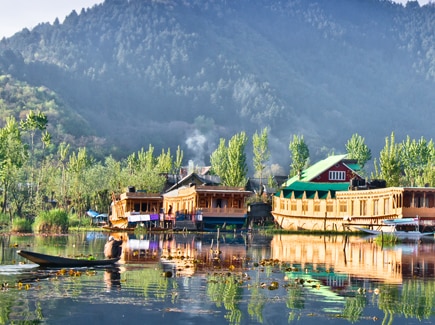
Kashmir to Kanyakumari Road Trip
Tour includes, super deal price, most commented, calling out the spiritually inclined - 10 places of worship worth visiting in india, top 10 places in china - discover the land of oldest living civilization, a 2 week itinerary for a holiday in africa - trace your roots in the cradle of mankind, handpicked wedding destinations around the world for your big day, keep travelling all year round.
Subscribe to our newsletter to find travel inspiration in your inbox.
Trending videos for you

Top Travel Experiences

With Veena World

Dekho Apna Desh

Places to Visit in 2023
Veena world tour reviews, what are you waiting for chalo bag bharo nikal pado, golden triangle - delhi agra jaipur.
"*****/A - FEB 08 TO 14, 2024 - ON BEHALF OF VIJAYA SURVE & PRAFULLATA GHAG : I am happy to write this review about first trip experienc... Read more
"We enjoyed Golden Triangle very much. Our tour leader Ganesh Undale was very courteous & knowledgeable. He made our tour very much enjo... Read more
"Very nice experience and commendable management by Ganesh Undale. Overall great experience and fantastic support from Ganesh and the te... Read more
"On our 5 day Delhi Agra tour from 23rd to 27th December 2023, we had comfortable bus for travels, good hotels, timely and great breakf... Read more

228 departures
55,262 guests travelled

137 departures
23,543 guests travelled

95 departures
1,07,204 guests travelled

38 departures
16,212 guests travelled

317 departures
75,226 guests travelled
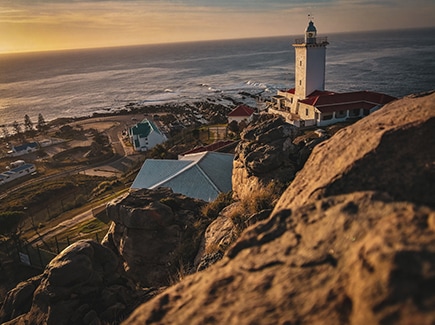
17 departures
1,899 guests travelled
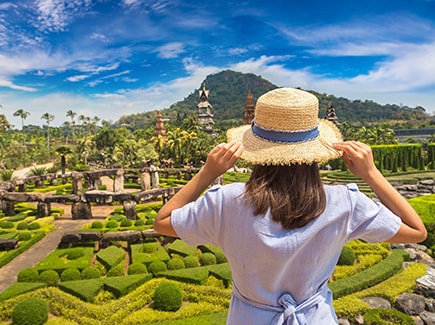
100 departures
1,20,734 guests travelled

27 departures
11,226 guests travelled
You will be redirected to your dashboard shortly. We will also call you back in 24 hrs .
- Agra Fort: A Complete Guide To Explore The Marvellous And Historic Monument In 2024!
10 Nov 2021
Agra in Uttar Pradesh has many monuments that beautifully depict the Mughal Era. The most notable of them are Taj Mahal, Agra Fort, and Fatehpur Sikri. The Agra Fort is a beautiful fort with a history of its own. It was formerly known as Badalgarh. What is special about this fort is that all the emperors of the Mughal era until the year 1638 have resided here at least once. If you are a history lover, then do visit this fort not only because of its historical richness but also because of its architectural beauty. Here, we have gathered all the information that you would love to know about the place while planning for a visit.
History Of Agra Fort
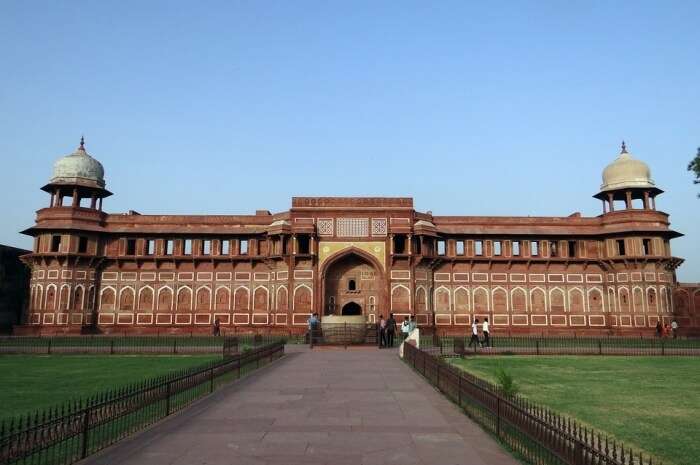
Image Source
The Agra Fort was built by Raja Badal Singh who was a Rajput king. The fort has been owned by various dynasties at different periods of time e.g. Lodhi Dynasty, Mughal Empire, and British Empire to name a few. In A.D. 1526, the fort was occupied by the Mughals after the battle of Panipat. The fort was rebuilt in Akbar’s era and it gets it architectural style from it. There are also various other historic sites inside the fort such as Ghaznin Gate, Shah Jahani Mahal, Shish Mahal, and a lot more. The fort has a very vast history and you will get to know a lot more things as you will visit the fort. You can take an audio tour to the fort as well which will guide you throughout the fort.
Agra Fort Location: Rakabganj, Agra, Uttar Pradesh Agra Fort Timings: 6.00 AM – 6.00 PM Agra Fort Ticket Price: INR 35 for Indians and INR 550 for Foreigners Visit Duration: 2-3 hours
Must Read: 5 Popular Hot-Spots Serving The Most Famous Street Food In Agra
Looking To Book A Holiday Package?

Spellbinding Cochin Family Tour 2D/1N Package @ Rs 2,750
Plan your trip today!

Himachal Family Tour Package 4D/3N @ Rs 8,750
Get quotes from multiple travel experts.

Exciting Andaman Family Trip 5D/4N @ Rs 10,250
Compare & customize quotes before booking.

Gangtok & Darjeeling Tour Package 5D/4N @ Rs 13,000
Have Questions? Talk to our travel experts today.

Wonderful Goa Family Package 3D/2N @ Rs 6,500
Best prices guaranteed.

Riveting Rajasthan Vacation 3D/2N Package @ Rs 6,499
EMI option available.

Enchanting Uttarakhand Tour 4D/3N Package @ Rs 7,199
Explore best destinations with our experts.

Delightful South Weekend Tour 3D/2N Package @ Rs 4,999
Thrilling weekend full of fun.

Marvelous Gujarat Tour 3D/2N Package @ Rs 4,999
Talk to our experts today.

See more at TRAVELTRIANGLE.COM
Best Time To Visit Agra Fort
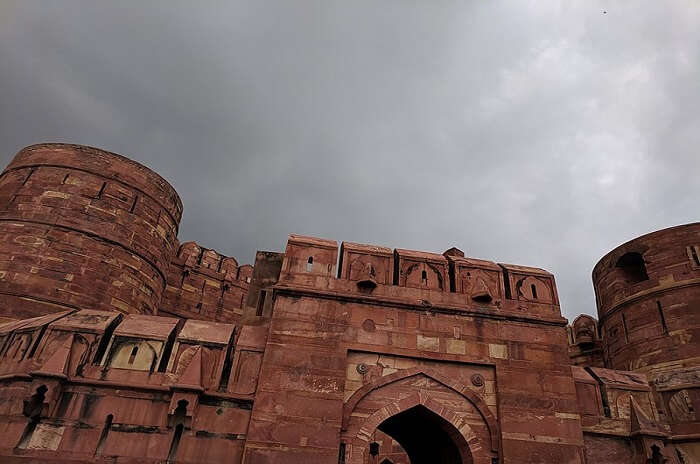
The fort is open all the seven days of the week. But you must consider the weather while planning your visit to Agra, as you won’t be able to enjoy much when it is hot. So, the months of November to February are the best ones to visit the Agra Fort as the weather is dry and less hot during these months.
Suggested Read: 18 Best Places To Visit Near Agra For A Weekend Getaway
Layout Of Agra Fort

From the top this fort has a semicircular shape and the base of the fort is located just opposite the bank of river Yamuna. Made of magnificent redstone, there is a double battlemented massive wall which encloses the entire fort. The wall of the fort is 2 kilometres in perimeter and adorned by the beautiful curves and also the lofty bastions. There are four gates in the Agra fort among which the Delhi gate and the Lahore gate are some of the prominent ones which are the main highlights. Alongside that there is an inner gateway which is also called the Elephant gate.
There are many halls and palaces inside the palace among which some of the famous ones are Macchi Bhavan, Khas Mahal and also the Shah Jahani Mahal. On the right side of the fort lies the beautiful Diwan-I-Am and a few steps ahead there are other royal pavilions which is a house of Nagina Masjid and Mina Masjid. Inside the fort there are also other highlights like the places of worship and a private market which was once a gathering place for the ladies.
In addition to this there is a secret massage at the base of the fort which was dug to access easily during the times of emergency. There are also many other attractions like the grape garden, a mirror palace and also the jasmine tower. It is believed that there were around 500 buildings around the fort which soon lost its glory with the running of time.
Agra Fort Architecture
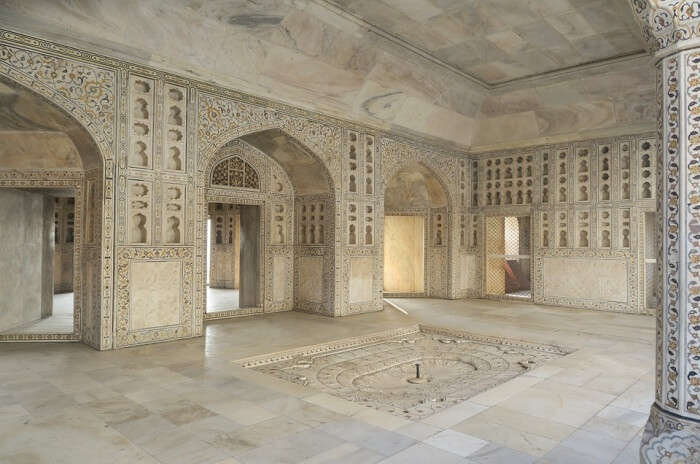
The fort was rebuilt in red sandstone by Akbar in the year 1573. It took around 8 years to rebuild the fort. The basic purpose behind building this fort was military installations. This is the reason the fort has a 70 foot high wall. Later, however, Shah Jahan built various other beautiful marble places and forts inside the tomb. The fort also has a secret tunnel but it stands sealed by the government. You’ll find that the fort has two major gates i.e. the Lahore Gate and the Delhi Gate.
Suggested Read: 10 Soulful Retreats Near Agra For A Break Away From The Crowds
Structures Inside The Agra Fort
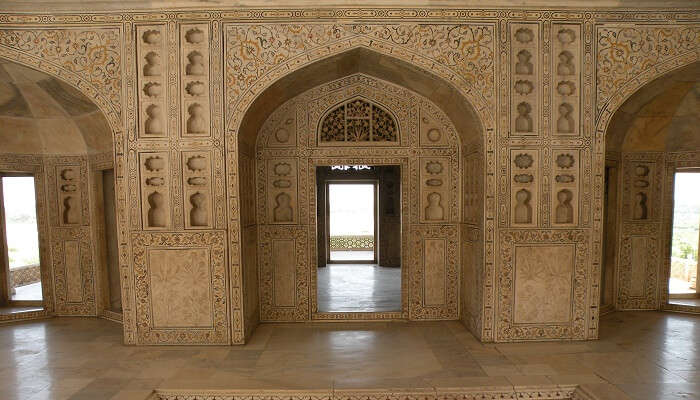
- Jahangir’s Hauz – Built by emperor Jahangir, this was actually a monolithic tank which was used for bathing during that time. Now this is part of Akbar’s Bengali Mahal.
- Shahjahani Mahal – This was one of the first attempts made by Shah Jahan to turn a red sandstone palace structure into white marble structure.
- Babur’s Baoli – This was built for taking care of the water needs of the fort. It is known to be one of the early modifications made inside the Agra fort.
- Nagina Masjid – This place was built by Shah Jahan as a private place of worship.
- Diwan-I-Am – This hall was built by Shah Jahan and initially made of red sandstone. Later it was shell-plastered to give that white marble look.
- Ghaznin Gate – This gate belonged to the tomb of Mahmud of Ghazni which was later moved into a fort during the British reign for political reasons.
- Bengali Mahal – This palace was built by Akbar and later it was renovated by Shah Jahan. This place is known for having some secret buildings which are hidden underneath.
- Akbar’s Mahal – This was the place where Emperor Akbar took his last breath. Still holding its importance, this palace was made of red sandstone.
Places To Visit Near Agra Fort
Here are some of the famous places to visit near Agra fort which one can explore after witnessing the marvelous architecture of the fort.
1. Fatehpur Sikri
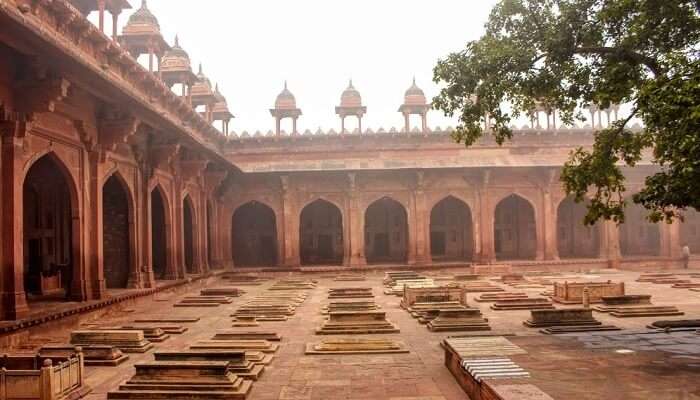
Fatehpur Sikri is known as the pride of Mughal Empire which can be visited on a one day trip from Agra. This was founded close to the 16th century which was made out of red sandstone. Now turned as UNESCO world heritage site, this place is one of the finest Mughal architectures to explore. Inside Fatehpur Sikri, there are other places like Jodha Bai’s palace, Jama Mosque, Buland Darwaza and also a Tomb of Salim.
Distance from Agra Fort: 37.6 Kms
2. Taj Mahal

Taj Mahal is considered as a symbol of love and beyond that it is also one of the seven wonders of the world. Built by the famous Mughal Emperor Shah Jahan for his beloved wife Mumtaz Mahal, till date this monument attracts visitors from all around the world. The construction of this monument started around the year 1631 and took almost 17 years to complete this magnificent place. This surreal place is defined as an epitome of beauty which has turned out to be a muse for many poets and artists.
Location: Dharmapuri, Forest Colony, Tajganj, Agra, Uttar Pradesh 282001 Distance from Agra Fort: 2 Kms
3. Sikandra
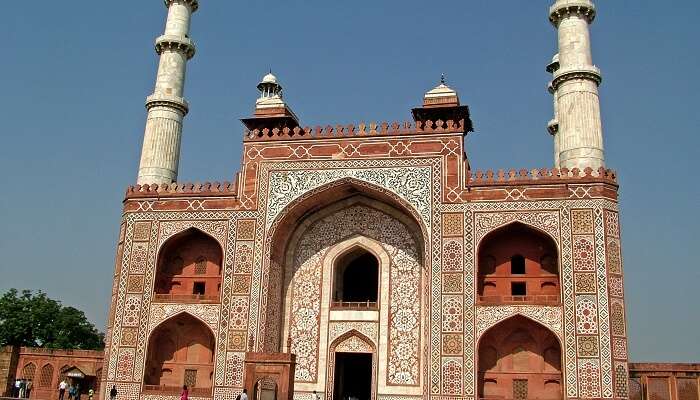
Sikandra is a place located at the outskirts of Agra which is known for being the place where Akbar was finally rested. The main highlight of this place is the Tomb of Akbar which was built during the time between 1605 and 1618. Surrounded by the Mughal garden, this tomb was built facing the sun unlike other monuments which faces the Masjid of Mecca. The main structure of this tomb was built of sandstone and some portions of marble.
Distance from Agra fort: 14.2 Kms
Interesting Facts About Agra Fort

- Aurangzeb imprisoned his own father Shah Jahan in the fort for around 8 years
- Earlier, the emperors had their own bathing gates as Yamuna River flowed along the fort
- The Kohinoor diamond was also a part of this fort before Red Fort
- The Diwan-i-Khas of Red Fort was made on the reference of the Khas Mahal of Agra Fort
- Most part of the fort is made of red sandstones as Akbar had a sort thing for red walls
- It was recorded as one of the UNESCO World Heritage Site in the year 1983
- Around 1,444,000 workers worked to build this monument
- The chord of the fort lies parallel to Yamuna and the fort has a semicircular plan
Suggested Read: 20 Places To Visit In Agra: Explore the City Beyond Taj Mahal
Some Tips For Travelers

- Don’t forget to check the identity cards of the guides and check their authenticity
- Stay hydrated and carry your water bottles as it can be a bit hotter there
- Visit Taj Mahal and Agra Fort on the same day as you might get a discount on Agra Fort’s ticket
- Keep your belongings safe from pickpockets
- Try to reach the fort early in the morning to avoid heavy crowd
- If you want to shoot a video in the fort, then you will have to pay some fee amount to the authorities
- Attend the light and sound show that would cost around 70 bucks to Indians and 200 bucks to foreign nationals
- Don’t litter in the historic monument as you could also be heavily fined for the same
Suggested Read: The Ultimate List of Adventure Holidays In India For Summer
Planning your holiday but confused about where to go? These travel stories help you find your best trip ever!

Nikhil Recites A Tale Of 11 Friends Who Went From Bengaluru To Ladakh
Bengaluru - Delhi - Leh - Ladakh - Leh - Delhi - Amristsar - Chandigarh - Bengaluru

Pranav Took A Solo Trip To Andaman & It Was Truly Wonderful
A backpacker's guide to the predominant Honeymoon destination!

Shivani Talks Of Her Trip To Mcleodganj & Dalhousie With Her Husband And Friends
Sunset views. Monasteries. Bhagsunath falls. And amazing street food.

Kanika Proves That Traveling With An Infant To Kerala Is Totally Safe & Wonderful
Beaches, Backwaters, Spas, & More. Take me there now, please!

Here's Why Aakanksha's Trip To Manali Changed Her Idea About Group Tours
Ideal long weekend getaway from Delhi! Isn't it?

Isha Elaborates On How She Went Solo To Kasol & Returned With Lots Of Friends
And tales of her exciting Kheerganga & Chalal trek...

Prasham's Account Of A Goa Tour Proves That Goa Is More Than A Party Destination
Adventure, sightseeing, laid-back beach tours, and it doesn't stop there!

Bhavya Gives An Extensive Account Of His Jaisalmer Trip With Friends
Desert safari, haunted Kuldhara village, & Gadisar Lake. There's more...

Ashish Tells Why Kashmir Turned Out To Be A Winter Wonderland For His Family
For Gondolas, Shikaras, and plenty of snow!
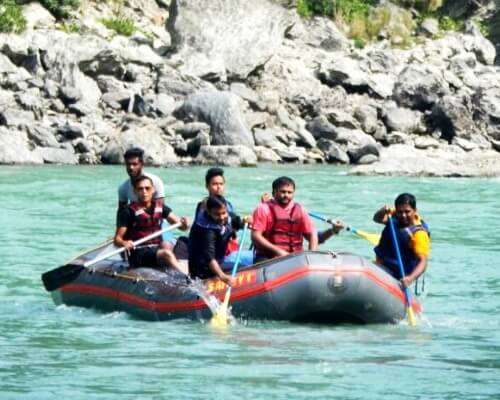
Arunav Can't Stop Praising His Adventurous Trip To Sikkim & Darjeeling With Friends
For adventure in Air, on Land, and in Water!

Avneet Describes Her Trip To Spiti With A Group Of Strangers That Became Friends
Sightseeing. Monasteries. Trekking. And beauty all along
How To Reach Agra Fort

All the travel options of air, road, and rail are open for you to reach Agra. Agra is well connected to various cities in India.
The nearest airport is Kheria Airport in Agra at a distance of around 7 km from the Agra Fort. From there you can easily get an auto or taxi and reach Agra Fort.
You can also take a bus to Agra if you are traveling from some other cities such as Lucknow, Jaipur, or Delhi. There are regular buses from these cities to Agra. Also, you can drive yourself to Agra through Yamuna Expressway or NH2.
If you are planning to reach Agra by train, then you can check the Delhi-Chennai and Delhi-Mumbai routes. Agra Cantt. Railway Station is the main railway station in Agra apart from the other four. You can easily get an auto from the railway station for the Agra Fort.
Further Read: Long Weekends In India: Ways To Enliven Your Vacay Vibes Safely In The Post-Lockdown Era!
Apart from Taj Mahal, Agra Fort is the other major tourist site that you must visit in Agra. Also, if you are a photo phanatic who loves getting clicked, then you should visit this fort. So what are you waiting for? Plan a vacation to Agra with TravelTriangle and delve in the Mughal history and culture. Know more about the historic and glorious past of India by exploring Agra fully.
Disclaimer: TravelTriangle claims no credit for images featured on our blog site unless otherwise noted. All visual content is copyrighted to its respectful owners. We try to link back to original sources whenever possible. If you own the rights to any of the images and do not wish them to appear on TravelTriangle, please contact us and they will be promptly removed. We believe in providing proper attribution to the original author, artist, or photographer.
Frequently Asked Questions About Agra Fort
Who built the famous Agra fort?
The construction of the famous monument of Agra fort was initiated by Akbar who was a Mughal emperor. After his death, the completion of the fort was done by Shah Jahan.
What is Agra fort famous for?
Agra fort is one of the most famous places to visit in Agra as well as India. It is the heritage of India and also lists in the UNESCO World heritage sites. The fort has a long history and attracts thousands of visitors each day.
Are Red fort and Agra fort the same?
No, both the forts are not the same. Red fort is situated in Delhi and Agra fort is located in Agra. However, the forts have the same kind of structure.
Does Agra fort remain open on Monday?
Yes, Agra fort remains open on all days from Monday to Sunday. It is open from the morning to evening. It is frequented by thousands of visitors.
Is Agra fort worth visiting with family?
Agra fort is one of the most interesting and heartwarming tourist attractions in Agra. It is a great place to plan a getaway with family and will definitely treat you and your family.
How large is the fort of Agra?
The Agra fort is spread across 2.5 kilometers. It is one of the historical monuments in India that should be visited once by every traveler. It talks about the glorious times of the country.
Looking To Book An International Holiday?

Trip to Sri Lanka at Rs 13,500/-
Plan Your Vacation Today!

Trip to Singapore at Rs 20,499/-
Get Quotes From Local Experts

Mauritius Holiday Starting at Rs 65,000/-
Talk to Our Experts Today

Maldives Honeymoon Trip at Rs 39,800/-
Pay with easy EMI Option

Europe Trip at Rs 89,999/-
All Inclusive Deals

Vacation in Dubai at Rs 27,499/-

Hong Kong Holiday at Rs 24,999/-
Money Safe Guarantee

Thailand Holiday at Rs 7,999/-
Flights Excluded
People Also Read:
Forts In India Nagaur Fort Tughlaqabad Fort
Recent Posts
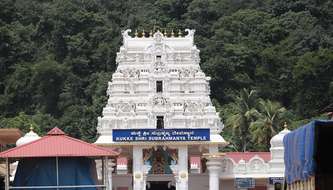
Visit Kukke Subramanya Temple For Spiritual Solace Amidst Nature’s Charm
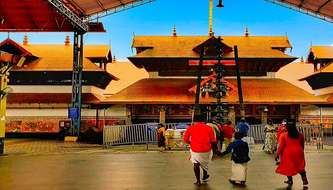
Guruvayurappan Temple: A Spiritual Odyssey Through Kerala’s Divine Abode of Tranquility

Sree Poornathrayeesa Temple And Its Enchanting Legacy
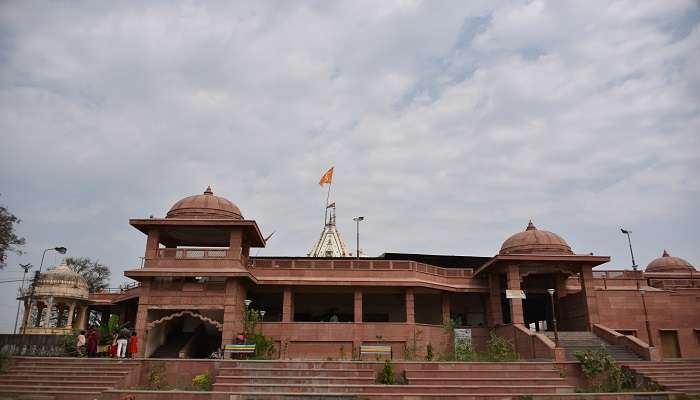
Explore The Magnificence Of Mangalnath Temple: The Birthplace Of Mars

Exploring The Serene Beauty Of Ekvira Temple In Maharashtra
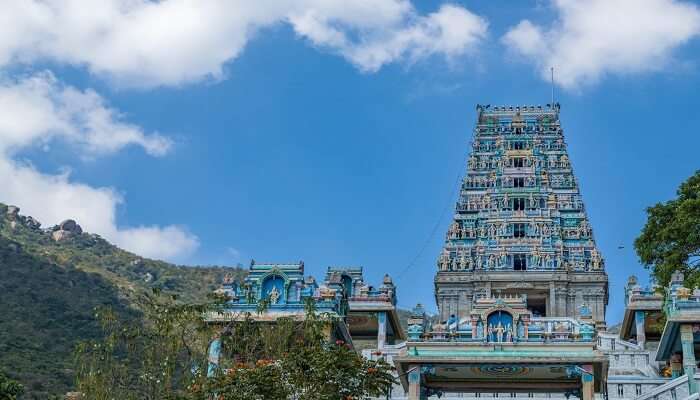
Journey To Subramanya Swamy Temple – A Spiritual Odyssey
Trending Blogs

20 Mysterious Places In India To Visit In 2023 More Bizarre Than The Bermuda Triangle

10 Scariest Roads In India That Are A Driver’s Nightmare

101 Places To Visit In India Before You Turn 30 in 2024

35 Exotic Places To Visit In December In India 2024 To Enjoy A Surreal Vacation

60 Best Honeymoon Destinations In India In 2024

95 Best Honeymoon Destinations In The World In 2023 For A Romantic Escape!
Best Places To Visit In India By Month
Best places to visit outside india by month.
- TravelTriangle
- India »
- Tour Packages
- Honeymoon Packages
- Family Packages
- Budget Tour Packages
- Luxury Tour Packages
- Adventure Tour Packages
- Group Tour Packages
- Kerala Tour Packages
- Goa Tour Packages
- Andaman Tour Packages
- Sikkim Tour Packages
- Himachal Tour Packages
- Uttarakhand Tour Packages
- Rajasthan Tour Packages
- Tour Packages From Delhi
- Tour Packages From Mumbai
- Tour Packages From Bangalore
- Tour Packages From Chennai
- Tour Packages From Kolkata
- Tour Packages From Hyderabad
- Tour Packages From Ahmedabad
- Kerala Tourism
- Goa Tourism
- Sikkim Tourism
- Andaman Tourism
- Himachal Tourism
- Uttarakhand Tourism
- Rajasthan Tourism
- Hotels in Kerala
- Hotels in Goa
- Hotels in Sikkim
- Hotels in Andaman
- Hotels in Himachal
- Hotels in Uttarakhand
- Hotels in Rajasthan
🗓 Best Time To Visit: November to March, when the weather is pleasant and conducive for sightseeing.
⏰ Open Hours: Sunrise to Sunset, all days of the week.
🏞 Things To Do: Explore the historical architecture, enjoy a walk around the gardens, visit the museum inside the fort, attend a light and sound show in the evening.
💰 Entry Fees: INR 40 for Indians, INR 550 for foreigners. No charge for children under 15 years.
🧳 Traveller Types: History buffs, architecture enthusiasts, photographers, families.
🔖 Known For: UNESCO World Heritage Site, a fine example of Mughal architecture, former residence of Mughal emperors.
🚉 Distances: 4 km from Agra Cantt Railway Station, 5 km from Idgah Bus Stand, 8 km from Agra Airport.
📸 Photography: Allowed, but no tripods. Additional charge for video shooting.
♿ Accessibility: Partially wheelchair accessible with ramps and smooth pathways.
🍲 Nearby Eateries: Plenty of local and international cuisine options in the vicinity.
🛍 Souvenir Shops: Several shops selling local handicrafts, textiles and marble work nearby.
Are you planning to visit Agra, the city of love and history? If yes, then you must not miss the Agra Fort, one of the most magnificent and majestic monuments in India. The Agra Fort , also known as the Red Fort of Agra , is a UNESCO World Heritage Site and a symbol of the Mughal Empire's power and artistry. The Agra Fort is a massive fortification that encloses a complex of palaces, mosques, halls, and gardens, built with red sandstone and white marble. The Agra Fort offers a stunning view of the Taj Mahal, the epitome of Mughal architecture and romance, from its ramparts. The Agra Fort is a must-visit destination for anyone who wants to experience the rich and glorious history and culture of India.
In this article, we will tell you everything you need to know about the Agra Fort, such as its history, architecture, entry fee, timings, light and sound show, how to reach, tips for visiting, and top ways to experience. Read on to discover the secrets and stories of the Agra Fort, and get ready to be amazed by its beauty and grandeur.
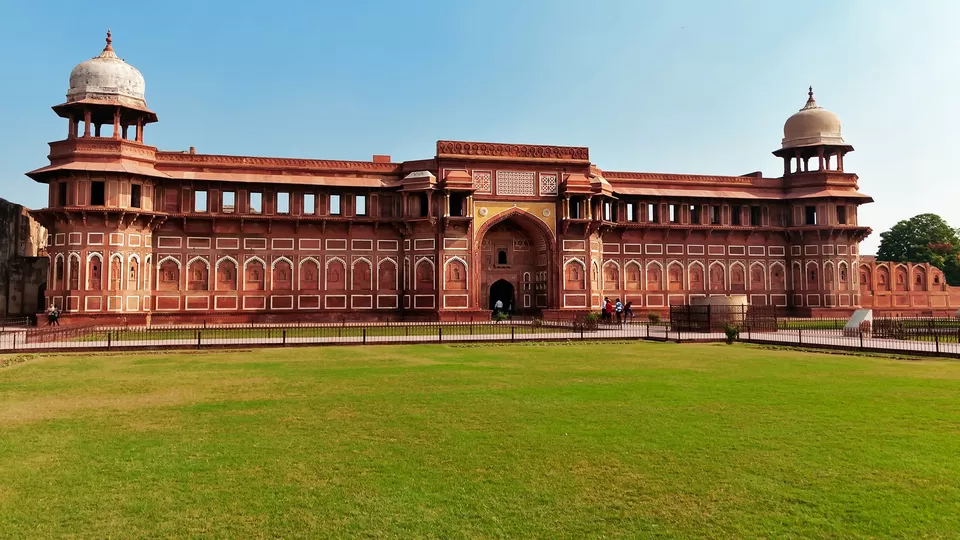
History of Agra Fort
The history of the Agra Fort is a saga of conquest, construction, and destruction, spanning over eight centuries. The Agra Fort has witnessed the rise and fall of several dynasties, from the Rajputs to the Mughals, and from the Marathas to the British. The Agra Fort has also been the home and prison of some of the most famous and infamous rulers and personalities of India, such as Akbar, Jahangir, Shah Jahan, Aurangzeb, and Mumtaz Mahal.
The Rajput Era
The first mention of the Agra Fort dates back to the 11th century, when it was known as Badalgarh, after the Rajput king Badal Singh, who built a brick fort on the site. The fort was captured by the Delhi Sultanate in the 12th century, and remained under their control until the 16th century, when it was seized by the Mughal emperor Babur, the founder of the Mughal dynasty.
The Mughal Era
The Agra Fort reached its peak of glory and splendor under the Mughal emperors, especially Akbar, Jahangir, and Shah Jahan, who transformed the fort into a masterpiece of architecture and art. Akbar, the greatest of the Mughal emperors, rebuilt the fort with red sandstone, and added several structures and features, such as the Pearl Mosque, the Diwan-i-Aam, the Diwan-i-Khas, and the Jahangir Palace. Akbar also made Agra the capital of his empire, and the Agra Fort the seat of his power and administration.
Jahangir, the son and successor of Akbar, continued to embellish the fort with marble and precious stones, and added more structures, such as the Khaas Mahal, the Anguri Bagh, and the Sheesh Mahal. Jahangir also used the fort as a place of leisure and entertainment, and hosted lavish parties and festivals in the fort.
Shah Jahan, the grandson and successor of Jahangir, was the most passionate and romantic of the Mughal emperors, and the builder of the Taj Mahal, the mausoleum of his beloved wife Mumtaz Mahal. Shah Jahan also renovated the Agra Fort with white marble, and added more structures, such as the Moti Masjid, and the Musamman Burj, the tower where he spent his last days as a prisoner of his son Aurangzeb.
Aurangzeb, the son and successor of Shah Jahan, was the last of the great Mughal emperors, and the most ruthless and tyrannical. Aurangzeb deposed and imprisoned his father in the Agra Fort, and executed his brothers in a bloody war of succession. Aurangzeb also plundered and destroyed many of the structures and decorations of the Agra Fort, and replaced them with his own.
The Post-Mughal Era
The Agra Fort declined and deteriorated after the death of Aurangzeb, as the Mughal Empire collapsed and disintegrated. The fort was invaded and plundered by the Marathas, the British, and the Sikhs, who damaged and defaced many of the structures and features of the fort. The fort was also used as a military base and a prison by the British, who occupied the fort until India's independence in 1947. The fort was declared a UNESCO World Heritage Site in 1983, and has been restored and preserved by the Archaeological Survey of India.
Architecture of Agra Fort
The architecture of the Agra Fort is a reflection of the Mughal Empire's artistic and cultural achievements, and a fusion of Hindu and Islamic elements. The Agra Fort is a semi-circular fortification that covers an area of 94 acres, and has a perimeter of 2.5 km. The fort has four gates, two on the east and two on the west, and is surrounded by a moat and a high wall. The wall is made of red sandstone, and is 21 meters high and 18 meters thick. The interior of the fort contains a complex of palaces, mosques, halls, and gardens, built with red sandstone and white marble. The interior structures are decorated with intricate carvings, paintings, inlays, and calligraphy. The fort also offers a stunning view of the Taj Mahal, the epitome of Mughal architecture and romance, from its ramparts.
The Shape and Size
The Agra Fort is a semi-circular fortification that covers an area of 94 acres, and has a perimeter of 2.5 km. The fort is larger than the Red Fort in Delhi, which covers an area of 49 acres, and has a perimeter of 2.4 km. The fort is also larger than the Lahore Fort in Pakistan, which covers an area of 50 acres, and has a perimeter of 1.6 km.
The Walls and Gates
The Agra Fort is surrounded by a moat and a high wall, made of red sandstone. The wall is 21 meters high and 18 meters thick, and has 70 bastions and 9 towers. The fort has four gates, two on the east and two on the west. The gates are named and decorated according to their direction and function. The gates are:
- The Delhi Gate: The main gate of the fort, located on the west side. The gate is also known as the Lahore Gate, as it faces the direction of Lahore, the former capital of the Mughal Empire. The gate is a massive and magnificent structure, with three arches and two octagonal towers. The gate is decorated with white marble and inlaid with semi-precious stones. The gate also has a drawbridge and a crocodile-filled moat for security. The gate is not open to the public, as it is used by the Indian Army, which occupies a part of the fort.
- The Lahore Gate: The secondary gate of the fort, located on the west side. The gate is also known as the Amar Singh Gate, after the Rajput general who defended the fort against the Mughal emperor Shah Jahan. The gate is a simple and plain structure, with a single arch and two circular towers. The gate is the only gate that is open to the public, and leads to the main attractions of the fort.
- The Khizri Gate: The water gate of the fort, located on the east side. The gate is also known as the Yamuna Gate, as it faces the direction of the Yamuna River, which flows along the fort. The gate is a small and modest structure, with a single arch and a wooden bridge. The gate was used by the Mughal emperors to access the river for bathing and boating. The gate is not open to the public, as it is used by the Indian Army, which occupies a part of the fort.
- The Elephant Gate: The ceremonial gate of the fort, located on the east side. The gate is also known as the Hathi Pol, as it has two stone elephants with riders on both sides of the entrance. The gate is a large and impressive structure, with two arches and four domed pavilions. The gate was used by the Mughal emperors to enter the fort in grand processions, accompanied by elephants and horses. The gate is not open to the public, as it is used by the Indian Army, which occupies a part of the fort.
The Interior Structures
The interior of the Agra Fort contains a complex of palaces, mosques, halls, and gardens, built with red sandstone and white marble. The interior structures are decorated with intricate carvings, paintings, inlays, and calligraphy. The interior structures are:
- The Pearl Mosque: The mosque of the fort, located on the north-west corner of the fort. The mosque is also known as the Moti Masjid, as it is built with white marble, which resembles pearls. The mosque is a beautiful and elegant structure, with three domes and twelve pillars. The mosque was built by Shah Jahan for his personal use, and is considered one of the finest examples of Mughal architecture.
- The Diwan-i-Aam: The hall of public audience, located on the west side of the fort. The hall is a large and spacious structure, with a flat roof and three arches. The hall has a red sandstone throne, where the Mughal emperor used to sit and listen to the petitions and complaints of his subjects. The hall also has a marble balcony, where the emperor used to address the public and display his jewels and treasures. The hall is decorated with paintings and carvings, and has a beautiful view of the Yamuna River.
- The Diwan-i-Khas: The hall of private audience, located on the north-east side of the fort. The hall is a small and exquisite structure, with a vaulted ceiling and four pillars. The hall has a white marble throne, where the Mughal emperor used to receive and confer with his ministers and nobles. The hall also has a black marble throne, where the emperor used to sit and admire the Taj Mahal. The hall is decorated with inlays and calligraphy, and has a famous inscription that reads: "If there is a paradise on earth, it is here, it is here, it is here".
- The Moti Masjid: The pearl mosque, located on the south-west side of the fort. The mosque is a replica of the Pearl Mosque in the Agra Fort, but smaller and simpler. The mosque is a rectangular structure, with three domes and two minarets. The mosque is built with white marble, which gives it a pearl-like appearance. The mosque was built by Aurangzeb for his personal use, and is considered one of the finest examples of Mughal architecture.
- The Jahangir Palace: The palace of Jahangir, located on the south-east side of the fort. The palace is a large and impressive structure, with a courtyard and a pool. The palace is built with red sandstone and white marble, and has a blend of Hindu and Islamic styles. The palace was built by Akbar for his son Jahangir, and was used by him as a residence and a place of entertainment. The palace also has a famous bowl, called the Hauz-i-Jahangiri, which was used to measure the wine consumed by Jahangir.
- The Khaas Mahal: The special palace, located on the east side of the fort. The palace is a small and elegant structure, with a pavilion and a terrace. The palace is built with white marble, and has a delicate and refined design. The palace was built by Shah Jahan for his daughters, and was used by them as a private chamber and a dressing room. The palace also has a beautiful fountain, called the Ankh Michauli, which was used by Shah Jahan to play hide and seek with his daughters.
- The Sheesh Mahal: The mirror palace, located on the north side of the fort. The palace is a small and dark structure, with a hall and a chamber. The palace is built with white marble, and has walls and ceilings covered with mirrors and glass. The palace was built by Shah Jahan for his wife Mumtaz Mahal, and was used by them as a royal bath and a bedroom. The palace also has a magical effect, that when a candle is lit in the palace, the whole palace sparkles like a starry night.
- The Anguri Bagh: The grape garden, located on the north side of the fort. The garden is a square and symmetrical structure, with four quadrants and a fountain. The garden is planted with grape vines, flowers, and trees, and has a serene and pleasant atmosphere. The garden was built by Shah Jahan for his wife Mumtaz Mahal, and was used by them as a place of relaxation and romance. The garden also has a secret passage, that leads to the Taj Mahal, which was used by Shah Jahan to visit his wife's tomb.
- The Musamman Burj: The octagonal tower, located on the north-west corner of the fort. The tower is a tall and splendid structure, with a dome and a balcony. The tower is built with white marble, and has intricate inlays and lattice work. The tower was built by Shah Jahan for his wife Mumtaz Mahal, and was used by them as a place of worship and meditation. The tower also has a tragic significance, as it was the place where Shah Jahan spent his last days as a prisoner of his son Aurangzeb, and died while gazing at the Taj Mahal.
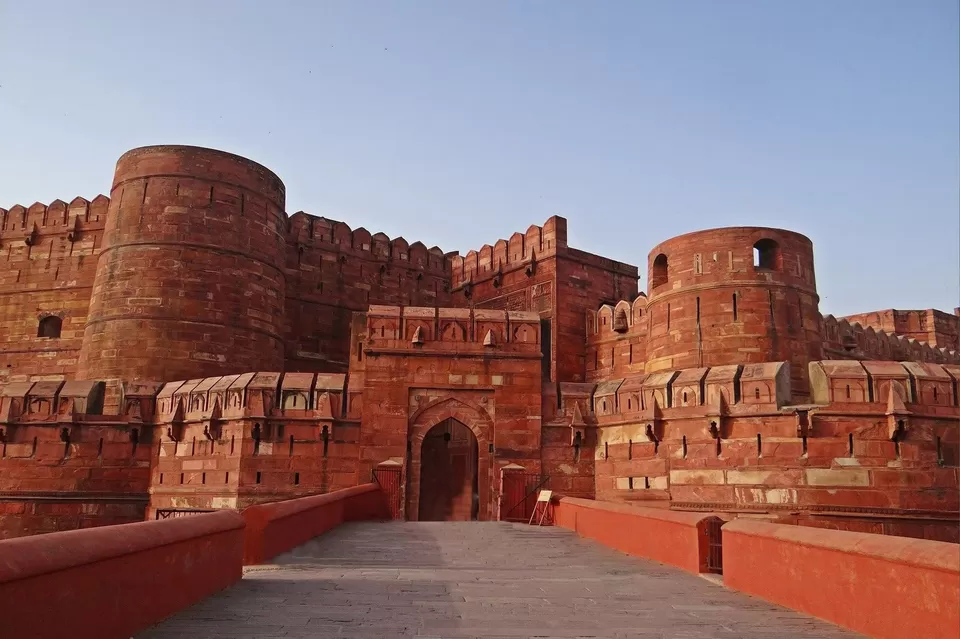
Entry Fee and Timings of Agra Fort
The entry fee and timings of the Agra Fort are as follows:
Indian Nationals | Rs. 40 | 6 am to 6 pm |
Foreign Nationals | Rs. 550 | 6 am to 6 pm |
Children below 15 years | Free | 6 am to 6 pm |
The entry fee includes the access to all the attractions inside the Agra Fort, except the light and sound show, which has a separate ticket price and timings. The online booking option allows you to book the tickets in advance and avoid the queues at the ticket counter. The online booking also gives you a discount of 5% on the entry fee.
Light and Sound Show at Agra Fort
The light and sound show at the Agra Fort is a spectacular and informative show that narrates the history and stories of the Agra Fort, with the help of lighting and sound effects. The show is held every evening in Hindi and English languages, and lasts for about an hour. The show is a must-watch for anyone who wants to learn more about the Agra Fort, and enjoy its beauty and grandeur in a different way.
The ticket price and timings of the light and sound show are as follows
| Indian Nationals | Rs. 80 | 7:30 pm (Hindi), 8:30 pm (English) |
| Foreign Nationals | Rs. 200 | 7:30 pm (Hindi), 8:30 pm (English) |
| Students and Senior Citizens | Rs. 40 | 7:30 pm (Hindi), 8:30 pm (English) |
| Online Booking | [Click here] | 24/7 |
The ticket price includes the access to the light and sound show only, and not to the other attractions inside the Agra Fort. The online booking option allows you to book the tickets in advance and avoid the queues at the ticket counter. The online booking also gives you a discount of 10% on the ticket price.
The show is cancelled in case of bad weather or technical issues, and the tickets are refunded or rescheduled accordingly.
How to Reach Agra Fort
- How to Reach Agra Fort: A detailed guide on how to reach the Agra Fort by air, by rail, or by road, and the options of hiring taxis, autos, or cycle rickshaws. Include the primary keyword "Agra Fort" and the secondary keywords "Agra", "airport", "railway station", and "bus stand".
The Agra Fort is easily accessible by air, by rail, or by road, from any part of India and abroad. The fort is located in the heart of the city of Agra, and is well-connected by various modes of transport. Here are some of the ways to reach the Agra Fort:
- By Air: The nearest airport to the Agra Fort is the Kheria Airport, which is about 8 km away from the fort. The airport has domestic flights from major cities in India, such as Delhi, Mumbai, and Jaipur. The airport also has international flights from some countries, such as Nepal, Bhutan, and Bangladesh. From the airport, you can hire a taxi, an auto, or a cycle rickshaw to reach the Agra Fort. The fare may vary depending on the distance and the bargaining skills, but it should not exceed Rs. 200.
- By Rail: The nearest railway station to the Agra Fort is the Agra Fort Railway Station, which is about 1 km away from the fort. The railway station has trains from major cities in India, such as Delhi, Mumbai, Kolkata, and Chennai. The railway station also has trains from some neighbouring countries, such as Pakistan, Bangladesh, and Sri Lanka. From the railway station, you can hire a taxi, an auto, or a cycle rickshaw to reach the Agra Fort. The fare may vary depending on the distance and the bargaining skills, but it should not exceed Rs. 50.
- By Road: The nearest bus stand to the Agra Fort is the Idgah Bus Stand, which is about 3 km away from the fort. The bus stand has buses from major cities in India, such as Delhi, Jaipur, Lucknow, and Varanasi. The bus stand also has buses from some neighbouring states, such as Rajasthan, Uttar Pradesh, and Madhya Pradesh. From the bus stand, you can hire a taxi, an auto, or a cycle rickshaw to reach the Agra Fort. The fare may vary depending on the distance and the bargaining skills, but it should not exceed Rs. 100.
- By Local Transport: The Agra Fort is also reachable by local transport, such as taxis, autos, or cycle rickshaws, from any part of the city of Agra. The local transport is easily available and affordable, and can be hailed from the road or booked online. The local transport can also take you to other tourist attractions in Agra, such as the Taj Mahal, the Fatehpur Sikri, and the Mehtab Bagh. The fare may vary depending on the distance and the bargaining skills, but it should not exceed Rs. 300.
- Tips for Visiting Agra Fort: A list of the do's and don'ts, and the best practices for visiting the Agra Fort, such as carrying identity cards, avoiding food and tobacco items, hiring approved guides and photographers, and wearing comfortable clothes and shoes. Include the primary keyword "Agra Fort" and the secondary keywords "tips", "guides", and "photographers".
The Agra Fort is a wonderful and worthwhile destination for anyone who wants to experience the history and culture of India. However, to make the most of your visit, you need to follow some tips and guidelines, and avoid some common mistakes and pitfalls. Here are some of the tips for visiting the Agra Fort:
- Carry your identity cards: The Agra Fort is a protected monument, and you need to show your identity cards at the entrance. The identity cards can be your passport, your voter ID, your Aadhaar card, or any other valid document. The identity cards are also required for online booking and discounts.
- Avoid food and tobacco items: The Agra Fort is a heritage site, and you need to respect and preserve its beauty and cleanliness. You are not allowed to carry or consume any food or tobacco items inside the fort, such as snacks, drinks, cigarettes, or chewing gum. You can leave your food and tobacco items at the cloakroom, or dispose of them properly outside the fort.
- Hire only approved guides and photographers: The Agra Fort is a complex and vast structure, and you may need some guidance and assistance to explore and understand it. You can hire guides and photographers from the entrance or online, who are approved and licensed by the authorities. They can provide you with accurate and interesting information, and take you to the best spots and angles for photography. You can also negotiate and bargain with them for the best price and service. You should avoid hiring unapproved guides and photographers, who may mislead and cheat you.
- Wear comfortable clothes and shoes: The Agra Fort is a large and expansive structure, and you may need to walk and climb a lot to see and enjoy it. You should wear comfortable and appropriate clothes and shoes, that suit the weather and the terrain. You should avoid wearing tight and revealing clothes, high heels and sandals, and synthetic and dark fabrics. You should also carry hats, sunglasses, and sunscreen, to protect yourself from the sun and the heat.
- Top Ways to Experience Agra Fort: A showcase of various tour packages and activities that include the Agra Fort as a part of the itinerary, such as guided tours, cultural shows, shopping, and dining. Include the primary keyword "Agra Fort" and the secondary keywords "tour packages", "activities", "shopping", and "dining".
The Agra Fort is not only a historical and cultural monument, but also a destination for fun and adventure. There are many ways to experience the Agra Fort, and to make your visit more enjoyable and memorable. You can choose from various tour packages and activities that include the Agra Fort as a part of the itinerary, such as guided tours, cultural shows, shopping, and dining. Here are some of the top ways to experience the Agra Fort:
- Guided Tours: If you want to learn more about the history and architecture of the Agra Fort, and to explore its hidden and secret corners, you can opt for a guided tour of the fort. There are different types of guided tours available, such as private tours, group tours, half-day tours, and full-day tours. You can book these tours online or at the entrance, and enjoy the services of a professional and knowledgeable guide, who will take you to the best spots and tell you the stories and facts of the fort. You can also customize your tour according to your preferences and interests, and ask questions and doubts to your guide. A guided tour of the Agra Fort is a great way to enrich your knowledge and appreciation of the fort.
- Cultural Shows: If you want to experience the culture and entertainment of the Agra Fort, and to witness its beauty and charm in a different light, you can watch a cultural show near the fort. There are different types of cultural shows available, such as dance shows, puppet shows, and folk music shows. You can book these shows online or at the entrance, and enjoy the performances of talented and skilled artists, who will showcase the traditions and customs of the region. You can also interact and participate with the artists, and learn more about their art and craft. A cultural show near the Agra Fort is a great way to immerse yourself in the atmosphere and spirit of the fort.
- Shopping: If you want to buy some souvenirs and gifts from the Agra Fort, and to indulge in some retail therapy, you can go shopping near the fort. There are different types of shopping options available, such as handicrafts, souvenirs, and leather goods. You can find these items in the shops and stalls near the entrance, or in the markets and bazaars around the fort. You can also bargain and negotiate with the sellers, and get the best deals and discounts. You can buy items such as marble inlay work, carpets, jewellery, pottery, and shoes, which are unique and authentic to the region. Shopping near the Agra Fort is a great way to take home a piece of the fort and its culture.
- Dining: If you want to taste the cuisine and flavours of the Agra Fort, and to satisfy your hunger and thirst, you can go dining near the fort. There are different types of dining options available, such as local cuisine, street food, and fine dining. You can find these options in the restaurants and cafes near the entrance, or in the hotels and resorts around the fort. You can also order and enjoy the food and drinks in the comfort and convenience of your room or balcony, with a view of the fort. You can try dishes such as petha, agra ka chaat, mughlai biryani, and tandoori chicken, which are delicious and famous to the region. Dining near the Agra Fort is a great way to savour the taste and aroma of the fort and its history.
Conclusion:
The Agra Fort is a UNESCO World Heritage Site and a symbol of the Mughal Empire's power and artistry. The Agra Fort is a stunning and majestic structure, built with red sandstone and white marble, and decorated with carvings, paintings, inlays, and calligraphy. The Agra Fort has a rich and glorious history, and has been the home and prison of some of the most famous and infamous rulers and personalities of India. The Agra Fort offers a breathtaking view of the Taj Mahal, the epitome of Mughal architecture and romance, from its ramparts. The Agra Fort is a must-visit destination for anyone who wants to experience the history and culture of India, and to have fun and adventure.
Agra Fort Reviews

Places To Visit In Agra

Travel Blogs for Agra Fort
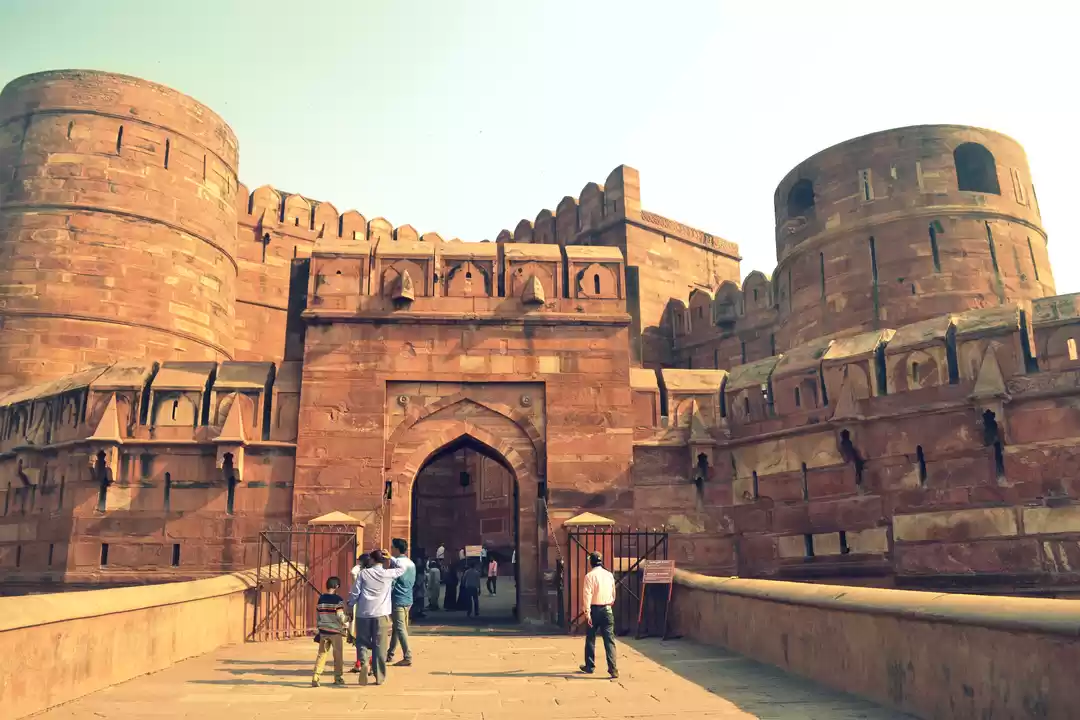
4 Days Agra Itinerary — Taj Mahal, Agra Fort, and Fatehpur Sikri
Itinerary rundown.
Trip Date — September 2013
Itinerary Notes & Tips
Jaipur to agra.
- 9:30am to 3:30pm – Ride non-aircon bus from Jaipur to Agra – R211
- Arrival at bus stop in Agra (near Agra Cantonment Railway Station)
- Drop off at Shanti Lodge
Agra Hostel
- Single fan room with private TB (free WIFI) – R300
- Chai – R20
- Mutton curry (R170), Rice (R40), Chapati (R15 per piece) – R225
- Chicken Briyani – R100
Fatehpur Sikri Day Trip
- 10am – Ride auto-rickshaw to Idgah Bus Station – R90
- 10:30am to 11:30am – Ride bus to Fatehpur Sikri – R39
- Cheese Kofta (R70), Plain Naan (R20), Chapati (R10 per piece)
- Buland Darwaza
- Admission fee – R235
- Walk to highway intersection past Agra Gate
- Ride shared jeep to Agra City Center outskirts – R25
- Ride auto-rickshaw to Idgah Bus Station – R5
Agra City Center
- Ride auto rickshaw to Mehtab Bagh – R150
- Sunset view of Taj Mahal from across the river
- Ride auto-rickshaw to Taj Ganj – R60
- Malai kofta (R80), Rice (R30), Mirinda (R20), Naan (R15) – R145
- 5:30am – Walk to West Gate
- Buy Taj Mahal admission ticket – R750
- 6:00am – Gate opened. Was informed that tripod were not allowed inside, so I had to go to luggage lockers first.
- Taj Mahal tour
- Mushroom cheese omelette (R65), Coffee (R15) – R65
- Cappuccino (R100+)
- Veg Thali (R80), Mirinda (R15)
- Ride auto-rickshaw to Agra Fort – R50
- Forgot to bring Taj Mahal admission ticket. I should have gotten a R50 discount if I showed it at the ticket counter.
- Ride auto-rickshaw to Taj Ganj – R40
- Mutton Kofta (R90), Naan (R20), Chapati (R20), Bottled water (R10) – R140
- 6am – Ride auto-rickshaw to Idgah Bus Station – R80
- 6:30am to 12:30nn – Ride bus from Agra to Delhi – R192
Don’t leave yet. There’s more!
Posting of new comments is disabled temporarily.
Connect with Marcos on:
Detourista.com.
Discover more travel guides and blogs about the Philippines and beyond by Marcos Detourist
Choose your next destination:
Cambodia , Hong Kong , India , Indonesia , Laos , Macau , Malaysia , Myanmar , Nepal , Philippines , Singapore , Thailand , Vietnam


Copyright Notice: All Rights Reserved

The 7 Must-Do Activities In Taj Town Agra
Agra more than just the taj mahal.
Agra is famous as the city of the Taj Mahal, but there's so much more to experience and discover here! Located right in the heart of India's northern state of Uttar Pradesh, Agra has a long and rich history that shines through its lively culture, vibrant bazaars and of course, magnificent monuments. For any visitor, Agra offers the ultimate glimpse into India's grand imperial past combined with its bustling present-day lifestyle.
Here are seven fun things you must check out on your trip to get the most out of this city:
1.Watch the Sunrise at the Taj Mahal
Obviously, no trip to Agra is complete without visiting India's most iconic monument the Taj Mahal. But instead of joining the crowds later in the day, head there early morning to catch the sunrise.
Watching the morning rays light up the marble exterior of this world-famous monument is an incredible bucket list experience!
As you take in the intricate details of the Taj, remember that it was built in the 17th century by Mughal Emperor Shah Jahan for his beloved wife Mumtaz Mahal. The level of detail, from the carvings, lattice screens and even the surrounding gardens, shows Shah Jahan's devotion and love for Mumtaz.
If you're up for a good story, there are always guides around who will dramatically recount the royal love story for you!
-The Taj Mahal is one of the New Seven Wonders of the World
-It took approximately 20 years and 20,000 workers to construct
-The monument is made entirely of marble
-Over 7 million people visit it every year
2.Explore the Massive Agra Fort
The Agra Fort is just 2.5 km away from the Taj Mahal but tourist crowds here are far less. This imposing structure with its towering walls and bastions transports you back to the golden era of the Mughals. Walking through the gates into the fort area, you suddenly get a glimpse into what imperial life must have felt like centuries ago.
The fort was originally built by Emperor Akbar in the 16th century, using his trademark style of fusing Islamic and Hindu architectural elements. Later, his grandson Shah Jahan added the white marble palace and mosque we see today. If you visit the various buildings here the Diwan-i-aam (public audience hall), Diwan-i-khas (private audience hall) and even some underground rooms you can envision all the history that has transpired within these walls over generations!
-Built in the 16th century, with additions made later by Shah Jahan
-Sprawling 94-acre area with 2.5 km perimeter
-Combination of red sandstone and grand white marble structures
-Residence of Mughal emperors for nearly 200 years
3.Dig into Delectable Local Food
No trip is truly complete without experiencing the local food! And in Agra, every meal is a royal feast. From savoury meat delicacies to sweet treats, the Mughlai influence is strong. Start your day with breakfast at local joints near the Taj try breads like sheermal or khamiri roti with spicy potato curry or chickpea stew.
For lunch, sample rich curries and biryanis maybe mutton kebabs in a dark, aromatic gravy or a fragrant awadhi biryani layered with lamb. And surely save room for the city's signature dessert Agra Petha, a popular candy made from white pumpkin and dipped in sugar syrup. Grab a box to snack on later or take home for friends!
-Famous for Mughlai cuisine, incorporating rich spices and dried fruits
-Signature dish is Agra Petha a sweet made from white pumpkin
-Popular street food includes samosas, kachori (stuffed puris) and jalebi
-Famous restaurants cluster near the Taj Mahal
4.See the Legendary Love Story on Stage
Want to truly immerse yourself in the romance of Shah Jahan and Mumtaz Mahal? Get tickets to the Mohabbat-e-Taj musical extravaganza! Performed at the picturesque Kalakriti auditorium, this Bollywood-style spectacle dramatizes the royal love story, with lavish sets, costumes, dance sequences and music.
Sixties-style flashing neon lights announce each scene, while a melodious quintet sings soulful tunes as Shah Jahan and Mumtaz first meet, fall in love and face turmoil before tragedy ultimately befalls Mumtaz after giving birth to her fourteenth child. Their palace pops up from beneath the stage while animated artwork morphs into the iconic Taj Mahal itself. Cheesy but cute! Even if you can't follow the Hindi dialogues, the music and effects make it quite the theatrical spectacle.
-Performed daily at 6:30 pm (duration 75 mins)
-Tickets available on BookMyShow.com or at the venue
-Lavish live production with music, sets and choreography
-Family-friendly show, good for all age groups
-Halal food options available at the auditorium
5.Journey Back through the Abandoned Capital Fatehpur Sikri
Want to see a whole city lost in time? Make a quick day trip to Fatehpur Sikri, under an hour's drive from Agra. This eerily abandoned capital was built in the late 1500s by Emperor Akbar. He designed it as a hub for artists, scholars and religious leaders Hindus, Muslims, Christians and even Zoroastrians. Walking through the amazingly preserved palaces and grand victory gates, you feel like you're stepping back through centuries.
Marvel at the stunning architecture: halls decorated with intricate carvings, courtyards with carved jali screen windows and shady verandahs. Stand before the towering 54-metre high Buland Darwaza gate marking the emperor's military success. Visit the dargah shrine of Sufi saint Salim Chisti, revered for blessings that led to Akbar's much-desired heir. Just don't make the mistake Akbar did - of abandoning Fatehpur Sikri just years after its founding!
-Constructed in 1571 as Emperor Akbar's new capital
-Blend of Islamic and Hindu elements seen in secular buildings
-Was the imperial capital for only 14 years before being deserted
-Inscribed as a UNESCO World Heritage Site in 1986
6.Hunt for Souvenirs in Colourful Local Bazaars
What's a trip without some shopping? Agra's bustling bazaars burst with good deals on marble souvenirs, leatherware and trendy clothing. Head straight to Kinari Bazaar near Jama Masjid mosque to browse rows of shops glittering with "chikan" embroidery intricate hand-stitching embellishing kurtas, sarees and dupattas.
Prefer Rajasthani style handicrafts or marble tabletops? Check out Subhash Bazaar or the roadside stalls near Fatehpur Sikri. And don't forget to put those bargaining skills to good use! Halve those first quoted prices or walk away politely to get crisp discounts. With some polite haggling and charm, you'll have shopkeepers throwing in extra gifts! Do spare a few rupees for the street children and help preserve the livelihoods of small artisan families.
-Kinari Bazaar famous for chikan hand-embroidery work
-Sadar Bazaar deals in leather accessories, bags and shoes
-Subhash Bazaar stocks Rajasthani trinkets, handicrafts
-Plenty of roadside vendors near Fatehpur Sikri sell marble pieces
-Bargaining politely can get you 30-50% discounts!
7.Cruise Past the Taj at Sunset
After a day exploring the city, relax by taking in the Taj Mahal from a whole new perspective from the softly flowing Yamuna River out back! Book yourself onto a shared boat or spring for a private one to sail just meters away from the gleaming monument. Float slowly along as the afternoon light shifts to a golden dusk glow.
As the sun sinks lower behind the domed silhouette, stay to watch the monument become backlit, then gradually illuminate again under spotlights. Professional photographers will be happy to snap that perfect sunset Taj shot for you. And don't forget to look out for the families of monkeys playing along the riverbanks as your boat glides by! A blissful river ride with unforgettable views the perfect ending to your day in Agra!
-Sunset boat tours run daily from 2 pm behind the Taj
-Shared boats can take 6-8 people, private boats are pricier
-Perfect sunset views of the Taj from the Yamuna River
-Boat ride lasts 1-1.5 hours along a relatively clean stretch
The Takeaway
There you have it the best ways to experience Agra beyond just visiting India's legendary Taj Mahal! From riverside adventures and abandoned ghost cities to tasty treats and shopping sprees, there's something to delight travelers of all types and budgets.
Getting a glimpse into imperial India's past while mingling with friendly locals makes for an unforgettable trip. And you get to come home with unique stories and souvenirs too. So on your next India holiday, keep a few days for magical Agra. With an open mind and sense of fun, falling in love with this vibrant city is inevitable!


Taj Mahal Agra Timings, Entry Fee Details and Tour Information
Taj Mahal is the most beautiful wonder of the world. If you are travelling to Agra, here are the Taj Mahal timings, entry fee and tour details for you.
Agra Travel Blog – Your best guide in the city of Taj
Top 6 most visited sites by buddhists in india.

India was the first land where Buddhism was flourished because Lord Buddha spent his life. The places which are associated with Lord Buddha have been transformed into sacred places among its followers.
Most Preferred Tourist Destinations in Lakshadweep

36 atolls and coral reefs are found in the Laccadive Sea, Lakshadweep is located off the coast of Kerala. Make sure that all the islands are not inhabited by human being, and only a few of them are open for the visitors. Kavarati is a capital of this union territory and known for its natural beauty and stunning surrounding, boasts beautiful mosques.
Top 10 Most Popular Tourist Destinations In India

India is one of the best tourist destinations in the world due to its diverse culture, languages, religions, and geographical wealth, and it attracts millions of the domestic as well as inbound tourists.
7 Most Popular National Parks in North East India
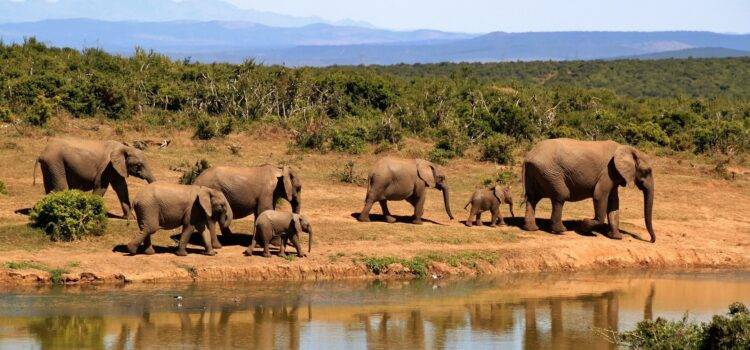
North Eastern part of India comprises 8 states, including Asam, Tripura, Meghalaya, Nagaland, Mizoram, Arunachal Pradesh, Sikkim, Manipur, is situated between Bangladesh in the south and Myanmar in the east, is filled with natural beauty but least explored by tourists due to lack of infrastructure.
Top Five Best Places To Visit In Mount Abu, Rajasthan

Mount Abu is one of the renowned hill stations of Rajasthan in the Sirohi District which is surrounded by the Aravalli Range of mountains. Being the summer capital of Rajasthan, it gets filled with tourists nearly all the year. It happens due to not only hill station but also other attractions.
Top 10 Most Visited Tourist Attractions In Delhi
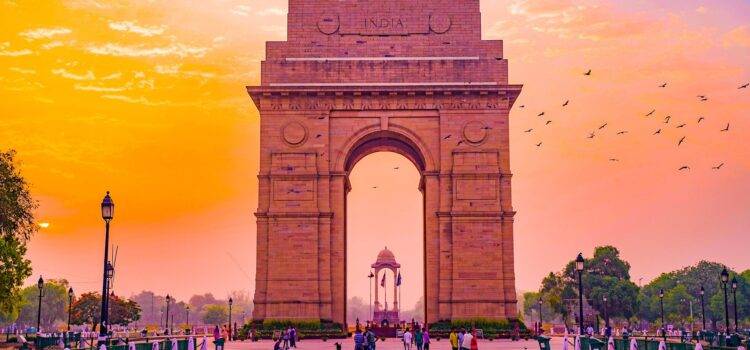
Delhi, the capital of India, is a home of 30 millions of people who come from length and breadth of India. Delhi has been in a limelight throughout the history many dynasties have fought for it due to its prized location therefore; many battles were fought between Indigenous rulers and foreign invaders.
Top 10 Most Visited Tourist Attractions In Maharashtra
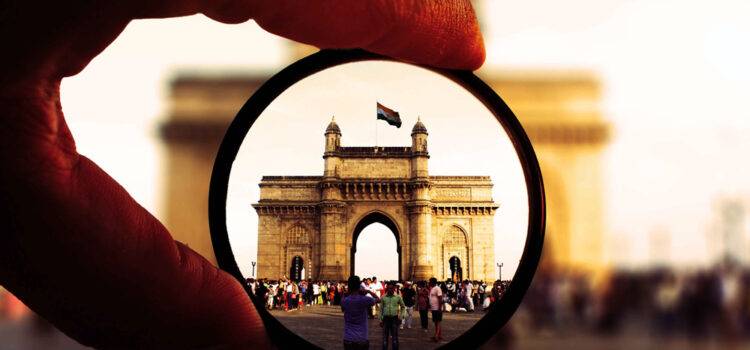
Located on the western boundary of India, flanked by Arabian Sea on one side Maharashtra is the 2nd largest most populated state in India. It has an abundance of flora & fauna or natural resources and boasts many rivers, like the Krishna, Bhima, and the Godavari.
Top 10 Most Visited Destinations In Madhya Pradesh
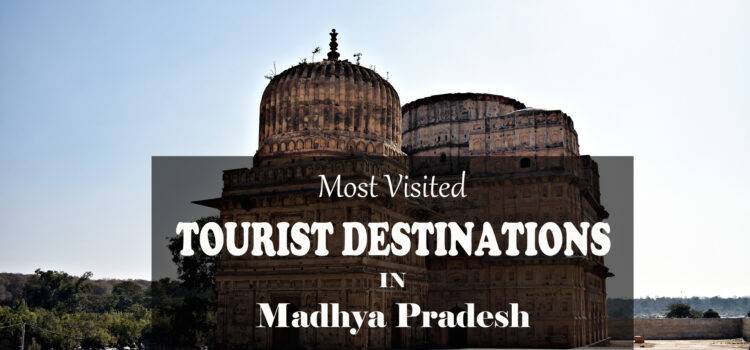
Madhya Pradesh, heart of India, is known for its multi-ethnic culture and rich heritage and is home to many world heritage sites as well as natural beauty. This state has a lot to offer to explore for its tourists, which is why; from all the corners of the world tourists wish to visit this state.
Top 10 Most Visited Monuments by Tourists In India

India is a home of numerous monuments which were commissioned by different rulers of different dynasties. Monuments can be in the form of temples, tombs, mosque, stupas, forts etc. Top 10 most visited monuments have been compiled here to provide you deep-insight into India.
Top 10 Majestic And Stunning Forts In India
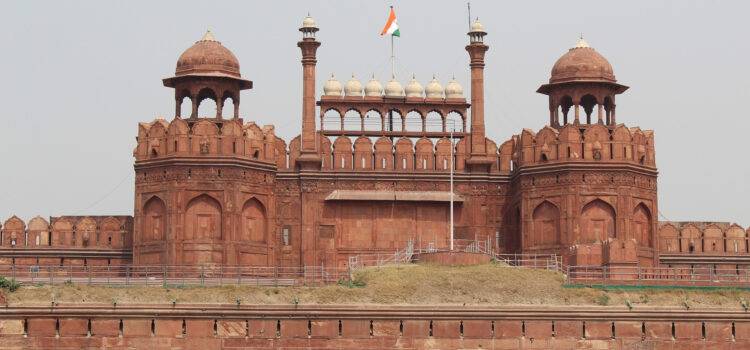
When it comes to visiting forts and palaces, no other names strike to our mind except India that boasts countless of majestic forts and embellished palaces that are scattered in across the country.
- « Previous

IMAGES
VIDEO
COMMENTS
Agra Fort. Address: Agra Fort, Rakabganj, Agra, Uttar Pradesh 282003, India. Agra Fort is also known as Lal Qila, Fort Rouge or Red Fort. Agra Fort is the second most important destination after the Taj Mahal. Agra Fort is located in the northwest of Agra city, 2.5 km northwest of Taj Mahah. So, standing here you can see the Taj Mahal in the ...
Discover Agra Fort, known as the Red Fort - Agra Fort is a historical fort in the city of Agra, constructed by Mughal Emperor Akbar with striking red sandstone, near the iconic Taj Mahal. ... you'll find it all in our travel blog. By: Jarred Manasse September 20th, 2023. Sacred Darshan and Spiritual Serenity: Exploring Swaminarayan Akshardham ...
In this Agra travel blog I'll cover where to visit, my top travel tips for visiting Agra, advice for female travellers and much more - read on for what you need to know while planning your trip to Agra! ... There's so much more to see in Agra than just the Taj Mahal and the fort, I really recommend staying 2-3 days here if you possibly ...
Tour Agra Fort on foot. Agra Fort was the main residence of the Mughal emperors before they moved their capital to the Red Fort in Delhi, so if you've already been there on your travels through India, it's kind of cool to see some of the similarities between the two structures.. Like the Red Fort in Delhi, Agra Fort is also a walled city and inside the enclosure you'll find gardens ...
Come out from the West Gate of the Taj Mahal for the shortest ride to the fort. AUTO RICKSHAW / TAXI. The easiest and most convenient way to reach Agra Fort from where you're staying in Agra City, or from Agra Cantt Station, is to hail an auto-rickshaw. Most rides should cost you INR 50 to 70.
Agra Fort. Restored by Mughal Emperor Akbar, Agra Fort is the city's second most impressive landmark and another World Heritage Site. ... That's a wrap on a comprehensive Agra travel guide from me! I hope you found information in this blog post helpful in planning your trip to Agra, the home of the Taj Mahal. I tried to include everything I ...
January 27, 2024. 3. Uttar Pradesh, India. हिंदी में पढ़े. Agra Fort is a red sandstone fort and was originally an expansion of a brick fort built by King Badal Singh. The grandeur and the credit for its construction are given to Mughal emperor Shah Jahan. Agra means Taj Mahal and Taj Mahal means Agra. This notion arises ...
BLOG 2 Days in Agra: The Perfect Agra Itinerary. April 16, 2022 August 27, ... Things to do in Agra Agra Itinerary Day 1 Agra Fort. The Red Fort, located 2 kilometres from the Taj Mahal, was constructed between 1565 and 1573. ... Map of Agra Attractions. To make your travel planning easier, this map includes all of the tourist attractions ...
Exclusive blog on Red Fort of Agra. The Travel Guide gives you inside tour of the fort, it's exclusive architecture and other hidden gems. 1 (888) 414-6804 (USA & Canada) +91-99274-65808 ; ... Fort Agra is surrounded by an impregnable double wall constructed of red sandstone. It runs almost straight along the Yamuna River and continues for 2 ...
Day 1- Arrive at Agra and check-in: Most tourists usually get to Agra from Delhi/Jaipur via train or travel agency-operated buses. A few of the Indian cities (Bengaluru, Mumbai, Jaipur, Lucknow, Delhi, Varanasi, and Bhopal) are also directly connected to Agra through non-stop flights. From other cities/countries your best bet is to connect to ...
Address. Agra Fort, Rakabganj, Agra, Uttar Pradesh 282003, India. Phone +91 562 222 6431. Web Visit website. The Taj Mahal invariably steals the spotlight in Agra but the city also has one of India's most significant Mughal forts. Four generations of influential Mughal emperors ruled from Agra Fort, while Agra was the capital of the flourishing ...
Agra Fort. Built in 1573 with the help of over 4,000 workers, Agra Fort was the main residence for the Mughals under the reign of Akbar- a great Mughal Emperor. It took nearly 8 years to complete and its expansive grounds are a sight to behold. We visited the Agra Fort early one morning and found that it was a great place to spend our afternoon.
Ultimate Travel Guide to Agra Fort. Agra Fort is the second-most visited monument in the city, right after Taj Mahal in Agra. Agra used to be the capital of Mughal Empire and the fort was built as the royal residence. Previously also called as Badalgarh Fort. Later, this was one of the first monuments in the country to be tagged as a heritage site.
This is when the Agra fort was built by Akbar using red sandstone from Rajasthan. This red fort in Agra took around 8 years to be constructed - around the same time as the grand tomb of Humayun in Delhi. There were over 500 buildings inside Agra Fort and it remained a powerhouse of the Mughals till Aurangzeb ruled.
Agra Fort Ticket Price. You do not have to scout for the Red Fort Agra ticket price as we have all the basic details queued up for you. The entry fee for Indians is Rs 50 per person for adults and children below 15 years are allowed to enter for free. The Red Fort Agra ticket price for foreign visitors varies. Foreign tourists above 15 years of ...
After independence, the fort came under the control of Government of India. Suggested tour package: 7 days - Private Delhi Agra Jaipur tour. Explore about Shopping in Agra. Architectural Beauty of the Agra fort Inside Agra Fort. This was one of the early forts of Mughal and it was mainly built for military purposes.
The timing to visit Agra Fort is from sunrise to sunset every day. You can watch and experience the rich history of the fort at evening light and music show held regularly inside the fort. The opening time of Agra Fort is from 6.00 A.M to 6:00 P.M on all days of the week. 5.
Roopam. Agra in Uttar Pradesh has many monuments that beautifully depict the Mughal Era. The most notable of them are Taj Mahal, Agra Fort, and Fatehpur Sikri. The Agra Fort is a beautiful fort with a history of its own. It was formerly known as Badalgarh. What is special about this fort is that all the emperors of the Mughal era until the year ...
Step aboard the express train and embark on a thrilling day trip to the iconic Taj Mahal and Agra Fort. This enchanting journey promises a captivating blend of history, architecture, and culture. With a private tour guide at your side, unravel the mysteries of the Taj Mahal, a mesmerizing UNESCO World Heritage Site.
The Agra Fort, also known as the Red Fort of Agra, is a UNESCO World Heritage Site and a symbol of the Mughal Empire's power and artistry. The Agra Fort is a massive fortification that encloses a complex of palaces, mosques, halls, and gardens, built with red sandstone and white marble. The Agra Fort offers a stunning view of the Taj Mahal, the ...
Agra Fort Tour - R300 admission fee. Forgot to bring Taj Mahal admission ticket. I should have gotten a R50 discount if I showed it at the ticket counter. ... Travel Blog: Discover more blogs and travel tips in India. Thanks for sharing! Facebook Twitter. Book up to 75% OFF on your next stay. Check promo rates available today: The Author ...
Travel Blog » Asia » India » Uttar Pradesh » Agra » Blogs » AGRA FORT. AGRA FORT « Previous Entry. ... Agra Fort (sometimes called the Red Fort), was commissioned by the great Mughal Emperor Akbar in 1565, and is another of Agras World Heritage Sites. A stone tablet at the gate of the Fort states that it had been built before 1000 but ...
Agra Fort . Often overshadowed by the grandeur of the Taj Mahal, the Agra Fort is a UNESCO World Heritage Site that boasts an equally impressive history and architectural splendour. Built by ...
The Agra Fort is just 2.5 km away from the Taj Mahal but tourist crowds here are far less. This imposing structure with its towering walls and bastions transports you back to the golden era of the ...
Shailendra August 17, 2023 August 17, 2023 Travel Guides Read more Top 10 Most Popular Tourist Destinations In India India is one of the best tourist destinations in the world due to its diverse culture, languages, religions, and geographical wealth, and it attracts millions of the domestic as well as inbound tourists.